
- Historical walks

through San José
- Things to do
Historical walks through San José
The city that is known today as San Jose came into being as a small town around the middle of the 16th century. This area was known as the Aserri Valley and was comprised of extensive grasslands with an altitude measuring between 3,600 and 4,100 ft. The main waterways are the Tiribi, Torres, Maria Aguilar and Ocloro rivers.
A chapel that was built in 1737 on the site known as “La Boca del Monte,” marked the emergence of the town. In 1738, it was consecrated and dedicated to the Patriarch Saint Joseph.
In 1776, a new adobe style church was constructed, which over time became known as the Metropolitan Cathedral. In 1783, according to a census at that time, “La Boca del Monte” was home to 4,869 inhabitants: 577 Spaniards; 3,664 Mestizos; and 628 Mulattos, located in the city, neighborhoods, and surrounding towns.
Tobacco farming began in the outskirts of San Jose in the second half of the 17th century, which generated revenue and led to economic development and strengthening of San Jose´s political role within the province. In 1813, Costa Rica´s representative in the Court of Cadiz, Father Florencio del Castillo, oversaw and obtained the title of “City” for San Jose. On September 15th, 1821, Costa Rica gained independence from Spain, which created a power struggle over which should be the capital among the four main cities of the Central Valley: San Jose, Alajuela, Heredia or Cartago. This tense situation led to two armed confrontations: the Ochomongo War of 1823 and the La Liga War of 1835. In the end, San Jose was declared the capital of the republic.
The construction boom was due in large part to well-known competing foreign architects, such as Franz Kurtze, Ludwig von Shamier, and Franz Rohrmoser, who were responsible for the most important construction project of the era.
1. Our Lady of Sion building
In 1879, members of the Religious Order of Sion came to the country at the request of General Tomas Guardia in order to work on education reform in the city of Alajuela. In 1880, they moved to San Jose and between 1883 and 1887, they built a girl’s school and a convent for the Religious Order. This group of buildings was built in neoclassical style, which, over time, has lost much of its original historical relevance. The Pavilion rooms and the convent were built in brick over granite stone base. The chapel is made of re-enforced concrete with a medium point vaulted arch. All the work was overseen by Pedro Albertazzi. This educational center played an important role in the education of females during this time.
In 1960, the Sion High School was transferred to Moravia and in 1969 the State took over the property and installed various public offices that currently form part of the Legislative Assembly.
Located on Central and 1st Avenue, between 17th and 19th Street.
2. Castillo Azul (The Blue Castle)
This magnificent neoclassical residential home was constructed in 1908 by the lawyer and well-known politician Maximo Fernandez. In 1914, the housing project was rented to the State to be used as the presidential home from 1914 to 1923, and was inhabited by various presidents, including Alfredo Gonzalez Flores, Federico Tinoco Granados, Francisco Aguilar Barquero and Julio Acosta Garcia. In 1923, it was sold to the US government to be used for the North American Legion. In 1854, it was then acquired by Dr. Carlos Manuel Gutierrez Cañas, and in 1989, it was taken over by the Legislative Assembly to serve as a branch of the Legislative Directory.
The Castillo Azul was constructed of re-enforced concrete and is famous for its detailed finishes, tastefulness and quality of the materials. The plans and technical specifications were provided by the Casa Hennebique, in Paris, France, and the construction itself was carried out by the contractor Alfredo Andreoli. There are two versions to the origins of the name of the building. The first is that the flag of the political party of Maximo Fernandez was the same color, and the second version is that the building once had a bluish tinted glass dome that was destroyed in 1923 by the military uprising known as the ¨Bellavistazo.¨
Located on Central Avenue and 17th Street. Tel.: (506) 2243-2545 Web: asamblea.go.cr
3. The Legislative Assembly
In the 1920s, Cristina Castro, widow of Kieth Castro, donated this property to the Temporalities of the Catholic Church in order to build a temple on it. However in 1927, the then president Ricardo Jimenez did not authorize the construction due to its proximity to the Bellavista barracks. In 1939, the president Leon Cortes Castro bought the land from the church in order to build the presidential home there. Work began that same year in neoclassical style by the architect Jose Maria Barrantes. The re-enforced concrete structure with an iron framed roof experienced several setbacks during its construction due to the lack of concrete and other materials during the Second World War. In 1957, it was finished and then was occupied by the Legislative Assembly instead of its original plan as a presidential home. Located between Central and 1st Avenue and 15th Street. Tel.: (506) 2243-2000 Web: asamblea.go.cr
4. Costa Rican National Museum
In 1870, the German naturalist, Alexander Von Frantzius, constructed his home in the area known as ¨Buenavista¨ due to its panoramic view of San Jose. In 1876, it was acquired by Mauro Fernandez. It was vacant between 1910 and 1914 and was then bought by the government of Alfredo Gonzalez Flores in order to turn it into a military barracks. In 1917, this project was carried on by Federico Tinoco. Between 1928 and 1932, it was finally transformed into a military barracks. The Bellavista Barracks faded out as an institution due to the constitutional decree of the abolition of the military in 1949 and was dedicated as the facility for the National Museum.
The museum displays a part of its collections in two halls: one is pre-Columbian history and the other displays the history of Costa Rica.
Located on Central and 2nd Avenue, between 15th and 17th Street
Business Hours:
- Tuesday to Sunday from 8:30 a.m. to 4:30 p.m.
- Sundays from 9 a.m. to 4 p.m. Free admission for citizens and residents.
- Closed Mondays
Tel.: (506) 2257-1433 Web: museocostarica.go.cr
5. Democracy Plaza
This plaza was inaugurated on November 7th, 1989 with many Americas’ Presidents in attendance. The purpose of the celebration was the centennial celebration of the political events of 1889, when the town demanded respect for the election of Jose Joaquin Rodriguez as president of the republic, and was bestowed with the name ¨Centenarian of Democracy.¨
The design of the plaza is by Edwin Villata. One of the purposes of the construction was to provide a better visual perspective of the west side of the National Museum. The project as a whole caused some turmoil due to the demolition of some historically valuable residential homes that were on site. Located on Central and 2nd Avenue, in front of the National Museum.
6. The Jade Museum
Located in its new building inaugurated in 2014, the Jade museum exhibits the largest collection of pre-Columbian Jade in the Americas. Presently, it has a modern exhibition room floor plan, allowing national and foreign visitors easier access to the rich archeological wealth that this museum holds, preserves and displays. The collection contains artifacts in ceramic, stone, bone, shell, wood, and other materials in its permanent, as well as its seasonal exhibition rooms.
Located on 13th Street, between Central and 2nd Avenue. Business Hours: Monday to Sunday from 10 a.m. to 5 p.m. Tel.: (506) 2521-6610 Web: portal.ins-cr.com
7. Methodist Church
On April 26, 1917, the mission board of the Episcopal Methodist Church, located in Mexico, decided to take on a missionary project in Costa Rica. Reverend Miller traveled to Costa Rica in 1919 and acquired a property at the bottom of Cuesta de Moras belonging to Club Catalan. For a short time it served as the Redeemer Baptist Church, until a new church was constructed in 1940 made of brick and mortar.
Located on Central Avenue, between 9th and 11th Street.
Tel.: (506) 2236-2171
8. Our Lady of Solitude Church (Iglesia Nuestra Señora de la Soledad)
Our Lady of Solitude Church was constructed in the middle of the 19th century, becoming a driving force within the population in the southeast part of the city. It is a distinguished structure built with limestone in baroque style and is one of the most representative structures of the 19th century that is still intact.
Located 9th Street, between 4th and 6th Avenue.
9. Dr. Rafael Angel Calderon Guardia Statue
A doctor, counselor, and Congressional official, he was elected president of the Republic in 1940. He promoted important social reforms in his time. An elections fraud charge provoked an armed conflict that kept him in exile for 14 years. He was named “Benemerito de la Patria.”
Located in Social Guarantee Plaza on 5th Street, between 4th and 6th Avenue.
10. Women’s High School (Colegio Superior de Señoritas)
The Women’s Higher Learning School, founded in 1888, is one of the first State buildings established to develop a higher learning plan that marked the beginning of Costa Rican women’s development and has been fully carried out. Years of effort have prepared valuable intellectuals in our society, making it one of the leading learning centers for years after. It is a building of great architectural value, a style that defined Costa Rican construction at the end of the 19th century. The facade is Doric order, overlaid with Corinthian order made from stone. The facade is perfectly balanced, vertically as well as horizontally, which are classical elements of the renaissance.
Located 3th Street, between 4th and 6th Avenue.
11. The Good Shepherd Anglican Church
During the 19th century and into the 20th century, England held a strong economic influence over the region in terms of loans to Central American countries. As a consequence, many English businessmen came to Central America and many chapels were set up to feed the spiritual needs of English businessmen and diplomats. In 1867, The Church of Christ was established in Guatemala inside the British embassy and its chaplain also belonged to diplomatic personnel. In Costa Rica, a treaty between the government and England permitted jurisdiction for chaplains in Honduras, Guatemala, and El Salvador so that they could be relocated from the Church of England to the United States Episcopal Church. Therefore, the Missionary District of the Central American Episcopal Church was created along with the churches of Guatemala, Honduras, Nicaragua, and Costa Rica. David E. Richards was its first bishop. Currently, the Church has a presence in three provinces: San Jose, Heredia and Limon, where the majority of the churches are located.
Located on 4th Avenue, between 3rd and 5th Street.
Tel.: (506) 2222-1560 E-mail: [email protected]
12. Culture Plaza (Plaza de la Cultura) and Central Bank Museum (Banco Central)
The Culture Plaza project came about during the Daniel Oduber Quiros’ administration. Its objective was to create a center for artistic, literary, and scientific activities. In 1976, work was underway with the demolition of the buildings next to the National Theater. The design and supervision of the project was under the guise of the architects Edgar Vargas, Jorge Bertheau, Jorge Borbon and the engineer Samuel Rovinsky. The culture complex was inaugurated on February 26, 1982 during the Rodrigo Carazo administration. The original plan underwent various and significant changes resulting in three underground levels, some 40 ft. deep. The main areas are occupied by the pre-Columbian Gold Museum, the Central Bank Coin Collection Museum, a library, an auditorium and open areas for temporary exhibitions and other events.
Located on Central and 2nd Avenue, between 3rd and 5th Street.
Business Hours: Monday to Sunday from 9:15 a.m. to 5 p.m. Wednesdays are free for Costa Rican citizens and residents. Tel.: (506) 2243-4202 Web: museosdelbancocentral.org
Caution If you need to check a map, do so in a public and secure area or ask a police officer for help. Do not stop in front of strangers. Use ATMs that are located in public, well illuminated areas. Don’t allow strangers to stand near you and avoid taking unsolicited help. Count your money and put it away prior leaving the ATM. Use the safe deposit box of your hotel for your valuables.
13. Variety Theater (Teatro de Variedades)
In 1890, the Spanish theater businessman, Tomas Garcia, along with other investors, decided to build the Teatro de Variedades. In 1891, it was inaugurated with the La Mascota Operetta and in 1904, the Greek Company introduced the first cinematographic projections in the country causing quite a stir and admiration among the citizens of San Jose. In 1906, the national tenor, Manuel (Melico) Salazar, made his debut in the opera Bohemios. Around 1913, the theater was sold to Nicolas Chavarria Mora, Alberto Echandi, Jose Zeledon, and Jose Rafael Chacon, who were responsible for the current adornment of the facade of the building. In 1920, the theater was purchased by Mario Urbini, who converted it into an exclusively cinematic theater.
The Teatro Variedades had the honor of releasing the first movie filmed in Costa Rica in 1930 titled, ¨El Retorno,¨ dealing with several stories based on local traditions. The facade of the structure was created in brick and its adornment is eclectic with columns of friezes of human faces, floral garlands, and branches with large leaves. There are also two full bodied female figures with a harp in the middle.
Located on 5th Street, between Central and 1st Avenue. Tel.: (506) 2222-6108
14. The Anderson Family Building
This building was constructed in the beginning of the 20th century in brick, Stone plinth, and interior walls in French baroque style (metal roof covered in concrete). The structure today has basically retained the same facade and is occupied by the restaurant, Rosti Pollos.
It is a two-floor neoclassical building, which was typical of the commercial buildings of that time. It belongs to the Anderson Saenz Family. Its significance as a historical heritage site complements the Variety Theater.
Located on 5th Street, Central and 1st Avenue.
15. National Theater
This building was constructed between 1890 and 1897 with public funds. The designs were drawn up by the engineers Luis Matamoros, Nicolas Chavarria, and Guillermo Reitz. Its construction was overseen by Antonio Varela. It was constructed in brick and stone base with granite and marble surfacing. It is the result of the ambitions of the coffee plantation oligarchies near the end of the 19th century. The exterior displays allegories of Dance, Music, and Fame (the current ones are replicas). There are also sculptures by renowned Italian artists including Pietro Bulgarelli, Adriatico Froli, and Pietro Capurro. The interior displays valuable paintings by Paolo Serra, Juigi Vignani, Roberto Fontana, Jose Villa, and Tomas Povedano.
Located on 2nd Avenue, between 3rd and 5th Street. Business Hours: Monday to Saturday from 9 a.m. to 4 p.m. Closed Sundays. Tuesdays: Theater at noon. Tours from 9 a.m. to 4 p.m. except at noon.
Tel.: (506) 2221-3756 Web: teatronacional.go.cr
16. The Teacher Juan Mora Fernandez Statue (1748-1854)
A teacher, judge and politician during the Independence era and first Chief of State from 1824-1833, he was declared “Distinguished Citizen” (Benemerito de la Patria), awarded by the National Congress in 1848. Located in the plaza in front of the National Theater, 2nd Ave & 3rd Street.
17. Gran Hotel Costa Rica
This brick and concrete building was constructed between 1928 and 1930 in neoclassical style in brick and cement. The job was directed by the engineer Victor Lorenz. The first owner was Dr. Luis Paulino Jimenez Ortiz. It was originally four floors with a small tower. Later a fifth floor was added. For many years, it was the most distinguished hotel in San Jose, with many famous foreigners traveling to Costa Rica who stayed in the hotel.
Located on 2nd Avenue and 3rd Street.
18. The Arcades
Declared an Architectural Monument on April 22, 1975, it is located next to Hotel Costa Rica and in front of the National Theater. It was built at the end of the 19th century and beginning of the 20th century to add to the landscape of the neighboring buildings. Next to it is the Dent walkway, which was the commercial center of the times.
Located on 2nd Avenue, 3rd Street.
19. The Historic Anglo Bank (Academy Building)
This building was constructed during the first decade of the 20th century. The neoclassical architectural design was by Jaime Carranza. The first floor displays dual pillars in Corinthian style. The second floor has balustrade balconies. The interior displays marble floors in the vestibule entrance as well as carved wood doors and ceilings decorated in plaster in the main hall and side offices. The rest of the structure has been remodeled in the interior. This building was one of the main headquarters of the defunct Banco Anglo de Costa Rica. It has also been occupied by various public offices including the Ministry of Economy, Industry, and Commerce. Currently, there are offices of the Ministry of Culture dedicated to research about cultural heritage, language, geography and history. One of the tourism information offices of the Costa Rica Tourism Board is located here.
Located on Central Avenue, 1st and 3rd Street. Tel.: (506) 2010-7400 Web: patrimonio.go.cr
20. Lehmann Bookstore
In 1895, the German Antonio Lehmann Merz immigrated to Costa Rica and founded the Catholic Library. In 1896, the Lehmann Bookstore came about with the help of Friedrich Sauter and Carlos Federspiel, who later separated to form their own companies.
Since the beginning of the 20th century, this has been one of the most important bookstores in the country. The building was constructed in 1914 in neoclassical style by the architect Gerardo Rovira. It was made in brick with a metal surface and on the facade there are eight columns with Corinthian capitals and between each column is a garland of flowers for a decorative touch. This building along with other important structures by Knohr and the historic Ministry of Economy is an important collection of architectural works that are representative of San Jose in the beginning of the 20th century.
Located on Central Avenue, 1st and 3rd Street.
21. Knöhr Building
This neoclassical building was constructed between 1912 and 1914 by Almacen Juan Knöhr and Sons. It was made from re-enforced concrete with an iron frame constructed by Humboldt Werkg in Colonia, Germany. The Purdy Engineering Co. (engineers and constructors) built the structure. It displays a curved courtyard, pilasters, medallions, and garlands. It is currently occupied by various businesses. Located on Central Avenue, 1st Street.
22. Steinvorth Building
At the end of the 19th century, the German immigrant Otto Steinvorth arrived to Costa Rica and in 1907 he finished construction of an impressive commercial building: the Steinvorth Commercial Building, which was used to sell many types of goods and one of the largest of its kind in San Jose during the first half of the 20th century. In the 1940s, the commercial building closed its doors and in the beginning of the 1960s, Samuel Grinspan bought half of the property and demolished it.
Currently, only a small section of the building remains, and is very different due to inappropriate uses and the aggressive remodeling done to it. The architectural design was in French Art Noveau style and was done by the architect Francisco Tenca. Two floors were built in brick over a stone base and a metal frame. The facades were excessively decorated with animal motifs (camels and turkeys) and plants in low relief. Located on 1st Street, Central and 1st Avenue.
23. The Metropolitan Cathedral
At the end of the 18th century, the chapel of San Jose de la Boca del Monte, the name of the capital back then, was moved to where the cathedral is today. Made of mud walls and a straw roof in the beginning, it developed into a concrete structure with Salomonic columns. After having suffered damage from tremors and earthquakes, it was remodeled and converted into the Metropolitan Cathedral that it is today, along with its additions at the north end where El Sagrario Chapel is and the Metropolitan Curia to the south.
Located on Central Street, between 2nd and 4th Avenue.
Tel.: (506) 2258-1015 or (506) 2221-3820
24. Pope John Paul II Statue
This Italian Carrara marble statue was sculpted by Jorge Jimenez Deredia. The artist sought to express the human aspect and close relationship that Pope John Paul II had with people. It was placed on the north end of the Metropolitan Cathedral on September 30, 2006.
Located on Central Street, 2th Avenue.
25. Central Park
In 1868, in light of the recently inaugurated water system in San Jose, a fountain was erected in the main San Jose plaza, sheltered by metal beams brought from England. In 1885, the park was remodeled again in order to improve the look of the urban landscape of the capital and was converted into Central Park. The park is the heart of the city where the country’s highways come together and thousands of pedestrians use it as their starting point en route to their daily activities.
Located between Central and 1st Street, between 2nd and 4th Avenue.
26. The Street Sweeper Statue
Made by the sculptor, Edgar Zuñiga, it was erected in Central Park in 2003. It is in honor of all the city workers in San Jose, who we see cleaning the city’s parks and streets.
Located on 2th Avenue, between Central and 1st Street.
27. Melico Salazar Popular Theater
Its construction was completed in 1928 by the designer Jose Fabio Garnier. In the beginning it was called Raventos Theater, because of the last name of the owner, and it offered motion picture shows. In the 1980s, to offer homage to Manuel “Melico” Salazar, one of the most recognized Costa Rican opera stars, its name was changed as well as the type of shows, making room for more popular art forms.
Located on 2th Avenue, Central Street. Theater: Guided tours by appointment Events: See marquee Tel.: (506) 2221-4952 or (506) 2233-5424
28. La Casona (The Big House)
In the middle of the 19th century, a Colombian Miguel Macaya Artuze settled in Costa Rica and, in 1877, established the Macaya Hardware store, the oldest hardware store in the country. In the beginning, his business occupied various locations and in 1908, it was moved to a larger location. This hardware store became the prototype for all commercial establishments which, since the end of the 19th century, tried to widen their customer base and offer comfortable facilities with merchandise organized in categorized sections. The business closed its doors in 1965 and, ten years later, Ricardo Baltodano Chamberlain rented it to convert it into a handicraft market called La Casona. The structure was redone in neoclassical style and designed by the architect Jaime Carranza. It was constructed in brick over a stone base with a steel frame imported from Belgium. The main floors are edged stone similar to the old sidewalks of the capital city.
Located on Central Street, between Central and 1st Avenue. Business Hours: Monday to Saturday from 9:30 a.m. to 6:30 p.m.
29. Angel Miguel Velasquez Residential Home
This building was constructed in 1897 as a commercial property and residential home of Angel Miguel Velasquez. In the upper part of the second floor, there is impressive adornment composed of a mosaic with floral motifs in Pompeian style and a forged iron balcony, reminiscent of French Art Noveau. The design of the structure was by the architect Francisco Tenca. On the first floor the Ibis was held, one of the most exclusive bazaars of the first half of the 20th century. The building belongs to Iza Colombari. Only the facade of the original structure remains while the interior has been completely remodeled.
Located on Central Street, between 1st and 3rd Avenue.
30. Our Lady of Carmen Church (Inglesia Nuestra Señora del Carmen)
In 1830, the sisters Jeronima and Maria Concepcion Quiros y Castro, loyal devotees to the Carmenthe Virgin, donated land to build the church. In 1845, an adobe chapel was created and in 1874, it was finished and blessed as a church, which was constructed from stone and brick. It was built in neoclassical style and over time has undergone various remodeling of the main facade. The interior displays an image of Jesus, one of the oldest pieces preserved by the church and has great historic and religious significance. This devotion dates back to 1856 where it was associated with the miracle that put an end to the cholera plague.
Located on 3rd Avenue, Central Street. Tel.: (506) 2222-1435
31. Bank of Costa Rica (The Historic Luis Olle Commercial Building)
This building was constructed in brick in the beginning of the 20th century and has a cement dome. The architectural design was done by the architect Daniel Dominguez Parraga and falls under the neoclassical style. It is used for commercial purposes.
This structure has served as Espriella and Company Hardware store, the Luis Olle Commercial Building, and the BIESA Bank. In 1988 it was acquired by the Banco de Costa Rica. Although the facade has remained virtually unchanged, internally it has undergone many changes and the original concrete dome collapsed by accident, which was replaced by a metal dome.
Located on 3rd Avenue, Central Street.
32. Herdocia Building
In the middle of the 19th century, this property belonged to Jesus Castro and Ana de Alvarado. In 1866, their daughter, Toribia Castro, sold it to Pedro Quiros Jimenez. Other owners have been Jose Maria Acosta Rojas, Jaime Guell Ferrer, and Julia Alvarez Cañas. In 1934, it was acquired by Carmen Herdocia Rojas and in 1945 the architect Luis Llach was put in charge of constructing it with re-enforced concrete and brick. The building has a style that denotes the shift from neoclassical to modernism as well as baroque elements in the windows. The purpose of the building has always been for commercial and office uses. One unique feature of the design can be seen in the concrete pergolas and the central tower. It was declared a historical and architectural heritage site on February 23, 2000.
Located on 3rd Avenue, 2nd Street.
33. The Costa Rican Post Office
Made from solid concrete with an eclectic style and notable French influence, the Mail and Telegraph building was built between 1914 and 1917 by the architect Luis Llach. It is a monumental and elegant structure with beautiful spires and a main entrance with narrow cupolas. Presently, apart from the Post Office, it houses the Stamp Museum that allows visitors to learn about the development of the Costa Rican Postal Service.
Located on 2nd Street, between 1st and 3rd Avenue.
Business Hours: Monday to Friday from 7:30 a.m. to 6 p.m. Saturday from 6:30 a.m. to 12 p.m. Tel.: (506) 2223-1969
34. The Museum of Stamps & Post Office of Costa Rica
The Stamp Museum was created with a fascinating collection of historical items from the Post Office, illustrating the progress of the various forms of communication as well as displaying the national and international stamp history. It is enjoyed by visitors from near and far, especially school groups of all grades.
Tours: Interactive exhibits include stamp exchanges, samples, stamp displays, courses and tips on stamp collecting.
Located inside the Costa Rican Post Office. Business Hours: Monday to Friday from 8 a.m.to 5 p.m. Tel.: (506) 2223-6918
35. The Juan Rafael Mora Porras Monument (1814-1860)
Mora Porras was a coffee grower who became president of the Republic from 1849-1859 when its independence was recognized by Spain. He encouraged the fight against the Filibusters during the National Campaign from 1856-1857. In 1858 he managed to establish the border with Nicaragua. He was named “Distinguished Citizen (Benemerito de la Patria) by the National Congress in 1850.
The monument represents the hard-working laborers on the north end and the campaign of 1856 on the south end. There are also two figures: to the east, a woman who symbolizes science and, to the west, a man who symbolizes liberty.
Located on 2nd Street, between 1st and 3rd Avenue, in front of the Costa Rican Post Office.
36. La Chola
This bronze work of art was made by the artist Manuel Vargas as part of the “Art in Public Space” project, sponsored by the City of San Jose since 2003. “La Chola” was erected in 2004. Located on Central Avenue, between 2nd and 4th Street.
37. Monument to the Farmer
This work of art by Fernando Calvo is dedicated to the man of the earth, the backbone of the country, the untiring worker that has always been among us, the farmer of the Central Valley. It received the “Aquileo Echeverria” award from the Ministry of Culture and Youth in 1982.
Located on 4th Street, Central & 1st Avenue.
38. The Central Market
After the transformation of the Main Plaza into Central Park, a place known as the “New Plaza” was chosen as the San Jose market place. The structure has undergone many transformations, but it hasn’t lost its most important aspect: a melting pot of cultures within the Costa Rican society and a daily symbol of its cultural heritage that brings together, day to day, the traditional and the modern.
Located on 6th Street, Central & 1st Avenue. Business Hours: Monday to Saturday from 8 a.m. to 5 p.m. Tel.: (506) 2295-6104
Barrio Amon
In 1848, during the Jose Maria Castro Madriz administration, a land division was established for the city of San Jose, which led to the current El Carmen District.
The construction of a chapel in 1845, dedicated to El Carmen the Virgin, encouraged people to settle in this area. Since the 1870s, the northeast sector of San Jose has brought together other development centers including the Atlantic Train Station and an array of diverse industries (brick factories, financial institutions, mills, and shops).
The urban growth of El Carmen District gained momentum after the 1890s when the elite residents of San Jose started to move to this growing district, which led to it becoming an exclusively bourgeoisie area. The urbanization process not only eliminated estates and farms, but also slowly forced many industries away that had long been established in the area.
The three neighborhoods that came about were: Barrio Amon in 1892, Barrio Aranjuez in 1894 and Barrio Otoya much later in 1906. Along with the residential components to of the area, the government also decided to construct a series of buildings for various institutions and transform old areas into wide open plazas like Morazan Park (1887), Nacional Park (1895), España Park (1920), and Simon Bolivar Park (1921). The latter was later converted into a zoo (1924). All these changes increased the value of the land in this area and brought status and prestige to the district.
1. The Rafael Angel Calderon Museum
This museum is in charge of preserving, recovering and sharing the legacy of the social reforms achieved between 1940 and 1944 by the “Distinguished Citizen” (Benemerito de la Patria), Dr. Calderon Guardia. There are four historical rooms that recreate the life and work of the ex-president and an art gallery for seasonal exhibits.
Business Hours: Monday to Saturday from 9 a.m. to 5 p.m. Tel.: (506) 2222-6392 or (506) 2296-4503
2. Saint Teresita Church
In 1920, the government donated land to construct the church, construction started in 1921 and was finished in 1940. It was dedicated as a parish in 1941 by Monsignor Victor Manuel Sanabria Martinez. This neoclassical structure was made of re-enforced concrete with a metal frame, which was designed by the architect Jose Maria Barrantes Monge. The artist Luis Feron created the four evangelists located on the interior of the dome. Two stained glass windows remain from the old Colegio de Sion Chapel, which were brought from France.
Located on 23rd Street, 9th Avenue. Tel.: (506) 2222-7131
3. The Historic Customs Station
This building was constructed between 1889 and 1891 through a contract with Minor Keith to be used as a warehouse for the Atlantic Railroad terminal. Its area measures some 13,000 sq. ft.
This neoclassical building required thousands of bricks and the floor was built with cut stone slabs. The metal roof has an industrial feel and is covered with sheets of galvanized iron.
Rose windows were used as both ornamental and lighting features on the facade of the building. In 1931, the government expanded the warehouse with re-enforced concrete and built as an administrative section. Around 1976, it ceased being used as a customs station and was left virtually abandoned.
Between 1979 and 1990, efforts were made to turn it into a performing arts center, but the idea never got off the ground due to financing. From 1990 to 2003, it was occupied by a private company that organized fairs and expositions.
Located between 23rd and 25th Street, 7th and 9th Avenue.
4. La Aduana Theater
Originally this building served as a customs warehouse on Carrillo, along the Sucio River in Guacimo, Limon. At the end of the 1890s, it was moved and installed on the east end of the Historic Customs Station, to be used primarily as an extra customs warehouse, and later as a plant to mint coins until 1949. It was built with iron arches and covered in sheets of galvanized iron. It was remodeled in 1987 and later became the Customs Theater, belonging to the National Theater Company of the Ministry of Culture.
Located on 25th Street, 3rd & 9th Avenue.
Tel. (506) 2257-8305
5. General Tomas Guardia Gutierrez Monument (1832-1882)
This military man was president of Costa Rica from 1870 to 1876 and from 1877 to 1882. He was responsible for the beginning of the construction of the Atlantic Railway, the enactment of the Constitution in 1871, and the abolition of the death penalty in 1882. A bronze bust of him was created by Miguel Ortuño Sobrado, which was commemorated on April 26, 1982.
6. Steam Engine N°59
This impressive, historical artifact arrived in 1939 by boat at the Port of Limon from England and was imported by the Northern Railway Company. Its purchase was part of a shipment of six such engines. These locomotives were in operation until 1956 when they were replaced by more modern diesel engines.
7. Atlantic Railroad Station
At the end of the 19th century, the Atlantic Railroad Company was the largest in the country. The Victorian style building was constructed in 1908 in brick and the design was by the architect Jaime Carranza. The main facade features a figurehead flanked by the mythical figures Mercury and Venus. The handsome metal roof includes an attic.
Located on 3rd Avenue, between 17th and 19th Street.
8. National Park
In 1873, the government decided to provide a public space in the area around the Atlantic Railroad Terminal. This act allowed for the expropriation of the necessary land to create the Station Plaza. The site gained fame in 1895 when it was chosen as the location for the installation of the National Monument to commemorate the National Campaign of 1856-1857. From this moment on it became the National Park and over time, some of the following sculptures have been placed there.
Located on 1st & 3rd Avenue, between 15th & 19th Street.
9. The National Monument
It was inaugurated on September 15, 1895 to commemorate the Santa Rosa, Rivas and Rio San Juan victories, during the 1856-1857 Campaña Nacional (Campaign of 1856-1857), against the Filibusters. The sculpture is an allegory in which five women represent each one of the five Central American nations (Costa Rica being the tallest brandishing the flag and holding Nicaragua). The man who is fleeing represents William Walker and the dead soldier symbolizes the defeat of the invaders and victory for the defense of national sovereignty. It is a bronze sculpture, done by the sculptor Louis Carrier Belleuse and created in Paris in 1891.
10. Jose Marti Monument (1853-1895)
A poet, writer, lawyer and Cuban politician, Marti has been considered the most important leader of Cuban Independence. He landed on the shores of Playitas Beach with his troops and was fatally wounded in the Battle of Dos Rios. As a writer, he was one of the key figures of Modernism. Among some of his works are Ismaelillo, Free Verse (Versos Libres), Simple Verses (Versos Sensillos), Letters to my Mother (Cartas a mi madre), and Ill-fated Friendship (Amistad Funesta). The monument is done in bronze by the sculptor Tony Lopez. It was inaugurated in 1953 to celebrate the 100 year anniversary of the birth of Marti.
11. Miguel Hidalgo and Costilla Monument (1753-1811)
This priest and Mexican patriot is considered the father of Mexican Independence. He started the Revolution of 1810 with the Grito de Dolores, in Guanajuato. His army was made up of mostly indigenous people and he fought for justice of this social sector. After some tremendous victories, he was betrayed and made a prisoner and eventually shot in Chihuaha. The bust, one of the most valuable in the country, is made of bronze and was placed on a marble pedestal. The sculpture was created by Juan Fernando Olaguibel (1965) and was inaugurated in 1966 for the visit of the then Mexican President Gustavo Diaz Ordaz.
12. Andres Bello Monument (1781-1865)
A writer, philologist, poet, legal advisor, and Venezuelan politician, Andres Bello carried out important work in Chile as the Rector of the University and editor of the Chilean Civil Code. A few of his publications are Gramatica Castellana (Castillian Spanish Grammar) and poetry inspired by American events. This bronze bust was signed by L. Gonzalez G. (1938). It was displayed in 1981 on the occasion of the 200 year anniversary of the birth of the poet, thanks to the donation by Dr. Luis Herrera Campins, the president of Venezuela.
13. National Library
This building was constructed between 1969 and 1971 and is made of re-enforced concrete with a functional style and five floors. The design belongs to the architect Jorge Borbon Zellerde from the National Planning Office. It was constructed by the Carrez Ltd. Company. The building was given the name Miguel Obregon Lizano. The earthquake that affected Costa Rica in 1990 caused various structural damages to the building and it was closed for nearly two years. On the west side of the first floor is the National Gallery of Contemporary Art which holds exhibitions scheduled by the Costa Rican Art Museum.
Located on 3rd Avenue, 15th and 17th Street. Business Hours: Monday to Friday from: 8 a.m. to 4 p.m.
Tel.: (506) 2221-2479
14. Supreme Elections Tribunal
During the Daniel Oduber Quiros administration (1974-1978), a group of buildings were demolished in order to make way for a new presidential house. The work remained unfinished when the administration of Rodrigo Carazo Odio (1978-1982) decided not to continue with the project. The project was restarted by the Rafael Angel Calderon Fournier (1990-1994) administration, with the intention of the building serving as home to the Supreme Elections Tribunal. It was inaugurated in 1995, during the Government of Jose Maria Figueres (1994-1998). The original design of the building was by the architect Jorge Bertheau and the final plan was by the architect Percy Zamora.
Located on 1st Avenue, 15th Street.
15. The Second Precinct
This neoclassical building was constructed near the end of the 1920s in re-enforced concrete and brick. The Union Motor Company used this three story building as offices and a sales room and more: a spare part warehouse, and a shop and garage. In 1950, this building was home to the Second Precinct of the Ministry of Public Safety.
Located on 3rd Avenue, between 11th and 15th Street.
16. Museum of Art and Contemporary Design
This museum, inaugurated in 1994, is located within the historic National Liquor factory and is used to exhibit the latest in modern art. The main exhibition room showcases an old bodega for aged rum, built between 1853 and 1856 in pavas stone with almost three foot thick walls. Located on 3rd Avenue, between 11th & 15th Street.
Business Hours: Monday to Saturday from 9:30 a.m. to 5 p.m. Tel.: (506) 2257-7202 Web: madc.ac.cr
17. National Culture Center (CENAC) Former National Liquor Factory
The Aguardiente factory was created as a State monopoly, in defense of public health and to benefit the national treasury. The first buildings of the historic factory were built between 1853 and 1856 (during the Juan Rafael Mora Porras administration) and were made of stone with beams, and over the years with pochote wood and tiled roof. The overall architectural design currently displays an array of construction materials including cut stone, brick, re-enforced concrete, wood, concrete blocks and metal structures. The southeast stone-carved portal remains from the Historic Liquor Factory along with the sun dial that was installed in 1941.
In 1981, the factory was moved to Grecia, Alajuela, with only the packaging and bottle deposit plant remaining behind in San Jose. In 1992, the building was handed over to the Ministry of Culture, Youth, and Sports, and underwent necessary remodeling in order to become the home of the National Culture Center, inaugurated in February, 1994.
Located on 3rd and 7th Avenue, 11th and 15th Street. Tours: Monday to Friday from 8 a.m. to 4 p.m. Theater: Based on schedule Tel.: (506) 2255-3628 Web: mcj.go.cr
18. Interamerican Apartment Buildings
This building was constructed in brick in the early 1880s. It was a machine plant for the first electric plant in San Jose which was owned by Luis Batres and Manuel Dengo. In 1930, the engineer Francisco Jimenez Ortiz acquired the building in order to develop a coffee mill and years later a glass and porcelain factory. In the beginning of the 1940s, it was remodeled, expanded and converted into apartments that were initially rented to the group of engineers that were working on the Interamericana Sur highway. There is ornamentation on the facade and a central garden patio. Today it belongs to the Caleiro Association S.A.
Located on 7th Avenue, 15th Street.
19. Mexican Embassy
In 1928, the government of Costa Rica donated the land to Mexico for the construction of the Diplomatic Legion of Mexico. The concrete block construction took place between April and November of the same year by the Mrs. Adela Gargollo de Jimenez Construction Company. The design is neocolonial by the architect Jose Francisco Salazar. It was inaugurated in December of the same year by the president Cleto Gonzalez Viquez and the ambassador Antonio Mediz Bolio. In April 1948, a significant historical event occurred in this building when the end of the conflict known as the ¨Revolution of ´48¨ was brought about by the signing of a ceasefire agreement, the Mexican Embassy Pact, endorsed by Benjamin Nuñez, who was representing Jose Figueres Ferrer and Manuel Mora Valverde.
Located on 7th Avenue, 11th and 15th Street.
20. Plaza España Apartment Buildings
This neoclassical building was designed by the famous painter and architect, Teodorico Quiros, and was made from re-enforced concrete between 1939 and 1940 by the engineer Francisco Jimenez Ortiz. This elegant three floor building has Solomonic columns, balconies, and large concave glass windows, which were imported from England. The building belongs to the Sociedad Mita de San Jose S.A.
Located on 7th Avenue, 11th Street.
21. Casa Amarilla (Chancellery Building)
In 1912, the North American philanthropist Andrew Carnegie donated $100,000 to build the Central American Justice Court building in San Jose. The brick building was constructed by the English Construction Company Limited and was completed in 1916. The design was inspired by Spanish architecture and was designed by the architect Henry D. Witfield.
In 1919, the court was dissolved and the building was taken over by the Republic of Costa Rica and was used for various purposes including the Presidential House, the National Congress and the Ministry of Foreign Relations. The ¨Casa Amarilla,¨ or Yellow House, is greatly decorated in baroque fashion. The name of the building where the chancellery now operates comes from the traditional color which it was originally painted.
Located on 3th Avenue, 15/17th Street. Business Hours: Monday to Friday from 8 a.m. to 4 p.m. Tel.: (506) 2223-7555 Web: rree.go.cr
22. The Family Monument
Located at the entrance to the National Insurance Institute, it was created by the Costa Rican sculptor Francisco Zuñiga at the request of the Executive President of the institution. It represents a busy, hardworking and humble family. It was unveiled in April of 1978. Located on 3th Avenue, 15th Street.
23. España Park
This public area evolved in 1862 as a plaza for activities related to the Liquor Factory. The place was converted into a resting place for ox cart drivers that arrived from different places throughout the Central Valley, transporting bundles of sugar that were used in the process of making alcohol and liquors. In addition, the area was used to hold circuses that were held for end-of-the-year festivals, as well as bull fighting events.
Soccer games were also played here during weekends. With the opening of the Metallic Building, it was used as an exercise place for school children. In 1917, it was converted in Concordance Park, and in 1920, it was finally given the name España Park. In the 1940s, Mario Gonzalez Feo, the manager of the Liquor Factory made a series of improvements to the park, such as the construction of a small hut decorated with mosaics with a tile roof, as well as park benches and plants. The latest remodeling was done in 1994, the same date in which the monument to Queen Elizabeth the Catholic was relocated to the park. The following monuments can be found in the park:
Located on 3rd and 7th Avenue, 9th and 11th Street.
24. Priest Cecilio Umaña Monument (1794-1871)
This priest was sworn in on November 6, 1824 as a public official of the First Congress of the Free State of Costa Rica. He worked as a chaplain for the military during the National Campaign of 1856-1857. Upon his death, he donated his fortune to various works and institutions, among them the San Juan de Dios Public Hospital and the construction of public clothes washing centers located in Barrio Amon. This bronze bust is the work of the sculptor Juan Ramon Bonilla, and was inaugurated in 1918.
25. Rafael Barroeta Baca Monument (1813-1880)
This man was born in Cartago and was the son of Rafael Barroeta (member of the First Governmental Board of Directors in 1822). Barroeta Baca held various public posts including State Advisor in 1870, Minister to the Tomas Guardia regime and interim President of the Republic in 1874. He is considered a great social benefactor. The bronze sculpture, which stood in the General Cemetery by the artist Juan Ramon Bonilla, was inaugurated in 1918.
26. Andrew Carnegie Monument (1835-1919)
This North American philanthropist and industrialist left his immense fortune to create foundations for charity and scientific research. He paid for the construction of the Central American Justice Court Building in Cartago (destroyed by an earthquake in 1910). After it was destroyed, he helped build it again, but this time in San Jose (today known as the Casa Amarilla). This bronze bust is the work of Juan Ramon Bonilla and was inaugurated in 1918.
27. Tomas Soley Guell Monument (1875-1943)
This man held several positions such as co-director of the newspaper El Imparcial, a congressman from 1920 to 1922 and State Secretary for the Tax and Commerce department from 1923 to 1928. He was one of the founders of the National Insurance Institute. In 1974, for the 50 year anniversary of the founding of the Insurance Institute, a bronze effigy of him by the sculptor Olger Villegas Cruz was placed here.
28. Juan Vazquez de Coronado Monument (1523-1565)
Coronado was famous as a Spanish conqueror, Lord Mayor of Honduras and founder of the city of Cartago. He traveled throughout the territory seeking to pacify many of the indigenous tribes of the area. He was named governor of the province of Costa Rica by King Phillip II. He died by drowning during a return trip to Spain. This bronze statue measures some ten feet in height and was created by the Spanish sculptor Jose Antonio Marquez and donated by the Hispanic Culture Institute of Madrid. It was inaugurated on October 12, 1977.
29. Isabel the Catholic Monument (1451-1504)
Isabel was the Queen of Castile and thanks to her marriage to Fernando de Aragon, she was able to unify the two primary kingdoms in Spain and expel the Moors from the Iberian Peninsula. She fought for the political, legal, territorial, religious and linguistic unity of Spain. In 1492, her support of the company owned by Christopher Columbus was crucial in the exploration of the Americas. This bronze bust was cast in Madrid by I. A. Gonzalez and was sculpted by Jose Plañez.
30. The Metallic School
In 1890, during the brief administration of Carlos Duran Cartin, a contract was signed with the Forging Association of Aiseau, Belgium to construct a metal building with neoclassical design created by the architect Charles Thirion. The purpose was to serve as the San Jose Graduated School for Boys and Girls. At the end of 1892, the pieces of the building arrived in Costa Rica and it was inaugurated in 1896. In 1917, the girls section of the school was given the name Julia Lang and the name Buenaventura Corralesa was given to the boy´s section.
The supervision of the building´s construction was done by the engineer Henry Invernisio. These schools were an example of the metal structures that became more common after the 1889 International Exhibition in Paris, where the famous Eiffel Tower was inaugurated, designed by the engineer Gustavo Eiffel.
Located on 5th Avenue, 9th Street.
31. Morazan Park
Part of the area today that is known as Morazan Park was once a lagoon which was used to extract mud to build adobe homes. In 1878, the draining process of these lands began to create the open public area of Laguna Plaza. By a decree on September 15, 1887, the park was created and named after General Francisco Morazan. The project was overseen by the engineer Juan de Yongh and was inaugurated in 1890. Over time, the park has seen many transformations. One of them was the installation of the small Japanese gardens in the 1950s. The latest remodeling took place in 1991 in order to give it a feel of what it looked like at the beginning of the 20th century. The following sculptures can be found in the park:
Located on 3rd Avenue, 5th and 9th Street.
32. Marcelino Garcia Flamenco Monument (1888-1919)
Flamenco was born in San Esteban, in the department of San Vincente, El Salvador. In 1915, he settled in Costa Rica where he became known for his education efforts while working as a school teacher. Due to the abuses of the dictator Federico Tinoco he took up arms and fought alongside the revolutionaries. He was taken prisoner and executed on July 19, 1919 near La Cruz, Guanacaste. In his memory, a stone fountain was installed in 1926 and given the name “Fuente del Caminante” (The Walker´s Fountain). At the top of the fountain is a half relief in bronze. The work was done by the sculptor Juan Ramon Bonilla.
33. Simon Bolivar Monument (1783-1830)
A Venezuelan general and statesman, Bolivar was decorated as a South American liberator and hero. In 1913, he started the long and bloody Independence Revolution. He gave rise to the emancipation of Greater Colombia (Venezuela, Colombia, and Ecuador) and led the insurrection in Peru. He was a great speaker and writer and fought for the unity of Latin America. He wrote the Jamaica Letters, in which he declared his political ideals. Another one of his writings includes “Mi Delirio el Chimborazo.” The bronze sculpture was inaugurated in 1921 and is attributed to the artist Tennerani. Other replicas of this monument can be found in Caracas, Venezuela, Bogota, Colombia, and Hamburg, Germany.
34. Bernardo O’Higgins Monument (1776-1842)
O’Higgins was Chilean general and statesman. He fought against the royal Spanish troops and after the defeat at Rancagua, he moved to Argentina where he worked with General San Martin to organize a liberating army. The military victory of Maipu led to the Independence of Chile. This bronze bust is the work of Luis Umaña Ruiz and was inaugurated in 1983.
35. Mauro Fernandez Acuña Monument (1843-1905)
This intellectual and Costa Rican politician graduated as a lawyer in 1869. He was a judge and district attorney in the Supreme Court Justice and head of the legal department in the University of Santo Tomas. He also held a position as the State Tax, Commerce and Public Instruction Secretary Department under the government of Bernardo Soto. Through this important position, he managed to bring about the important Education Reform (1884), which engendered real change in the primary and secondary learning system. This bronze bust is the work of the sculptor Juan Portuguez Fucigna. It was forged in the shops of the Pacific Railroad company and was inaugurated on December 19, 1943.
36. Julio Acosta Garcia Monument (1872-1954)
Garcia held various public positions and later led the Sapoa revolutionary movement (1919) against the dictatorship the of the Tinoco brothers. He was elected president of Costa Rica in 1920 and served until 1924. During his government, he created the Control Office, today called the General Comptroller of the Republic, and he was faced with the border conflict with Panama, which gave rise to the Coto War. He was declared a Meritorious of the Motherland. This bronze sculpture was made by the Italian artist Leoni Tommasi, and was inaugurated in 1963.
37. Francisco Morazan Monument (1792-1842)
This man was a patriot and statesman born in Honduras. He was the shining figure of the Central American Federalist ideal in the first half of the 19th century. He fought for the union of the countries that made up the old Central American Federation and faced the persecution and ambitions of the local leaders. In 1842, he arrived in Costa Rica and contributed to the defeat of Braulio Carillo, but he could not consolidate his government and shortly thereafter, he was taken prisoner and shot on September 15, 1842 in San Jose´s Central Park. In 1887, the government decided to create Morazan Park, near the Liquor factory and in 1993 a bronze effigy was placed there, created by the sculptor, Fernando Calvo.
38. Domingo Faustino Sarmiento Monument (1811-1888)
Sarmiento was an Argentinean politician, writer and pedagogue. He worked in journalism for the newspaper El Mercurio in Chile. In 1868, he replaced Bartolome Mitre as president of the Republic of Argentina. Some of his writings are Trips (Viajes), Recuerdos de mi Provincia (Memories of my Province), Mi Defensa (My Defense),Campaña en el Ejercito Grande (the Big Army) and Conflicto y Armonia de las Razas en America (Conflict and Harmony among the people of America). This bronze bust is the work of the Argentinean sculptor, Luigi Perlottiy, and was first displayed in the 1950s.
39. The Music Temple
In 1920, the Year-end Festival Commission decided to build a kiosk made of re-enforced concrete in Morazan Park. The design was by the architect Jose Francisco (Chisco) Salazar, who was only given three weeks to build it, and therefore had to put in 18 hour work days. The style of the kiosk was inspired by the Temple of Love and the Music of Versailles, France, from which the name was taken. It was inaugurated on December 25, of the same year, in order to be ready for the holiday festivals of San Jose. This historical heritage site offers excellent acoustic qualities for concerts and performances.
40. Las Acacias Homes
This Victorian-style home was constructed in the first half of the 20th century. The materials used in its construction were stone, brick and fine wood. The roof is similar to an attic style with three dormer windows topped by a metallic crest and other ornamental elements. The main facade has a beautiful stained glass window within a larger window in a bay window style similar to that used in San Francisco, California. This residential home belongs to Salvador Gurdian Morales. Located on 3rd Avenue, 9th Street.
41. Cecil Vernor Lindo Home
(Now Bar Key Largo) This home was built near the end of the 19th century by the Herran family, in-laws of the ex-president Cleto Gonzalez Viquez. In the 1920´s, it was rented to the wealthy businessman Cecil Vernor Lindo, who was also worked for the United Fruit Company. Years later it served as the headquarters of the Music Conservatory of the University of Costa Rica. In the mid-1970s, the Key Largo bar was established. The structure is in Victorian style. The first floor is made of brick and the second level is in French baroque style. It now belongs to Maximiliano Gurdian.
Located on 3rd Avenue, 7th Street.
42. The Maroy S.A. Building
This three-floor building was constructed in 1923 with re-enforced concrete and was designed by the architect Gerardo Rovira. Its owner was the lawyer and businessman Manuel Francisco Jimenez Ortiz. Over time, it has been used as residential housing, business, and offices. In the 1940s, it was leased to the Costa Rican Railroad Company. It is representative of the neoclassical style. Some of its unique elements are a vestibule with a domed roof, iron –rail balconies, floral terraced columns plus dormer windows with monitors in the roof.
Located on 1st Avenue, 5th Street.
43. Residence of the Jimenez de la Guardia Family
This noble residence was constructed with a mix of styles at the beginning of the 20th century. It has elements of the modern Art Noveau movement by the architect Francisco Tenca. The main facade displays various ornamental subjects, among them being a mid-relief of Adam and Eve in the Garden of Paradise, feminine faces, cantilevers and cornices surrounded with an array of decorative stylized vegetation elements.
Located on 5th Street, 1st and 3rd Avenue.
44. The French Alliance House
In 1893, Aman Fasileau Duplantier sold this land to Manuel Sandoval Jimenez, a businessman from Alajuela, for the construction of a home. Two years later, Sandoval had finished his two-floor home made of brick, finished wood and metal frame imported from Belgium. This was one of the first homes in Barrio Amon. In 1965, it was converted into the Costa Rican-French Alliance headquarters. Located on 5th Avenue, 7th Street.
Tel.: (506) 2222-2283 Web: afsj.net
45. Ofelia Maria Coto Cubero Home
Located on 9th Avenue, 5th Street. This Pine Tea wood plank home was built in 1924 by Aniceto Esquivel Carranza. Because of its construction elements, typology, and scale, it is a typical example of the great homes built in this area. It has brick plinths and a handsome symmetrical layout with large guillotine windows and diamond-shaped ornamentation.
46. Mariano Alvarez Melgar Home
This brick home, built in 1910 was the residence of Mariano Alvarez Melgar. Alvarez Melgar worked as a Spanish consulate in Costa Rica. The building has an Arabic-style facade, with cornices and door and window frames. The main access leads to a corridor with iron arches, supported by wall columns and ironwood finish. Located on 9th Avenue, 3rd Street.
47. Alejo Aguilar Home
This monumental home was constructed in the 1920s for Alejo Aguilar. Its eclectic architecture combines various neoclassical elements in the tower plus half-point arches with a tiled roof, classic windows and cantilevers made from fine wood with balustrades and dressed stone in the crowns of the facade. Located on 9th Avenue, 3rd Street.
48. Joaquin Tinoco Granados Home
This brick house was built near the end of the 19th century and was home to General Joaquin Tinoco, the brother of the dictator, Federico Tinoco, until his death. The building is in Victorian style with a symmetrical facade, a corridor with balustrade wood, Californian bay windows and a front garden. It displays gables on the roof richly carved in draft wood with filigree ornamentation. Because Joaquin Tinoco was a member of the de facto government, he had many enemies. Located on 9th Avenue, 3rd Street.
49. FODESAF Office
This building was constructed in 1910 in brick, as a home for Cipriano Herrero del Peral, a businessman and owner of the store ¨La Fama.¨ It was designed by the architect Jaime Carranza Aguilar in neoclassical style. It has two floors and wide corridors lined with balustrades and wall columns. Over time, the home was passed over to the Rohrmoser and Lahmann families and finally served as a commercial establishment, the first being the Club Le Chambort Restaurant and the Hotel Britania. It now is a Government office. Located on 11th Avenue, 3rd Street.
50. Luis Olle Home
This home was built in 1923 by the wealthy businessman Luis Olle, the founder of the store with the same name. It has a neoclassical feel with an asymmetric layout. Some of its architectural elements are dressed stone in its facade, a portico entrance with Doric columns and a double staircase that leads to the balustrade and garden. Located on 11th Avenue, 3rd Street.
51. The Moor Castle
This building is the most enigmatic and unique of its kind located in Barrio Amon. It was constructed in the 1920s as a residence for the Spanish businessman Anastasio Herrero del Peral. The Moorish architecture design is the work of the architect Gerardo Rovira. There is an array of detailed construction and ornamentation, some of which are a tower, and a copper-plated dome, a multi-level terrace roof, castle walls, pointed stained glass windows, an interior patio with a fountain, external walls with an array of decorative elements in the antimacassar coverings as well as the walls and ceilings. In the second half of the 20th century, it was acquired by the Archbishop Carlos Humberto Rodriguez Quiros, who lived there for many years. It now serves as a restaurant. Located on 13th Avenue, 3rd Street.
52. Children’s Museum
The Costa Rican Center of Science and Culture: “The foundation helps us help each other.” Visitors are often impressed by the building’s architectural design, dating back to the beginning of the 20th century when it used to serve as the central penitentiary. It was opened in 1994 and is popularly known as the Children’s Museum. It is the first interactive museum in Central America. It covers themes related to science, history, technology and the arts. Visitors can tour the National Art Gallery, which is located next to the museum, along with the Youth Knowledge Complex. Visitors can also participate in events presented in the National Auditorium. Business Hours: Tuesday to Friday from 8 a.m. to 4:30 p.m. Saturday & Sunday from 9:30 a.m. to 5 p.m. Tel.: (506) 2258-4929 Web: museocr.org.
Paseo Colon and La Sabana
In the beginning of the 1940s, the urbanization of the Paseo Colon area was underway, by transforming coffee plantations into residential housing areas, at the same time as the inauguration of the La Sabana International Airport. The main reason for the elimination of the coffee plantations and introduction of residential housing was the international coffee prices crisis during the Second World War and the shutting off of Costa Rica´s main market, Germany. This situation caused many coffee plantations owners to close down the plantations to the west of the city and make way for land clearing as well as take advantage of lucrative land prices around the airport. This process made way for the elegant residential neighborhoods of San Francisco, San Bosco, and Pitahaya. The border of these residential sections stretched west along 42nd Street, south along 10th Avenue, east along 20th Street, and north along 3rd Avenue.
Paseo Colon in the 1950s was a paved street with street lights and the streetcar tracks had been taken out based on research carried out by Jacobo Schifter and Lowell Gudmundson, during the period from 1951 to 1955. The area around Paseo Colon (especially the Pithaya and San Bosco neighborhoods) began to see a significant influx of Jewish families. In this area, the Israeli Center and Synagogue were built in addition to significant housing neighborhoods. This was largely due to Jewish people leaving Europe after the Second World War looking to settle in more peaceful countries.
The area around Paseo Colon also saw an influx of respectable Lebanese people settling in the area. The architecture of the area at that time around Paseo Colon was representative of the middle and upper class sectors of the society, taking in to account that the area was created as a residential area, but currently the expansion process of the area has tended to slowly take up a large part of the area.
1. National Insurance Institute
In 1924, during the Ricardo Jimenez Oreamuno (1924-1928) government, the National Insurance Institute was created as a bank guarantor. In 1932, it was decided that a building for the San Jose Fire Department would be built next to La Merced Church. It is important to remember that ever since this time the San Jose Fire Department has been a member of the National Insurance Institute.
The four-floor building was built with re-enforced concrete in Art Deco style according to the designs of the architect Fernando Gabriele. In 1943, as an expansion to the north, a new building for offices of the Institute was constructed in re-enforced concrete in Art Deco style. Its design belongs to the architect Jose Maria Barrantes Monge. Both buildings have a notable symmetry in their facades, while their composition emphasizes a vertical line. Both buildings have corners surrounded by semi-cylindrical volumes. In 1976, the insurance institute moved to the El Carmen District and converted the old building into the Merced branch. It was declared a historical and architectural heritage site on November 30, 2004.
Located on 0 and 2nd Avenue, 10th Street.
2. La Merced Church
In 1815, the priest Encarnacion Fernandez obtained permission to build an adobe chapel on the site where the Central Bank stands today. In 1822, an earthquake damaged it and the earthquake of 1841 forced it to be demolished. In 1848, it was reconstructed in brick, but another earthquake in 1888 left it in ruins. In a deal with the government, a new church was built in front of hospital plaza (today it is the Braulio Carrillo Park). In 1894, during the leadership of Father Santiago Zuñiga, construction began anew. The neo-gothic design belonged to the engineer Lesmes Jimenez Bonnefil and the architect Jaime Carranza Aguilar. In 1907, its steel frame, brick walls, and cut-stone base construction was finished. It has a unique tower with pointed windows, a rose window, buttresses, and three naves. In 1920, the Italian artist Adriano Arie painted the interior columns.
The central nave is some thirty feet high, and the base of the interior walls is covered in marble with mosaic floors made in the factory of Mrs. Adela Jimenez. The focus of the interior is on the Christ in Agony sculpture, created by Manuel Zuñiga, as well as the stained glass windows. A staircase flanked by a balustrade provides access to the building; both are made of soft stone. On September 12, 1969, it was blessed by the Archbishop Carlos Humberto Rodriguez Quiros. In 2002, a long restoration process began. In 2010, a ten foot sculpture created by the Argentinean artist Josefina Genovese of piled stone was placed in its gardens and dedicated to the Way of Christ. It was declared a historical and architectural heritage site on June 11, 1996.
Located on 2nd and 4th Avenue, 10th and 12th Street.
3. Braulio Carrillo Park
In the first half of the 19th century, on the site where today the La Merced Church is located, a plaza for taking siestas was created, and on the west side (where Braulio Carrillo Park is located today), is an enormous mansion. In the 1820s, an adobe building was constructed. It was known as the Meson de Mora and occupied by poor families. By 1851, the area was designated as the limit of the west side of the city. At the end of the 19th century, this area had turned into a dangerous area, due to crime and the mansion had become a rundown building. In 1902, the Secretary of the Treasury, Cleto Gonzalez Viquez, had the building demolished in order to build a new public plaza and improve the area around the La Merced Church which was under construction, and the San Juan de Dios Hospital. The Congress decided to transform it into a park and name it Braulio Carrillo Park. By 1908, it was a wooded area and its perimeter had a brick wall of about 5 feet high.
Located on 2nd and 4th Avenue, 12th and 14th Street.
4. Braulio Carrillo Colina Statue (1800-1845)
Braulio Carrillo (1800-1845) was born in La Chinchilla of San Rafael of Oreamuno of Cartago. He studied at Leon University and graduated with a law degree. In Costa Rica, he was the president of the Court of Justice and a member of the Central American Federal Congress. He was chief of state of Costa Rica from 1835-1837 and from 1838-1842. Some of his more outstanding achievements were initiating coffee production, abolishing the Governmental Ambulance Law, and establishing San Jose as the capital (1835), promoting construction of sidewalks and bridges and paving the main roads of San Jose.
On November 15th, 1838, he pulled Costa Rica permanently from the Central America Federation and in 1841 he decreed the Civil, Penal, and Procedure Codes. In 1841, he was overtaken by Francisco Morazan and forced to exile in El Salvador, where he was assassinated in 1845. He is widely considered the ¨Architect of the Republic of Costa Rica.¨ In 1971 the title of Meritorious of the Motherland was bestowed on him. A four foot tall bronze statue, created by Abilio Valverdee, was inaugurated in the beginning of the 1990s in Braulio Carrillo Park, located in front of La Merced Church.
Located on 2nd Avenue, 12th and 14th Street.
5. San Juan de Dios Hospital
In 1845, a law was put into place that dealt with the urgency of the creation of a place to treat sick people. The creation of the “San Juan de Dios” Hospital was a significant development with respect to health issues, particularly among the poorer population.
The first building was inaugurated in 1852, however, the construction of the pavilion continued until 1855. The materials used were basically adobe and bahareque, which gave it a colonial feel with interior patios. For more than a century, the management and care of the health center was in the hands of the Sisters of Charity, a religious order that also ran several other hospitals that went by the same name in other countries in Latin America. In 1895, an expansion process began, which included the construction of new pavilions with neo-gothic elements including the ornamentation of the facade, pointed windows, and small rose windows that capped the windows on the second floor.
The hospital became an extensive two-floor ¨L-shaped¨ brick building. In the 1920s, the building was remodeled and the facades of the building were completely transformed into the somber design that stands today. Today, the hospital complex is the result of a series of changes over time with neoclassical and Art Deco elements implemented by the famous architects Leon Tessier, Augusto Fla-Chebba and Jose Maria Barrantes Monge. In 1934, the Art Deco Echandi Boarding House and the off-site consulting office were designed by the architect Jose Francisco Salazar. It was declared a historical and architectural heritage site on October 25, 1994.
Located on 0 Avenue, 14th Street.
6. Chapui Chapel
In 1883, it was decided to construct a building to treat mental health patients that would come to be known as The National Mental Health Hospital or Chapui Asylum. Between 1886 and 1890, two pavilions and a chapel were built. It had a symmetrical design stemming from the chapel. The neoclassical pavilions were designed by the engineer Jaime Carranza while the chapel retained a neo-gothic style created by the engineer Bertoglio and Manuel Quiros. The hospital had wide open gardens and was inaugurated by President Carlos Duran Cartin (1889-1890). Located on 0 Avenue, 16th and 20th Street.
7. Pozuelo Azuola Family Home
This residential home was built in 1941 in re-enforced concrete and brick for the family of Alejandro Pozuelo Apestegui and Flora Azuola Salazar. Its neoclassical design was by the architect Jose Maria Barrantes Monge. In the 1930s, and 40s, this type of construction and architectural design was much sought after by the upper class that settled in and around Paseo Colon. In this period, there was also incentive to populate this sector of the city. The homes often featured white walls, tiled roofs, arched porches, carved wood designs and large gardens.
The geometrically designed floors are from the Adela de Jimenez Factory. There is a decorated central patio with mosaics from Mexico. The home today belongs to the brothers Jose Miguel Fernando and Alejandro Pozuelo Azuola. In the 1970s, the facade underwent some modifications to expand the sides and on the second floor while a railed fence was also installed around the external garden. Located on 0 Avenue, 20th and 22nd Street.
8. Juan Rafael Mora Porras School
In 1914, the Juan Rafael Mora School opened in the historic Main Barracks (the space currently occupied by the Melico Salazar Theater). In 1924, an earthquake caused irreparable damage to the structure. In 1928, a new building was constructed in its place to serve as the education center on a piece of land located on Paseo Colon belonging to the Education Board of the City of San Jose. In 1934, it was inaugurated during the Ricardo Jimenez Oreamuno administration (1932-1936) based on the design by the architect Jose Maria Barrantes and overseen by the engineer Lucas Fernandez.
The construction was done by a company owned by Enrique Cappella. The re-enforced concrete structure has a neoclassical style, eclectic ornamentation, 18 rooms and two central patios. When the new school opened its doors, it was surrounded by fields that extended to Barrio Mexico. In the 1950s, it functioned simultaneously as the Brazilian School for Girls and the Juan Rafael Mora School for Boys. In 1975, they merged under the latter’s name. Located on 1st and 3rd Avenue, 22nd and 24th Street.
9. Culinary Training School
In 1941, this neoclassical home was designed and built by the architect Jose Maria Barrantes Monge for the family of Manuel Emilio Clare. The neoclassical style was widely popular during this time in the upper class neighborhoods of Paseo Colon, Escalante and Gonzalez Lahman in the capital. In 1951, it was acquired by the family of Oscar Herrera Mata and Hortensia Sotillo Jimenez, but after the death of his wife, he married Hermelinda Rojas Gamboa. The home is made of brick and has Cristobal wood posts in the dining and other rooms. In 1965, modifications were made to the structure and expansion on the second floor. In 2010, it was acquired by Carolina Coronado in order to set up a culinary school. Located on 2nd Avenue, 26th and 28th Street.
10. Aldea Hostel
In 1938, the family of Humberto Barahona Briones and Lia Strever Muñoz, constructed a Victorian-style home built entirely from wood by the builder Nicolas Montero. In 1939, the government of Leon Cortes (1936-1940) expelled Humberto Barahona from Costa Rica, who was of Nicaraguan decent, because of his opposition to the visit of the dictator Anastasio Somoza Garcia. His family remained in the country and for economic reasons they lost the house and eventually moved to Mexico.
In 1946, the house was acquired by the family of Julio Cesar Ovares and Maria Salazar Alvarado. Ovares was a physician at “San Juan de Dios” Hospital and because of this he set up a doctor´s office in part of the house. The house was inherited by Marta Ovares Salazar and her husband Fernando Guzman Mata (who was the vice president of the republic from 1974 to 1978). Finally, after having been used for various commercial purposes, among them being offices for the Cooperative movement and for almost twenty years as the Petit Victoria Hostel, it currently serves as a hostel. Located on 2nd Avenue, 28th Street.
11. Jimenez Montealegre Family Home
This home was constructed between 1952 and 1953 by the family of Adolfo Jimenez de la Guardia and Luz Montealegre Gutierrez. It was built of re-enforced concrete by the engineer Federico Jimenez Montealegre. In 1994, it was handed down to Ileana Jimenez Montealegre. In 2006, the house was taken over by the UNESCO branch in Costa Rica. The residential home was constructed of very fine materials with fine wood finishes.
The ceilings have wood beams and artistically designed polychromatic moldings. The double doors are hand crafted and framed in granite. The vestibule and staircases were created by Louis Feron in forged iron. Feron was an accomplished French goldsmith who came to Costa Rica in the mid-1930s. In 1939, he was in charge of the design and construction of the stucco wall that covers the walls of the Gold Room and the old international airport in La Sabana which today is home to the Costa Rica Art Museum. Located on 0 Avenue, 28th Street.
12. Securities Exchange S.A.
At the beginning of the 20th century, David Stewart, a native of New Zealand, (also known as George Wilson) arrived in Costa Rica and married Orfilia Bonilla from Alajuela. The family built their wood home during the 1920s, at a time when the area around La Sabana Street (later Paseo Colon) was seeing an influx of wealthy residents. Over time, the home was passed down to their son Donaldo Stewart Bonilla and his wife, Rosa Clachar. Patricia Stewart Cachar was the last owner of this house originating from this family.
Since it was sold, it has been used for a variety of commercial purposes. It was the headquarters of the Cooperative Bank and finally, VALCO. Located on 0 Avenue, 26th Street.
13. Rosa del Paseo Hotel
In 1910, this French bahareque home was constructed in Victorian style based on the designs of the architect Luis Llachllagostera from Catalonia, Spain. The home, which belonged to Cecilia Montealegre, is typical of the architecture that the upper class built along Paseo Colon during the first half of the 20th century. It is heavily decorated around its doors and windows that lead to the external corridor, in the highest of Art Noveau style. It displays Californian bay windows. In 1992, the house was acquired by the family of Fernando del Risco Zaldivar and Pala Gallegos, both of Peruvian origin. In 1993, the home underwent a restoration and expansion process and was finally converted into the Rosa del Paseo Hotel. Located on 0 Avenue, 28th and 30th Street.
14. Chieftain Garabito Bust
In 1524, Spaniards founded the town of Brussels in the Nicoya Gulf area. It only existed for a short time due to the uprisings of the indigenous tribes in the foothills of the Tilaran Mountain. One of the chieftains that put up the greatest resistance was Garabito, who controlled a vast area of land that stretched from El Guarco Valley, in Cartago, to the Nicoya Gulf and part of the Northern Plains. He was an indomitable warrior that the conquerors found very difficult to subdue. The name that he is known by comes from the Spanish captain Andres de Garabito. An artificial stone bust, measuring three feet high and created by the artist Oscar Bakit was inaugurated in 1970. Located on 4th Avenue, 36th Street.
15. Capris Medica Home
This home was created for Antonio Escarre in 1942 as Cruxen House. It was designed in neocolonial style by the architect Jose Maria Barrantes Monge. This architect used the neoclassical style in many of his designs for homes built for the upper class of the capital. Escarre was the first General Director of Sports from 1953 to 1964 and his name was given to the baseball stadium in the area of San Cayetano. Over time, the house was passed on to the family of Perez Soto, who opened a restaurant there called La Masia. In 1994, it was purchased by Capris Medica and a year later the architect Carlos Ossenbach Sauter remodeled and restored the home including the hand-carved mahogany doors, balconies, staircases and the forged iron gate. Located on 2nd Avenue, 40th Street.
16. National Gymnasium
Since the first few decades of the 20th century, basketball started to rise in popularity in Costa Rica, which led to various improvised gymnasiums being built; among them, a Jai a Lai court, located at the south end of the present day Social Security Plaza and the Mendoza gym, located south of Clinica Biblica, around the old National Trophy Factory. By the end of the 1950s, it was decided to build a national gymnasium at the far end of La Sabana field. On February 19, the National Gymnasium was inaugurated by the president of the Republic, Mario Echandi Jimenez (1958-1962), by hosting the VII Central American and Caribbean Basketball Championship, in the presence of the General Director of Sports, Antonio Escarre, and various sport delegations, and the public in general, who came to witness this event. The gym is an ellipsoidal design elevated on concrete blocks and surfaced with metal sheets.
It has a capacity for 4,000 people. Even though the gym is designed primarily for sporting events, it has also been used throughout history for various religious, political, and cultural events. Located on 10th Avenue, 42nd Street.
17. Costa Rican Art Museum
This museum holds approximately 6,400 different pieces of art, the majority from national artists, from the 19th century until the present. Besides the expositions, it engenders critical thought about national art within an international context. It is located in the old international airport built in 1940. It has galleries such as the Sculpture Gardens and The Golden Room where various cultural events are held and parts of the country’s history are laid out in bas-relief. The MAC supplements these events by means of conferences open to the public. Located on 42nd Street.
Business Hours: Tuesday to Sunday from 9 a.m. to 4 p.m.
Tel.: (506) 2222-7155 Web: musarco.go.cr
18. Leon Cortes Castro Monument
Leon Cortes Castro (1882-1946), a lawyer by profession, started an amazing political career by occupying posts as an alderman, City Governor and Plaza Chief in his hometown of Alajuela. He also held positions as a public official on various occasions including State Secretary and President of the Republic (1936-1940). His government is noted for taking on extensive public works which allowed it to donate various and significant school buildings and city halls to a large number of communities throughout the country. A four foot high bronze sculpture of him, created by the artist Leoni Tommasi was inaugurated in 1952. Located on 0 Avenue, 42nd Street.
19. La Sabana City Park
This park is part of the legacy of Father Chapui de Torres, who donated the land in 1783. Towards 1830, Costa Rica´s first Chief of State, Juan Mora Fernandez (1824-1833), and the Municipality of San Jose, decided to preserve this area at all costs and put it into legislation. The concept of a park had never existed in Costa Rica, but the space began to take life. Foreign visitors that came to the country in the middle of the 19th century saw it as a beautifully well-kept resting spot, similar to grand parks that existed in Europe. At the beginning of the 20th century, sports including soccer, baseball and polo started to be played there while a track was also installed. In 1915, in a small area on the south end was created as the Children´s Forest centered with a lake.
In the 1930s, its development as a sports and recreation center was abruptly halted with the arrival of aviation and the inauguration of the La Sabana International Airport in 1940. However, after many civic, and civil battles, it was recovered again and in 1976 it began to take shape as a park thanks to the management of the then Minister of Culture, Youth, and Sports, Guido Saenz Gonzalez. The design of the 168 acre park is the work of the landscape architect Jose Antonio Quesada Garcia which established extensive areas for sports, a lake, and large areas of green and forested areas. It was declared a historical and architectural heritage site on February 23, 2001. Located on 3rd and 10th Avenue, 42 Street.
20. ICE History and Technology Museum
The museum’s goal is to share the history and development of the electrical and telecommunications services, highlighting the ICE’s technological and socioeconomic contributions to the country. Located four blocks north of the central ICE offices Sabana. Business Hours: Monday to Friday from 8 a.m. to 4 p.m. Tel.: (506) 2000-6054 or (506) 2000-6497
Web: grupoice.com
21. La Salle Natural Science Museum
Located on 12th Avenue, 68th Street within the Ministry of Agriculture and Livestock building in the south side of La Sabana. The museum specializes in displays of historic and scientific significance. It has more than 70,000 displays on exhibit in areas such as Paleontology, Geology, Malacology (with some 14,000 examples), Invertebrates (a unique collection of some 14,000 specimens), fish, reptiles, birds, and mammals. A trip through this museum is worth the experience. Business Hours: Monday to Friday from 8 a.m. to 2 p.m. Except Wednesday: 2 p.m. to 6 p.m. by appointment Tel.: (506) 2520-1013
Planning your Trip to Costa Rica
Suggested itineraries
Accommodations
Restaurants
Other Activities
Local Travel Agencies
Travel Tips
#EssentialCostaRica
Share your experience, .


21 Best Things To Do in San Jose, Costa Rica
Written By: The Planet D
Updated On: January 9, 2023
While many people make San Jose a quick pit stop on their Costa Rica vacation , we are here to tell you to make sure to put it on your itinerary. With a cool vibe and plenty of attractions, there are many things to do in San Jose, Costa Rica making it the perfect beginning or ending to your trip.
So why should you visit San Jose? San Jose is the Capital city of Costa Rica, it is Costa Rica’s largest city and it is filled with beautiful architecture, friendly locals, and an exciting array of activities. San Jose is home to 1.5 million Costa Ricans who enjoy one of the highest standards of living in Latin America. There are plenty of museums and galleries to explore and its hip urban vibe makes for an excellent place to make a base as you explore some of Costa Rica’s top attractions.
Table of Contents
Top Things to do in San Jose, Costa Rica
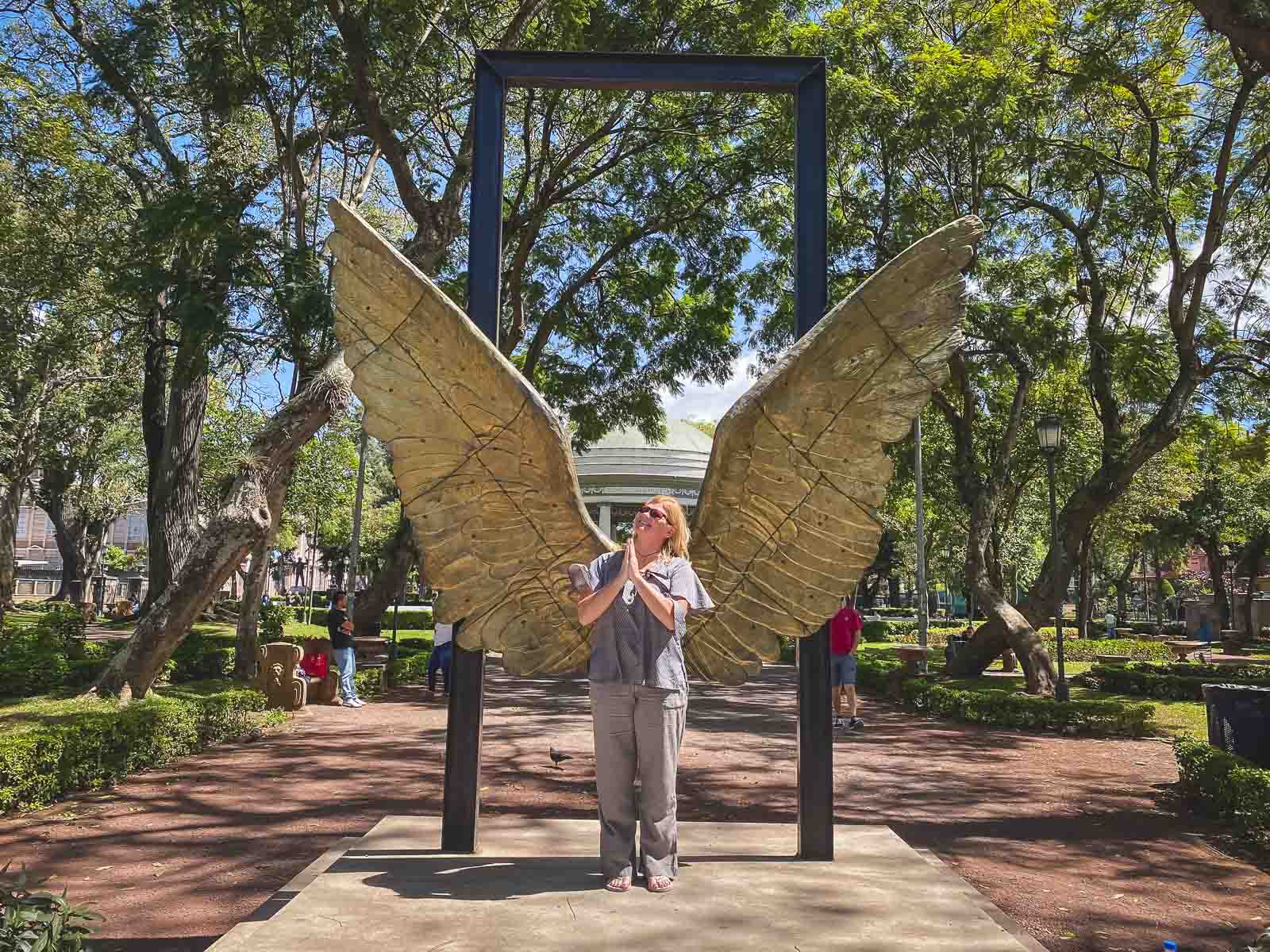
San Jose can be overwhelming when you first arrive. The city is a sprawling metropolis, as crowds of people fill the various walking streets, and the restaurants are packed with young and hip urbanites. Once you look past the congestion and chaos, you’ll discover a cultural city filled with plenty of things to do.
When landing at San Juan Santamari a International Airport, take the stress out of travel and b ook your private transfer to your hotel. Your driver will greet you at arrivals and take you directly to your hotel hassle-free. This airport is also where you’ll fly into when visiting the Arenal volcano area and Monteverde cloud forest.
Where to Stay in San Jose
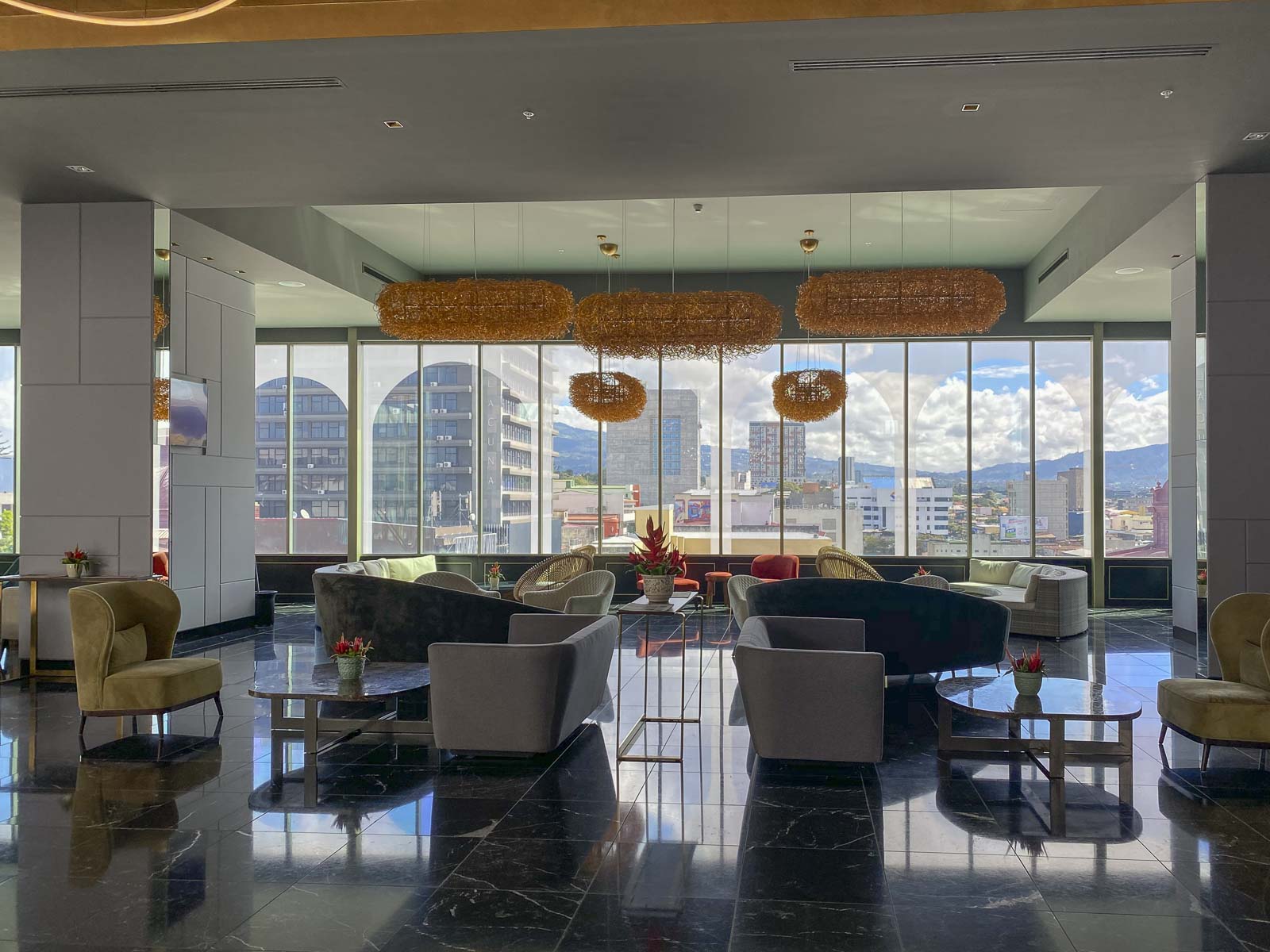
We suggest staying near Avenida Central (Central Avenue) in downtown San Jose. Located in the center of the city, it is easy to walk to many of the top San Jose attractions. There is a huge concentration of hotels in this area to suit all budgets and we stayed at the Gran Hotel San Jose Hilton .
I wouldn’t suggest staying at the Juan Santamaria International Airport even though there is plenty of accommodation here. It is just a little too far out of town and you won’t really be able to take in all of San Jose’s nightlife and attractions. We loved being able to go for a walk on Avenida Central at night and early in the morning. That being said, the Hampton Inn & Suites is lovely . It’s a little more affordable and Ubers are quite reasonable to get around San Jose. If you are doing day trips and guided tours, the airport area could be a good option. Check it out on TripAdvisor
Gran Hotel San Jose
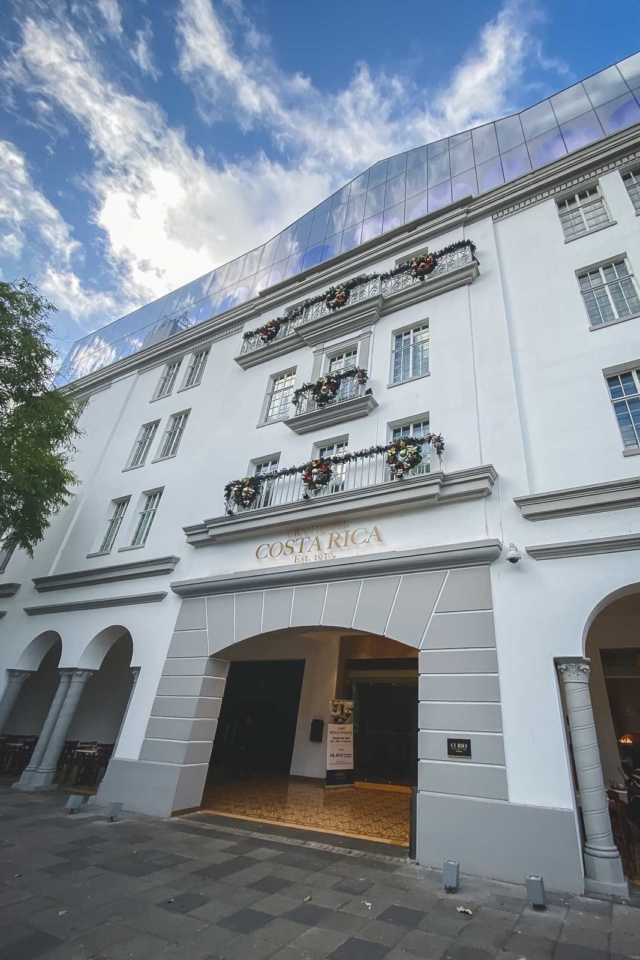
The Gran Hotel San Jose Hilton made for a great base to explore all of San Jose’s top tourist attractions and it was a superb property with outstanding views of the city. We had some travel points to use so we searched for the most convenient luxurious hotel we could find and it was perfect. We walked everywhere and its bar had the best views in the city. Even without travel points, it is an affordable luxury hotel by any city standards. Check out prices and availability on TripAdvisor / Booking.com
If you are looking for a more local option make sure to check out this cool Air B&B right in the center of town.
What to do in San Jose Costa Rica
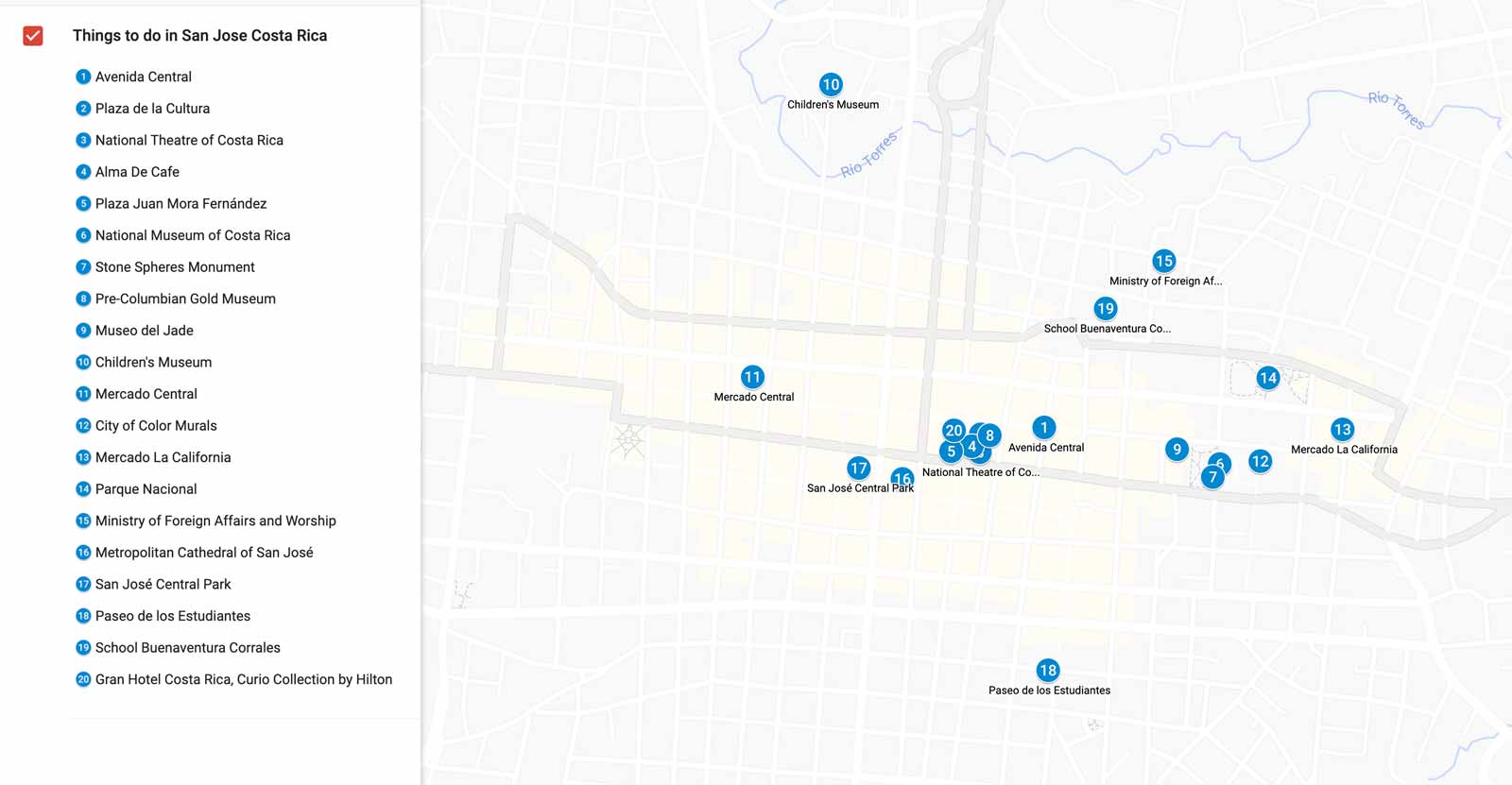
Okay, now that we have suggested where to stay in the city, let’s take a look at all the amazing things to do in San Jose Costa Rica to entice you to add it to your bucket list. Let’s go!
1. Avenida Central – Central Avenue
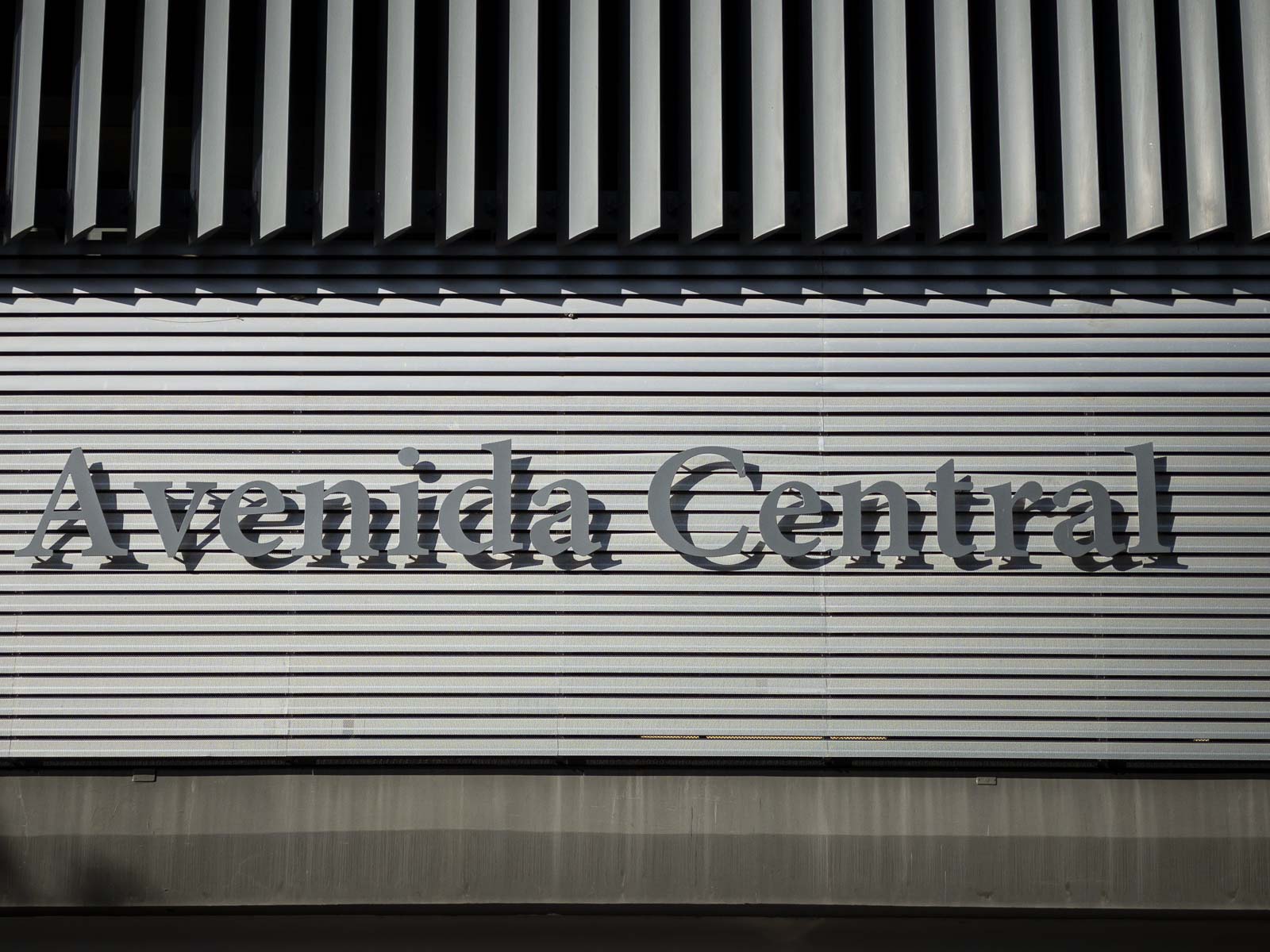
Avenida Central (Central Avenue) is a walking street that goes right through the core of downtown San Jose. It is filled with restaurants, shops, and attractions. The best way to start your day is to find a local coffee shop to have some flavorful Costa Rican coffee take it away with you, and start walking along the avenue. Avenida Central is quiet in the mornings and walking along the street in solitude is the perfect way to get your bearings.
We took a long stroll from end to end to start planning our day. There are several walking streets beside Avenida Central in San Jose, and there are many walking streets that branch of from the main Central Avenue so get lost and stroll as long as you like along the auto-free streets to feel the energy of the city. There’s great shopping along here as well.
If you enjoy walking, this food and walking tour is a super way to learn about Costa Rican culture and food where you’ll meet in the morning for coffee at a café in Borbon Market before setting off to one of San Jose’s top attractions, Central Market to sample local foods and fruits.
2. Plaza de la Cultura
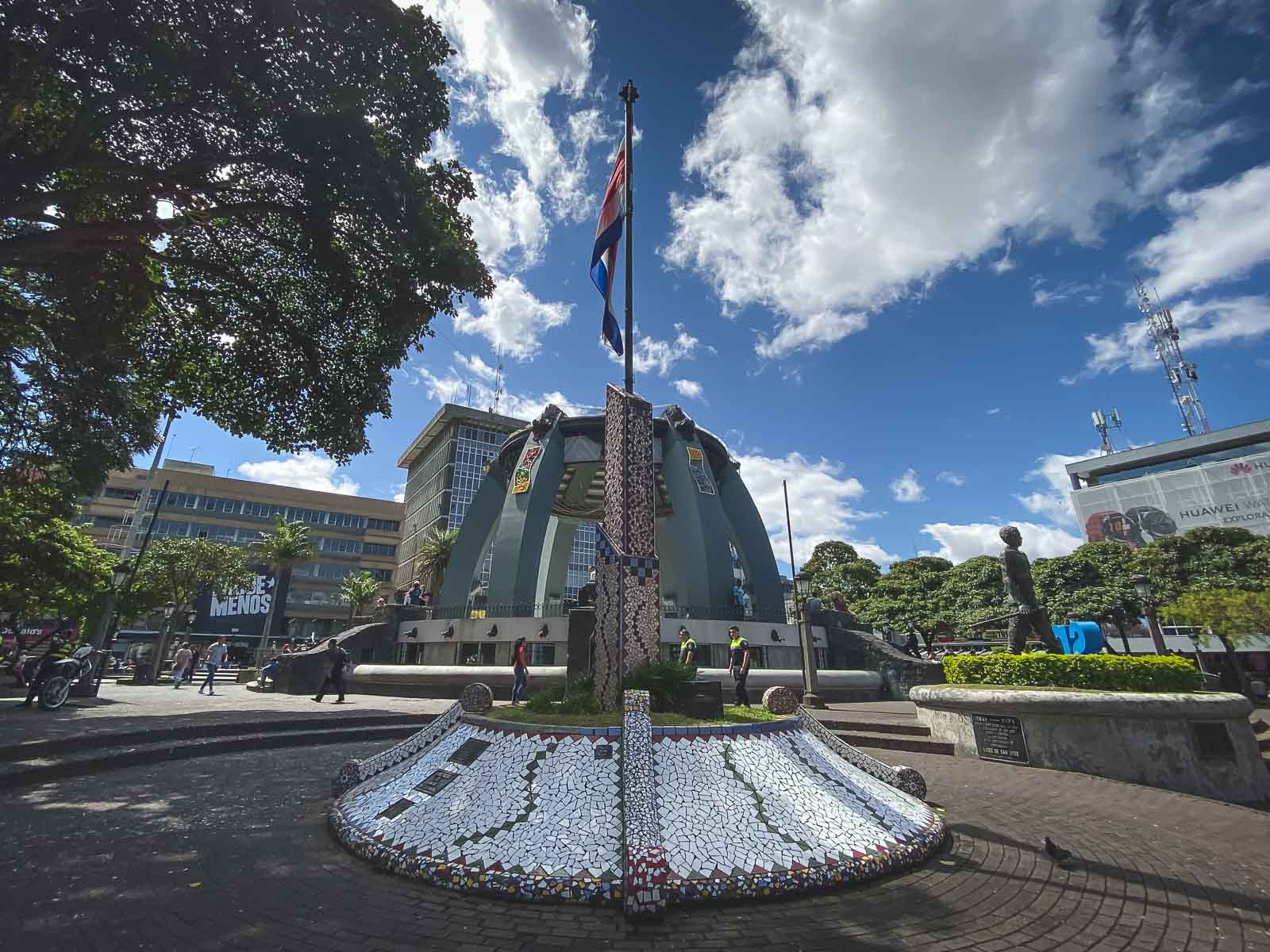
The Plaza de la Cultura is the main square of San Jose and a great place to begin your San Jose exploration. In the heart of the plaza, vendors sell crafts, street performers show their skills, and locals sell birdseed to feed the pigeons flocking to the square. If you want that classic photograph of a swarm of birds soaring off at your feet, this is the place to do it.
There are plenty of things to do in this area of San Jose that you can easily walk to from the plaza. Many of the top sights like the Central Market, Museo de Jade, Teatro Nacional de Costa Rica, and Gold Museum are all within walking distance of this plaza. It is here you’ll find typical fast-food chains found in every city in the world and it’s a great place to grab some ice cream to take with you as you explore.
Don’t be alarmed by all the police walking around wielding guns, they are there as a deterrent. Plaza de la Cultura is very safe and it is a spot where many tour groups meet up. The police are there to make sure everyone feels safe and because of that, it is probably the safest place in all of San Jose.
3. Teatro Nacional de Costa Rica – National Theater of Costa Rica
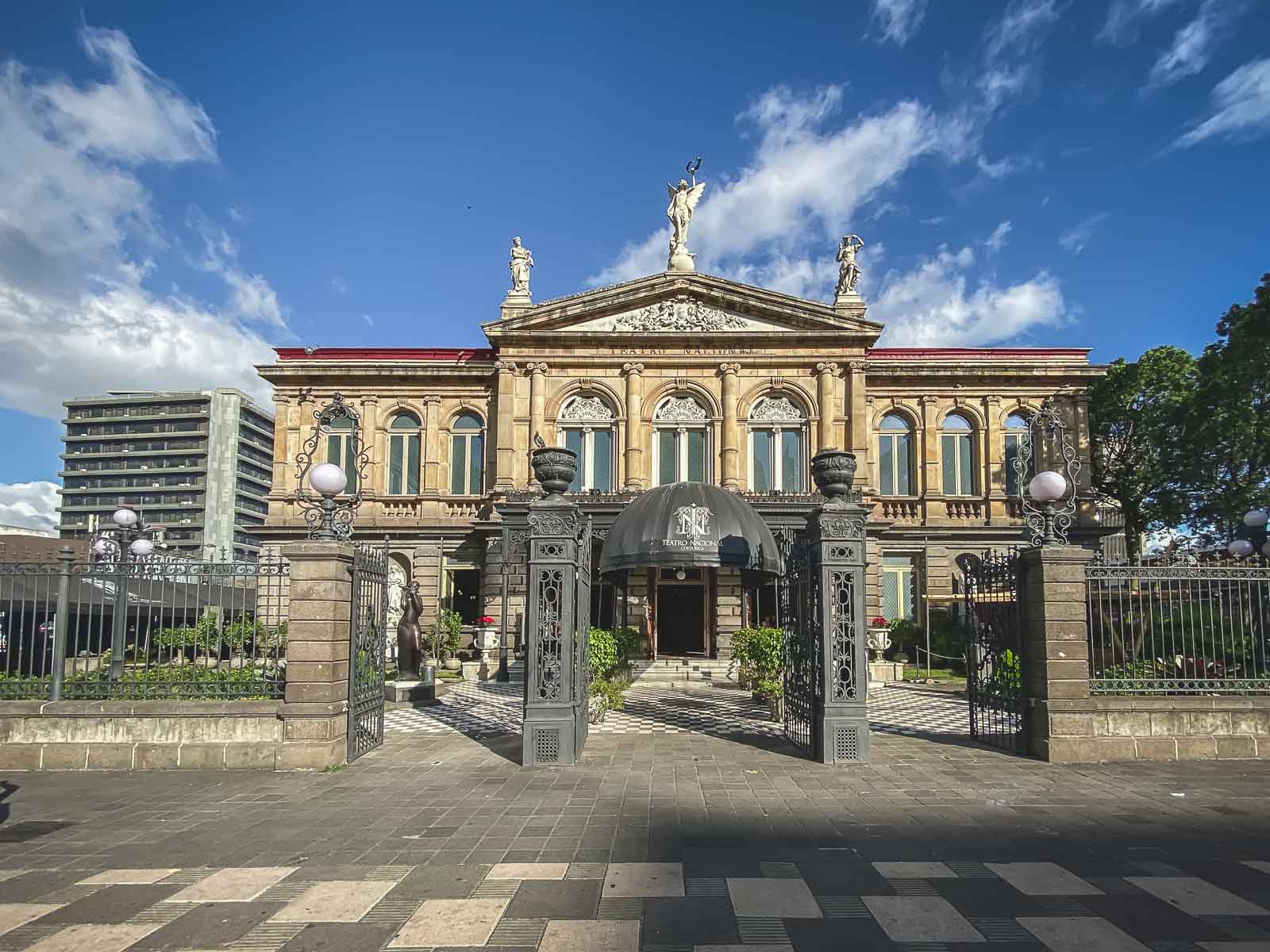
The National Theater of Costa Rica ( Teatro Nacional de Costa Rica) is the centerpiece of San Jose and one of the city’s top attractions. It’s a meeting spot for tours and friends to meet up for coffee and it is the Grande Dame of the town. Dating back to 1897, this historic building is a must-see for anyone visiting San Jose.
The coffee barons of the 19th century went all out importing marble from Italy, and commissioning opulent frescoes and statues of Beethoven and Spanish Playwright. The original statues have been moved inside for fear of earthquakes and erosion so make sure to go in for the full experience.
The grand theater is beautiful from the outside with its neoclassical facade, stone columns, but inside you’ll find an ornate interior. The first thing you’ll notice is a painting by Aleardo Villa. Alegoría al Café y el Banano (Allegory of Coffee and Bananas) is dedicated to the Costa Rican coffee and banana harvest.
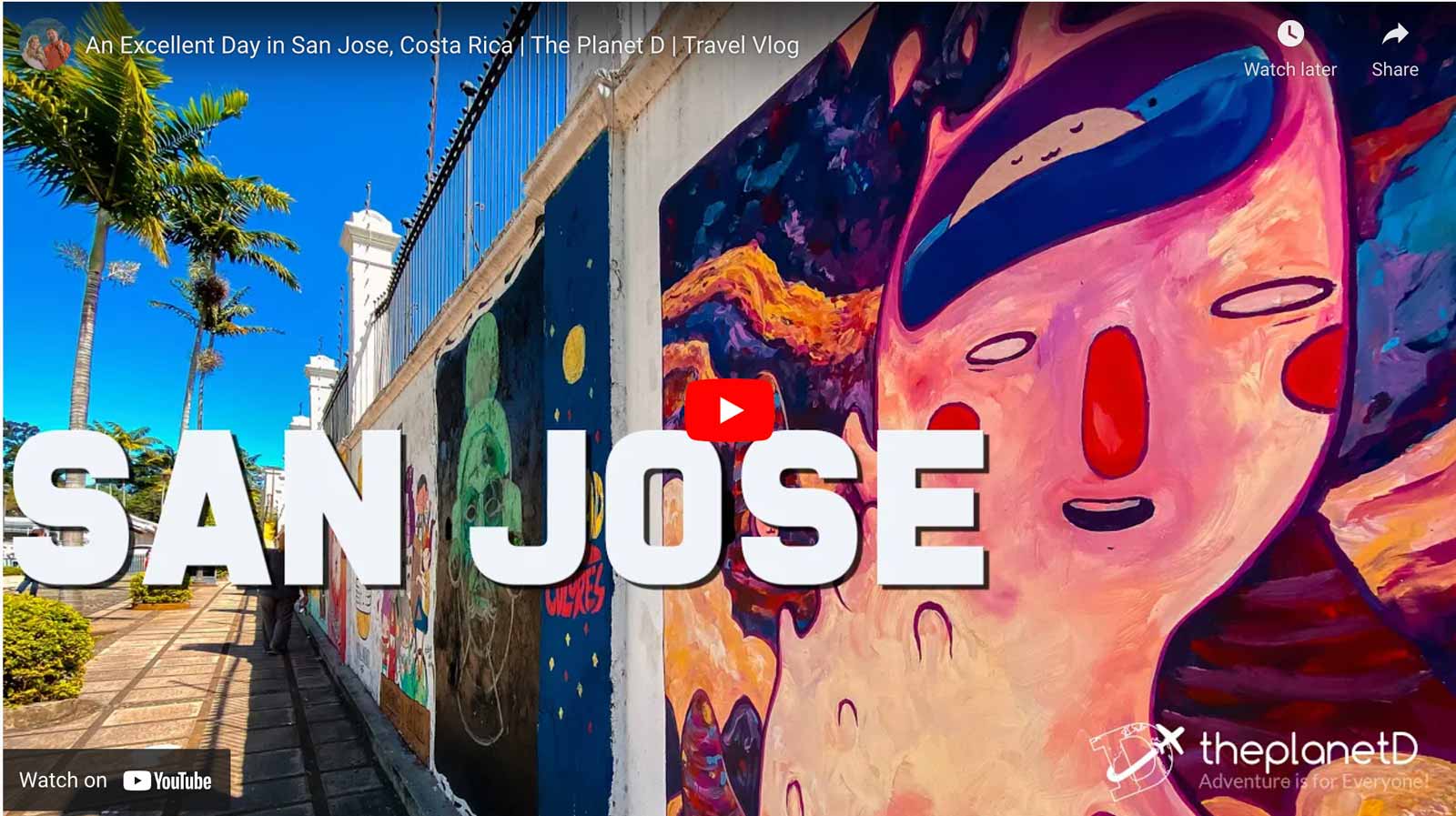
Guided Tours
Tours are offered for $11 USD and are offered hourly in both Spanish and English. You’ll learn about the history and architecture and they take you on a backstage tour to see every nook and cranny. If you don’t want to take a tour, you can see a performance. This is the premier theater in Costa Rica and you’ll be able to watch everything from classical music to comedians and dance performances. Note: No photos are allowed in the theater.
4. Coffee Shop at National Theater
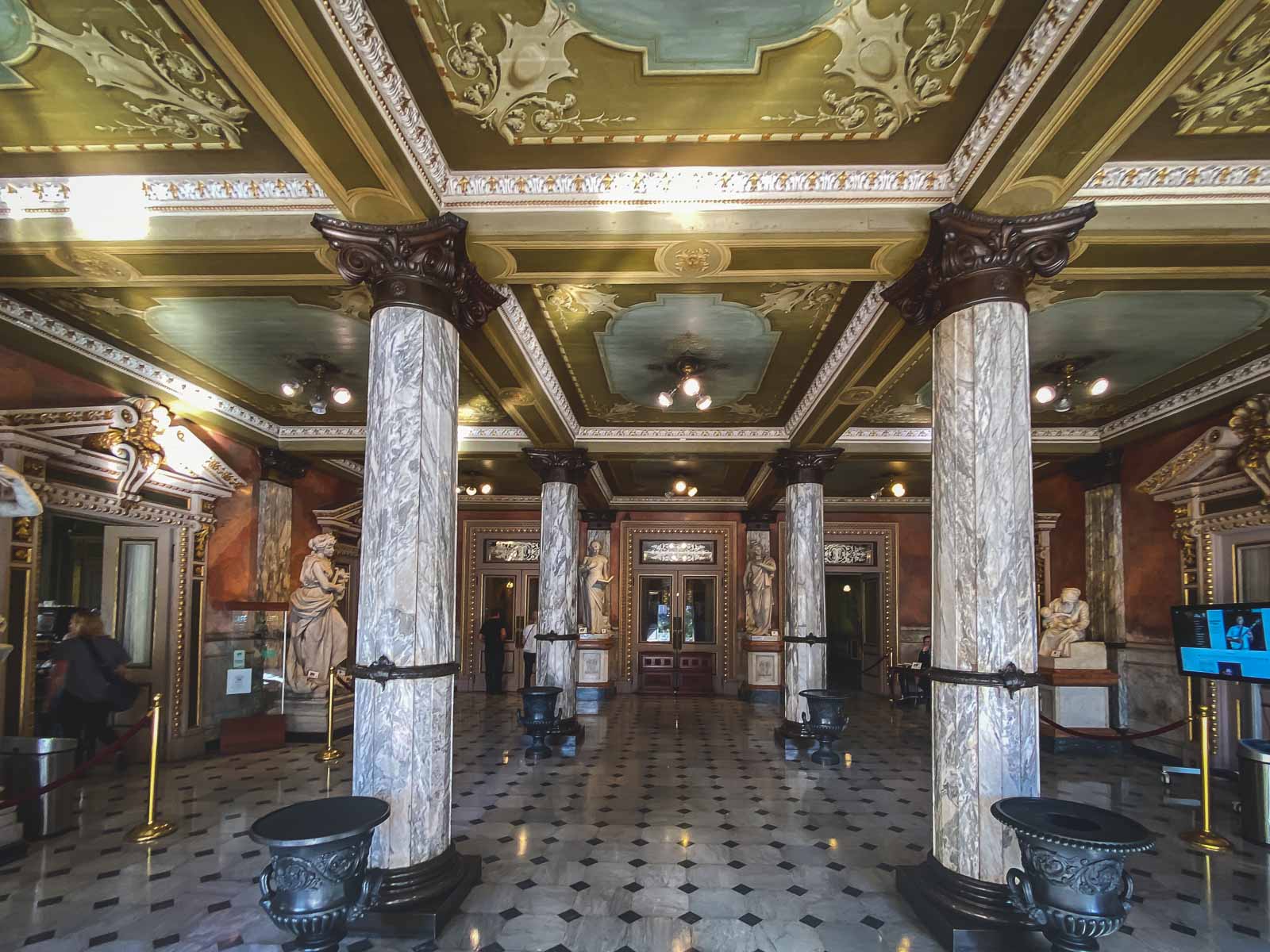
If you don’t have time for the 45-minute tour, or if you don’t want to spend the $11, there is a coffee shop in the lobby where you can enjoy a delicious Costa Rican coffee. If you ask to use the bathroom, you can take a peek inside the theater itself. They’ll give you a pass to get by security, but don’t spend too long lingering or you’ll get caught! The coffee shop is busy, so be sure to grab a table as soon as you see one.
5. Take a Free Walking Tour
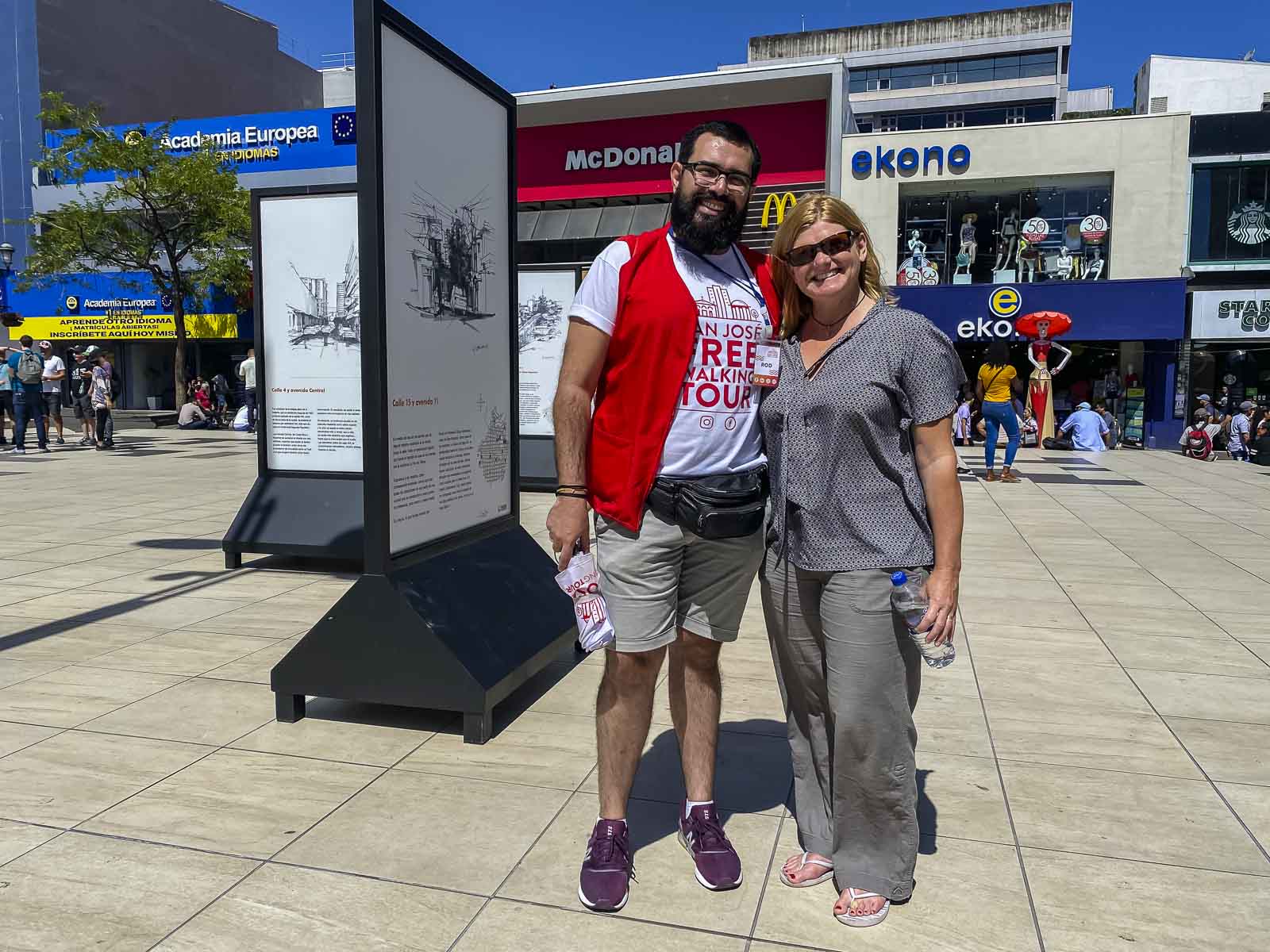
Each day at 9:00 am, there is a free walking tour led by local guides. They are offered in both Spanish and English. Patrons meet in front of the T eatro Nacional and join their guide with the red vest and umbrella for a cultural tour of San Jose. The free tours don’t ever leave at 12:30, they leave at 9:00 am every day.
Taking the free walking tour of San Jose is one of the best ways to get acquainted with the city. We suggest doing this on your first day. It takes you to all the city highlights so you can get your bearings and decide where to come back to in the coming days. The local guides are knowledgeable and friendly and offer tips and information on where to eat and what else to see in San Jose. The tour is free, but make sure to show your guide some love at the end. Suggested Tip: $10 USD per person.
Looking for Day Tours from San Jose Costa Rica? These are the most popular!
San Jose is a great place to make a base for Costa Rican day trips. With its central location, you can easily get to see the cloud forest, volcanoes, and waterfalls.
- EXPLORE THE CLOUD FOREST FROM SAN JOSE
- VOLCANOS AND WATERFALLS ON A DAY TRIP
- FULL DAY ZIP LINING AND HOT SPRINGS WITH MEALS
We have a full description of San Jose’s best day trips at the end of this post. You can skip here to browse San Jose day trips
Beware, there is a copycat guide that stands out in front of the theater publicizing his own walking tour. He nearly got us the day before telling us that the free walking tour starts at 12:30. We popped up to our hotel room to drop some stuff off and looked up how much we should tip. The first thing we saw was his face warning that he was a fraud.
6. Museo Nacional de Costa – National Museum
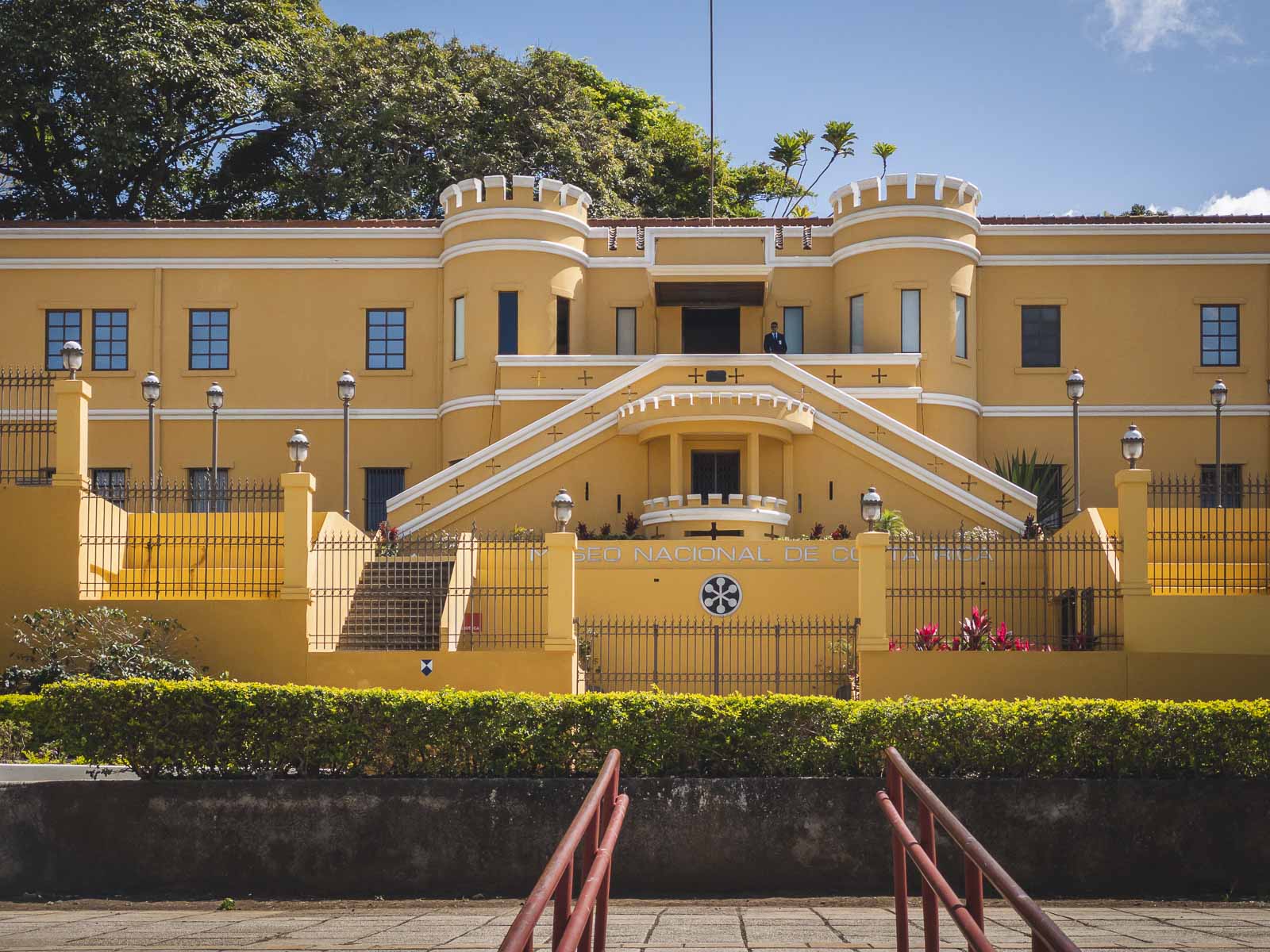
San Jose is filled with museums showcasing Costa Rican history and culture and the National Museum (Museo Nacional de Costa) is San Jose’s premier museum. The National Museum was originally a fortress and these were its army barracks that give a nice overview of the history of Costa Rica with pre-Columbian artifacts to the abolishment of the Costa Rican Army in 1948. We found this fact fascinating. Costa Rico has not had a military since its civil war in 1948.
Military History and Bullet Holes of National Museum
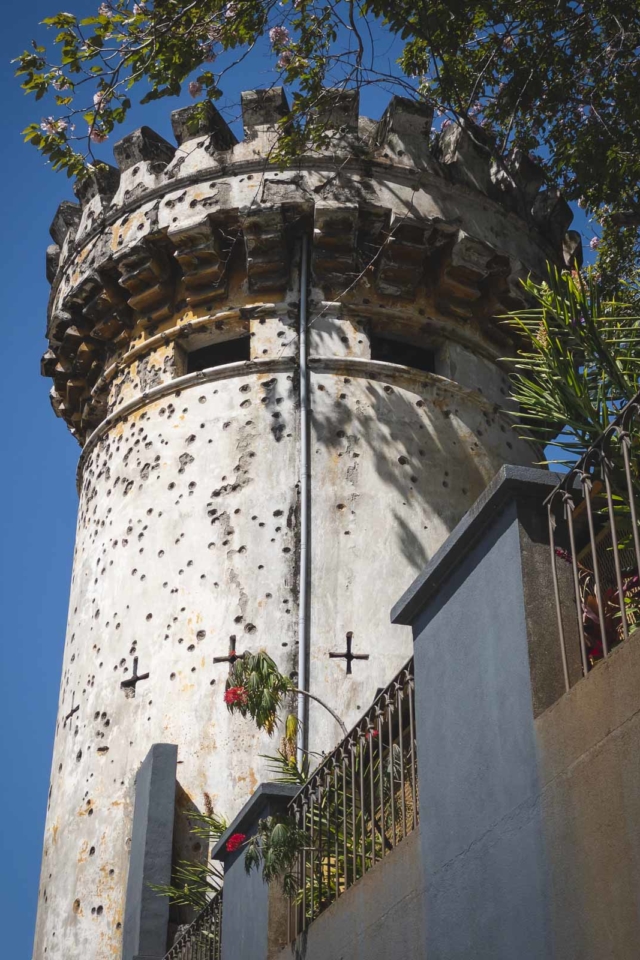
If you aren’t a museum fan, you still must stroll along the outside of the Museo Nacional de Costa to see the bullet holes in the walls and watchtowers. It was a fierce battle and the scars still show from the 1948 Civil War.
As the former president, and Nobel Peace Prize Laureate, Oscar Arias Sanchez said, “Military solutions to conflicts should be the last, last resort, Here, conflicts are resolved at a negotiating table.”
7. Stone Sphere – National Museum
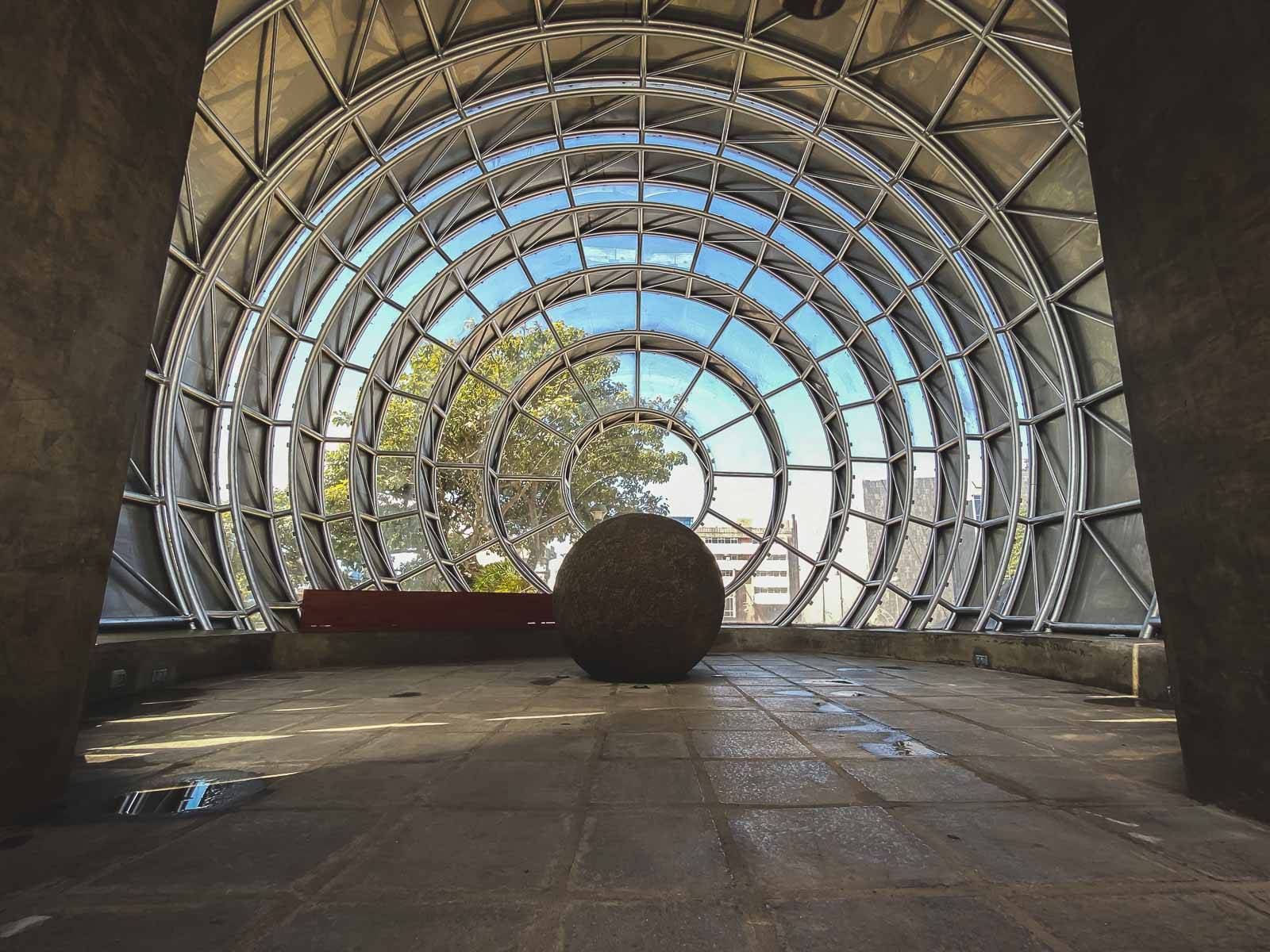
The mysterious stone spheres of Costa Rica date back to 200BC and there have been more than 300 of them discovered throughout the country. You don’ have to go in search of them though, there is one located right downtown San Jose in the National Museum. The nearly perfectly smooth sphere sits on display in a glass encasement.
The stone spheres around Costa Rica range in size from a few centimeters to two meters in diameter and they weigh up to 15,000 kg (16 tons). They are so impressive that some are on display around the world including two in the United States. Our guide told us that treasure hunters blew them up when they were first discovered thinking that gold was hidden inside.
8. Pre Columbian Gold Museum of San Jose
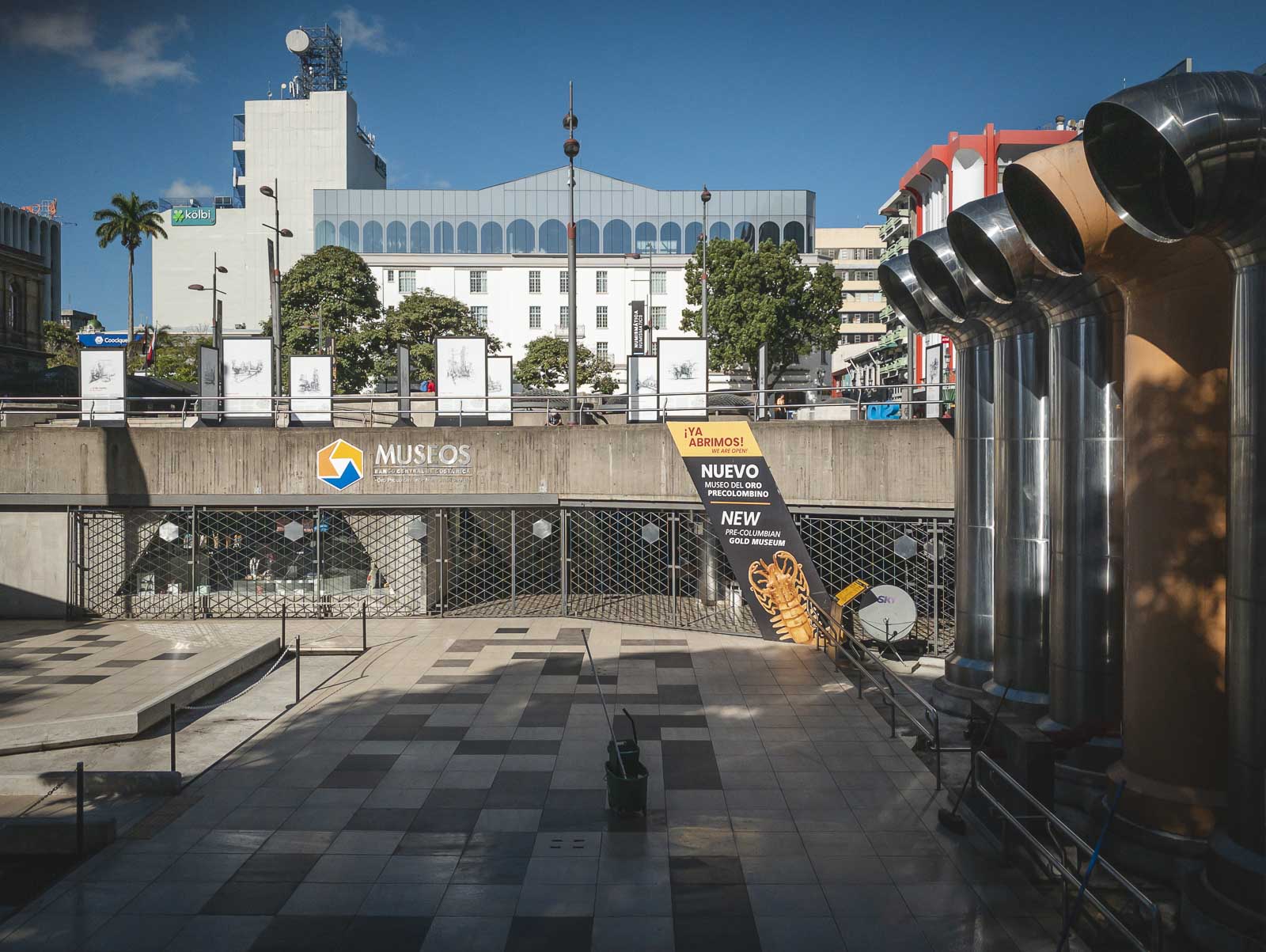
Located in the heart of downtown San Jose under San Josés main square, The Pre-Columbian Gold Museum is one of the most popular museums to visit in San Jose. Some of the metal objects on display date back to 500 AD. Here you’ll learn of what everyday life was like centuries ago. It also traces Costa Rica’s history from 500 AD to the 1500s when the Spanish arrived. This museum focuses on the purpose and uses of gold spanning from Pre Columbian times. The Gold Museum is one of the top attractions in San Jose with more than 1600 pieces of gold artifacts on display.
9. Jade Museum
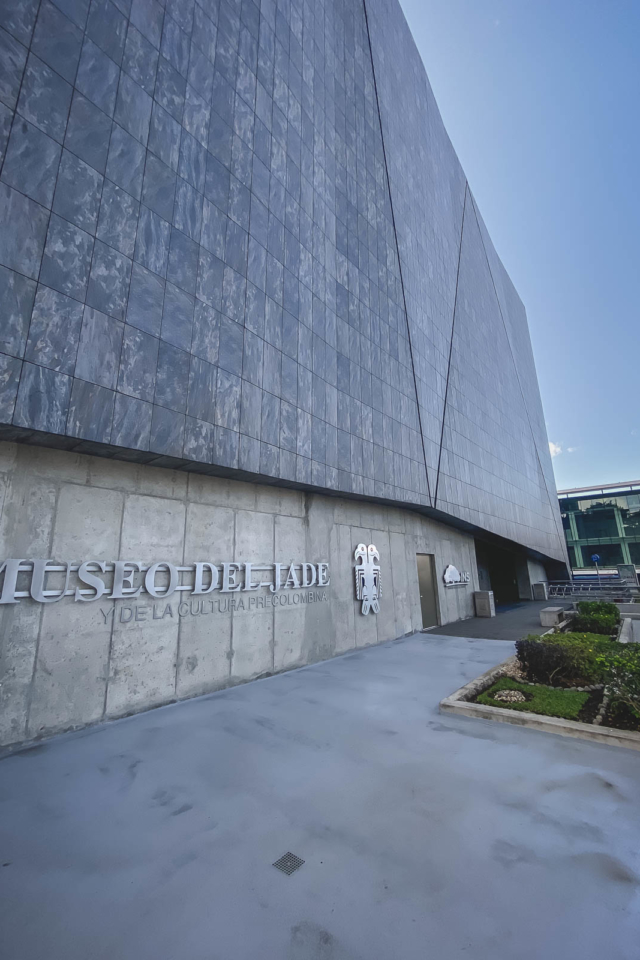
The Jade Museum is yet another museum that is worth visiting in San Jose. It houses the largest collection of pre-Columbian jade in the world. Museu de Jade is located just behind the National Museum so if you have extra time, you can pop in there. The jade on display dates back to 500 BC. The Pre-Columbians traded with the Mayans during this period and this rare stone played a large role in the daily life of Pre-Columbian Costa Rica. It’s located just across the Plaza de la Democracia from the National Museum.
10. Children’s Museum
If you are looking for things to do in San Jose with kids, make your way to the Children’s Museum. The Museo de Los Ninos is popular for families complete with dinosaurs, science displays, ancient Egypt, and Costa Rican history. What makes it good are the interactive displays.
Museum of Natural Sciences – Considered one of the best in Latin America for animals, archeology, and dinosaurs.
11. Mercado Central – Central Market
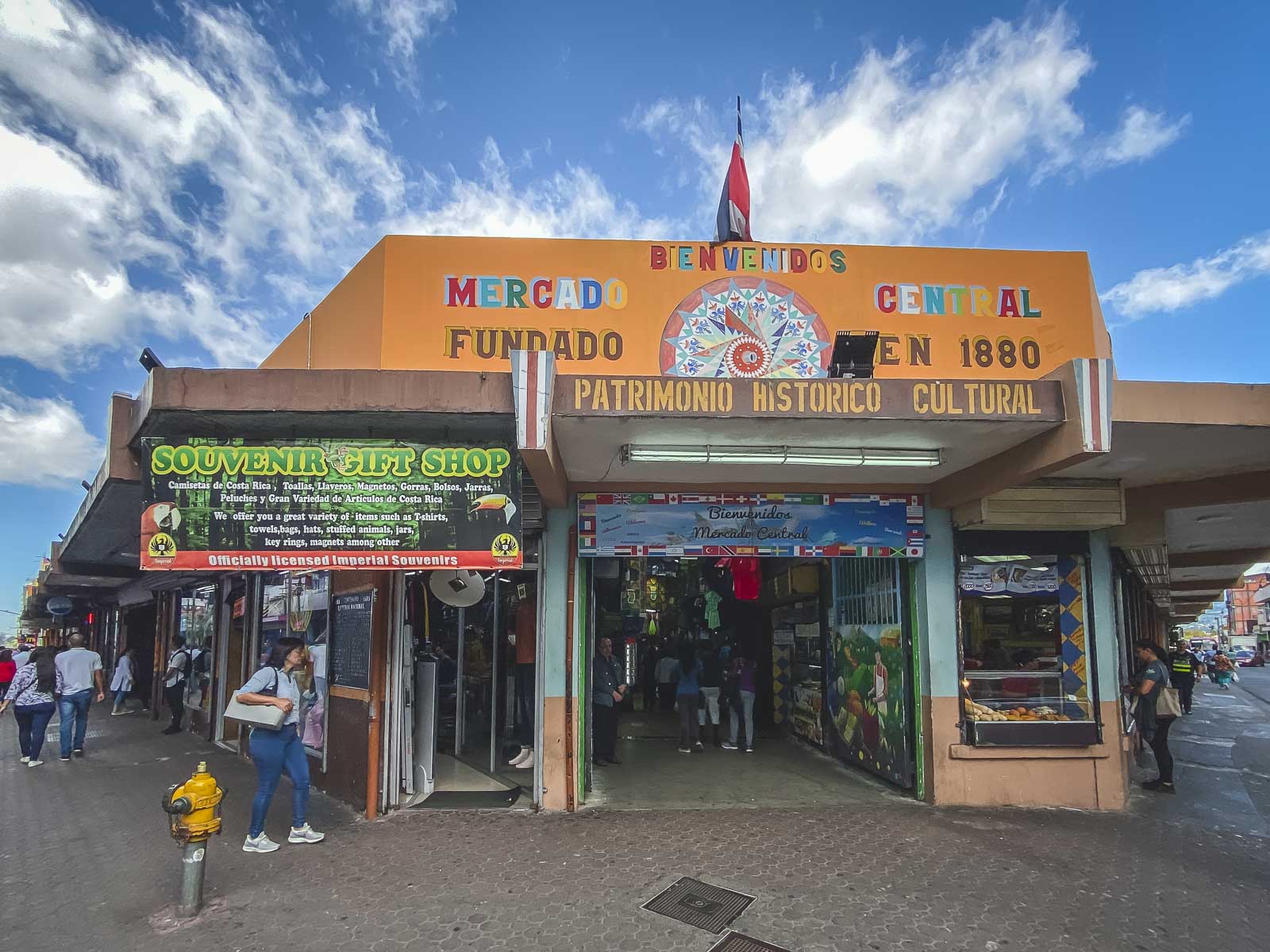
When searching for souvenirs, Central Market is a good place to start. Central Market is one of Costa Rica’s oldest landmarks dating back to 1821. It is filled with food stalls and souvenir shops, but it is also a place to rub elbows with the locals. Locals regularly shop at this market and with its many food stalls you can sample some authentic Costa Rican food at bargain prices. You’ll see a lot of people sitting on stools eating traditional food, so why not join them and say hello!
12. California Boulevard
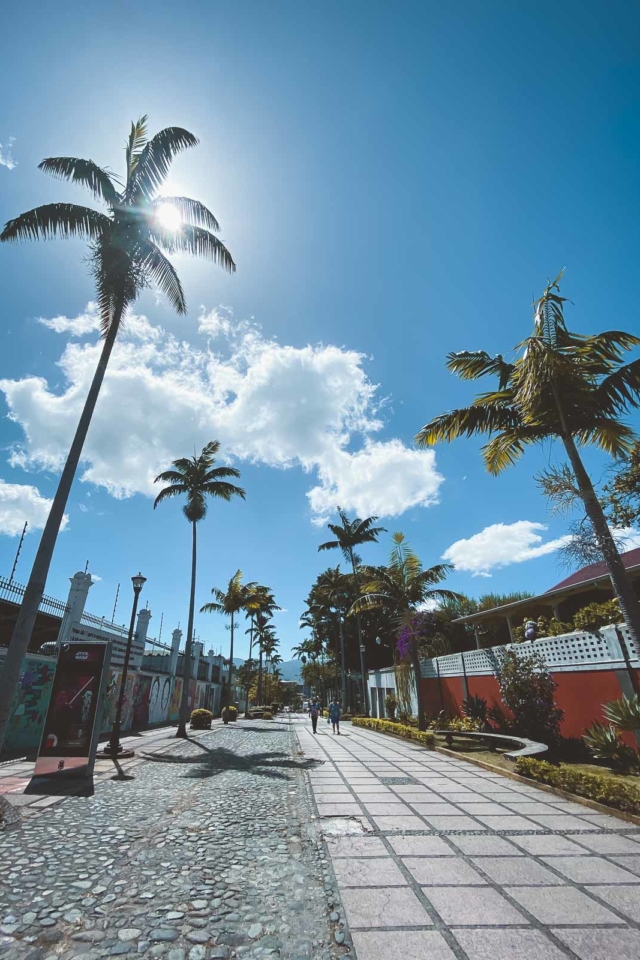
Another lovely walking street in San Jose can be found in front of the National Museum. California Boulevard, aka Calle 17 is a beautiful path that was designed to mimic the streets of Los Angeles. This walking street is far quieter than Avenida Central and its cobblestone path is lined with palm trees and colonial architecture. This is where you’ll find many government buildings, private residences, and educations centers.
13. Graffiti Wall
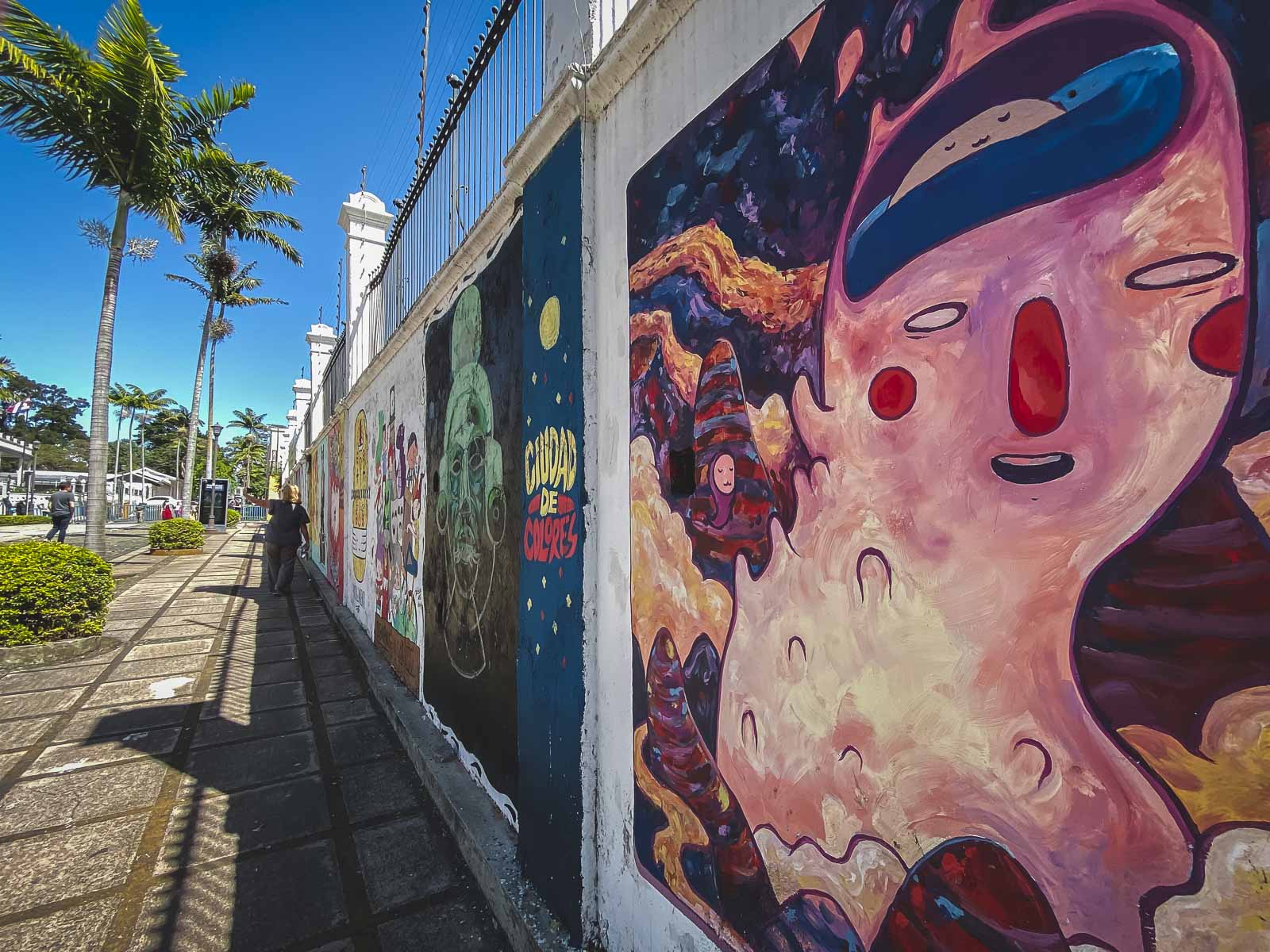
Along California Boulevard, is where you’ll also discover beautiful street art. Like many cities around the world, street tagging was becoming a problem in San Jose, so they offered artists a chance to own a piece of the wall to celebrate their expression of art. We were told that each artist auditioned for their spot and they were granted a piece of wall for five years.
14. National Park of San Jose
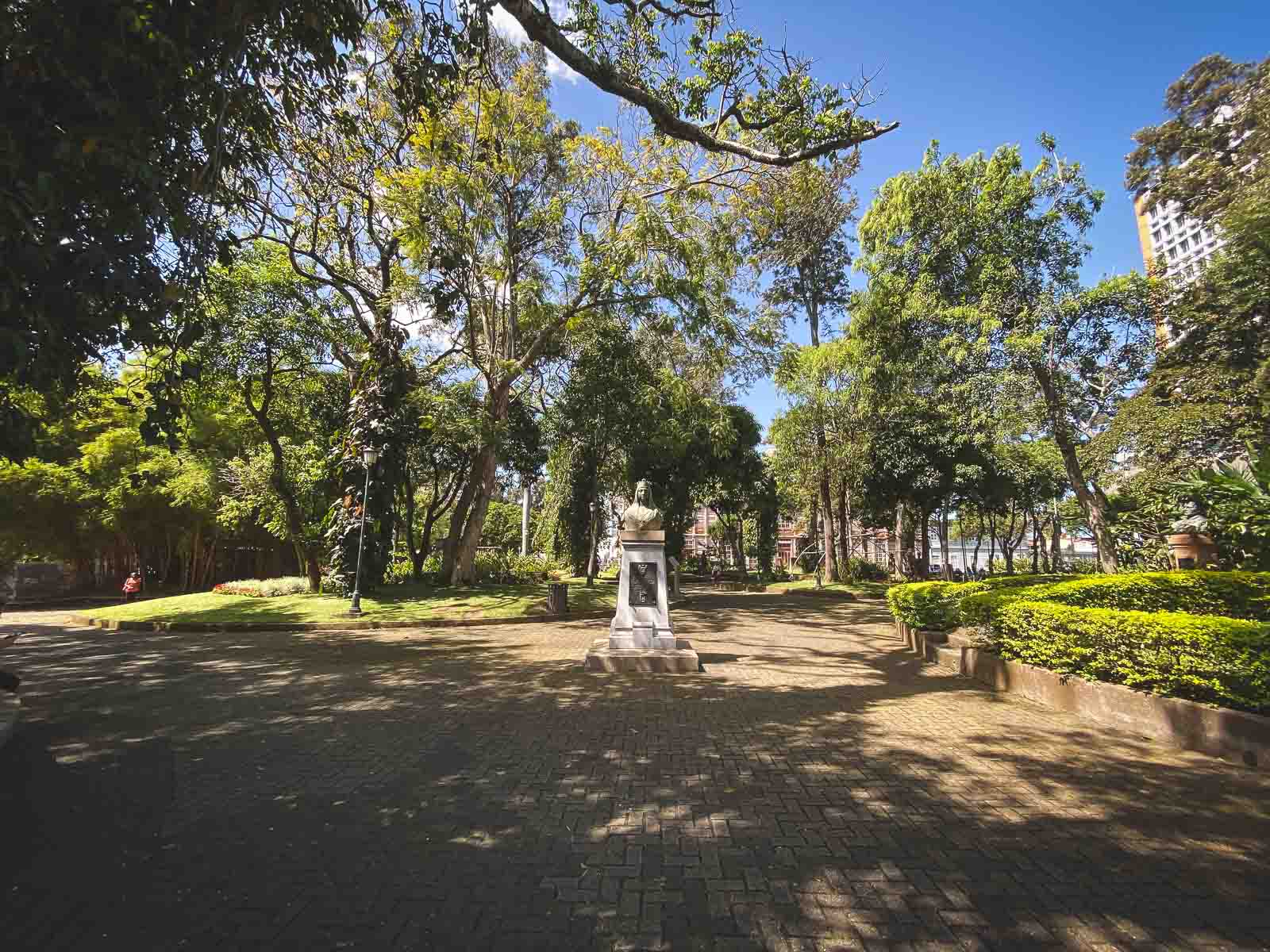
It is a quiet and small park, but the National Park of San Jose is historic. It is also a spot where you can view the railway. At one time, trains were a popular way to get around Costa Rica, but corruption put a stop to them when the people in power had a vested interest in automobile manufacturing. Today, Costa Rica is working on rebuilding the rail lines and soon tourists will be able to get around the country in the comfort of trains.
15. Sa Casa Del Cacao – Chocolate Factory
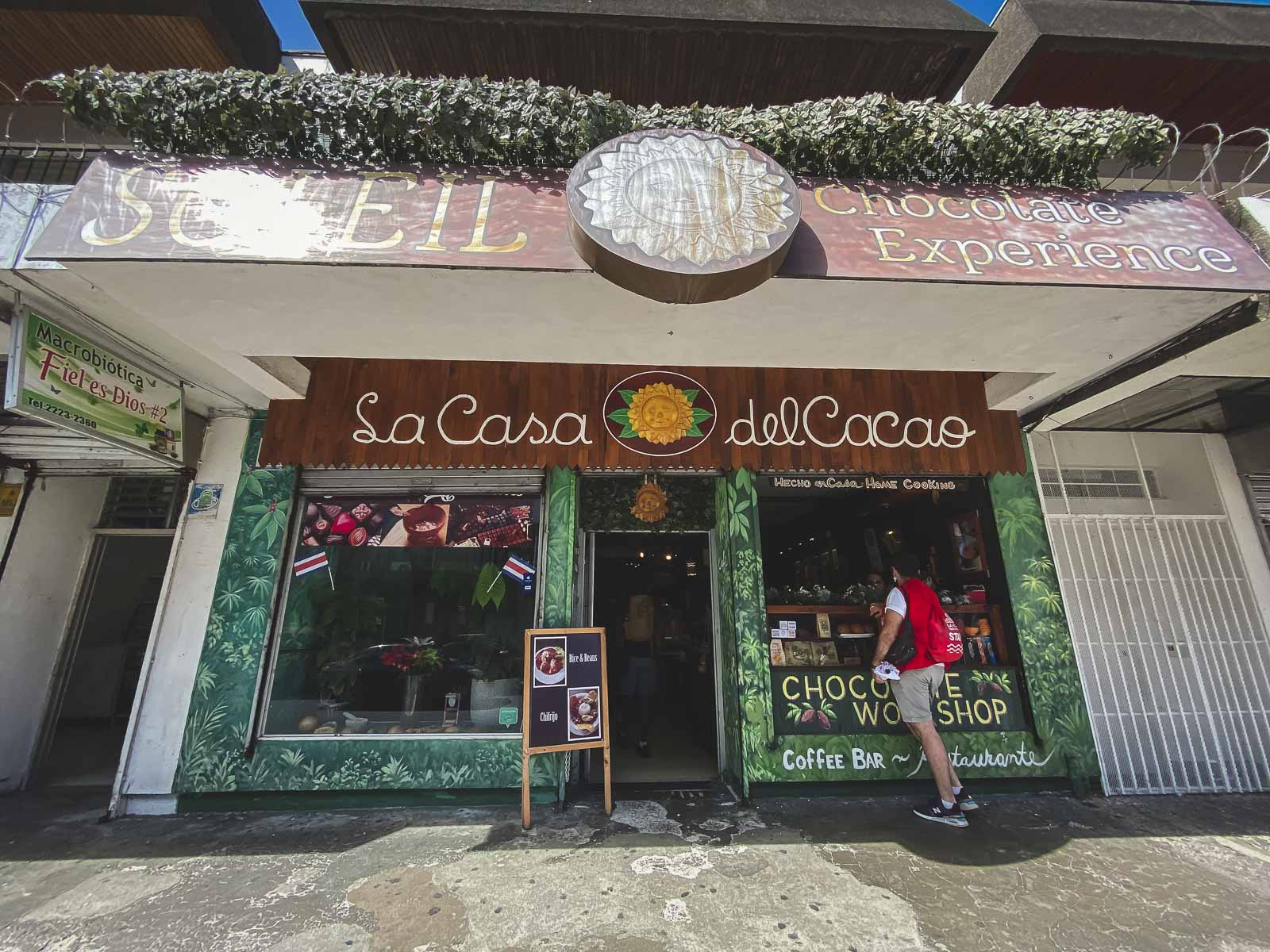
Chocolate was once prized as much as gold in Costa Rica and it was once the top export of the country. In Costa Rica’s history, chocolate was used in indigenous ceremonies and was so important it was used as currency. Chocolate production is making a comeback in Costa Rica, and the Casa del Cacao (The Costa Rican House of Chocolate) is a good place to experience some of that chocolate culture. It offers chocolate workshops and is a great place to pick up some genuine Costa Rican chocolate. Located in downtown San Jose you can sample two of Costa Rica’s prize exports, chocolate and coffee.
16. Berlin Wall
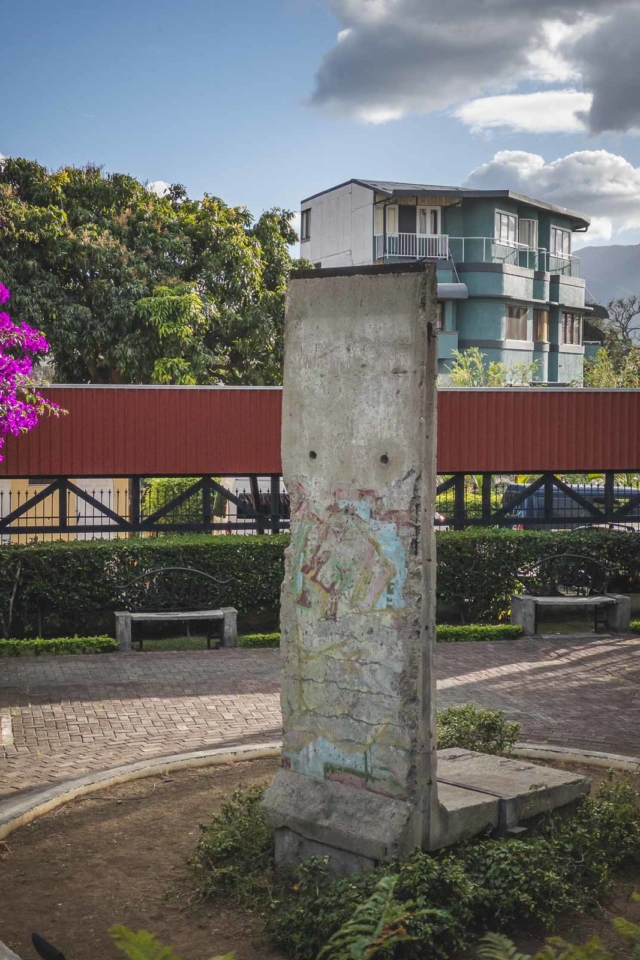
One of the best things to see in San Jose that nobody knows about is the Berlin Wall. Located behind the Foreign Ministry is a piece of the Berlin Wall. It’s a lovely yellow building, so you can’t miss it if you are strolling around the city. We always love finding pieces of the Berlin Wall in our travels. We were surprised to find that San Jose had a piece. You really need to seek it out as it isn’t exactly on display and many people walk right on by. We had to take photos through the fence to see it. The wall was a gift to Costa Rica after Costa Rica’s Foreign Minister asked for it to commemorate the 150th anniversary of its foreign ministry. Now you know, and here are more cool Costa Rica Facts to check out.
17. Metropolitan Cathedral of San Jose
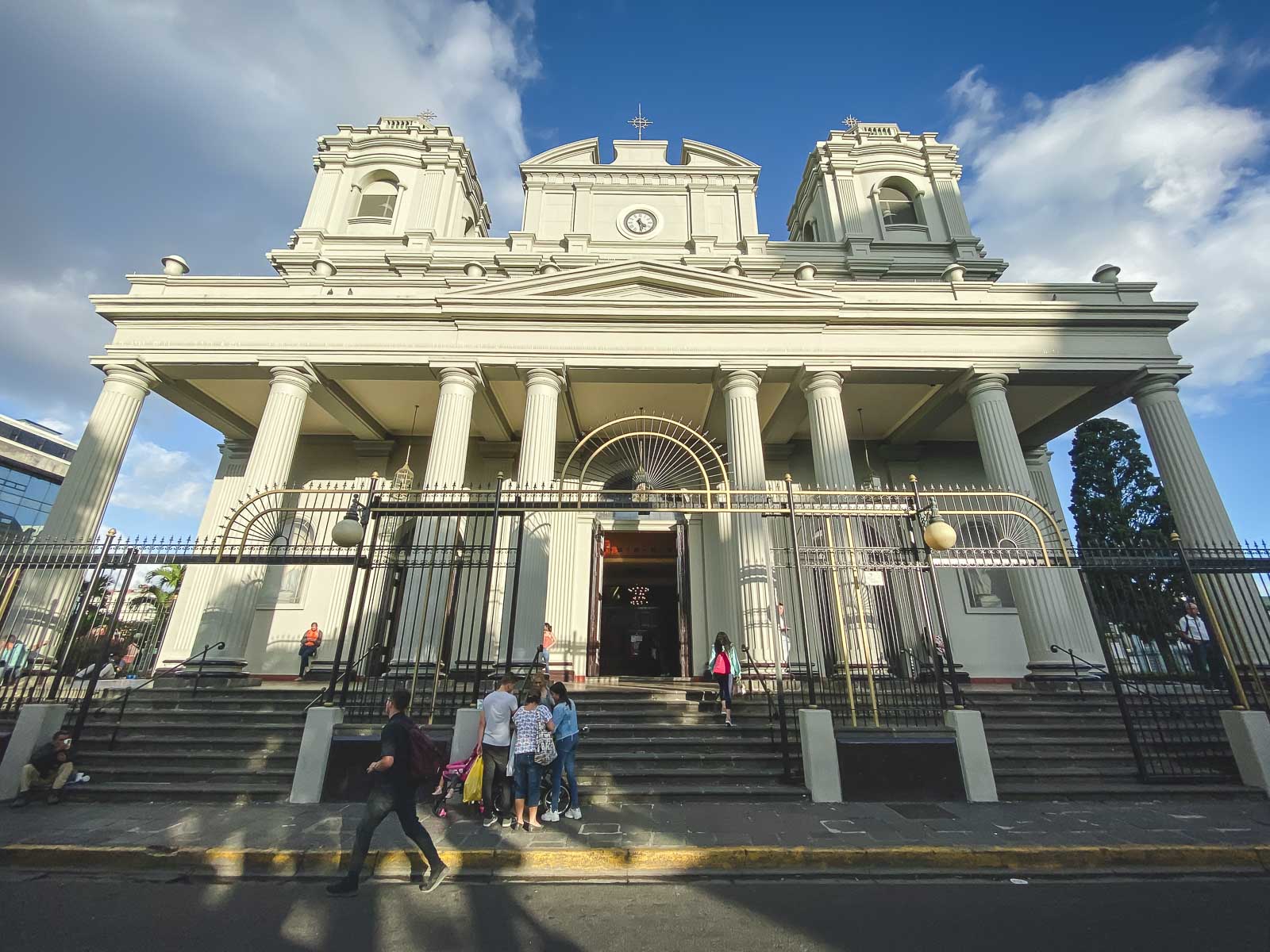
San Jose’s most beautiful cathedral is located in the heart of the city. The Metropolitan Cathedral of San Jose’s doors are open to visitors, but be respectful as it is a working cathedral. Each time we visited, mass was taking place and worshippers were sitting in the pews. Its beautiful design is a mix of baroque, neoclassical, and Greek orthodox. After a series of earthquakes, it was rebuilt in 1871 and has been welcoming worshippers and visitors ever since. It is such an important church that Pope John Paul II visited the cathedral in 1983.
18. Central Park
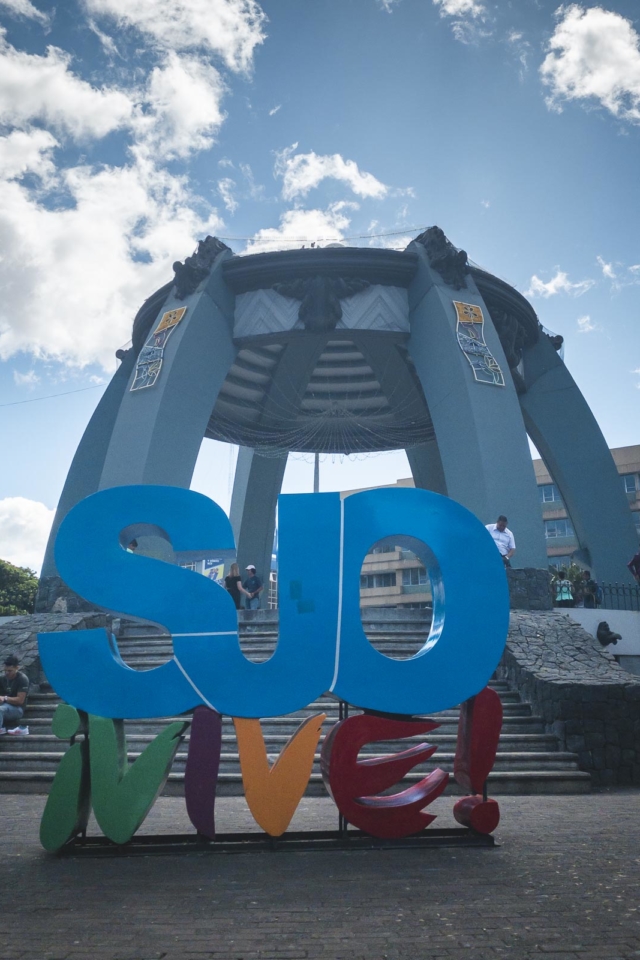
If you are looking for that Instagrammable city sign that can be spotted all over the world, this is the place to go. It’s less crowded than the San Jose sign at Plaza de la Cultura and is a nice little park to take a break from sightseeing.
Central Park is San Jose’s oldest public space and it is located beside the Metropolitan Cathedral. Street performers can be found alongside business people eating their lunches and kids skateboarding on the concrete. There’s some interesting architecture to check out here and it’s a popular hanging spot for locals.
19. View from the Bar at Gran Hotel
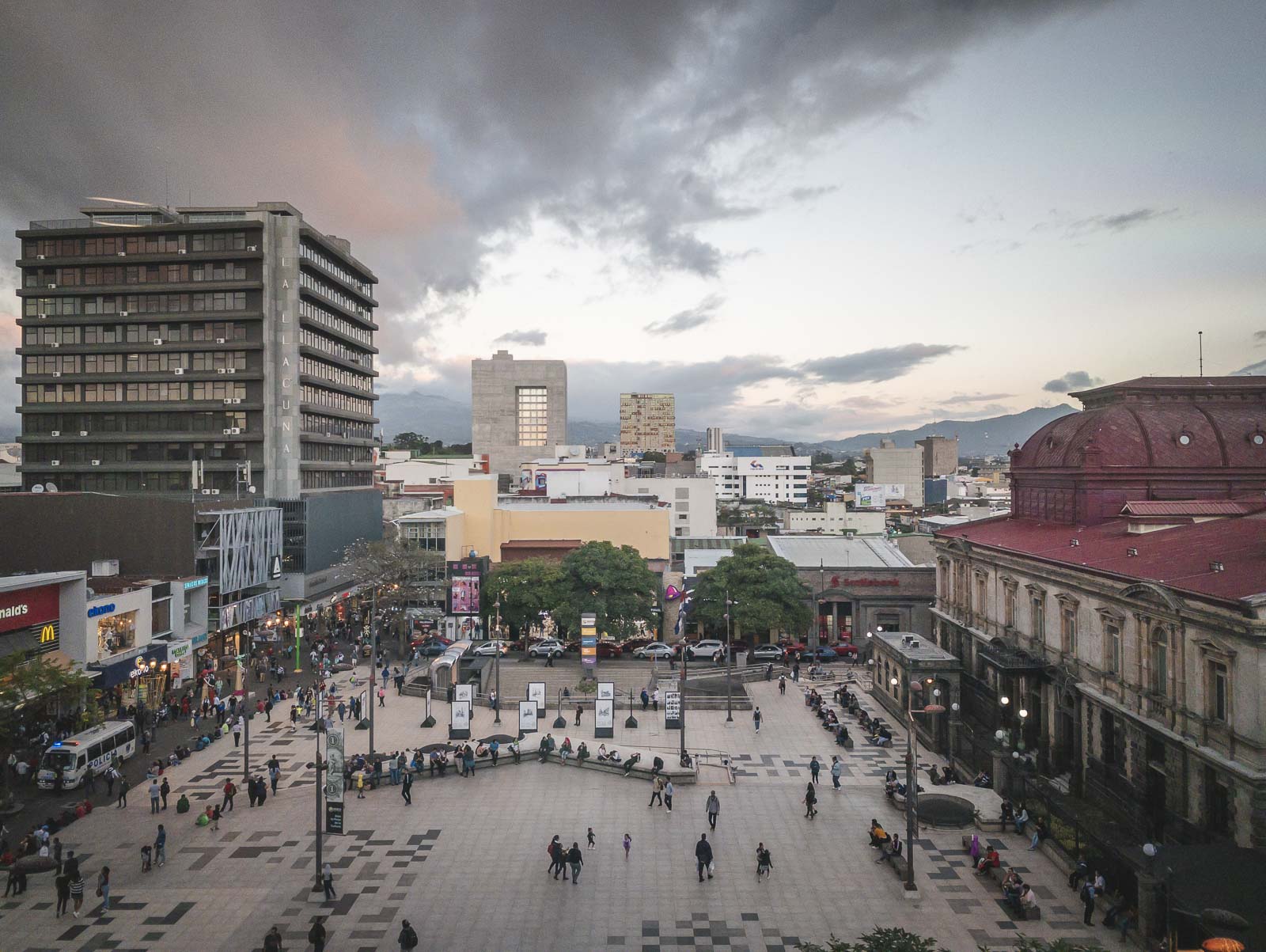
The Gran Hotel is the most historic hotel in the city and is a San Jose attraction in its own right. Even if you are not staying there it is worth going up to the bar for a cocktail or for dinner. The historic hotel has been completely renovated and is very chic.
Built-in 1930, The Gran Hote l has the most coveted location in San Jose. It’s located directly on the Plaza de la Cultura with the National Theater, Gold Museum, and Avenida Central located next door. When dining in its restaurant you are treated to one of San Jose’s best views.
JFK stayed here during his visit but he wouldn’t recognize it, its renovations have created a modern design that makes you want to hang out for days. Our room was super chic, the food was excellent and the ambiance was comfortably elegant. The staff is super friendly too. Make sure to head up to the top floor to the piano bar for a glass of wine overlooking the city of San Jose.
20. Chinatown
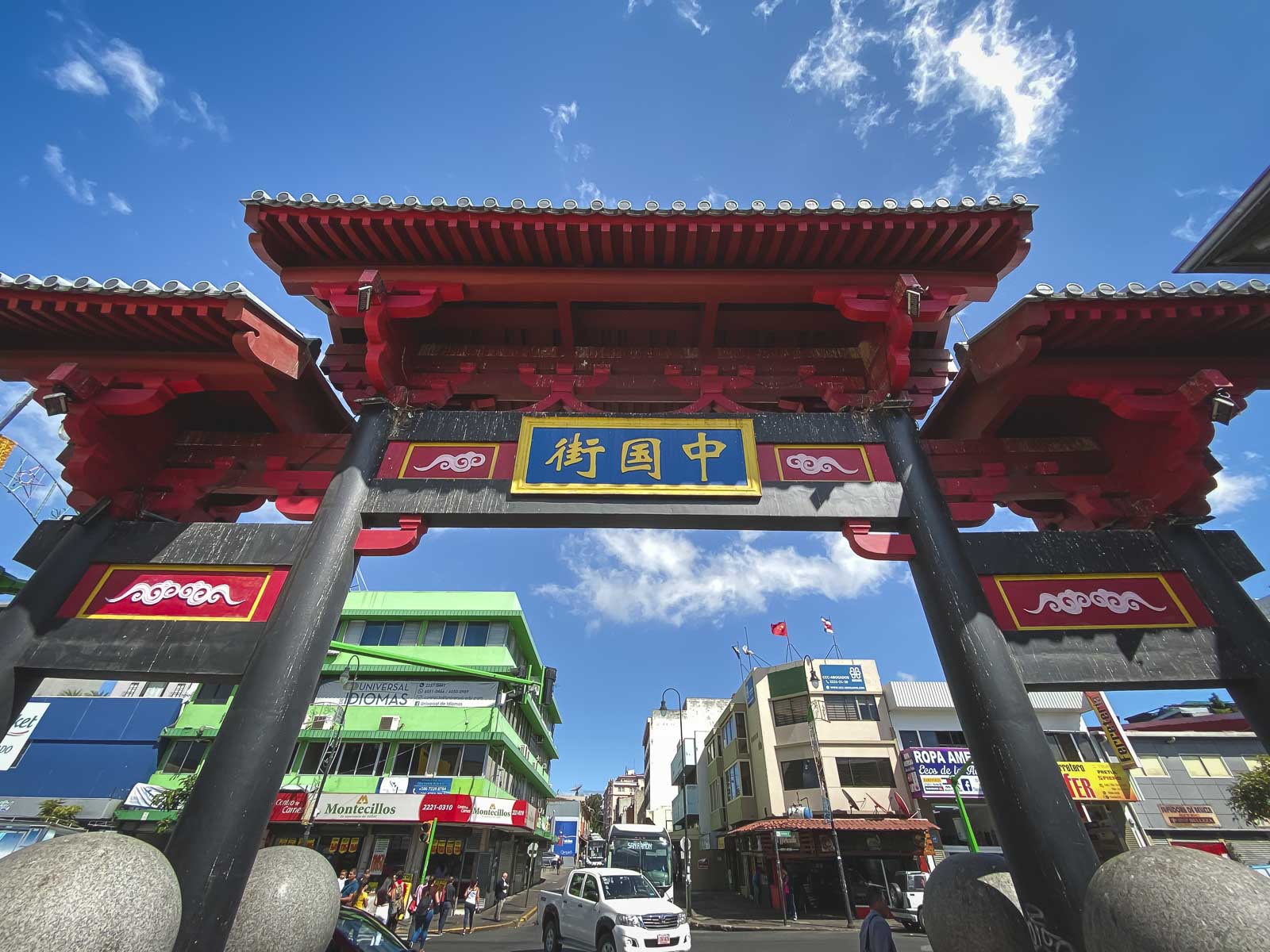
A quirky stop on our free walking tour was San Jose’s Chinatown. Our guide told us that the plan is to build it up more and make it an actual destination in the city. We didn’t see any Chinese during our visit to San Jose, but they do have a photogenic Chinatown gate, so I believe there will be much more in the future.
21. Metallic Building
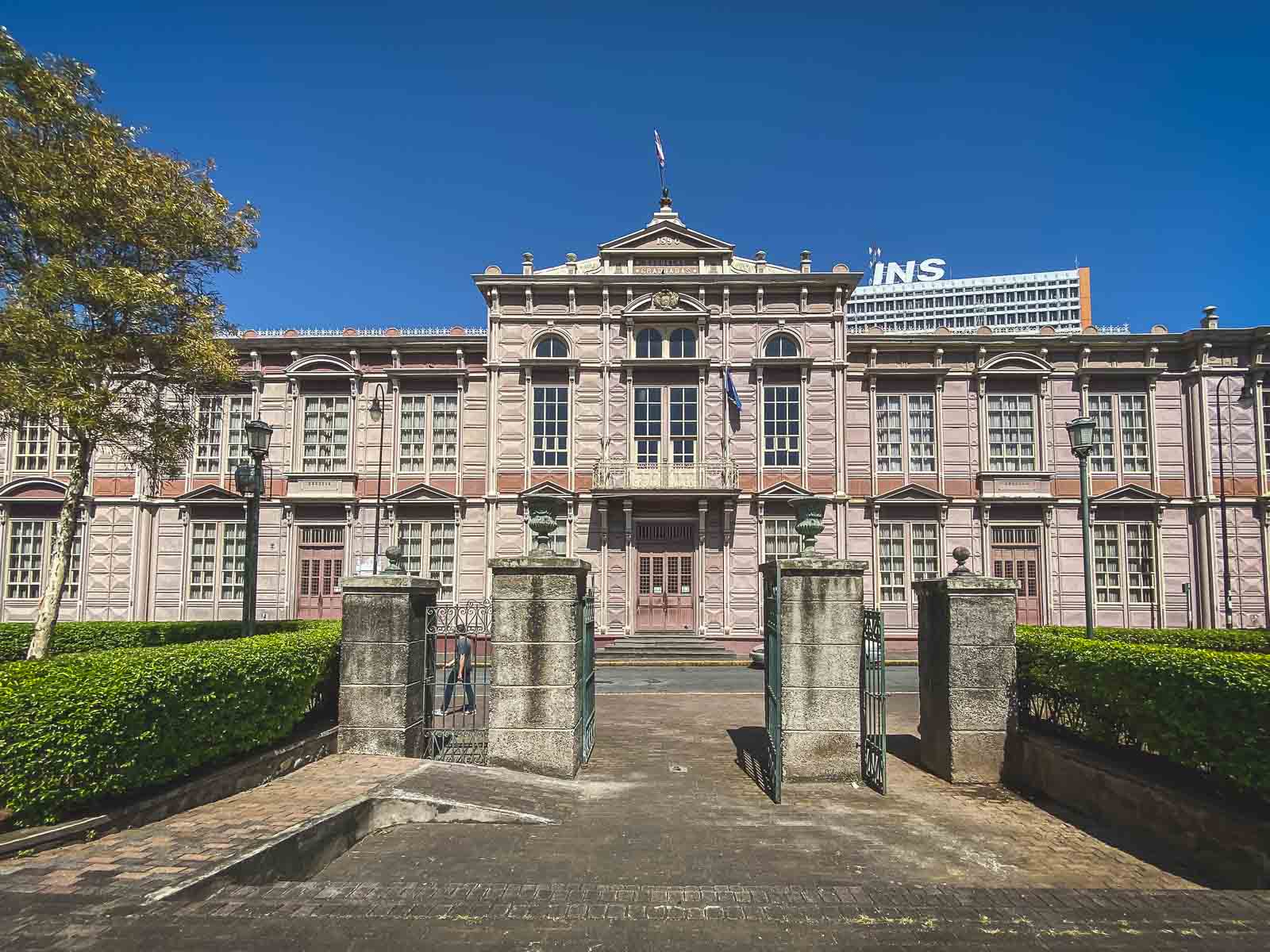
Taking the free walking tour helped us appreciate the buildings around the city. We stopped in front of many to learn of their history. This pink metallic building was inspired by the Eiffel Tower. It was actually sent from Europe in pieces and was put together piece by piece. Today it is a private school, but it is definitely worth stopping to see. There is a beautiful row of rubber trees that makes for a lovely photograph.
Things to do in San Jose Costa Rica at Night
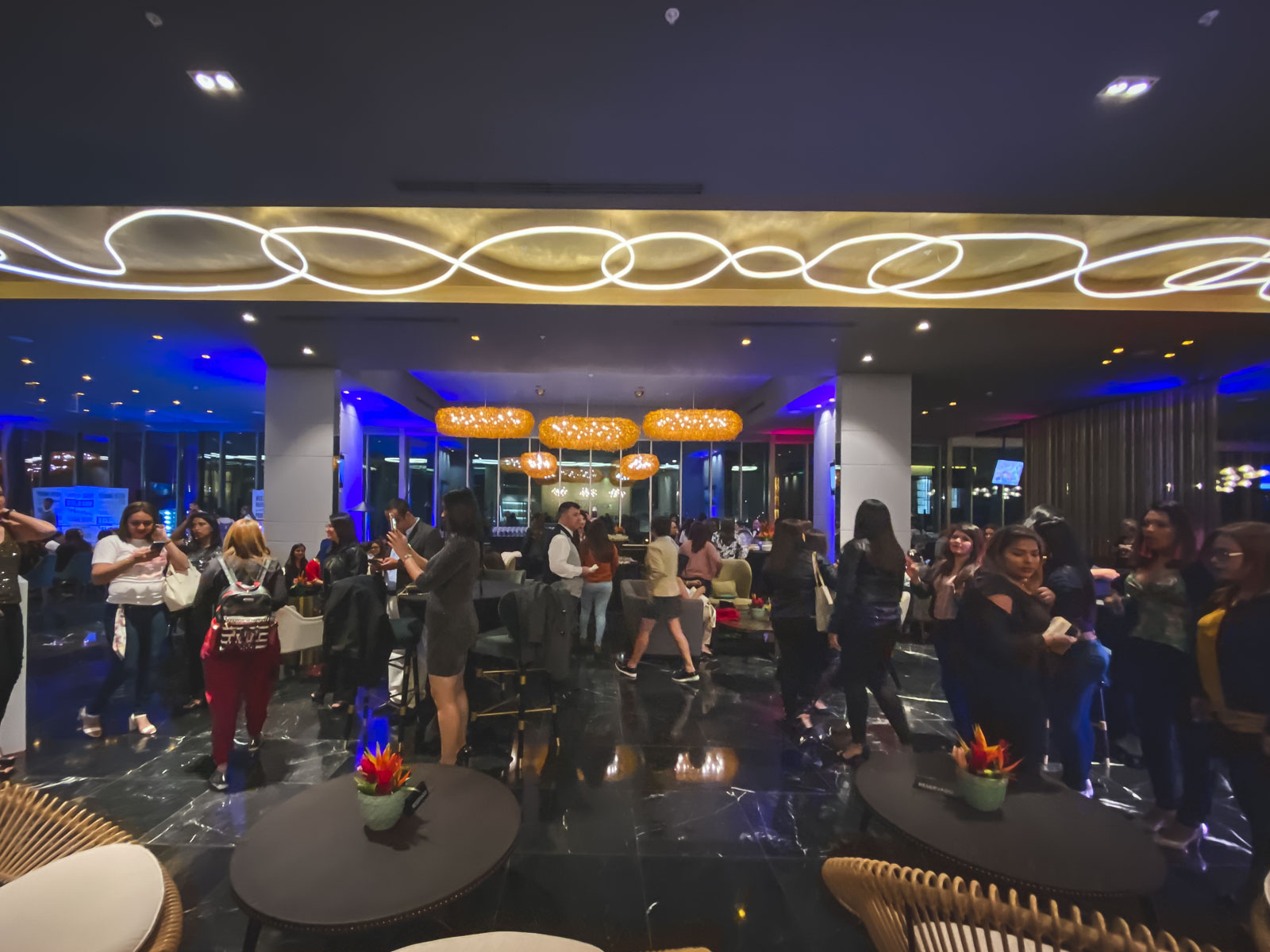
Food and Culture Night Tour
If you are looking for things to do in San Jose at night, you can book this food and culture night tour of San José . Follow your expert guide to see important cultural sites followed by a traditional dinner with wine or beer pairings. You’ll start at Morazán Park to learn about post-colonial Costa Rican history. Then continue on a walking tour to the Metallic Building, the Yellow house from Spain Park, and the oldest residential neighborhood in San José, Barrio Escalante.
If you want to grab a beer in San Jose on your own, visit The Costa Rica Beer Factory is a great place to sample some local brews.
San Jose Night Tour
This highly rated tour is a fun way to experience San Jose away from the daytime crowds. Meeting at La Sabana Metropolitan Park you’ll get an overview of San Jose’s history as you visit some of San Jose’s top attractions like the National Stadium, University of Costa Rica, and the Teatro Nacional de Costa Rica. At the end of the tour, you’ll enjoy a traditional Costa Rican dinner.
Where to Eat in San Jose
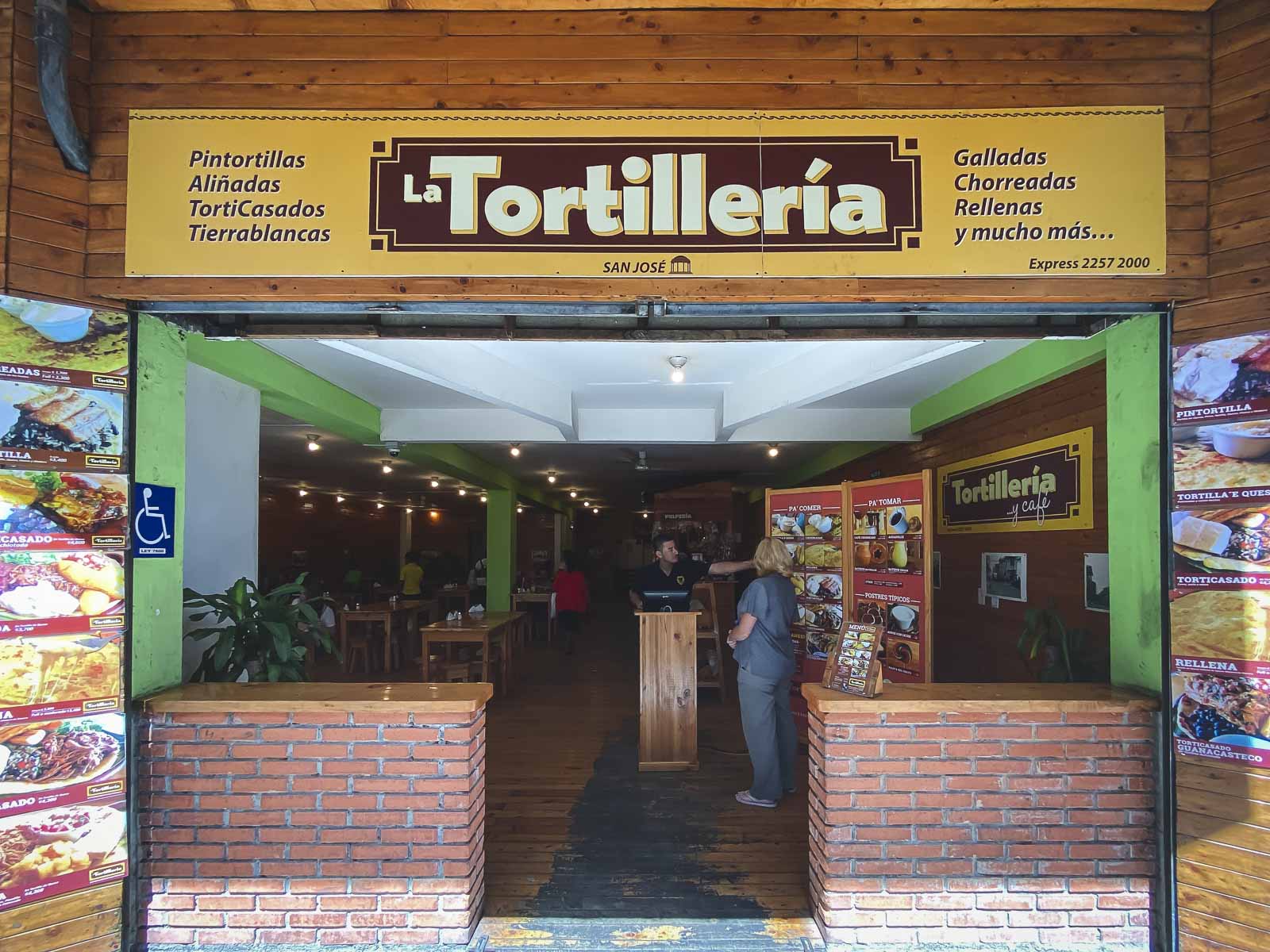
Being Costa Rica’s capital city, there are plenty of excellent food choices all around San Jose. You can easily just ask your guide or hotel for recommendations. Another way we love to find great eateries is to look for where the locals are. If it is filled with regular clientele, you can be sure it is good. Here are a few recommendations.
S oda Tapia – Soda Tapia is a cool retro-style diner 100 years old that is popular with the locals and has a fun vibe.
Cafeteria Incluyeme – This unique cafeteria employs people with disabilities creating a space where they can feel comfortable, and gain employment. It’s known for its delicious coffee, smoothies. It’s located near the Chinese gate.
Tortilleria – This popular spot for locals has delicious tortillas. While there, be sure to try the local lemonade-like drink known as Cas.
Top of the Hilton – This was excellent fine dining with a fantastic view.
Day Trips from San Jose
Manuel antonio national park.
This highly rated day tour from San Jose takes you to the white sand beaches of the world-famous Manuel Antonio National Park. It’s a full day tour packed with activities where you’ll be picked up in the morning and on the way stop at the biggest fruit market in Costa Rica and a stop at crocodile bridge to view one of the country’s largest crocodile populations. The rest of the day is spent searching for wildlife such as sloths and macaws, enjoying some of Costa Rica’s most beautiful beaches and enjoying the rainforest hiking trails of Manuel Antonio National Park.
La Paz Waterfall Gardens & Poas Volcano
There is no shortage of things to do around San Jose, and the Poas Volcano National Park & La Paz Waterfall Gardens are one of the top day trips from San Jose.
This popular tour stops at La Paz Waterfall Gardens which houses Costa Rica’s largest animal sanctuary where 100 species of rescued wildlife lives are housed in the preserve. Enjoy some of the best hiking trails around San José as you enjoy waterfalls within the rainforest. This guided tour will also take you along hiking trails to the Botos Lagoon and climb up the crater to two crater lakes at the summit where you’ll witness one of the world’s most acidic lakes, Laguna Caliente. More details here.
Hanging Bridges
This tour for nature lovers’ – is a full-day tour that takes you to one of Costa Rica’s most famous attractions. The Monteverde Hanging Bridges takes you above the cloud forest where you’ll observe wildlife in their natural habitat. It’s a long drive and it is suggested to actually spend more than one day there, but if you have limited time, this tour is a great option.
Getting Around San Jose
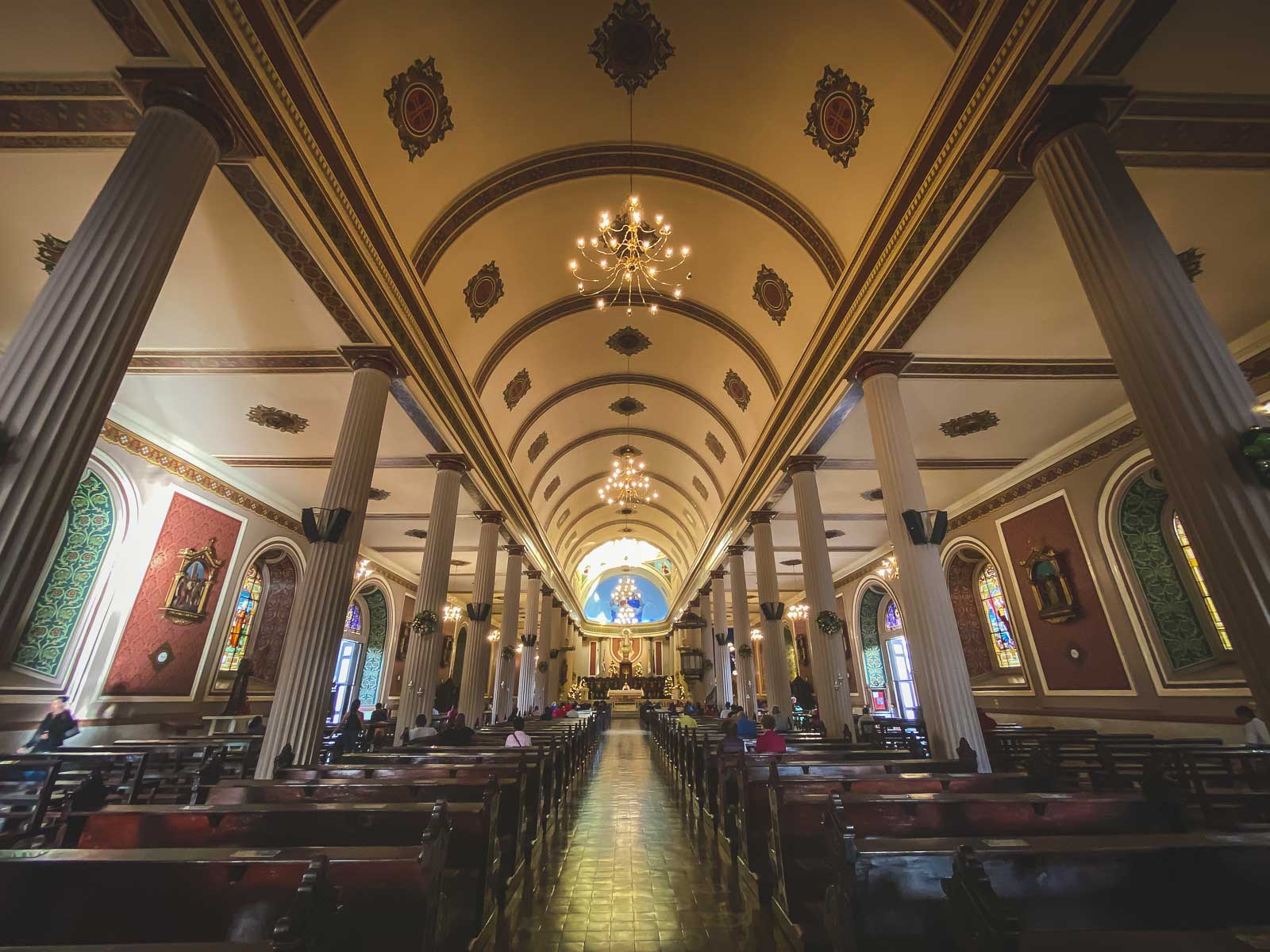
San Jose is a very walkable city and by staying downtown San Jose, we could walk to most of the top attractions. For other travels around San Jose, we used Uber, it was very convenient and very affordable.
To get to the airport, we used Uber. It was safe, fast, and affordable. It cost us $15 USD including the tip. Note : we read that tips are not expected by Uber drivers in San Jose, but we have a habit of tipping. (gotta keep that high Uber star rating)**
You may want to book a transfer in advance to avoid any hassles. When visiting a new city, we always feel more comfortable when we have our driver waiting for us at arrivals with our nameplate. They take us directly from the airport to our hotel and it is worth the extra cost. You can check airport transfers here.
And there you have it, all of the best things to do in San Jose. One day really isn’t enough so when planning your trip to Costa Rica, make sure to spend at least three days in its capital city.
If you are planning on going to Costa Rica to explore its beautiful beaches, cloud forest, volcanoes, and scenery, make sure to put San Jose on your list. You’ll enjoy this historic urban center.
Read More about Costa Rica Travel
- 9 Interesting Facts About Costa Rica
- Costa Rica Travel Guide
- 17 Things to do in Panama City
- What to Expect on a Panama Canal Cruise with Uncruise
- Uncruise Alaska – The Ultimate Alaskan Cruise Through Glacier Country
Travel Planning Resources
Looking to book your next trip? Why not use these resources that are tried and tested by yours truly.
Flights: Start planning your trip by finding the best flight deals on Skyscanner
Book your Hotel: Find the best prices on hotels with these two providers. If you are located in Europe use Booking.com and if you are anywhere else use TripAdvisor
Find Apartment Rentals: You will find the cheapest prices on apartment rentals with VRBO .
Travel Insurance: Don't leave home without it. Here is what we recommend:
- Allianz - Occasional Travelers.
- Medjet - Global air medical transport and travel security.
Need more help planning your trip? Make sure to check out our Resources Page where we highlight all the great companies that we trust when we are traveling.
You May Also Like
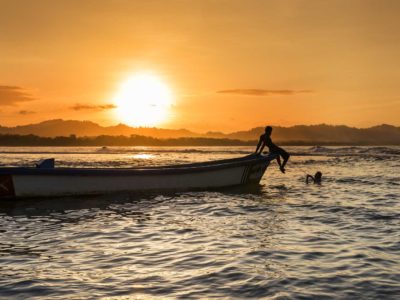
16 Best Things to do in Puerto Viejo Costa Rica
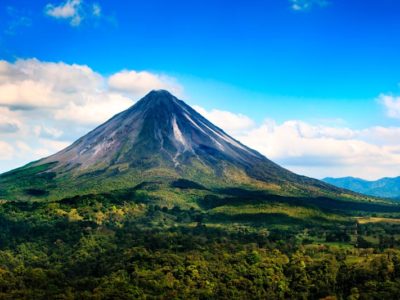
23 Interesting Facts About Costa Rica
About The Planet D
Dave Bouskill and Debra Corbeil are the owners and founders of The Planet D. After traveling to 115 countries, on all 7 continents over the past 13 years they have become one of the foremost experts in travel. Being recognized as top travel bloggers and influencers by the likes of Forbes Magazine , the Society of American Travel Writers and USA Today has allowed them to become leaders in their field.
Join thousands of others who get our monthly updates!
Leave a comment cancel reply.
Save my name, email, and website in this browser for the next time I comment.
6 thoughts on “21 Best Things To Do in San Jose, Costa Rica”
I’ve always been told I should not “waste” my time staying in San José when traveling to Costa Rica, it’s my second time here and I’ve skiped it all together… I am coming back for sure (can’t get enough of Pura Visa, right?) might give the city a couple of days… Thank you!
San José is definitely becoming a vibrant city BUT I still believe that one must visit the Pacific Coast when visiting the country! It’s natural charm it’s, for me, its real jewel 🙂
One of the destination which is on top of my bucket list. Nice coverage
I have a trip booked foe July 16 through August 7 Will be my first to San Jose with my 16 year old son. I have written 21 things that you recommed down We will be staying at the Balmoral Hotel Thanks you have given us more things than we will ever have time to see Clinton Bell
very interesting….
I doubt I’ll ever get the a but it certainly looks like a wonderful place to travel to. 🙂

Exploring San Jose Downtown: A 3-Day Itinerary in Costa Rica
Home » Archives » Exploring San Jose Downtown: A 3-Day Itinerary in Costa Rica
- May 14, 2023
Welcome to San Jose Downtown, the vibrant heart of Costa Rica! This bustling area is brimming with cultural landmarks, historical sites, and culinary delights. In this 3-day itinerary, we will guide you through the best experiences San Jose Downtown has to offer. Get ready for an immersive journey through art, history, and authentic cuisine.
Day 1: Discovering Cultural Gems

On Day 1 of your San Jose Downtown adventure, prepare to immerse yourself in the rich cultural heritage of Costa Rica. Begin your morning by visiting the iconic National Theatre, a magnificent architectural masterpiece that showcases the country’s artistic excellence. Admire its grandeur and learn about its historical significance.
In the afternoon, delve into the captivating world of pre-Columbian art at the Gold Museum. Marvel at the intricate craftsmanship of ancient gold artifacts, and gain insights into the indigenous cultures that thrived in Costa Rica centuries ago.
Continue your cultural exploration by strolling through the charming neighborhood of Barrio Escalante. This trendy district is known for its vibrant art scene, hip cafes, and a diverse array of culinary options. Take in the creative energy and enjoy a delightful gastronomic experience at one of the local eateries.
As the evening approaches, head towards the Plaza de la Cultura, a lively gathering place surrounded by shops, restaurants, and street performers. Immerse yourself in the vibrant atmosphere, observe the local culture, and perhaps catch a captivating performance by talented artists.
Day 1 of your itinerary will leave you inspired by Costa Rica’s rich cultural gems, from the artistic expressions in the National Theatre and Gold Museum to the vibrant ambiance of Barrio Escalante and Plaza de la Cultura. Get ready for a day filled with awe-inspiring experiences that will make your San Jose Downtown exploration truly unforgettable.
Day 2: Immersion in History and Art

On Day 2 of your San Jose Downtown journey, prepare to dive deep into the captivating history and vibrant art scene of Costa Rica. Start your morning by visiting the Jade Museum, home to the world’s largest collection of pre-Columbian jade artifacts. Admire the intricate craftsmanship and learn about the significance of jade in ancient Costa Rican cultures.
In the afternoon, explore the National Museum, housed in a former military fortress. Delve into the exhibits that trace the history of Costa Rica, from the pre-Columbian era to modern times. Gain insights into the country’s political, social, and cultural evolution, as you wander through the fascinating displays.
Continue your day by taking a leisurely walk through the charming neighborhood of Barrio Amón. Marvel at the stunning Victorian mansions and art deco architecture that line the streets. This picturesque district is a haven for art lovers, with numerous art galleries showcasing local and international works.
In the evening, make your way to the Costa Rican Art Museum, where you can appreciate a diverse collection of modern and contemporary artworks. From paintings and sculptures to installations and multimedia exhibits, this museum offers a glimpse into the vibrant art scene of Costa Rica.
Day 2 of your itinerary promises an immersive experience in the rich history and artistic expressions of Costa Rica. From the mesmerizing jade artifacts at the Jade Museum to the insightful exhibits at the National Museum and the captivating artworks at the Costa Rican Art Museum, you will have a day filled with cultural enrichment and artistic inspiration in San Jose Downtown.
Day 3: Authentic Experiences and Gastronomic Delights

Day 3 of your San Jose Downtown adventure is all about indulging in authentic experiences and savoring the mouthwatering gastronomy of Costa Rica. Get ready for a day filled with local flavors and cultural immersion.
Start your morning by immersing yourself in the vibrant atmosphere of the Central Market. This bustling market offers a cornucopia of sights, sounds, and smells. Stroll through the aisles filled with colorful fruits, vegetables, and exotic spices. Engage with local vendors, and perhaps sample some tropical fruits or traditional snacks along the way.
After exploring the Central Market, make your way to the Mercado de Artesanías. This craft market is a treasure trove of traditional Costa Rican handicrafts and souvenirs. Browse through the stalls to find unique artworks, handmade textiles, and intricately designed jewelry as mementos of your trip.
For lunch, immerse yourself in the authentic flavors of Costa Rican cuisine at a local soda. These small family-run restaurants serve up traditional dishes like casados (rice, beans, and a choice of meat or fish), gallo pinto (rice and beans), and plantains. Delight your taste buds with the rich flavors and fresh ingredients that make Costa Rican cuisine so renowned.
In the afternoon, venture into the neighborhood of Barrio La California. Known for its alternative art scene, this vibrant district is dotted with hip cafes, art galleries, and live music venues. Take your time to explore the local artwork, sip a cup of Costa Rican coffee , and soak in the creative energy that permeates the area.
As the day winds down, head to La Sabana Metropolitan Park for a relaxing evening. This sprawling green oasis offers a welcome respite from the bustling city. Enjoy a peaceful stroll, have a picnic, or simply unwind while enjoying the serene surroundings.
Day 3 of your itinerary in San Jose Downtown promises authentic experiences and gastronomic delights. From immersing yourself in the vibrant markets and savoring traditional cuisine to exploring the alternative art scene and finding tranquility in the city park, this day offers a perfect blend of local culture and relaxation. Get ready to create lasting memories and flavorsome encounters in Costa Rica’s capital city.
Packing Guide for Family Travel with Kids - FAQ's
The number of days you need to explore San José, Costa Rica, depends on your interests and the activities you plan to undertake. As the capital city, San José offers a range of attractions, including museums, historical sites, markets, and cultural experiences.
For a general visit to explore the city’s highlights, a minimum of 2-3 days is usually sufficient. This allows you to visit significant landmarks such as the National Theatre, the Gold Museum, and the Central Market, as well as explore neighborhoods like Barrio Amón and Barrio Escalante. Additionally, you’ll have time to sample local cuisine, visit museums, and immerse yourself in the city’s vibrant atmosphere.
If you wish to delve deeper into San José’s cultural offerings or take day trips to nearby attractions, you may consider extending your stay to 4-5 days. This would allow for more in-depth exploration, including visits to additional museums, art galleries, parks, and nearby natural attractions like volcanoes or coffee plantations.
Ultimately, the duration of your stay in San José depends on your preferences and the level of immersion you desire. Remember to consider any additional excursions or day trips you may want to take outside of the city.
Yes, San José, Costa Rica, has several attractions and places worth visiting. Here are some highlights:
- National Theatre: A stunning architectural gem, the National Theatre is a must-visit landmark in San José. Take a guided tour or catch a performance to appreciate its beauty and historical significance.
- Gold Museum (Museo del Oro): Explore the extensive collection of pre-Columbian gold artifacts and learn about the ancient cultures that thrived in Costa Rica.
- Central Market (Mercado Central): Immerse yourself in the vibrant atmosphere of this bustling market. Browse through stalls selling fresh produce, local crafts, and enjoy traditional Costa Rican food.
- National Museum (Museo Nacional): Housed in a former military fortress, the National Museum provides insights into Costa Rica’s history, from the pre-Columbian era to modern times.
- Jade Museum (Museo del Jade): Discover the importance of jade in Costa Rican culture and marvel at the exquisite jade artifacts displayed at this museum.
- Barrio Amón: Take a leisurely walk in this charming neighborhood known for its beautiful Victorian mansions, art deco architecture, and cozy cafes.
- La Sabana Metropolitan Park: Escape the hustle and bustle of the city and enjoy a relaxing time in this urban park. It offers green spaces, walking paths, sports facilities, and a lake.
- Barrio Escalante: Experience the trendy and vibrant side of San José in Barrio Escalante. Explore its hip cafes, art galleries, and enjoy the thriving food scene.
- Costa Rican Art Museum (Museo de Arte Costarricense): Admire a collection of modern and contemporary Costa Rican art at this museum located in the eastern part of the city.
- Spirogyra Butterfly Garden (Jardín de Mariposas Spirogyra): Visit this tropical garden to observe and learn about various species of butterflies in a serene environment.
These are just a few examples of the attractions San José has to offer. The city’s cultural heritage, historical sites, markets, and local neighborhoods provide visitors with a rich and diverse experience.
The best method of travel in San José, Costa Rica, depends on your preferences and the specific locations you plan to visit. Here are some popular transportation options:
- Walking: San José’s city center is relatively compact, making it easy to explore on foot. Walking allows you to immerse yourself in the local atmosphere, discover hidden gems, and navigate crowded areas more efficiently.
- Public Bus: San José has an extensive public bus system that covers the city and its surrounding areas. Buses are an affordable and convenient option for getting around. However, be prepared for potential crowding and varying schedules.
- Taxi: Taxis are widely available in San José and offer a convenient mode of transportation. Look for official red taxis with a yellow triangle on the door. Make sure the driver uses the meter or agree on a fare before starting your journey.
- Ride-Sharing Apps: Services like Uber and DiDi operate in San José, providing an alternative to traditional taxis. These apps offer convenience, transparency in pricing, and the ability to track your route.
- Rental Car: If you prefer more independence and flexibility, renting a car allows you to explore San José and its surrounding areas at your own pace. However, be aware that traffic congestion and parking can be challenging in the city center.
It’s important to note that traffic congestion can be common in San José, especially during peak hours. Plan your travel accordingly and consider using a combination of transportation methods to optimize your experience. Always prioritize your safety and consult with local resources for the most up-to-date information on transportation options.
While San José, Costa Rica, is generally safe for walking around downtown, it is important to exercise caution and follow common safety practices. Here are some tips to ensure a safer experience:
- Stay in well-populated areas: Stick to busy and well-lit streets, especially during the evening hours. Avoid isolated or dimly lit areas.
- Be aware of your surroundings: Stay alert and attentive to your surroundings. Keep an eye on your belongings and avoid displaying expensive items or carrying large amounts of cash.
- Use reputable transportation: If you’re walking at night or in unfamiliar areas, consider using a taxi or ride-sharing service for added safety and convenience.
- Walk confidently: Walk with a purpose and maintain a confident demeanor. This can deter potential opportunistic crimes.
- Stay informed: Before heading out, research the areas you plan to visit and be aware of any recent safety concerns or warnings. Consult with local authorities or your hotel for up-to-date information.
- Travel in groups: If possible, walk with a companion or in a group, as there is safety in numbers.
- Follow local advice: Pay attention to the recommendations and advice provided by locals or authorities regarding specific areas or times to avoid.
While San José downtown is generally safe for walking, it’s always wise to take precautions and be mindful of your surroundings. By practicing common sense and following these guidelines, you can have a safer and more enjoyable experience exploring the city.
San José, Costa Rica, is best known for several key aspects:
- Cultural Hub: San José serves as the cultural heart of Costa Rica, with numerous museums, theaters, and art galleries. The city boasts architectural gems like the National Theatre and a thriving arts scene.
- History and Heritage: San José is home to historical sites that showcase Costa Rica’s past. The National Museum, housed in a former military fortress, offers insights into the country’s history and culture.
- Central Market: The bustling Central Market is a vibrant hub where locals and visitors can immerse themselves in the sights, sounds, and flavors of Costa Rica. It’s a popular spot to purchase fresh produce, local crafts, and traditional food.
- Educational Institutions: San José is home to prominent universities and educational institutions, attracting students from around the country and abroad. This contributes to the city’s intellectual atmosphere and vibrant youth culture.
- Ecotourism Gateway: As the capital city, San José serves as a gateway to Costa Rica’s natural wonders. Travelers often use the city as a starting point for exploring the country’s lush rainforests, volcanoes, and biodiversity.
- Coffee Culture: Costa Rica is renowned for its coffee, and San José offers opportunities to learn about the country’s coffee production. Visitors can visit coffee plantations, participate in tastings, and discover the rich coffee heritage.
- Urban Parks: Despite being a bustling metropolis, San José boasts several urban parks where locals and visitors can relax, exercise, and enjoy green spaces. La Sabana Metropolitan Park is a popular destination for outdoor activities.
- Government Center: San José houses important government buildings, including the Presidential Palace and the Legislative Assembly, making it the political and administrative hub of Costa Rica.
These aspects collectively contribute to San José’s identity and make it a vibrant city with a unique blend of culture, history, and natural beauty.
While San José, Costa Rica, is generally a safe city, there are a few areas that are known to have higher crime rates or are considered less safe for tourists. It’s advisable to exercise caution and avoid certain areas, especially at night. Here are a few neighborhoods that may be best to avoid:
- Barrio El Carmen: This neighborhood, located east of downtown San José, has a higher crime rate and is known for occasional incidents of theft and robberies. It’s recommended to exercise caution and avoid walking alone in this area, particularly at night.
- La Carpio: La Carpio is a marginalized neighborhood located west of downtown San José. It has a reputation for higher crime rates and social challenges. It’s advisable for tourists to avoid this area unless accompanied by a knowledgeable guide or engaging in a community-based program.
- Around Coca-Cola Bus Terminal: While the Coca-Cola Bus Terminal is a major transportation hub, the surrounding area can be crowded and attract pickpockets or scammers. Exercise caution with your belongings and avoid displaying valuables.
- Certain Central Park Surroundings: Some areas near San José’s Central Park, such as the parks located behind the National Theatre or around Morazán Park, have occasional reports of petty theft. Be vigilant and avoid dark or secluded areas.
It’s important to note that while these areas may have higher crime rates, incidents can occur in any city. By taking common-sense precautions such as staying in well-populated areas, being aware of your surroundings, and avoiding walking alone at night, you can help ensure a safer experience in San José. Additionally, staying informed about current safety recommendations from local authorities and seeking advice from trusted sources can contribute to a more secure visit.
San José, Costa Rica, has several nice areas that offer unique attractions and a pleasant atmosphere. Here are a few neighborhoods often considered among the nicest parts of San José:
- Barrio Escalante: Known for its trendy vibe, Barrio Escalante is a hip and vibrant neighborhood with a thriving food and bar scene. It’s a great place to explore stylish cafes, restaurants, and art galleries.
- Barrio Amón: Located near the city center, Barrio Amón is known for its beautiful Victorian mansions and colonial architecture. It exudes a charming and artistic atmosphere, with boutique hotels, art galleries, and cozy cafes.
- Barrio Otoya: Adjacent to Barrio Amón, Barrio Otoya is a residential area with leafy streets and a tranquil ambiance. It offers a mix of residential homes, boutique hotels, and trendy restaurants.
- Rohrmoser: Rohrmoser is an upscale neighborhood located west of downtown San José. It features elegant homes, modern apartment complexes, and a variety of international embassies. The neighborhood is known for its green spaces and proximity to La Sabana Metropolitan Park.
- Los Yoses: Los Yoses is a residential area popular among students and young professionals due to its proximity to the University of Costa Rica. It offers a mix of restaurants, cafes, and parks, creating a lively and dynamic atmosphere.
These neighborhoods provide a combination of charm, cultural attractions, and a safe environment for residents and visitors. Each area has its own unique character and appeal, making them among the nicest parts of San José to explore and experience.
The trendy area in San José, Costa Rica, is often considered to be Barrio Escalante. This neighborhood has gained popularity in recent years for its vibrant and hip atmosphere, making it a hotspot for locals and visitors alike. Here’s why Barrio Escalante is considered the trendy area of San José:
- Culinary Scene: Barrio Escalante is renowned for its diverse and innovative culinary offerings. The neighborhood is filled with trendy restaurants, cafes, and gastropubs that cater to various tastes and dietary preferences. Food enthusiasts will find a wide range of cuisines, including local flavors, fusion dishes, and international delights.
- Craft Beer and Cocktail Bars: The area is home to numerous craft beer bars and cocktail lounges, making it a hub for beer and cocktail enthusiasts. Visitors can enjoy unique and creative concoctions in stylish settings, often accompanied by live music or a lively ambiance.
- Art and Culture: Barrio Escalante embraces its artistic side, with numerous art galleries showcasing local talent and hosting exhibitions. The neighborhood also hosts cultural events, live performances, and art festivals, adding to its trendy and creative vibe.
- Street Art: Walking through the streets of Barrio Escalante reveals vibrant and colorful street art, contributing to its artistic and contemporary feel. The murals and graffiti add character and charm to the neighborhood.
- Lively Nightlife: As the sun sets, Barrio Escalante comes alive with its vibrant nightlife scene. The area offers a mix of bars, lounges, and clubs where visitors can enjoy live music, DJ sets, and socialize with the trendy crowd.
- Trendy Shops and Boutiques: Barrio Escalante is dotted with trendy shops and boutiques, offering a unique shopping experience. From stylish clothing boutiques to artisanal stores, visitors can find fashionable and distinctive items.
Barrio Escalante’s blend of culinary delights, artistic expressions, and lively nightlife contribute to its reputation as the trendy area of San José. It’s a place where visitors can experience the city’s vibrant and contemporary side, indulge in culinary adventures, and immerse themselves in the local art and culture scene.
While San José, Costa Rica, has its safe areas, it’s important to exercise caution when going out at night, just like in any other city. Here are some tips to help ensure a safer experience:
- Stick to well-populated areas: Stay in busy, well-lit areas where there are other people around. Avoid isolated or dimly lit streets.
- Use reputable transportation: If you’re going out at night, consider using registered taxis or ride-sharing services like Uber or DiDi for transportation. These services provide a safer and more controlled environment compared to walking or taking public transportation.
- Be cautious with your belongings: Keep a close eye on your belongings and avoid displaying expensive items such as jewelry or electronics. Use a bag that can be securely closed and held close to your body.
- Stay alert and aware: Be aware of your surroundings and trust your instincts. If something feels unsafe or uncomfortable, move to a more populated area or seek assistance from trusted sources.
- Travel in groups: Whenever possible, travel with companions or in groups, as there is safety in numbers. This is especially important when exploring less familiar areas or going to nightlife spots.
- Avoid excessive alcohol consumption: Excessive alcohol consumption can impair judgment and make you more vulnerable to potential risks. Drink responsibly and know your limits.
- Stay informed: Before going out, research the areas you plan to visit and be aware of any recent safety concerns or warnings. Consult with local authorities or your hotel for the most up-to-date information.
It’s important to note that crime can occur in any city, including San José. By taking common-sense precautions and being vigilant, you can help reduce the likelihood of encountering any issues and have a safer experience while going out at night.
The dress code for clubs in Costa Rica can vary depending on the establishment and the specific event. Generally, clubs in Costa Rica tend to have a casual to upscale dress code. Here are some general guidelines to consider:
- Smart Casual: Most clubs in Costa Rica enforce a smart casual dress code. This means avoiding overly casual attire such as beachwear, athletic wear, or flip-flops. Opt for stylish and neat clothing choices.
- Dress to Impress: Some upscale or high-end clubs may have a more formal dress code. In these cases, it is advisable to dress more elegantly. Men can wear collared shirts, dress pants, and dress shoes, while women can opt for dresses, skirts, or stylish pants paired with heels or dressy shoes.
- No Sportswear or Beachwear: Avoid wearing sportswear, including athletic jerseys, sweatpants, or running shoes, as well as beachwear like shorts, tank tops, or flip-flops. These items may not be allowed in certain clubs.
- Fashionable and Trendy: Consider wearing fashionable and trendy outfits that reflect the clubbing scene. This can include stylish tops, jeans or trousers, dresses, skirts, blouses, or dressy shirts.
- Check Specific Club Guidelines: It’s always a good idea to check the specific club’s website or contact them directly to inquire about their dress code policies. Some clubs may have specific themes or dress code requirements for special events.
Remember, it’s better to be slightly overdressed than underdressed when going to a club in Costa Rica. By dressing appropriately, you can ensure a smoother entry into the venue and enjoy your night out to the fullest.
San José, Costa Rica, has a vibrant nightlife scene with a variety of options for partying and entertainment. While it may not be as renowned for its partying as some other destinations in the region, San José offers a range of nightlife venues that cater to different tastes and preferences. Here’s what you can expect:
- Bars and Clubs: San José has a selection of bars and clubs that cater to various music genres and atmospheres. From lively dance clubs playing Latin beats to trendy cocktail lounges, there are options to suit different preferences.
- Live Music Venues: Music lovers can enjoy live performances at venues throughout the city. You can find places featuring local bands, solo artists, and even international acts. These venues often offer a lively and energetic atmosphere.
- Casinos: San José is home to several casinos where you can try your luck and enjoy a vibrant casino atmosphere. These establishments often have bars, live music, and other entertainment options.
- Festivals and Events: The city hosts various festivals and events throughout the year that include live music, dance performances, food stalls, and cultural celebrations. These events can offer a lively and festive atmosphere.
- Karaoke and Pub Culture: San José has a thriving karaoke and pub scene, where you can sing your heart out or enjoy a relaxed evening with friends over drinks and pub-style entertainment.
It’s important to note that the nightlife scene in San José is not limited to one particular area. You can find nightlife venues scattered throughout the city, with concentrations in areas like Barrio Escalante, Barrio La California, and Avenida Escazú. The atmosphere and vibe can vary depending on the specific venue and the night of the week.
While San José may not have the same reputation for partying as some coastal towns in Costa Rica, it still offers a lively and enjoyable nightlife experience for locals and visitors alike.

Discover the best of San Jose Downtown in 3 days! Explore cultural gems, history, art, authentic experiences, and gastronomic delights.
14 Things to Do in San José, Costa Rica (with Tips from a Local)
03/12/2024 by Emily Becker Leave a Comment
This post was written by Emily Becker, a Costa Rica-based freelance writer for BMTM.
If you are visiting Costa Rica, you will most likely fly into the country’s largest airport, which is in San José. While many travelers claim that the city isn’t worth spending more than a day in, I wanted to give it the chance it deserves.
As it happens, I loved San José. It’s a bit rough around the edges, but I can appreciate a good amount of grit in a place. Because I think it’s a destination that you shouldn’t skip over, here’s my take on how to have an awesome time in the country’s capital:
Table of Contents

1. Explore Spirogyra Butterfly Garden
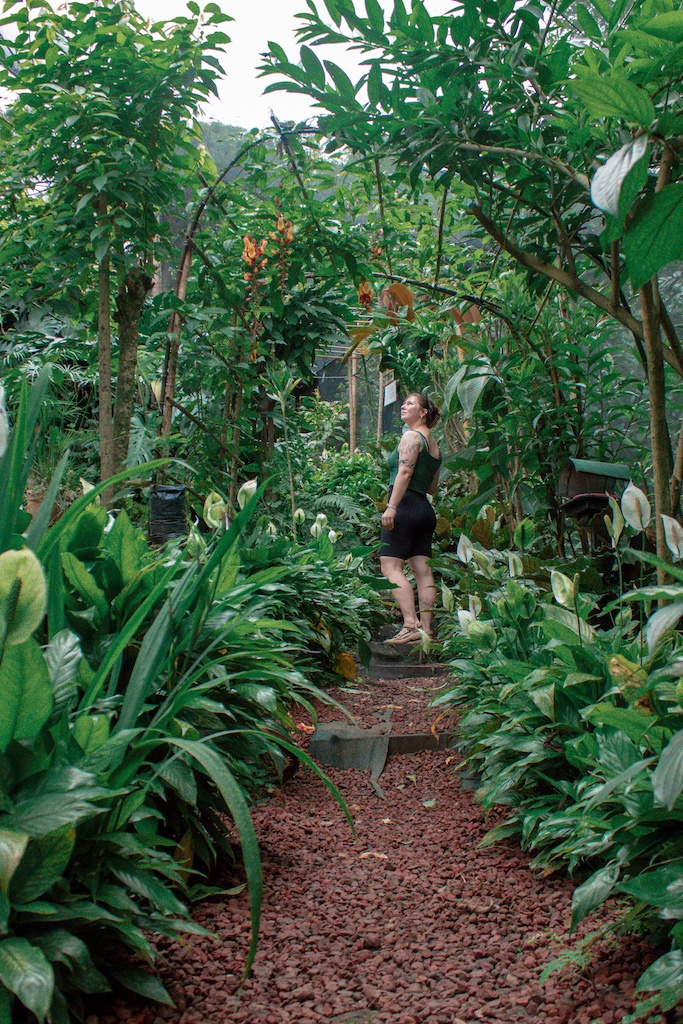
The Spirogyra Butterfly Garden is truly magical, and I still can’t believe it exists in such a busy, urban center. It calls itself the lungs of the city, and for good reason. Besides having an enclosed butterfly garden with dozens of species flying around, the property encompasses a dense piece of jungle right on the Río Torres.
The organizers of Spirogyra are working hard to conserve native butterfly species and keep the river free of contamination. Their efforts are evident as soon as you step onto the footpath: it feels like you’ve completely left San José and are immersed in the Costa Rican jungle, all while still being in the heart of the city.
It costs 3,600 colones ($5 USD) to visit Spirogyra Butterfly Garden, which includes access to the entire property. Definitely prepare for mosquitos and a muddy trail if visiting in the rainy season!
2. People-watch in Morazán Park
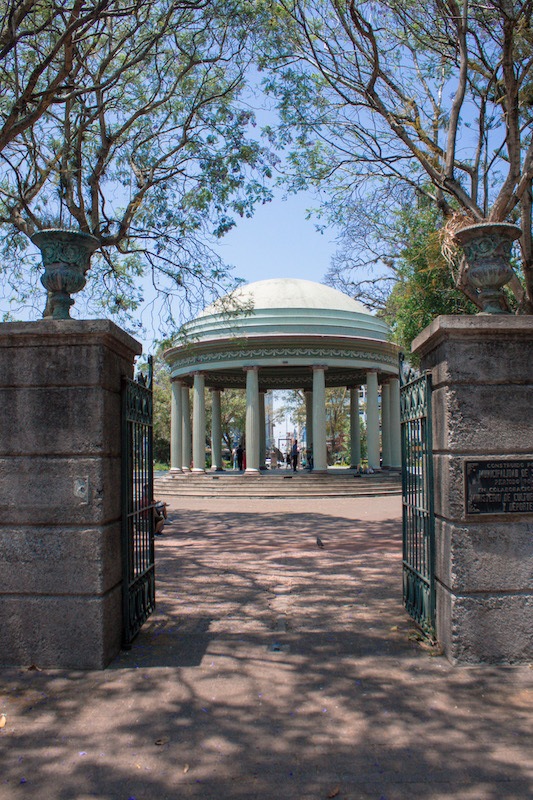
There are plenty of beautiful parks in San José, but my favorite is Morazán, right in the heart of downtown. Though most of the city feels like a monstrous concrete jungle, this park makes me feel like I’m witnessing a flashback to San José’s elegant past. In the springtime, the enormous trees are in full bloom with pink, purple, and white flowers, and there’s a chance you’ll be able to catch a street festival here in the dry months (December through April).
This park is always bustling with residents going to work and school, tourists passing through, and people hanging out on the benches. This is my favorite place to sip a coffee and people-watch, so if you want to get a taste of local life, Morazán Park is the ideal place to take it all in.
3. Hike to the summit of Pico Blanco
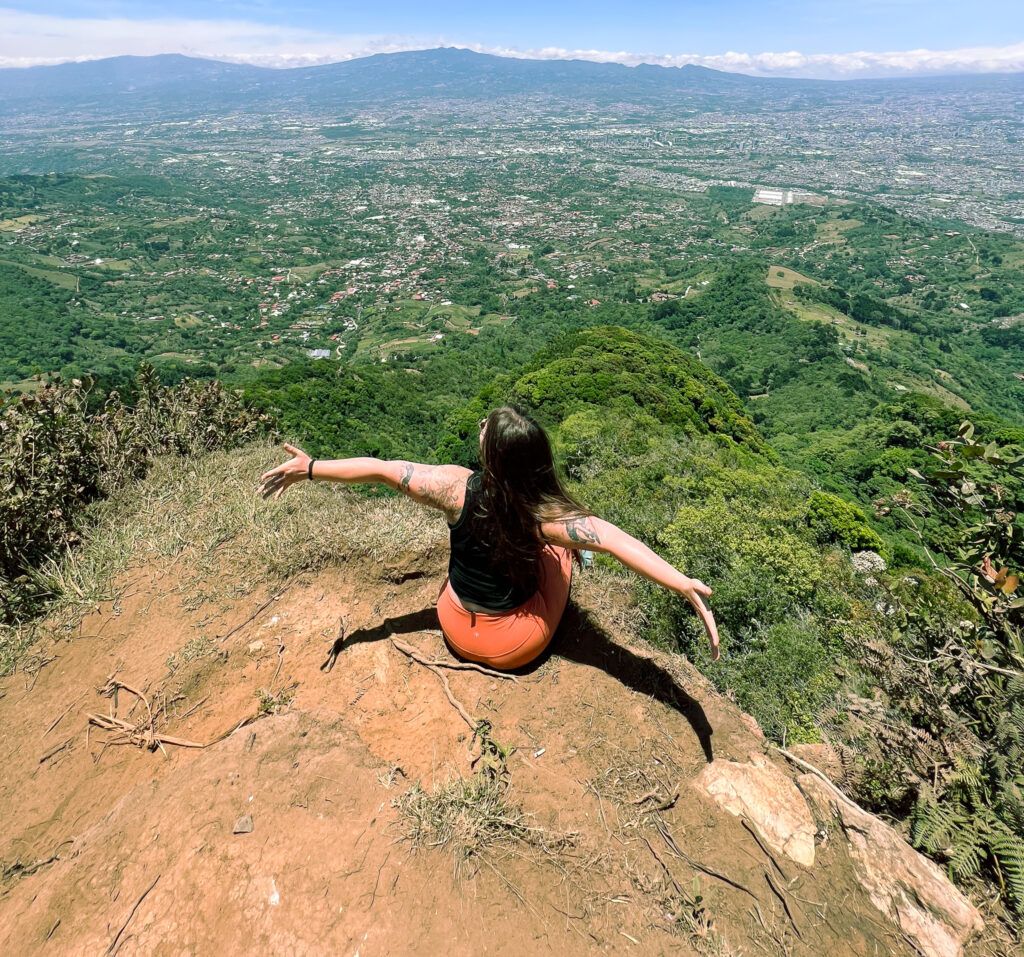
If seeing a new city from above is your cup of tea, there’s no better lookout than the summit of Pico Blanco in nearby Escazú. After living in the area for over a year, this is still my favorite hike in Costa Rica, and it’s enjoyable all year round because of the temperate weather.
The hike starts at the foot of a mountain near the San Antonio neighborhood. If you have a rental car, there’s a safe parking lot at the trail entrance for 1,000 colones (about $2 USD) per hour. You can also take a taxi or Uber to the trailhead using the location linked above.
The hike to the summit takes 1.5–2 hours — and it’s a steep one! There are parts where you have to do a bit of climbing on big boulders, so I’d classify this as a medium to hard hike. Once you reach the top, it’s quite windy and brisk, so I recommend bringing a jacket if you plan to stay up there for a while. The panoramic views of San José and the central valley are breathtaking, though, making the tough trek completely worth it. I also have seen armadillos, blue morpho butterflies, deer, and other wildlife on the trail!
4. Take home Costa Rican art from eÑe
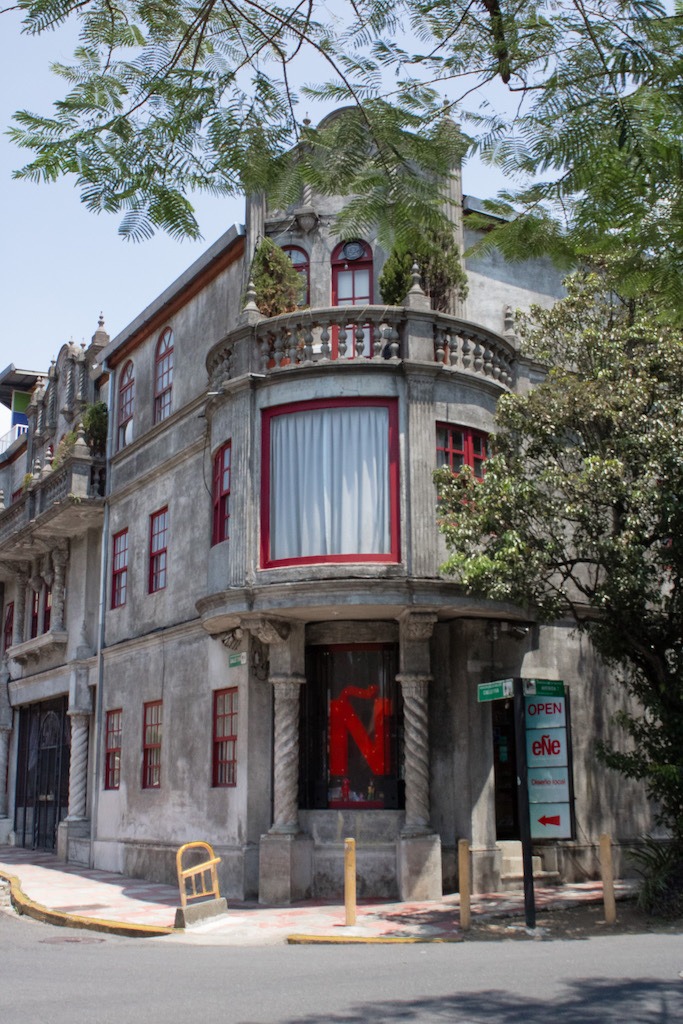
I love taking home something special from my travels, and I was blown away by the artistry and variety of handmade gifts and treasures at eÑe. This small shop is in the heart of Barrio Otoya, across the street from Morazán Park. Inside, you’ll find everything from handmade ceramics to Costa Rica–inspired jewelry, clothing, art prints, and more. My favorite thing about eÑe is that everything in the store is made by Costa Rican artists — no mass-produced souvenirs here!
5. Explore Barrio Otoya and Barrio Amón
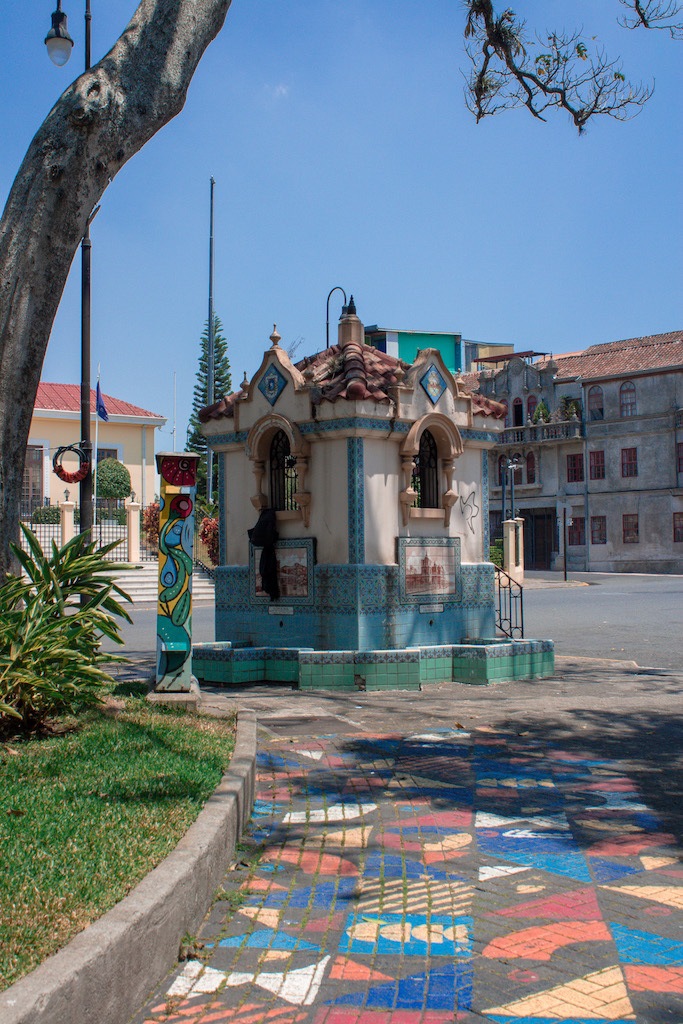
Architecture can make or break a destination for me. To be honest, when I first set foot in San José, I kept asking myself, “Where’s all the old architecture?” because I didn’t see much of it downtown. Considering the city was founded in 1848, this was a surprise.
However, I found what I was looking for in Barrio Otoya and Barrio Amón. This is San José’s oldest and most historically significant area, evident in the intricate colonial designs on the buildings, which differ from others I’ve seen in other Latin American cities, and the significant Baroque and Gothic influences in these neighborhoods. Being a lover of history and architecture, I absolutely adore this part of San José!
I recommend starting at the corner of Calle 11A and Avenida 7 and walking east for a block, then turning left and making a loop. There are murals to stop and look at, cute shops to peruse, and some great restaurants to dine at, like Steiffel Pub and Café Otoya.
6. Visit Hacienda La Chimba
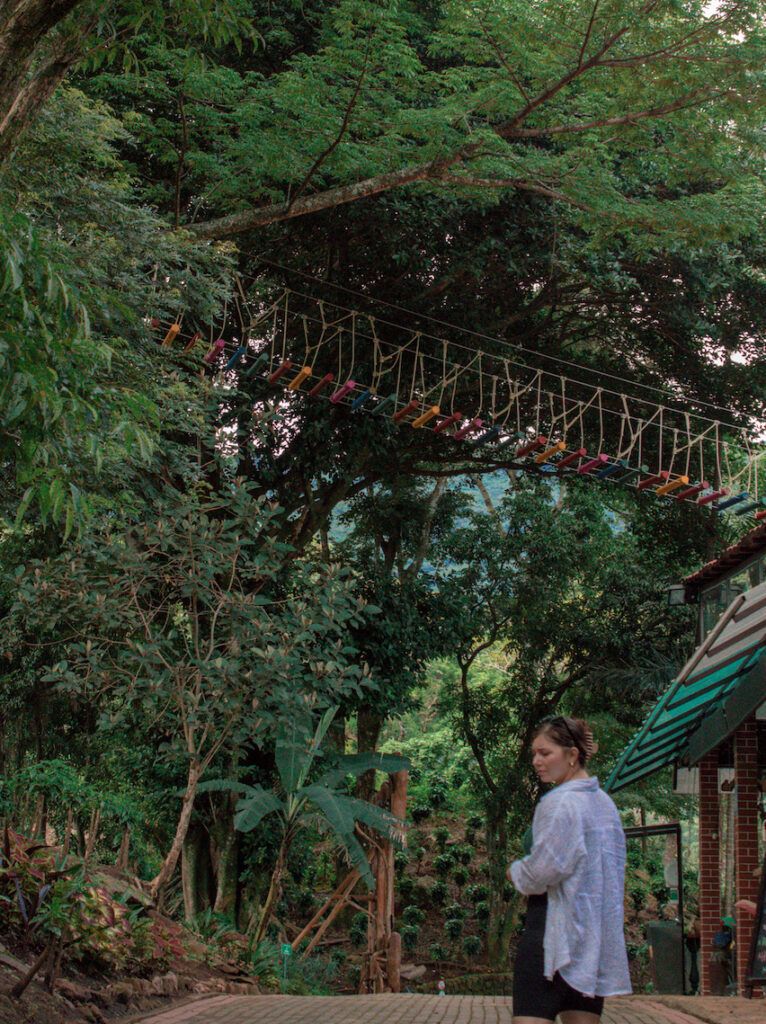
If you adore coffee as much as I do, don’t pass up the opportunity to check out Hacienda La Chimba . Here you’ll find 65 hectares of nature trails and coffee fields, and an entire museum dedicated to everything Costa Rican coffee. The Mantra Trail has an awesome viewpoint, where you can walk out onto a huge wooden hand. I wanted to explore the trails more, but unfortunately, there was a downpour right when I arrived.
Even with the rain, I enjoyed visiting La Chimba. The breakfast and coffee were spectacular, and the scenery even more so. There are also many activities you can take part in, including zip-lining and going on a coffee-related tour; it seemed quite expensive, at around $25 for just an hour, so I skipped it and explored on my own instead. If you were to visit during the the coffee plantation’s harvesting and processing season in September, however, the tour might be worth it, as you’d be able to actually see the place in action.
7. Try a Henry Blend at La Mancha
Speaking of coffee, the best brew is at La Mancha in downtown San José, and nobody will ever convince me otherwise. Located in the Steinvorth Building, it has been around for the better part of a decade and sources its coffee from small farms throughout Costa Rica. For me, it was love at first sip when I visited the place in 2022. Now, I can’t seem to stay away.
While a cup of plain black coffee will knock your socks off with its robust and complex flavor, I recommend ordering the Henry Blend, because you can’t get a drink like it anywhere else. It contains cold-brew coffee, coffee-peel tea, and limón criollo, aka mandarin-lime juice. It’s refreshing, punchy, and the perfect pick-me-up before you continue your adventure around town.
8. Learn about Costa Rican history at Mercado Borbón
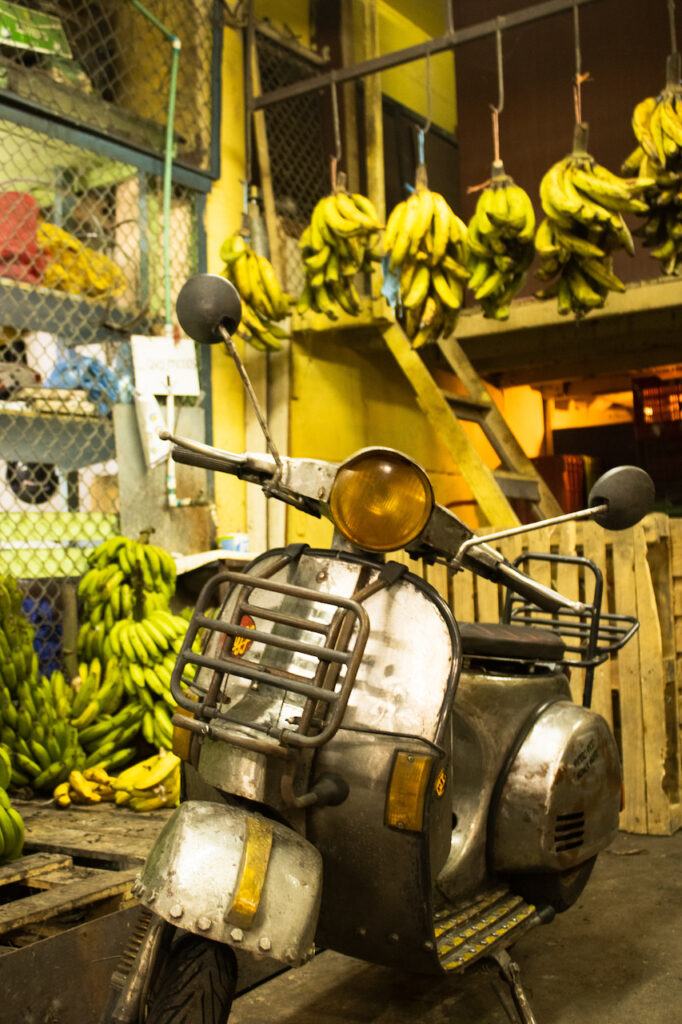
If you want to learn about a Latin American city and its people in the quickest way possible, go to the biggest fruit and vegetable market in town: Mercado Borbón. Here you’ll also find a mind-blowing variety of fruits and vegetables, some that look like they belong on another planet!
There are also several areas of Mercado Borbón that hold an important place in the history and culture of San José, a story of resistance and resilience that paints a colorful picture of Costa Rican grit, like the banana stand above. This specific vendor was one of the first in the country to sell bananas autonomously, without the control of multinational companies.
I visited the market on a food and sightseeing tour . I was lucky enough to be the only person who signed up that day, so my guide, a San José native, was happy to answer all of my questions.
9. Enjoy the sights, smells, and tastes of the Mercado Central
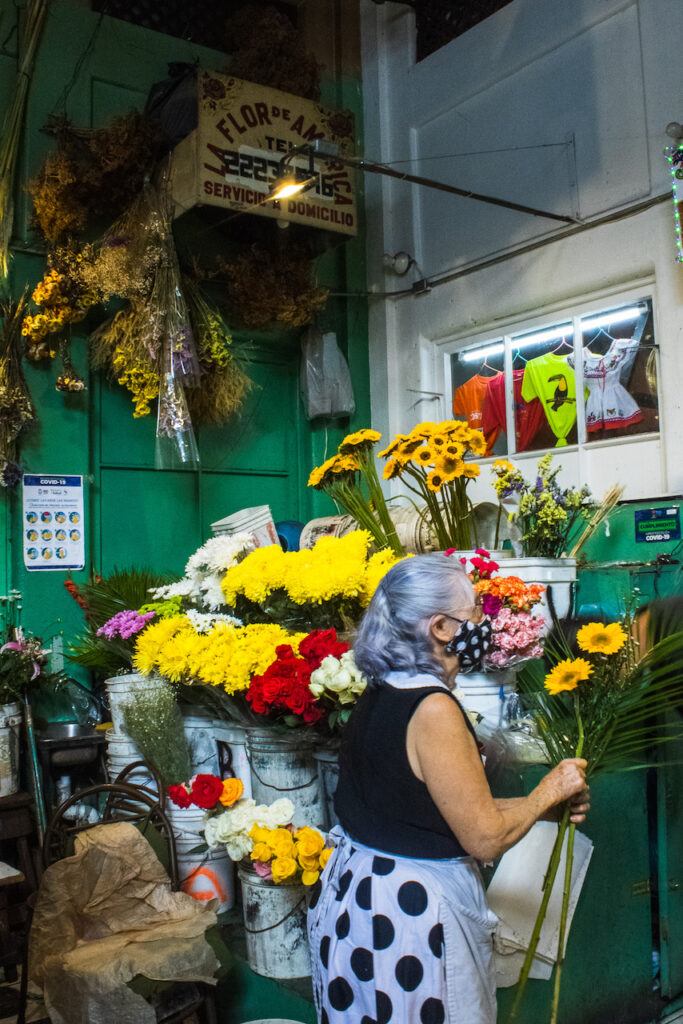
Mercado Central is definitely better known than Mercado Borbón, which is evident in how packed it gets in the mornings. Here you’ll see locals doing their fruit and vegetable shopping, tourists checking out the souvenirs, and businesspeople grabbing a quick empanada before work. My guide explained that Mercado Central is the beating heart of San José, and I can see why!
This sprawling market has everything you can imagine, from exotic fruits to herbal remedy stands to small coffee shops, and much more. It’s also home to Costa Rica’s first and most famous ice cream spot: La Sorbetera de Lolo Mora.
10. Stroll through the Museum of Costa Rican Art…
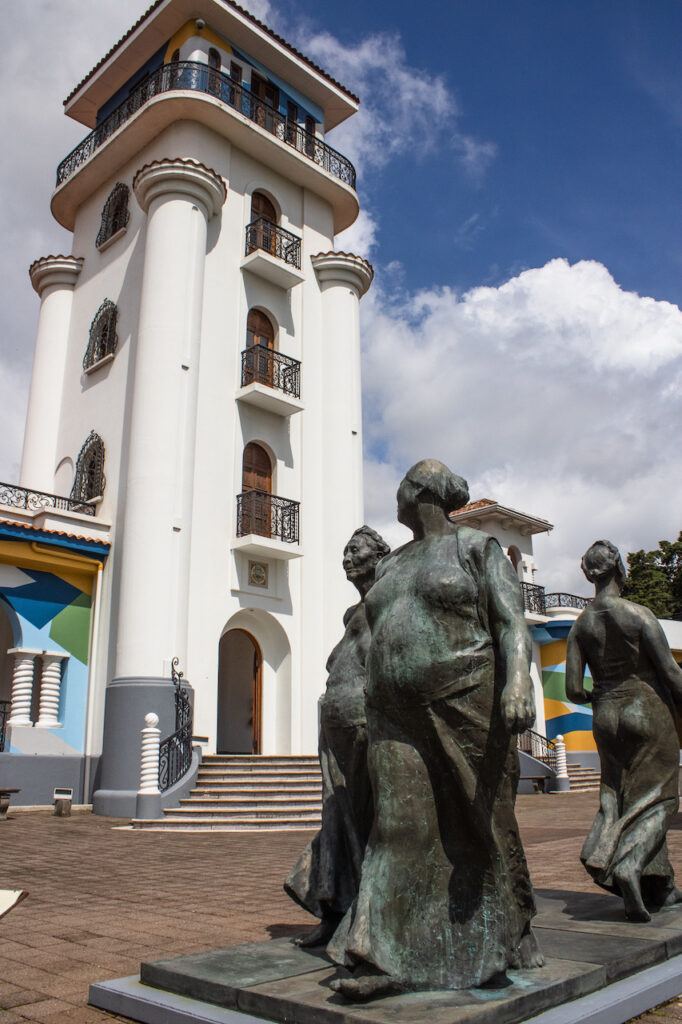
The Museum of Costa Rican Art is small but mighty, featuring paintings, sculptures, and mixed-media pieces by Costa Rica’s most famous artists. There are both indoor and outdoor spaces, with a wide range of works that demonstrate the country’s artistic diversity.
The museum is free, which was a huge draw for me, considering that others in San José can cost up to $20 to visit. I only spent about an hour there, as it’s quite small, but it’s right next to Parque La Sabana, so you can hit up both places if you’d like.
11. …and don’t forget to check out the Gold Room
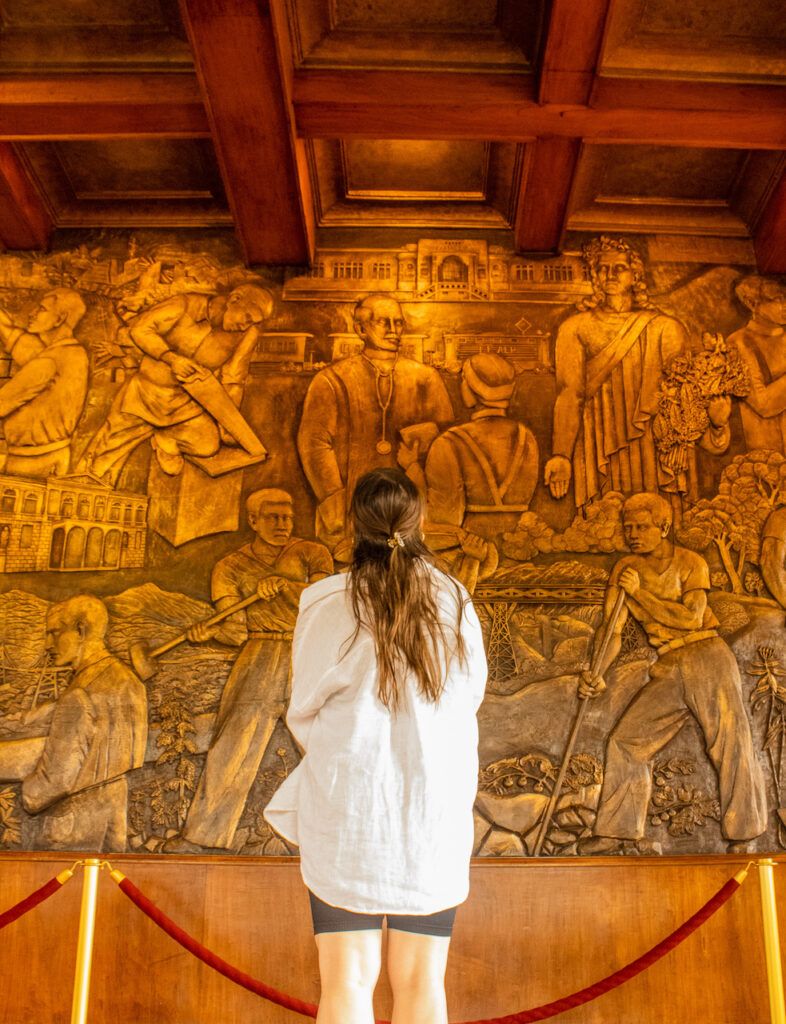
I almost missed this, because I didn’t see at first that the museum had a second level. Up the winding staircase you’ll find signs pointing to the “Salon de Oro,” which contains a 360-degree golden mural depicting quotidian scenes from Costa Rica’s past. The room was actually once an airport lounge (the present-day La Sabana park next door was the site of San José’s airport until the late 1940s). It’s quite impressive and worth taking a lap around to see the mural’s small details.
12. Venture out to Lankester Botanical Garden
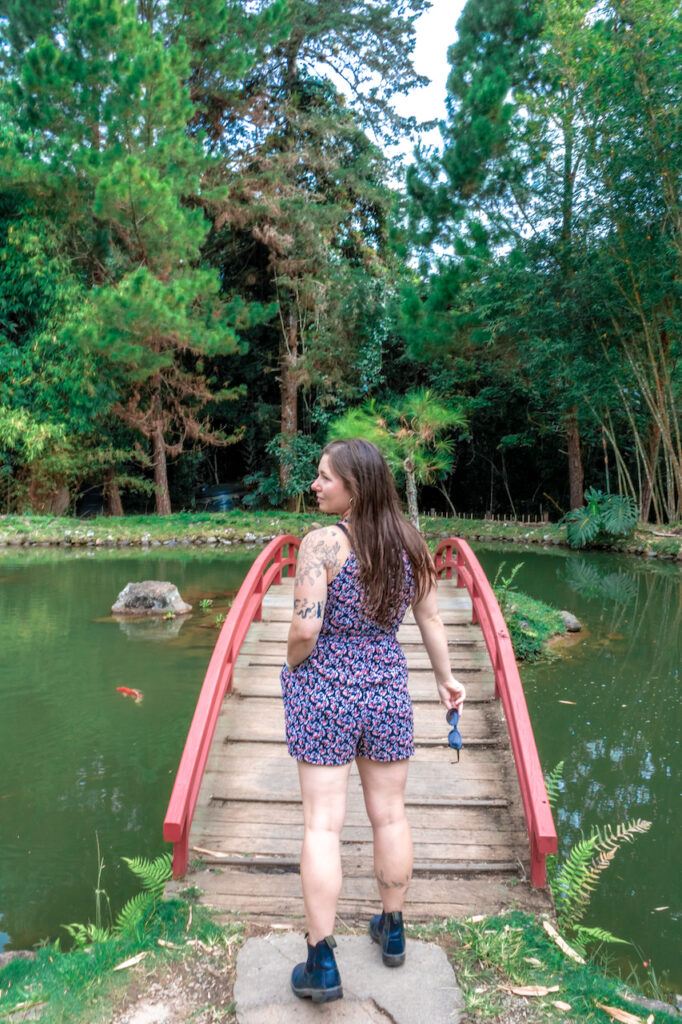
Lankester Botanical Garden , part of the University of Costa Rica, is well worth the hourlong drive from the center of San José. Here you can find a mind-boggling collection of orchids, many of which I had never seen before and looked like magnificent works of art. There’s also a serene Japanese garden, which includes a traditional tea and meditation room replica and Zen garden.
There are tours available , which you have to schedule ahead of time. This would be great if you’re especially enthusiastic about plants, but I enjoyed simply roaming around the gardens and observing on my own.
13. Take a day trip to Cartago, Costa Rica’s old capital
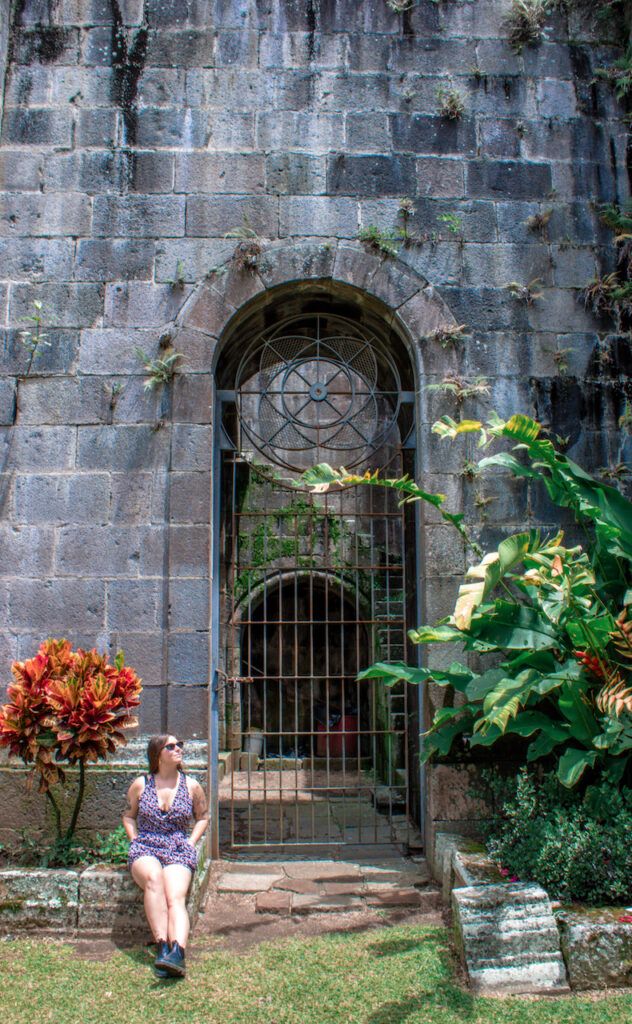
Bathe yourself in Costa Rican history by visiting the country’s first capital, Cartago. The city is just a 40-minute bus ride from San José and is the place to learn about the country’s past.
Immediately upon arrival, I felt the stark contrast between Cartago and San José. Whereas the latter has tall buildings and an urban edge, the former has a mix of old and new, with the most central part of town featuring the so-called ruins of an unfinished cathedral. They are as mysterious as they are photogenic, but they are only the beginning of the historical gems you’ll find here.
Head to the Cartago Municipal Museum and browse for free. I went there looking for a mural that depicts the history of Costa Rica and was blown away by its size, detail, and imagery.
I suggest visiting Cartago in the morning, grabbing a quick meal in the Municipal Market, and exploring on foot. From there, you can also easily Uber to the abovementioned Lankester Botanical Garden to round out an awesome day trip.
14. Admire the city’s street art
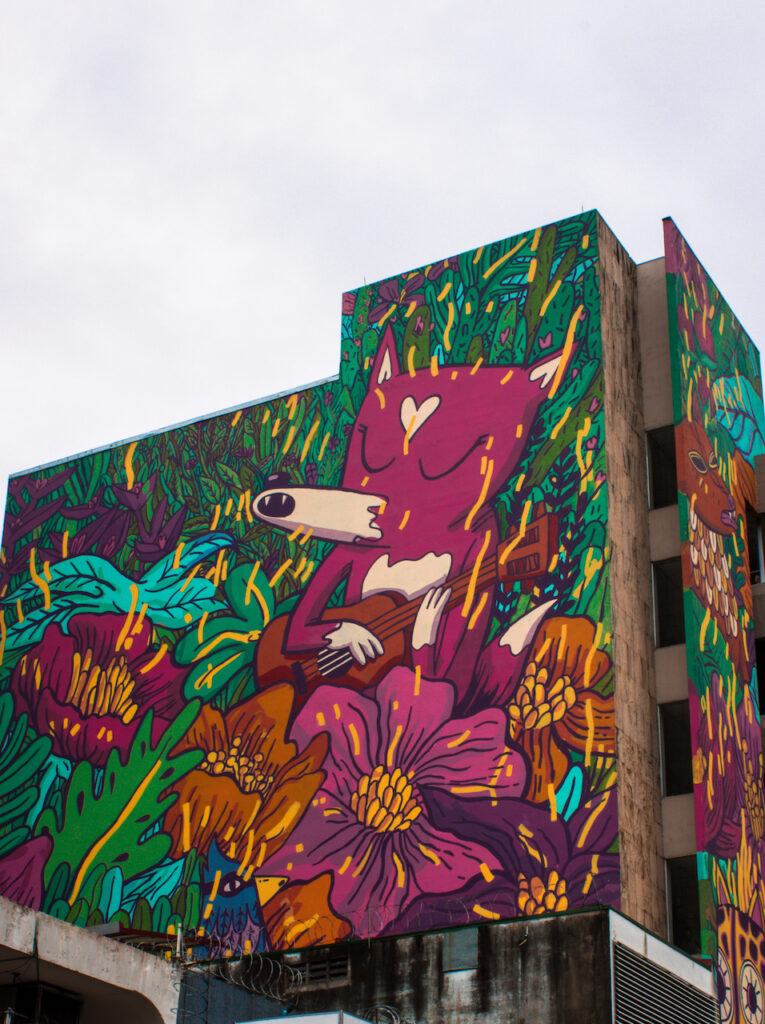
Like many Latin American cities, San José has street art on just about every block. Besides simply decorating the capital with vibrant colors, these murals also serve to tell San José’s story. While I was able to stumble upon plenty of murals simply by walking around Barrio Amón, Barrio Bird, and the city center, a more efficient way to learn about them is by taking a tour, like this one offered by Barrio Bird Walking Tours.
Where to Stay in San José
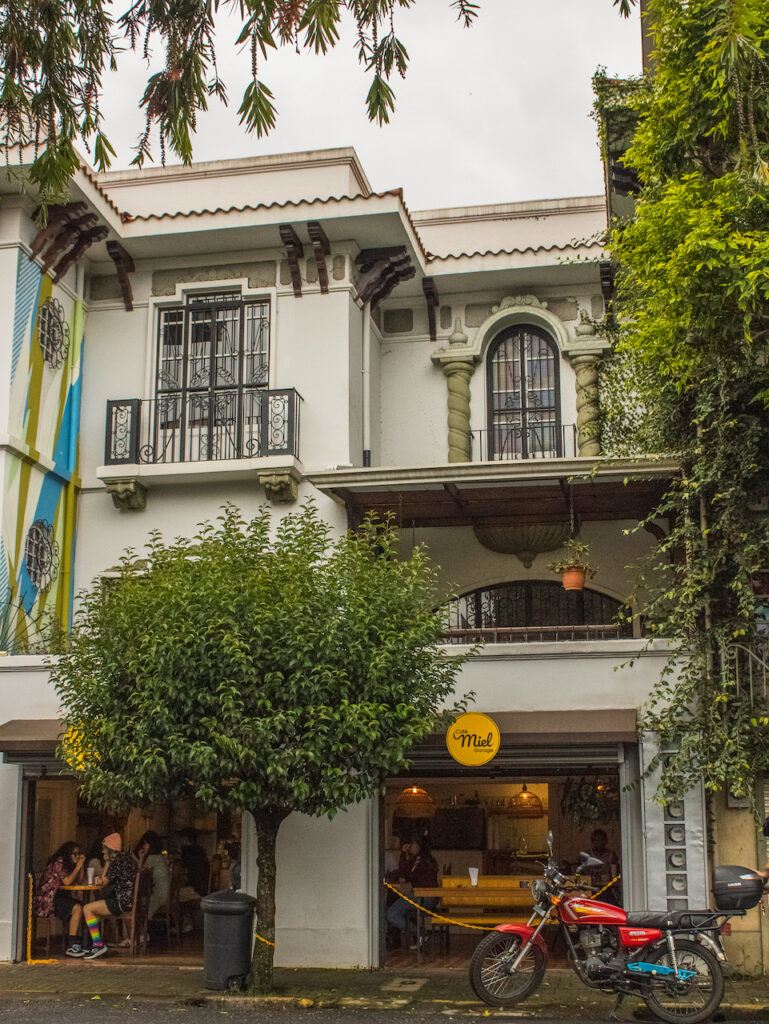
I honestly got very lucky with my accommodations in San José, because I can’t image a better neighborhood to stay in than Barrio Amón, one of the oldest and safest neighborhoods. (There are plenty of other areas, including downtown San José, that I would not recommend.) If you’re visiting for the first time and want to stay somewhere central, quiet, and safe, choose Barrio Amón or Barrio Escalante.
I adored my Airbnb in Barrio Amón . The location made it easy to walk everywhere, plus it was in a safe area with plenty of restaurants and cafés nearby. If you’re backpacking or just want to meet other travelers, Selina is a great accommodation, just down the street from where I stayed.
Staying Safe in San José
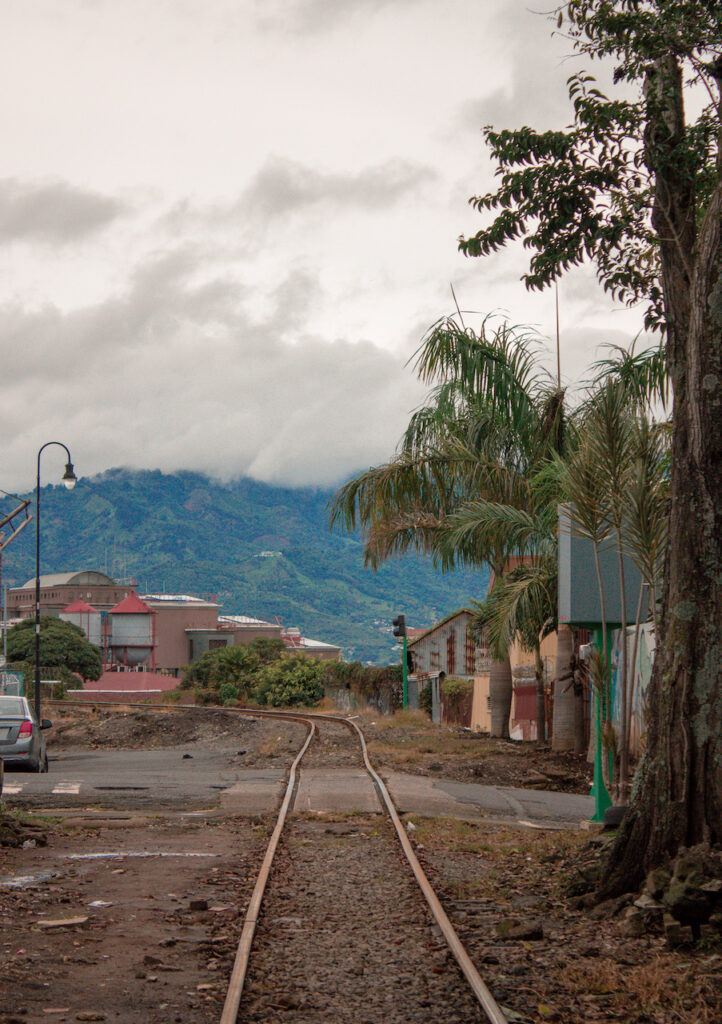
Like many Central American cities, San José has a reputation for not being the safest place to visit. Pickpocketing is common, especially in crowded areas and at night. As a solo female traveler, I have to admit that there were a few moments during my short time in town when I felt my danger radar ping. However, I still think this city is a decent one for travelers like me.
That said, I don’t recommend walking anywhere alone at night in San José, period. Uber is affordable here, so if you have to walk more than a couple blocks, just grab one. I also don’t recommend walking with your wallet or phone in your hand or pockets at any time of day. Instead, keep them in a fanny pack or an inside pocket of a backpack (worn on the front of your body). Even locals do this, so don’t feel silly about doing likewise.
I also don’t recommend wandering around neighborhoods you aren’t familiar with. Besides the downtown walking streets in Barrio Amón and Barrio Escalante, I didn’t do a whole lot of exploring on foot here. That’s because when I walked from my Airbnb to a restaurant only 15 minutes away, I found myself in a neighborhood I didn’t feel entirely safe in. In order to not have a repeat of that moment, I decided to plan my routes before heading out from then on, and took Ubers if there was more than a 10-minute walk through a neighborhood I wasn’t familiar with yet.
Pin me for later:

Before visiting San José, I wasn’t so sure how much I’d enjoy a Costa Rican concrete jungle, as opposed to the lush green ones that most people flock to. However, I found that there were some enchanting pockets that proved wrong most of the negative things I’d read about San José being filthy and unappealing. I stand by giving it a chance and having an open mind, as there’s so much to love about this vibrant city.
*Some links in this post are affiliate links for products and services we personally use and l love. Any purchase you make through them supports us at no extra cost to you. Thanks so much!
About Emily Becker
Emily Becker is a digital nomad based in Costa Rica. She's been traveling on and off since 2014 and has visited 15 countries—planning to tick many more off her bucket list. In addition to writing for BMTM, she works as a copywriter and project manager.
Leave a Reply Cancel reply
Your email address will not be published. Required fields are marked *
Save my name, email, and website in this browser for the next time I comment.
subscribe to our newsletter
This site uses Akismet to reduce spam. Learn how your comment data is processed .
- Central America
- The Top 10 Things To...
The Best Things To Do In San José

San José is the capital of Costa Rica and one of the fastest growing destination cities in the world. Built on the profits of the coffee trade, the city is abound with culture and boasts a score of museums, parks, theaters, and restaurants . Here are some of the best things to see and do while visiting this beautiful city.
Did you know – Culture Trip now does bookable, small-group trips? Pick from authentic, immersive Epic Trips , compact and action-packed Mini Trips and sparkling, expansive Sailing Trips .
The National Theater of Costa Rica
Built in 1897, the National Theater has elegant European-style architecture and stages a variety of shows throughout the year. A great source of national pride, the establishment is best explored with the help of a guide, and there’s a coffee shop and gift shop within for those looking to relax and collect some souvenirs.
Containing over 1,600 artifacts of Pre-Columbian gold from 500 A.D., this museum’s impressive collection is well worth a visit. It is located under the Plaza de la Cultura, which is home to two other currency-related museums, the National Coin Museum, which has a collection dating back to 1236, and the “Casa de Moneda” that shows the history of minting in Costa Rica. The saying “worth its weight in gold” definitely applies here; despite its small stature, the Meso del Oro Precolombio is a valuable resource for learning about the global history of this precious metal.
Parque Metropolitano La Sabana
This sprawling park is known as “the lungs of San José.” It’s a popular and vital space for the city’s residents to get some fresh air, and a great stop for travelers to enjoy a refreshing afternoon stroll or lazy picnic. Located in the center of the city, it’s also been called San José’s equivalent to Central Park in New York City . Although it can get busy on the weekend, it’s a great place to observe the locals and enjoy a bit of nature in the middle of a busy city.
Casa Amarilla
Located on the northeast corner of Parque España, this beautiful colonial-style, yellow mansion is home to the ministry of foreign affairs. Although it is closed to the public, it’s worth strolling by to admire the elegant outer architecture, as well as the historic ceiba tree in front, which was planted by John F. Kennedy during his visit to Costa Rica in 1963. Can’t miss: A piece of the Berlin Wall can be seen in the rear garden
Museo de los Niños
The Museo de los Niños (the Children’s Museum) is one of the best cultural destinations in San José for both its location and content. Situated on a hill in a medieval castle, it offers beautiful views of the city and is a great place to take your family for an afternoon of exploration and education.
Catedral Metropolitana (Metropolitan Church)

Located right by the National Park, the Catedral Metropolitana is a beautiful large church in the heart of San José. Don’t let the plain exterior fool you, as the inside holds exquisite wood carvings, stained glass windows, and a Christ figure dating back to the 17th century. For religious and non-religious alike, it’s a beautiful place to see while visiting San José.
Mercado Centrale
For those looking to explore an authentic Costa Rican market, this is the place to go. It sells everything from hammocks to knickknacks, coffee beans to cigars. Just try to avoid the tourist traps because there are better places to get souvenirs (see below for an idea), and don’t be afraid to bargain for what you want.
Biesanz Woodworks
Located on the hills of Bello Horizonte in Escazú, Biesanz Woodworks is a bit of a hike to reach but well worth the effort if you want a truly unique memento that combines sculpture with souvenirs. It is run by the celebrated artisan Barry Biesanz, who uses pre-Columbian techniques in which the shape of the object is determined by the lines of the wood. As a result, you’ll find bowls, humidors, and boxes of all shapes and sizes here. The pricing is relatively more expensive than the trinkets you might find at the Mercado Centrale, but the quality of the craftsmanship is truly excellent.
Museo Nacional de Costa Rica (National Museum of Costa Rica)
First opened in 1887, what was once an abandoned jail now hosts nine vibrant galleries, three or four of which are always temporary. The exhibits at the National Museum range widely from modern art to history, and it’s best to have a guide to get the most out of your visit.
El Valle del Rio Orosí (Orosí River Valley)
For those looking to escape the city for a day and have some adventure, Orosi River Valley is the perfect place to go. Pass by staffee plantations and beautiful Costa Rican countryside to visit Cartago, Costa Rica’s first capital, before arriving at the Tapanti National Park, which hosts a range of activities from boat rides to white-water rafting. While exploring the park, be sure to check out the natural hot springs located right on the river, and the oldest standing church in Costa Rica. There are some great hiking trails and beautiful views from the lookout point of Orosi as well, so be sure to pack your camera.
Since you are here, we would like to share our vision for the future of travel - and the direction Culture Trip is moving in.
Culture Trip launched in 2011 with a simple yet passionate mission: to inspire people to go beyond their boundaries and experience what makes a place, its people and its culture special and meaningful — and this is still in our DNA today. We are proud that, for more than a decade, millions like you have trusted our award-winning recommendations by people who deeply understand what makes certain places and communities so special.
Increasingly we believe the world needs more meaningful, real-life connections between curious travellers keen to explore the world in a more responsible way. That is why we have intensively curated a collection of premium small-group trips as an invitation to meet and connect with new, like-minded people for once-in-a-lifetime experiences in three categories: Culture Trips, Rail Trips and Private Trips. Our Trips are suitable for both solo travelers, couples and friends who want to explore the world together.
Culture Trips are deeply immersive 5 to 16 days itineraries, that combine authentic local experiences, exciting activities and 4-5* accommodation to look forward to at the end of each day. Our Rail Trips are our most planet-friendly itineraries that invite you to take the scenic route, relax whilst getting under the skin of a destination. Our Private Trips are fully tailored itineraries, curated by our Travel Experts specifically for you, your friends or your family.
We know that many of you worry about the environmental impact of travel and are looking for ways of expanding horizons in ways that do minimal harm - and may even bring benefits. We are committed to go as far as possible in curating our trips with care for the planet. That is why all of our trips are flightless in destination, fully carbon offset - and we have ambitious plans to be net zero in the very near future.

The Top Fashion Boutiques in San José, Costa Rica

Restaurants
The best brunch and breakfast spots in san jose, costa rica.

Bars & Cafes
The top 10 bars in san josé, costa rica.

The Best Restaurants In San José, Costa Rica

See & Do
The best hiking trails near san josé, costa rica.

Places to Stay
The best villas and vacation rentals to book in san jose, costa rica.

The Best Hotels to Book in and Around San José, Costa Rica

A Budget Traveler’s Guide to San José, Costa Rica

The Best Hotels With Pools to Book in San José, Costa Rica

The Best Quirky Restaurants in San José, Costa Rica

Best Cafes in San José, Costa Rica

The Best Boutique Hotels to Book in San José, Costa Rica
Culture trip spring sale, save up to $1,100 on our unique small-group trips limited spots..

- Post ID: 517432
- Sponsored? No
- View Payload

29 Things to Do in San Jose Costa Rica That You’ll Love
Disclaimer: This article may contain affiliate links. Clicking on them may earn Costa Rica Vibes a commission, at no extra cost to you. Thank you for your support!
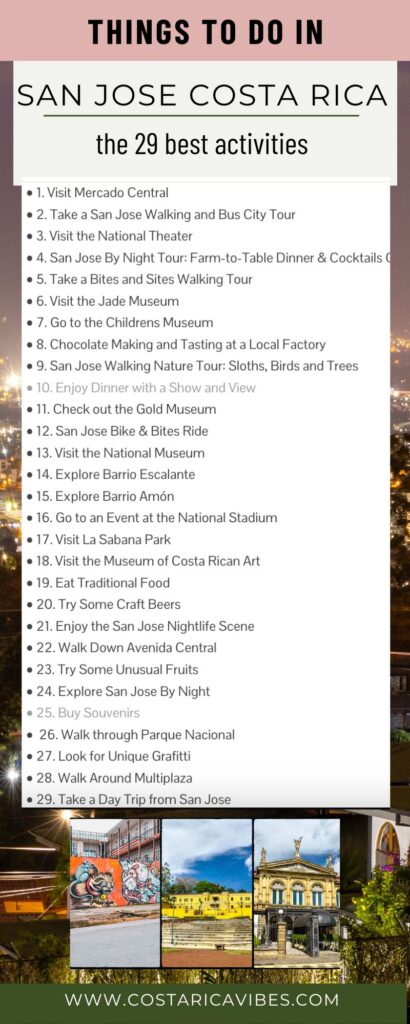
Are you looking for things to do in San Jose Costa Rica during your travels?
San José is the vibrant capital city of Costa Rica. It is a treasure trove of cultural experiences, mouthwatering cuisine, and unforgettable sights. Whether it’s bustling markets, historic architecture, or the lively arts scene, there’s something you are bound to enjoy.
We have lived in San José since 2016. We’ve immersed ourselves in the city’s daily life, wandered its streets, frequented the hidden gems, and seen the most widely visited tourist sites as well. So, we feel confident in sharing with you the best things to do in San Jose.
Get ready to embark on a journey with us as we uncover 29 must-do experiences in the large city of San José. Let’s get to it!
Our Choices for Top Things to Do in San Jose
For Nature Lovers : San Jose Walking Nature Tour: Sloths, Birds and Trees
For Foodies : San Jose By Night Tour
For Families : Visit the Childrens Museum
For Nightlife: Bar Crawl Tour
For Something Unique : Get tickets to a national soccer game
For Culture Lovers : See a show at the national theater
1. Visit Mercado Central
Mercado Central, also known as the Central Market, is a bustling market located in downtown San Jose . It’s basically a central cultural and commercial hub that offers a unique and authentic experience for both locals and tourists.
Month of May Savings!
📞 Purchase an eSIM card for your Costa Rica travels from Airalo 📱
Use code NEWMAY15 at checkout in May to save 15% as a new customer on purchases over $10!
Already a customer? Use the code AIRALOMAY10 for a 10% discount
Inside Mercado Central, you’ll find an array of stalls and shops selling a variety of goods.
You can buy anything here including fresh produce, meats and seafood, spices and herbs, and artisan crafts. There are also restaurants and food stalls. It’s a good place to get a taste of local life in the city.
Coming here always makes me think of some crazy chase scene in a Bourne movie. It’s easy to get lost in here and find something different around every corner.
Find it on the San Jose Things to Do Map
2. Take a San Jose Walking and Bus City Tour
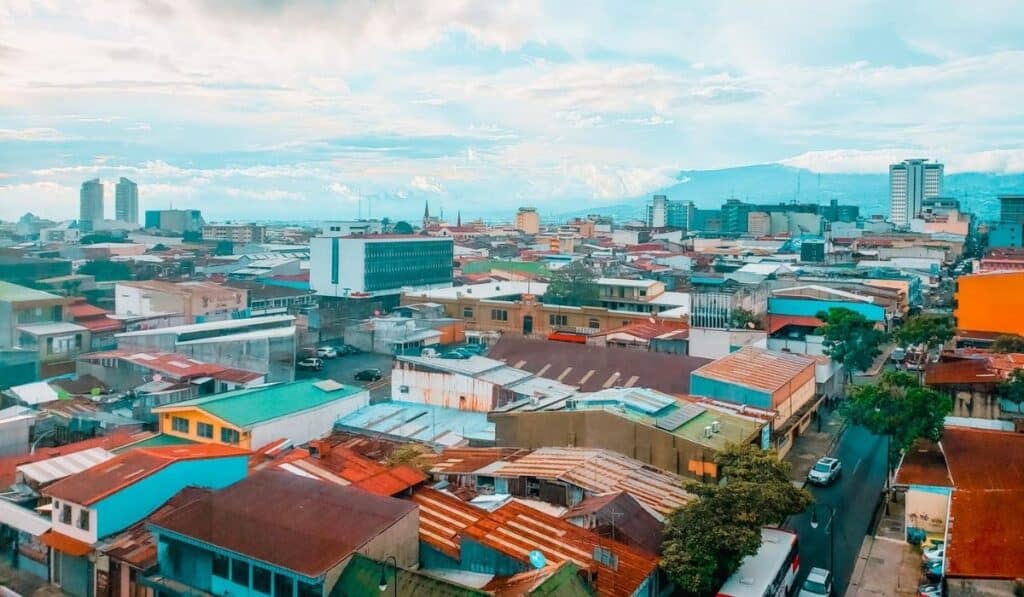
⭐️ RATING: 4.5/5 Stars on Viator | ⏳ TOUR LENGTH: 5 hours | ✅ Book it!
As a child my parents were somewhat anti bus tour in new cities. For some reason I always thought they must have been not worth the price. But, Thomas got me into taking city bus tours when we are in a new city, and now I’m hooked.
This San Jose bus and walking tour is the perfect way to get a good overview of the city center from an informative guide.

Highlights of this San Jose city tour include a visit to these tourist attractions:
Teatro Nacional Costa Rica: Step into the elegant lobby of this iconic theater! Spend 20 minutes absorbing the artistic atmosphere.
Central Market (Mercado Central) : Immerse yourself in the bustling vibes of local shopping! Spend 25 minutes exploring unique finds and experiencing the local culture.
Plaza de la Libertad Electoral : Eexplor this national monument, and gain insight into the nation’s electoral heritage.
Pre-Columbian Gold Museum (Pass By ): Enjoy a fascinating walking tour by the Gold Museum, delving into the rich pre-Columbian history showcased in the gold room.
Museo de Arte : Uncover the diverse artistic treasures of Costa Rican art museum, and be inspired by the vibrant creativity on display.
⤷ Check the Availability of San Jose Walking and Bus City Tour
3. Visit the National Theater
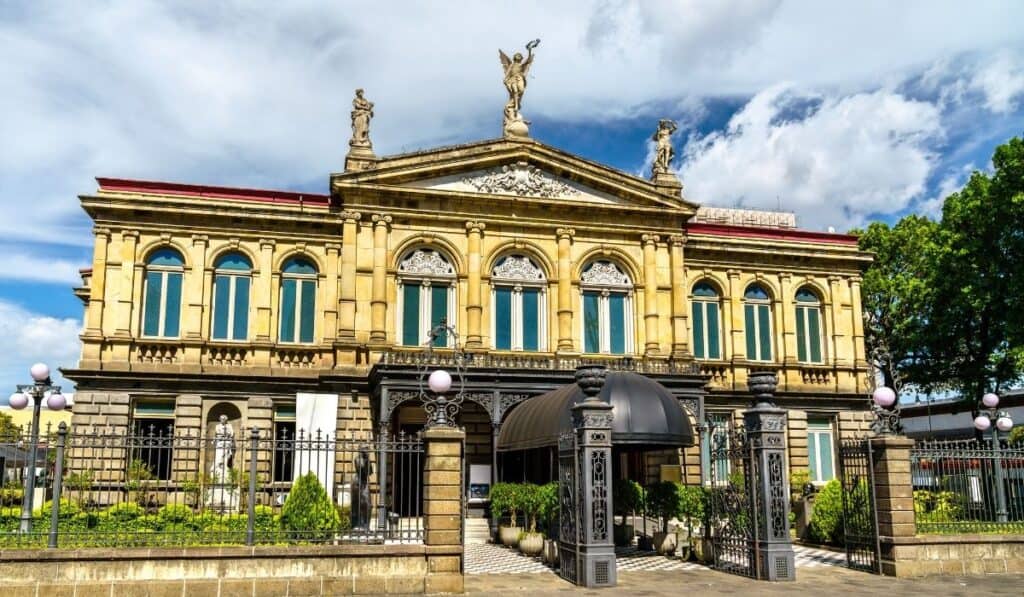
The National Theater (also known as Teatro Nacional) is a historic building located in the downtown section of the city.
This is where the national symphony and many foreign composers perform.
The interior of the theater is beautiful! We have been here a few times for orchestra and ballet performances. It always makes a nice date night event.
If you would like to see a show, you can check out the upcoming schedule and purchase tickets on the national theater website .
If you are unable to get tickets to see a show at the national theater, you can still visit.
The National Theater provides guided tour services in both Spanish and English.
Guided tours are available every day of the week, Monday to Sunday, from 9:00 AM to 4:00 PM, with tours starting every hour.
If you don’t want to take a tour, you can still enter the building and visit the small cafe. Here you can enjoy a tea, coffee, sandwich, wrap, etc. Its a nice spot!
4. San Jose By Night Tour: Farm-to-Table Dinner & Cocktails
⭐️ RATING: 5/5 Stars on Viator | ⏳ TOUR LENGTH: 2 hours 30 minutes | ✅ Book it!
We LOVE this tour!
You will kick off your journey at the Central Market with your local guide. You guide will unveil the secrets of roots, herbs, and fruits that are used to craft a Costa Rican dinner.
You will then meander through the Central Avenue and the National Theatre. Then, savor inventive cocktails at Mr. Sloth Coffee Shop.
Your tour will wrap up with a unique dining experience at a cozy, art-filled establishment, offering an insanely good menu.
This tour includes a delicious three-course gourmet dinner with wine pairings, plus some treats along the way.
We highly recommend this tour. It is really well done, a good value, informative, and FUN!
⤷ Check Availability of San Jose By Night Tour
5. Take a Bites and Sites Walking Tour
⭐️ RATING: 5/5 Stars on Viator | ⏳ TOUR LENGTH: 3 hours 30 minutes | ✅ Book it!
Dive deep into the heart of Costa Rica with this walking food tour of San Jose.
You’ll get to experience authentic Costa Rican flavors, all while soaking up the rich cultural heritage.
You’ll visit Mercado Central and Mercado Borbón, where you can shop for the freshest fruits and veggies. Then, it’s off to the National Theater and the charming La Laguna Plaza with plenty of treats along the way.
Food is all included in the price! So, all you need to bring is your appetite.
⤷ Check Availability of Bites and Sites Walking Tour
6. Visit the Jade Museum
The Jade museum (or Museo de Jade in Spanish) is home to the largest collection of pre-Colombian jade pieces in the Americas.
The main language in the museum is Spanish, but most displays also provide detailed info in English as well. There are also a decent amount of interactive exhibits that kids will enjoy.
There are always changing temporary exhibits to explore, so you might discover something really interesting such as pre-Columbian artifacts while there.
Overall, I think it is a great place to check out as you explore downtown San Jose.
It is open from Monday to Sunday from 8:00 am to 5:00 pm
7. Go to the Children’s Museum
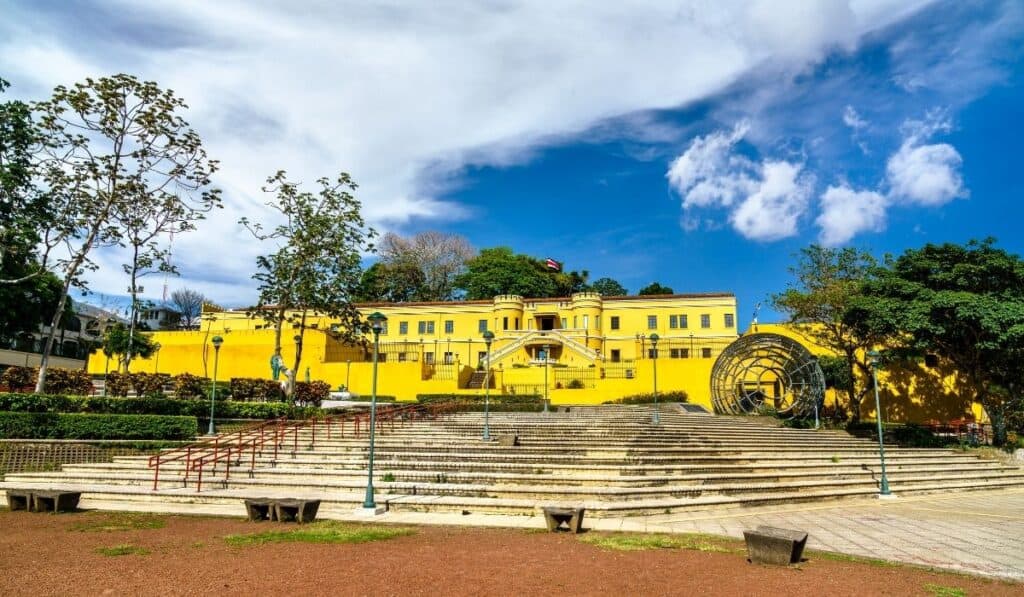
Explore the captivating Children’s Museum in San Jose!
This building was once a prison with a harsh history. But, this historic building was transformed by a former first lady into a joyful and informative space for kids.
The museum is ideal for kids 8 or under. Most exhibits are in Spanish, but many guides are English-speaking.
8. Chocolate Making and Tasting at a Local Factory
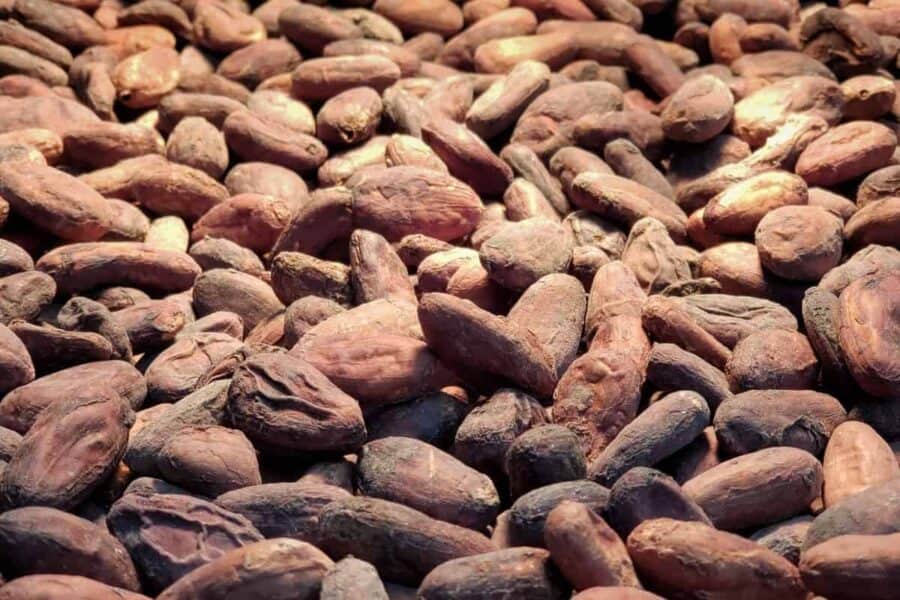
⭐️ RATING: 5/5 Stars on Viator | ⏳ TOUR LENGTH: 2 hours | ✅ Book it!
This activity is for all of you with a sweet tooth.
On this chocolate factory tour, you’ll delve into the rich history of cocoa in America.
Don’t worry, you’ll get to taste the seeds at varying stages, nibs, cocoa powder, cocoa butter, and delectable chocolate drinks.
You’ll experience different cocoa concentrations and then get hands-on, creating your very own chocolate concoctions. Mix and match with a variety of local ingredients and unleash your creativity!
They also provide eco-friendly materials for you to pack up your delicious creations.
Ready to taste, create, and indulge in a world of chocolate?
⤷ Check Availability of Chocolate Making and Tasting at a Local Factory
9. San Jose Walking Nature Tour: Sloths, Birds and Trees
The “San Jose Walking Nature Tour” offers a unique opportunity to explore Costa Rica’s biodiversity right within the city limits.
This tour is led by a knowledgeable local biologist. Participants get to encounter tropical birds, sloths, and exotic plants in their natural habitat.
Yeap, just because you are in the city it doesn’t mean there isn’t still a decent amount of wildlife!
The tour is limited to just 7 travelers, which we really like.
⤷ Check Availability of San Jose Walking Nature Tour: Sloths, Birds and Trees
10. Enjoy Dinner with a Show and View
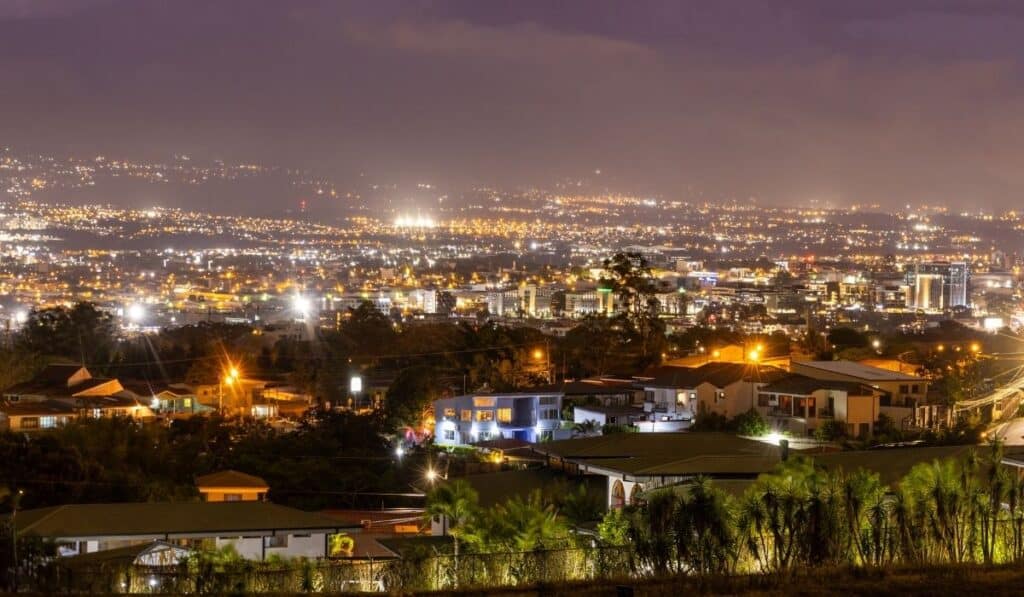
This activity is located a bit outside of the city, but it includes views of San Jose. Ram Luna Restaurant offers not just a meal, but an unforgettable experience for travelers.
This iconic spot blends traditional Costa Rican cuisine with panoramic views of the Central Valley. Also, they often have live marimba music and dance performances. It’s a fun time!
Unfortunately, this does not include transportation from downtown San Jose. You will either need a rental car or to take a taxi (which might be a bit pricey).
Check out the Ram Luna website for more info
11. Check out the Gold Museum
Deep beneath the “Plaza de la Cultura” in San José, and you’ll discover the Pre-Columbian Gold Museum.
This museum boasts over 3,500 artifacts, showcasing the craftsmanship from the Pre-Columbian era, dating from 300 BC to 1550 AD.
When visiting you’ll have the chance to check out gold pieces, from intricate animal figurines like frogs and jaguars to El Guerrero, a life-sized golden warrior.
You’ll also get to see a replicated pre-Columbian grave, laden with 88 gold artifacts.
12. San Jose Bike & Bites Ride
⭐️ RATING: 5/5 Stars on Viator | ⏳ TOUR LENGTH: 3 to 4 hours | ✅ Book it!
Discover San José with this fabulous zero-emission bike tour! It’s such a great way to really get up close and personal with the city, breezing past all those cars stuck in traffic.
We like this tour because you’ll see the main sights, but also some off the beaten path places for glimpse into Costa Rican culture.
Plus, there is local food involved. You’ll get to try empanadas and some local coffee.
Your guide will be with you every pedal of the way, sharing all kinds of cool background info and stories about the local highlights.
⤷ Check Availability San Jose Bike & Bites Ride
13. Visit the National Museum
The National Museum of Costa Rica is located in the city center. It has a little bit of everything from Costa Rican history to culture to art.
Visitors can walk through archaeological treasures, indigenous art, colonial relics, and even see bullet holes in the walls from Costa Rica’s 1948 civil war.
We really like the museum’s Butterfly Garden.
So, whether you’re a history buff, an art enthusiast, or a curious traveler, the National Museum most likely has something you’ll enjoy.
14. Explore Barrio Escalante
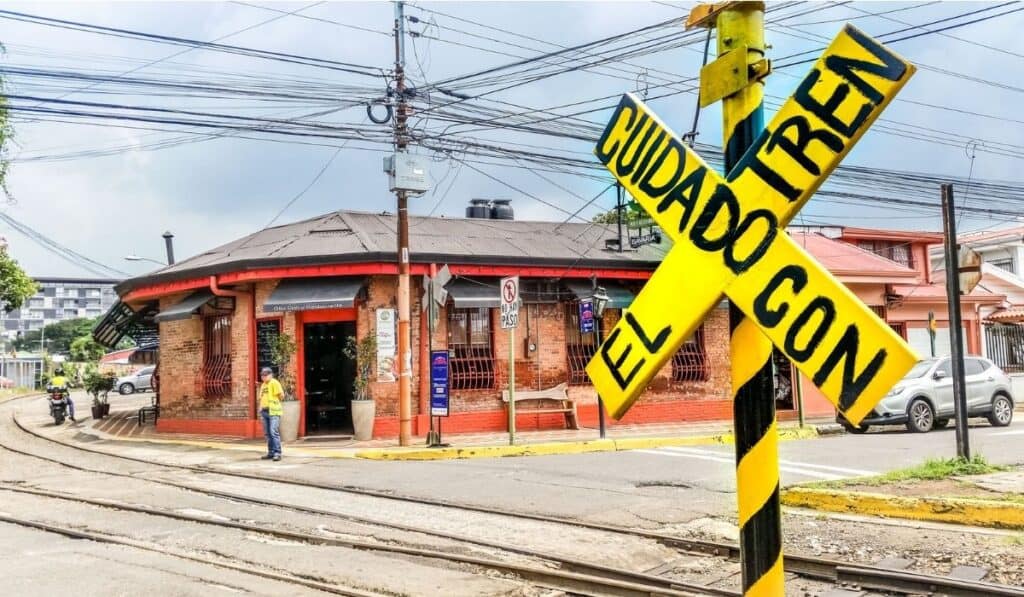
Barrio Escalante is our favorite neighborhood for craft beers, restaurants with a more organic vibe, and cute artisan-type stores. Basically, its the hipster neighborhood of San Jose.
The neighborhood is located just a short walk away from the downtown area of the city. The atmosphere here is electric, especially during the evenings when the area comes alive with a bustling nightlife.
The neighborhood’s walls are covered with colorful street art, you can sip artisanal coffee, and discover hidden art gems here.
15. Explore Barrio Amón
Barrio Amon is a charming neighborhood that is renowned for its well-preserved colonial architecture, lush greenery, and vibrant cultural scene.
To make the most of your visit, start by strolling along its tree-lined streets, where you’ll encounter elegant mansions adorned with intricate details.
We suggest visiting some of the area’s museums, galleries, and cultural centers that showcase Costa Rican heritage. Also, this is a good area to try some Costa Rican food at one of the many quaint cafes and restaurants.
16. Go to an Event at the National Stadium
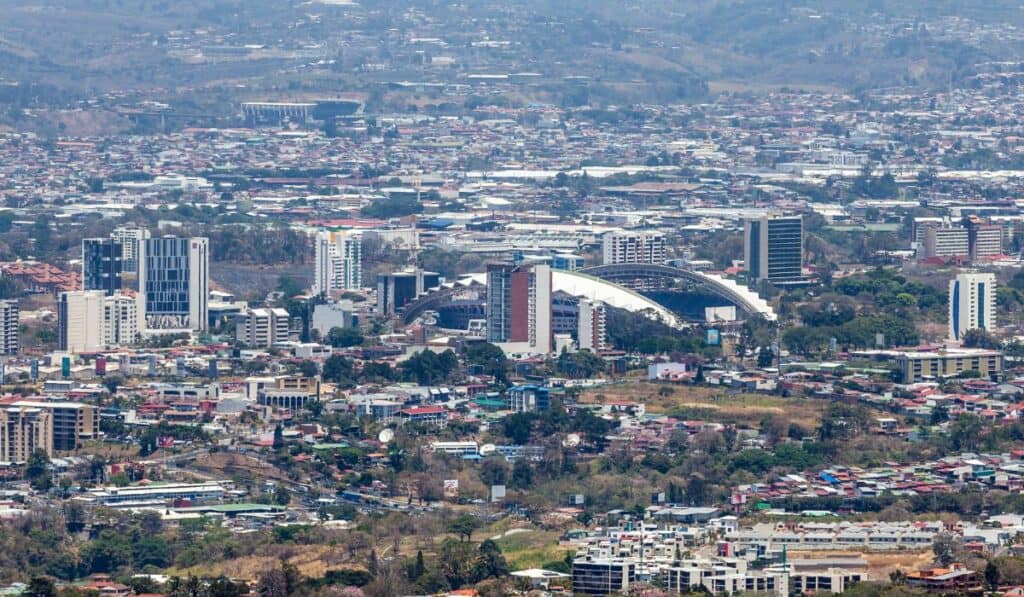
The national stadium is used for concerts and soccer games played by the Costa Rican national team.
We have never seen a game here, but I did go to a Justin Beiber concert here once just for the experience lol.
If you would like to see upcoming events, check out the official stadium website .
The stadium is located in the largest city parks, which we will talk about next.
17. Visit La Sabana Park
La Sabana Metropolitan Park is the largest city park and where the national stadium is located. This is a good place to take a long walk, go for a run, or bring a picnic.
The area surrounding the park is somewhat upscale so you can also find decent restaurants here.
18. Visit the Museum of Costa Rican Art
From the colonial era to today, the Museum of Costa Rican art has a bit of everything. Works from many of the country’s greatest artists are kept here, including a comprehensive collection from the prolific Juan Manuel Sanchez.
The museum sits in what used to be the main terminal of San Jose’s original international airport.
Where the tarmac used to be, there’s now a charming sculpture garden you can stroll through.
With entry under $5, it’s a steal! Located on the edge of La Sabana Park, it’s easy to combine experiences for a day filled with culture and nature.
19. Eat Traditional Food
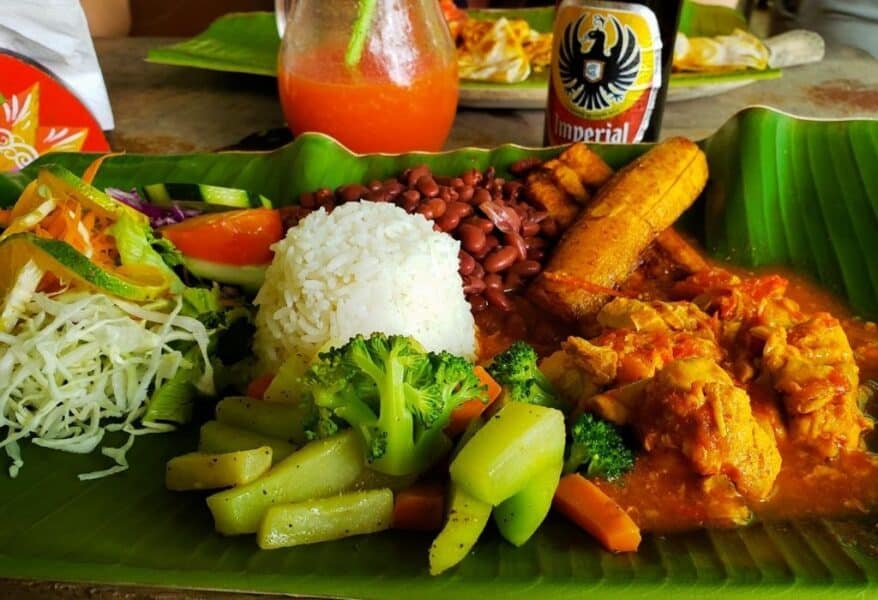
If you would like to try traditional cuisine while in Costa Rica , San Jose is a great place for that. The restaurant scene here is on point. There are places for all budgets and interests.
I suggest going to a small local restaurant (called a soda) and getting what is known as a casado.
This is a traditional meal of rice, beans, a protein (pork, chicken, or beef), a vegetable, and sometimes fried plantains or tortillas.
Its an affordable meal and usually it’s delicious. Often the places that don’t look overly touristy will be the best.
20. Try Some Craft Beers
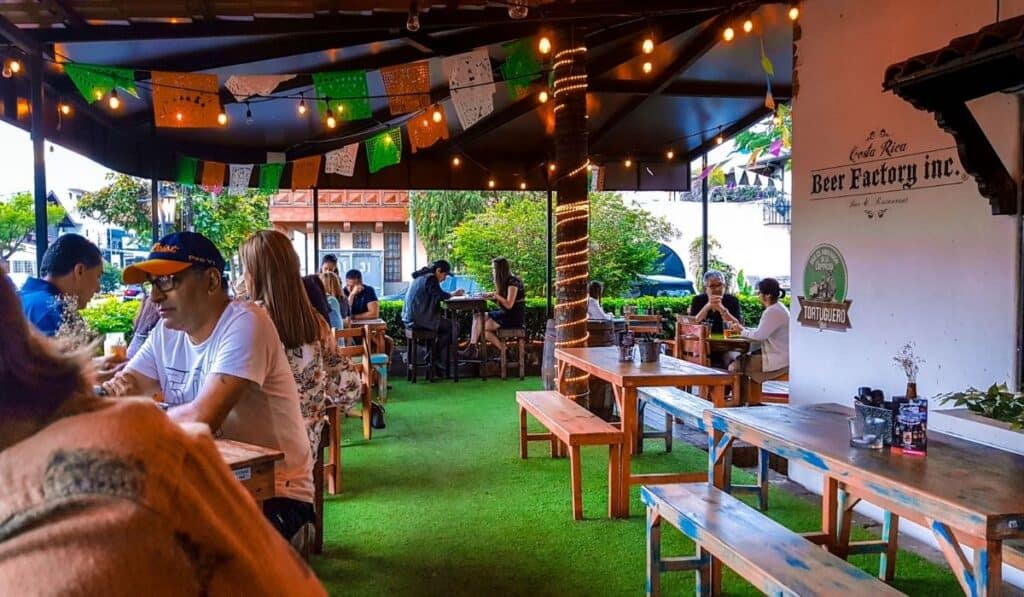
Visiting a craft beer bar is always a great idea!
There are several craft breweries in San Jose that are worth visiting. Our favorite area for a little craft beer hopping is always Barrio Escalante.
Check out our guide to beer in Costa Rica for a little craft beer walking tour you can do on your own.
21. Enjoy the San Jose Nightlife Scene
I’m not the best to advise you on the San Jose nightlife scene but, I can share a bit! The San Pedro neighborhood is definitely the best partying area. This is the university neighborhood and it is filled with lively bars and night clubs.
If going out on your own seems overwhelming, I suggest taking a bar crawl nightlife tour.
On this tour you will traverse through the renowned bar districts and enjoy alcoholic beverages at three unique pubs!
Expect a backdrop of lively music, a taste of local drinks, and a chance to meet fellow travelers.
⤷ Check Availability of Bar Crawl Tour
22. Walk Down Avenida Central
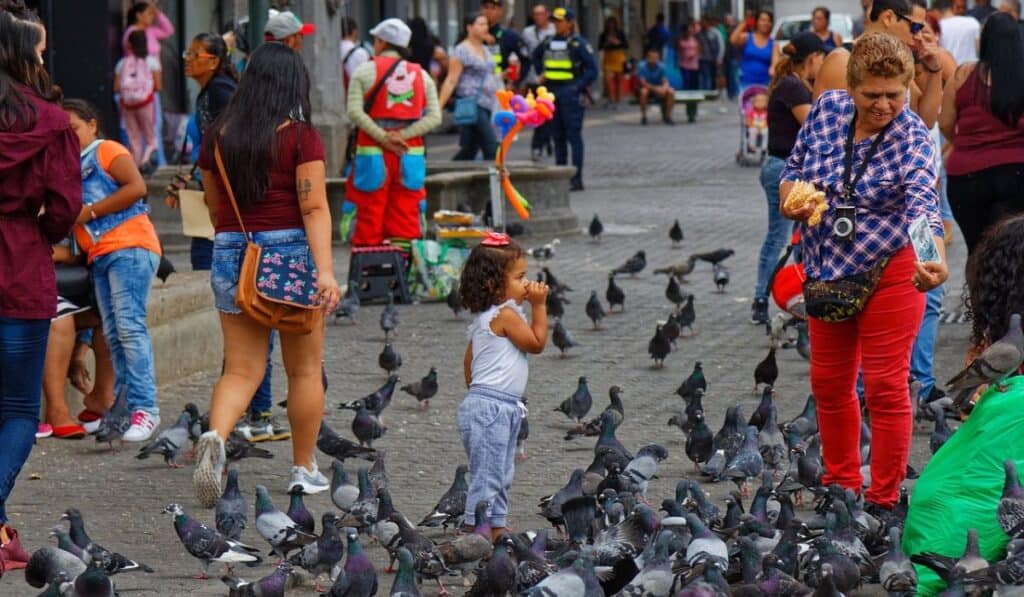
Avenida Central is the main shopping street in San Jose. It is a pedestrian road, so no need to worry about cars. This road is a cultural hub filled with shops, restaurants, street vendors, and local artists.
Be prepared to experience a lively atmosphere in this area!
The avenue is also flanked by several historical and architectural gems, including theaters and museums.
23. Try Some Unusual Fruits
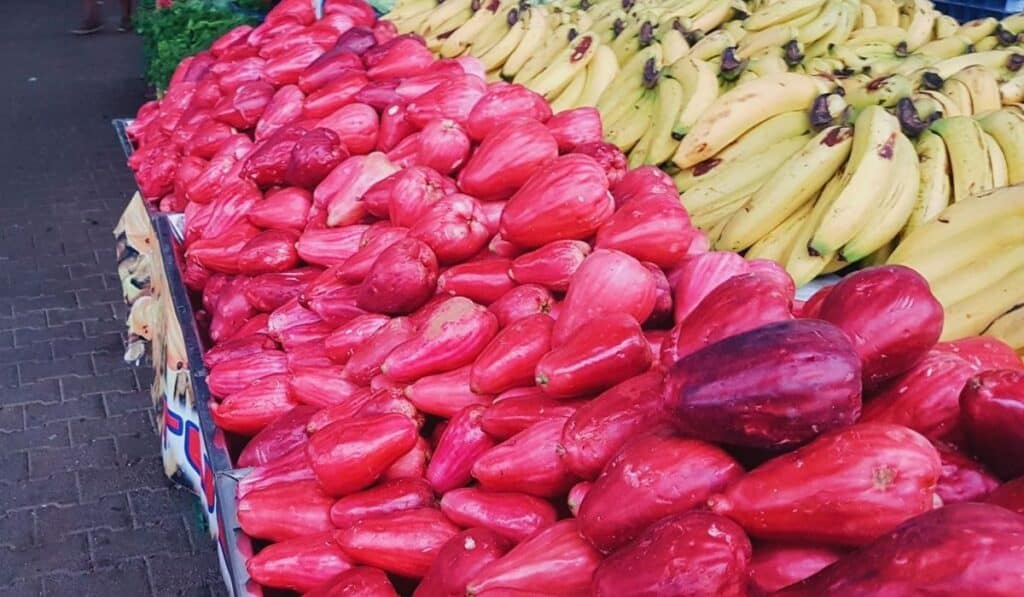
You will have no trouble finding street vendors selling fresh fruit and produce. We definitely suggest buying a few unusual tropical fruits to try out.
There are probably many fruits you have never even seen before. For example, have you ever eaten a Granadilla? How about Pejibaye?
Find out more in our guide to unusual fruits in Costa Rica.
24. Explore San Jose By Night
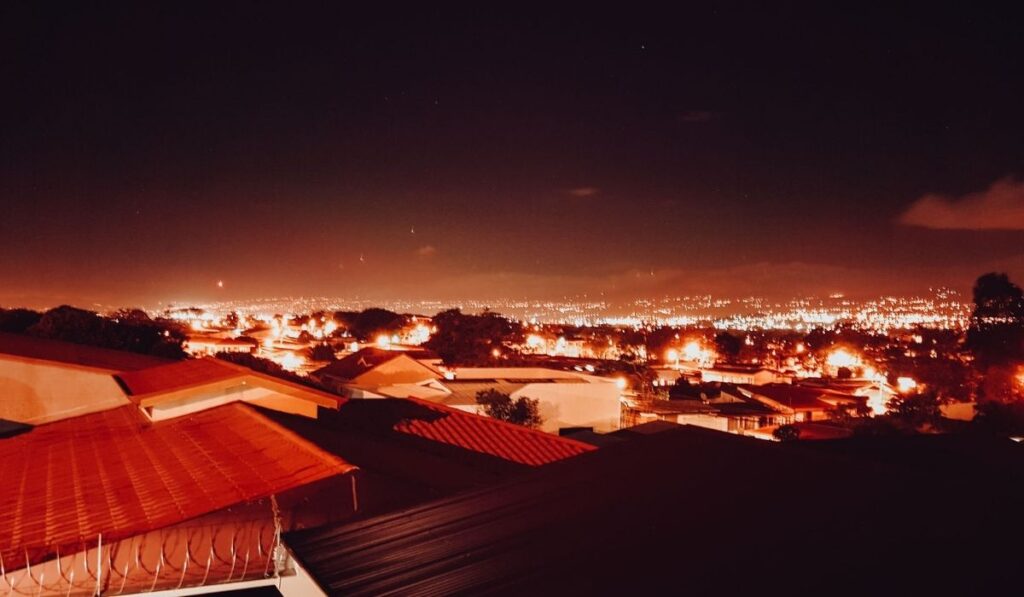
⭐️ RATING: 5/5 Stars on Viator | ⏳ TOUR LENGTH: 4 hours | ✅ Book it!
On this tour you will embark on a unique evening to see some of San Jose’s hidden gems. Your evening will start with a historical walk through Morazán Park and marveling at iconic landmarks like the Metallic Building and the Yellow House.
You’ll explore the local history and architecture in charming Barrio Escalante.
Cap off your adventure with a delightful 3-course meal, paired with wine or beer, at a gourmet Costa Rican restaurant.
⤷ Check the Availability of Explore San Jose By Night
25. Buy Souvenirs
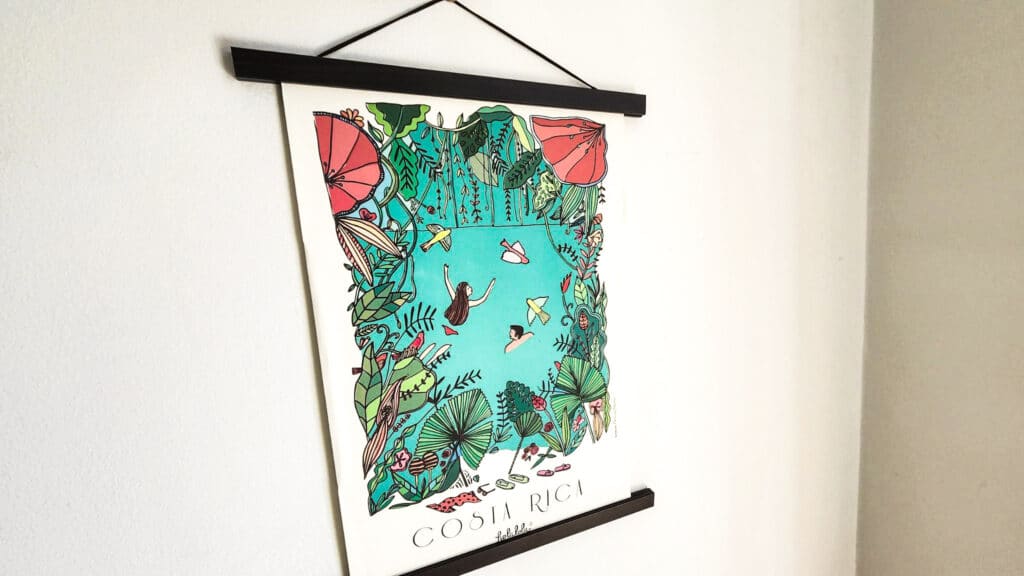
There are so many cute shops to find unique Costa Rica souvenirs in downtown San Jose.
The three best places that we suggest checking out:
- Holalola Gift Shop: Holalola is our favorite print designer in Costa Rica. They make amazing posters, greeting cards. Tote bags, home decor, etc.
- Arteria: Arteria makes tshirt and accessories with famous Costa Rican sayings.
- Mercado Municipal de Artesanías: This is a huge market area filled with artisans and people selling souvenir type goods.
Find them on the San Jose Things to Do Map
26. Walk through Parque Nacional
Parque Nacional in San José is a relatively compact urban central park, covering an area of approximately 1 square block. It’s not very big, but its significance lies more in its cultural and historical value.
The central feature of the park is the Monumento Nacional. This bronze statue is an homage to the Costa Rica’s victory over the filibuster William Walker. It’s a great spot for history enthusiasts to learn about a pivotal moment in Central American history.
The park offers benches and green spaces where you can sit and relax. It’s a popular spot for locals during lunch breaks or for a brief respite.
27. Look for Unique Grafitti
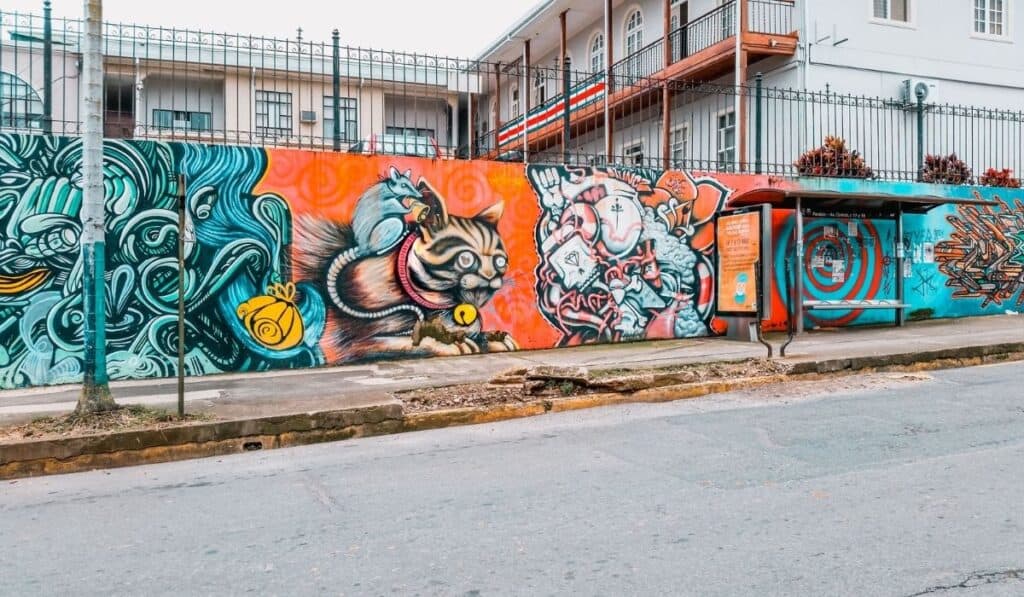
There is a lot of graffiti in the city, and some of it is really beautiful. We love to walk around and search for the most unique street art.
I’ve been meaning to create a graffiti walking tour for Costa Rica Vibes, but I haven’t gotten around to it yet. So, if you find some really amazing graffiti, let us know where it is!
28. Walk Around Multiplaza
Multiplaza is the largest mall in Costa Rica. It is three floors tall and has tons of shopping options. Plus, there is a movie theater in the mall that often plays films in English.
I know, you didn’t come all the way to Costa Rica to walk around a mall and see a movie. But, when you have visited all the museums, on a wet day during rainy season this is not a bad option.
29. Take a Day Trip from San Jose
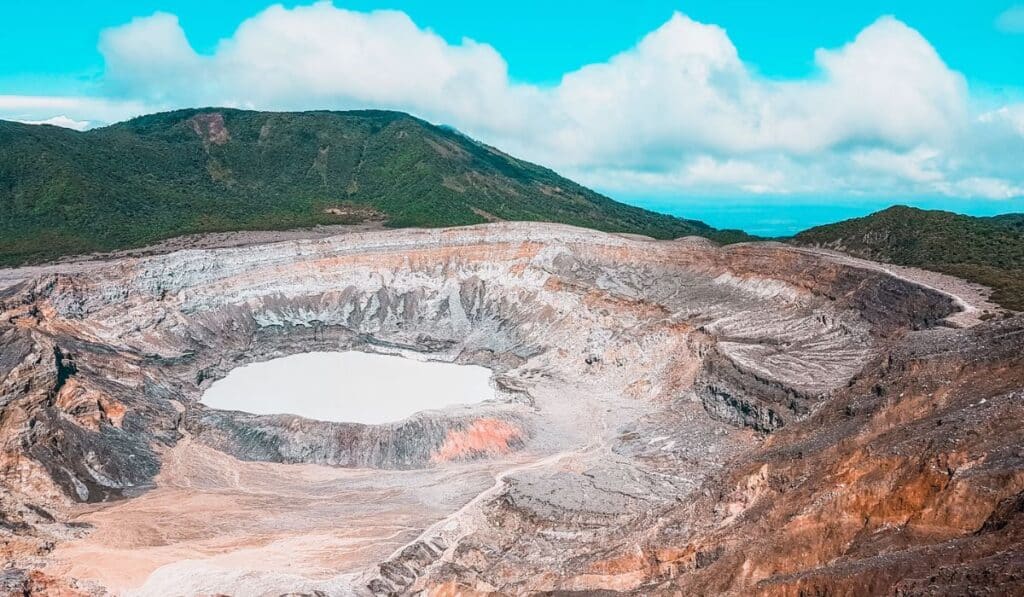
This list consists entirely of things that you can do within downtown San Jose, or very close by. However, the area around San Jose is definitely worth exploring.
This area is referred to as the Central Valley and it is dotted with volcanoes, coffee farms, waterfalls, and more. The nearby cities of Alajuela and Cartago are also interesting to explore.
In Alajuela you can visit Poás Volcano up close, go to La Paz Waterfall Gardens, take one of the many coffee tours, and so much more!
In Cartago you can visit Irazu Volcano, check out the most popular church in Costa Rica, visit a coffee plantation, and more!
From San Jose you can also take longer day trips with transportation to places like Manuel Antonio National Park, the Monteverde Cloud Forest, Tortuga Island, and Arenal Volcano National Park in La Fortuna.
That being said, we also created a complete list of the best day trips that you can take from the San Jose area .
This list includes day tours with transportation, off-the-beaten-path spots, and things you will need a rental car to visit.
Helpful Tips for Visiting San Jose
Here is what you need to know before visiting San Jose.
The San Jose Airport
The Juan Santamaria International Airport is the largest international airport in the country. It is located on the outskirts of San Jose in Alajuela (directly to the west of the city).
From the international airport it is possible to get to downtown San Jose within 20 minutes if there is no traffic.
However, there is always traffic.
During rush hour it could take over an hour or longer.
Transportation
The best way to get around in downtown San Jose is by foot or by official taxi.
Official taxis in Costa Rica are red with a yellow triangle on the drivers and passengers side door. Official taxis coming from the airport are orange with green triangles.
DO NOT take an unofficial taxi. They are known to majorly overcharge people.
There is a public bus system, but it is a bit confusing and I don’t suggest it if you don’t know what you are doing. I still find myself ending up in a different area than I expected sometimes when taking the bus.
As far as rental cars, I do not suggest driving in downtown San Jose.
People drive like crazy.
If you are staying in the downtown area for a few nights after arriving at the airport I suggest taking a taxi or hotel shuttle from the airport to your hotel.
Once you are ready to leave San Jose and explore other areas of the country you can pick up your rental car.
We work exclusively with Adobe Car Rental. They have an office in downtown San Jose and will deliver your car to you for free within 12 miles of their office.
I suggest doing this and having your car delivered on the day you are ready to leave.

Adobe Rent-a-Car
- 10% discount for Costa Rica Vibes readers
- Free second driver
- 0% deductible on Liability Protection Insurance
- Excellent customer service
- New fleet of well-maintained vehicles
If you are looking for a place to stay after landing at the airport, we do not suggest downtown San Jose. Instead, stay in Alajuela near the airport. This will make it easier for you to hit the road to other destinations after.
Our top airport area hotel choices are:
- Courtyard by Marriott
- Fairfield by Marriott
- Trapp Family Country Inn
- Casa Maria Aeropuerto
Budget Friendly
- Alice y Juancito Boutique Hotel
Check out our guide to airport area hotels for more info.
However, if you would like to spend a few days in downtown San Jose, then yes, book a hotel downtown.
Our top hotel choices are:
- Grano de Oro Hotel (high-end)
- BEE Suites Escalante (mid-range)
- Chillout Hostel Barrio Escalante (budget friendly)
Check out our guide to the 21 Best San Jose Hotels for more info
Of all places in Costa Rica, San Jose is typically the place you need to be the most cautious. Violent crimes are very unusual, but petty theft is somewhat common downtown, especially in crowds.
We suggest an anti-theft backpack or purse for here. Also, definitely don’t walk around with your phone, camera, or wallet visible.
If possible, dress like you can blend in. Most people wear jeans or pants and a short sleeve shirt. That seems to be the go-to San Jose uniform.
Also, do not walk alone in empty areas at night.
We have never had anything happen to us, but I know we are lucky. We have had a few friends that have been robbed.
Should You Visit San Jose?
Speaking as people who live in San Jose, the downtown area is not our favorite. We live a little outside of the downtown area and find ourselves rarely going downtown except for a visit to the theater, museums, or good restaurants.
That being said, I always take friends and family downtown when they visit, and they enjoy it for the cultural experience.
It is interesting to see and worth spending a day or two in, but I wouldn’t spend more than 3 days here.
This country is so amazing and filled with great natural attractions. Get out of the city and see the Pacific and Caribbean coast, visit the national parks, and explore the jungle.
Tip: Check out our Destination Guides for info on all the best places to visit throughout the country.
You’ll have the best time!
So, yes, stay in San Jose briefly and then get out to the beautiful nature.
Conclusion: Things to Do in San Jose Costa Rica
And there you have it – 29 delightful experiences to make the most of your time in San José!
Costa Rica’s capital city has so much to offer, and I’m confident that with this guide, you’ll fall in love with its charm.
If you have any questions or need further recommendations for visiting the capital of Costa Rica, don’t hesitate to drop a comment below. I’m here to help! And if you’re keen to discover even more about San José, check out some of our other posts below for deeper dives into this vibrant city.
Happy exploring, and pura vida!
You Might Also Like:
The 32 Best Day Trips from San Jose, Costa Rica
Car rental at san jose airport in costa rica: what to expect, hotels near san jose costa rica airport: 24 best places, san jose costa rica airport (sjo) arrival and departure guide.
Costa Rica Travel Details : What You Need to Know
🚗 Should I rent a car in Costa Rica?
Having a rental car will give you the most flexibility when traveling in Costa Rica. This will also allow you to take fun day trips on your own.
- Save 10% Plus Other Perks with Our Adobe Rental Car Discount
- You might also consider; shared shuttle services or private transfer services
🏄🏽 How can I book things to do?
We find that Viator tends to have the most comprehensive selection of activities with secure booking and good cancellation policies.
🍍 I’m overwhelmed with planning. Can you help?
Of course! I suggest joining our Facebook group for specific questions and head to our Start Here Page to get started planning.
✈️ What is the best way to book a flight?
Usually, we have the best luck finding great prices with Skyscanner . Check for flights to both San Jose Airport (SJO) and Liberia Airport (LIR).
🛏️ What is the best way to book my Costa Rica hotels?
We highly suggest Booking.com for hotel bookings and typically use VRBO for Costa Rica vacation rentals.
🗣️ What is the main language in Costa Rica?
The main language in Costa Rica is Spanish. Most people working in tourism speak at least some English.
💰 What is the currency in Costa Rica?
The currency used in Costa Rica is the Costa Rican colón (CRC). However, the US dollar is widely accepted in most tourist areas
📞 What is the best way to stay connected?
An eSIM from Airalo is the easiest way to get 4G data while traveling in Costa Rica.
🌴 Is Costa Rica safe?
Generally, Costa Rica is considered safe for tourists. However, like any travel destination, it’s best to use caution and be aware of your surroundings.
🛂 Do you need a passport to go to Costa Rica?
Yes, Costa Rica is its own country. You will need a passport to visit.

Hi! We’re Thomas (the German) and Sarah (the US-er)
We met in Virginia, moved to Germany, and since 2016 we have lived in sunny Costa Rica. It was a spontaneous decision to move here, but it was the best decision! Now we spend our days roaming the country to bring you the very best in Costa Rica travel here on Costa Rica Vibes. Sarah is the writer. Thomas is the one keeping it all together. Want the whole crazy story?

Sarah McArthur
Sarah McArthur is the co-founder and main writer of Costa Rica Vibes. She is originally from the United States but has lived in sunny San Jose, Costa Rica since 2016. She has traveled all over the country and now considers herself a self-proclaimed Costa Rica travel expert. Want the whole crazy story?

Shop All The Costa Rica Packing Essentials
Food to Try in Costa Rica
Best Restaurants in San Jose
Nightlife in San Jose
Best Time to Visit
Weather & Climate
Juan Santamaría International Airport Guide
Top Destinations in Costa Rica
Top Resorts in Costa Rica
Best Honeymoon Resorts
Complete Guide to San Jose
Costa Rica's Islands
Day Trips From San Jose
48 Hours in San Jose
Top Things to Do in Costa Rica
Adventurous Things to Do
Best Diving Sites
Best Beaches
Top Things to Do in San Jose
The Top 12 Things to Do in San Jose, Costa Rica
Ever-evolving, Costa Rica’s capital is an exciting place to hit the ground running—or, instead, walking. You can access many historical, cultural, and culinary highlights of San José via walking tours here. See, taste, sip and shop your way around town with these suggestions of 12 things to do in San José.
Shop for Handcrafted Souvenirs and Fresh Food at the Farmers Market
On Saturday mornings, the Feria Verde farmers market is the place to be. In addition to the organic produce and tropical fruits you expect to see at a farmers market, you’ll also find organic coffee, personal care products, apparel, and handcrafted jewelry—all made in Costa Rica. Sip kombucha or organic coffee (the yellow, eco-friendly ceramic cups will lead you to Taza Amarilla if your nose doesn’t discover the aroma of their organic coffee first), shop for one-of-a-kind souvenirs such as a handprinted, eco-friendly tank from Gaia Prints , and sit down to brunch under the tropical tree canopy.
Take a Free Walking Tour
No need to go it alone or spend a single colón (though you should bring some cash for tips and any souvenirs you spot along the way) to discover the best of San José. Carpe Chepe offers a free walking tour , departing from the National Theatre Monday through Saturday. The Tico (local Costa Rican) guides impart essential historical and cultural context sprinkled with humor while you walk around and see some of the sites.
Try "Forest Bathing"
Leave the buzz of the city behind and immerse yourself in the sounds and scents of the Costa Rican forest. Sentir Natural offers guided forest bathing experiences at the nature reserve on the University of Peace campus on the outskirts of San José and other locations, including urban parks, on request. This activity is less about physical exercise and more about internal reflection and connection with the natural environment. A guide will lead you through a series of “invitations”—activities intended to help you “bathe” in the beauty and healing of the forest.
Take an Art Tour
Once per month, San José plays host to Art City Tour . GAM Cultural creates recommended routes, a hop-on-hop-off bus is provided, and entrance into participating venues, including museums, is free. Each month offers something new and inspiring, such as live and wearable art seen in a Tienda Eñe fashion show that used the street like a catwalk.
Wander the Mercado Central
You could spend an entire afternoon walking through San José’s Mercado Central (Central Market). There are many sodas (informal, local restaurants) and shops inside, so bring an empty shopping bag and an empty stomach. Pick up some souvenirs, herbal remedies at Hierbas La Favorita, or fresh flowers. Sample fresh queso at the Tramo Santa Cruz stall. And enjoy ceviche alongside locals at Marisqueria La Ribera. Save room for a scoop of sorbet at La Sorbetera de Lolo Mora.
Eat Indigenous Food
You don’t have to travel to the rainforest to taste the ancient flavors of Costa Rica’s indigenous cuisine. Sikwa is bringing indigenous recipes to San José with creative, eye-catching, and delicious dishes that utilize traditional staples such as corn, plantains, and ojoche (a tuber), some sent straight to the chef from indigenous communities. The Cocina Ancestral tasting menu is an ideal intro, and the use of locally available ingredients means that the menu changes with the seasons.
Picnic in the Park
Pack a picnic and head for Parque La Sabana, Costa Rica’s largest urban green space covering nearly 180 acres. This is such a popular place amongst Ticas; it’s estimated that around 38,000 people visit the park each week. Park yourself on a bench or blanket under the trees, and people watch. When you’re ready to get moving, join a pick-up game on one of the 12 soccer fields or take a lap around the footpath with a stop at Museo de Arte Costarricense. The museum was once an air terminal and control tower for the city’s first airport and is now home to the most extensive collection of Costa Rican art.
Buy Gifts Made in Costa Rica
Touristic destinations are often saturated with generic souvenirs. But artisan-made gifts can be found in San José if you know where to look. Tienda Eñe is a great place to browse locally-designed apparel, shoes, accessories, and home goods. About 98 percent of the products here are made in Costa Rica. Another option is La Estanteria , where you’ll find a selection of packaged snacks, drinks, and souvenirs—all made in Costa Rica. This space also hosts workshops, performances, and events, so you can grab a bottle of local hot sauce and a bag of coffee to take home as gifts, grab a bottle of local kombucha or craft beer to drink on the back patio, then try your hand at traditional mask painting or attend an open mic night. Keep in mind, some events at La Estanteria may be Spanish only, so it may be tricky to understand everything, but it’s a fun place to mingle with locals, so don’t let the language barrier stop you.
Take a Tour of the National Theatre
Constructed in the 1800s in a Neo-Classical style and modeled after the Paris Opera House, this is one of San José’s most iconic and beloved buildings. The interior holds impressive carvings, murals—including the “Allegory of Coffee and Banana,” and history. The theatre is still used today for events and performances, including the National Symphonic Orchestra. The guided tour is playful, and a bit hokey (insider tip: if you speak Spanish, join the Spanish tour instead. The actor-guides are native speakers, so the Spanish tour flows more naturally), but the architecture and stories behind this site are intriguing.
Cheers the Craft Beers
The craft beer scene in San José is growing. Take a brewery tour at Cerveceria Calle Cimarrona, or pair one of their brews with dinner at their restaurant, Apotecario. If you want to make a night of it, book a craft beer crawl and drink your way around San José with a local beer expert.
Eat Comida Tipica
Whether or not you have a chance to eat in a local home, you can still experience a homecooked meal. La Esquinita de JM serves foods you’d find in a traditional Costa Rican home, including olla de carne (beef stew) and arroz de la abuela (grandmother’s rice), and sets the scene with the rustic decor to match. Coffee is served Costa Rican style here: through a chorreador (a wooden coffee contraption with a cloth filter) and into tin cups. Alternatively, join a guided culinary tour offered by Carpe Chepe or Urban Adventures and taste around town with the added insight of a local.
Go On a Coffee Crawl
TripSavvy / Kathleen Messmer
You may notice coffee berries dangling over the sidewalk when you’re walking around the city, especially in the areas around Barrio Escalanté. These plants in this particular area are no longer harvested but exist as a reminder of the role coffee exports have played in Costa Rica’s development. San José is located in the Central Valley, one of the main coffee-growing regions of the country. Join a guided coffee tour for a chance to visit multiple cafes, dive into the history of this vital crop, learn about various brewing methods, and smell and sip a few samples. If you don’t have time for a full tour, stop by La Mancha, where you can have your coffee prepared in any one of the contraptions displayed behind the counter, including Kyoto-style drip, chorreador, and vandola. If you aren’t sure where to start, ask the owner, Alberto. He has a wealth of knowledge—historical and modern—about coffee and can steer you in the right direction.
Your Trip to Costa Rica: The Complete Guide
The Best 15 Restaurants in San Jose
48 Hours in San José: The Ultimate Itinerary
The Top 11 Day Trips From San José
The Top 19 Things to Do in Costa Rica
San José: A Visitor's Guide to Costa Rica's Capital
What to Do on a Budget in San José, Costa Rica
The Top 10 Destinations to Visit in Costa Rica
Nightlife in San José: Best Bars, Clubs, & More
Our Favorite 15 Rainy Day Activities in Los Angeles
72 Hours in Los Cabos: The Ultimate Itinerary
Your Trip to San Diego: The Complete Guide
10 Foods to Try in Costa Rica
The Best Staycation in Every State
One Week in Argentina: The Ultimate Itinerary
The Best Small Town in Every State

Historical Sites and Legends of Costa Rica
Is there anything more captivating than walking through a fabled ruin surrounded by jungle gardens taking in the sights and stories from long ago? Admittedly, I’m a bit of a history buff, but stories and legends are one significant way to get a deeper understanding of any country’s culture. The following are some of Costa Rica’s top historical sites with enigmatic legends to boot.
National Theater, San Jose
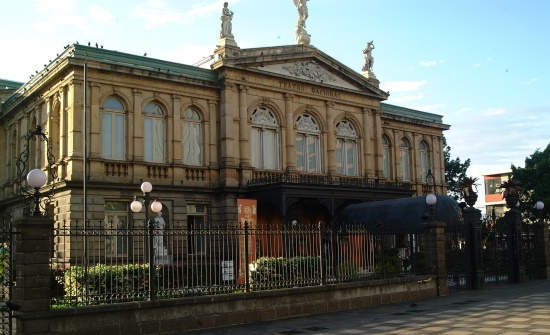
Open to the public in 1897, The National Theater, or the Teatro Nacional, is Costa Rica’s architectural gem located in the heart of the capital city of San Jose . It is situated on the south end of the well-known pedestrian plaza, Plaza de la Cultura. The National Theater was inspired by the neoclassical style of the Paris Opera House. The columned neoclassical exterior features a statue of Beethoven and Calderón de la Barca, a known 17th-century Spanish dramatist. The interior of the theater is lavishly adorned with a marble lobby and an auditorium decorated with 19th-century paintings portraying daily life.
Ujarras Ruins, Cartago
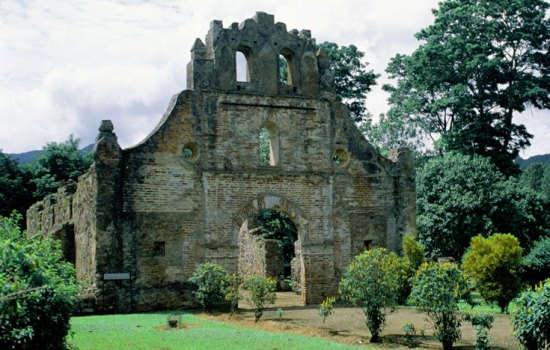
Built between 1575 and 1580 in the small town of Ujarras, the Ujarras Ruines is one of the only Spanish colonial sites in Costa Rica. The site contains the ruins of one of the oldest churches in the country, Iglesia de Nuestra Senora de la Limpia Concepcion. The church is surrounded by beautiful well-manicured gardens. According to legend, a local indigenous Huetar fisherman found a box with a Virgin Mary image on it. However, they were unable to move it from the location in which they found it. They then built the church on the site. It is believed that the spirit of the Virgin Mary warned locals of a devastating flood and performed miracles for the local villages. The entrance to the ruins is free.
Orosi Church & Religious Art Museum, Cartago
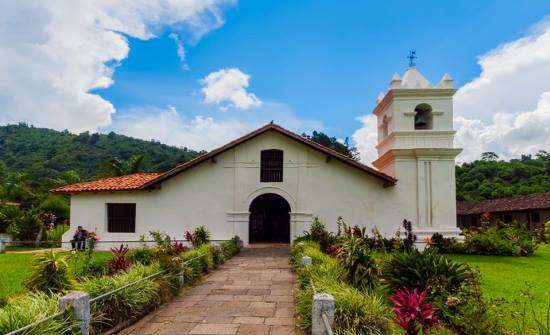
Located in the Orosi River Valley, the Orosi Church is the oldest still-functioning church in Costa Rica. Constructed in 1743 in the colonial era by Franciscan monks, Orosi Church was built with adobe walls that have withstood some significant earthquakes. The baroque interior is decorated with painted and carved wooden sculptures and altarpieces. There is also a religious art museum with a collection of artifacts and paintings outside the church.
A unique feature of the Orosi Church is that the temple door opens to the rising sun – a rarity among churches, which typically look West. The legend says that when the Franciscans came to Orosi with the Talamanca Indians, they carried a picture of Saint Joseph on their shoulders while ringing a silver bell. When they reached the boiling hot spring in the mountains, the bell did not ring. So, they built the church there at once. After construction, the church was destroyed by flooding several times. After many prayers, the Franciscans finally understood that the church could not be constructed in its usual manner because Saint Joseph wanted to face Talamanca.
Basilica of Our Lady of the Angels, Cartago
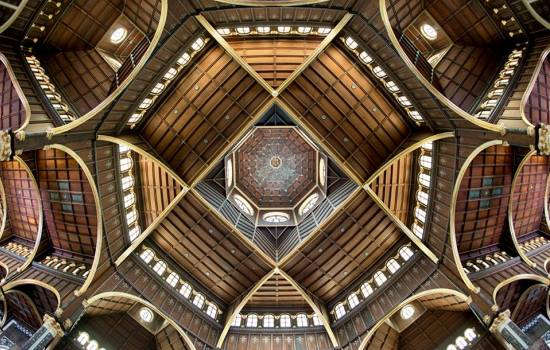
The legend of the Basilica of Our Lady of the Angels is that a small girl found a little statue on a rock and brought it home. The following morning, she discovered that the statue was not where she left it, but back on the rock. She then brought it to the priest and he locked the statue in a little box. Again, the following morning, the statue was back at the rock. The site of the original church was destroyed by earthquakes many times, leading the reconstruction of the church to be moved to where the statue was found. Once the church was moved, they were finally able to complete construction. The original statue is stored in a gold shell inside the basilica. The Virgin of the Angels is celebrated as the official patron of Costa Rica.
La Casona, Guanacaste
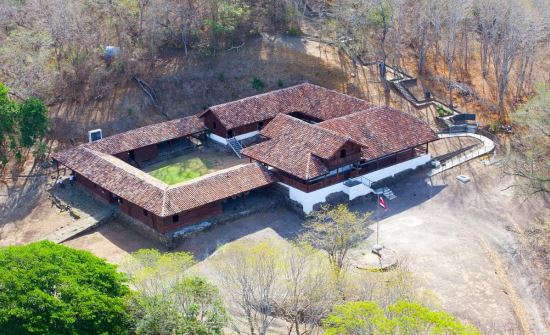
The old hacienda building of La Casona is located within Santa Rosa National Park in the Guanacaste province of Costa Rica. It was at La Casona that the Battle of Santa Rosa took place. This important battle took place on March 20, 1856, when the Costa Ricans battled William Walker, an American soldier, and soon-to-be Nicaraguan president, looking to conquer Costa Rica. William Walker and his men were forced to flee back to Nicaragua. Today, La Casona is a celebrated representation of independence for Costa Rica.
Other sites of historical significance within Santa Rosa National Park include the Stone Pens and the Monument to the Heroes.
Guayabo National Monument, Cartago
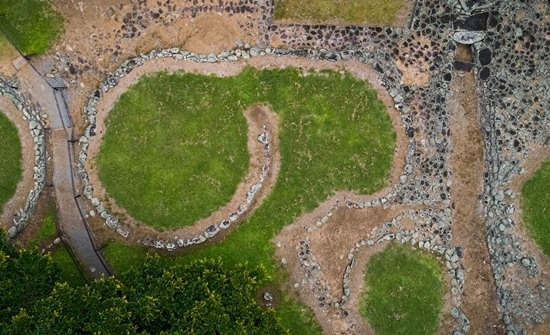
“The mysterious and ancient city of Guayabo isn’t just a beautiful sight to see – it has also been recognized by the United States Association of Civil Engineers for the engineering achievements and techniques used by its first inhabitants.” — The Costa Rica Tourism Board
Situated on the forested slopes of Turrialba Volcano, Guayabo National Monument is one of Costa Rica’s greatest archaeological sites. These ruins make up the largest pre-Columbian city known in the country. Believed to be inhabited from 1000 BC to 1400 AD, this ancient civilization is thought to have been inhabited by roughly 10,000 people.
In the late 1800s, Guayabo was discovered and believed to be an ancient cemetery. In 1968, the archaeologist Carlos Aguilar Piedra uncovered stone foundations. He worked to unclear the thick surrounding jungle from the site to find how large the site was. He discovered three aqueducts, 43 stone foundations, two large roadways, many small paths, and tombstones.
The city was undocumented by early explorers and the reasons for its fall are still a mystery.
Santiago Apostol Parish Ruins, Cartago
The Santiago Apostol Parish Ruins houses several churches that existed as early as 1575. The original building was damaged by an earthquake in 1630. Its remains were destroyed in 1656. The newer two chapels and church were destroyed by another earthquake in 1718! What remains is the cultural heritage site that Santiago Apostol Parish is today. The legend? Some of the earliest settlers of Cartago were two brothers: one was a priest and the other, a well-liked man. They both fell in love with the same woman, but she chose the well-liked brother. In jealousy, the priest kills his brother. In his guilt, he built a church to atone for his sins. A year following the church’s construction, an earthquake destroyed the church. Some say the number of earthquakes that Cartago has endured is due to a curse. Construction of the churches came to a close in 1910, but the ruins continue to attract tourists.
Ready to explore the historical sites of Costa Rica? Browse our vacation packages or talk to a Costa Rica Expert to get started!
Related Article:
- In 2024, Costa Rica Takes Center Stage
- Costa Rica Rainy Season Guide: Why & When To Visit
- How To Get Around Costa Rica: Cars, Flights, Boat & More
- Costa Rica Currency: Money, Tipping, & Exchanging on Vacation
- Best Time to Visit Costa Rica: What to Expect Month by Month
The Latest:
- How to Get to the Osa Peninsula Rainforest
- 9 Top Tips For Easier Travel With Little Kids in Costa Rica
- Adventure & Romance Tour Pairings For A Well-Balanced Honeymoon
- How to See The Most Wildlife in Costa Rica
- 8 Costa Rica Natural Mysteries You Have to See to Believe
- 10 Best Costa Rica Beaches For Families
- Worth-It Costa Rica Family Tours for Big & Little Kids
- The Complete Guide to Sloths in Costa Rica
- BEST Family Resorts in Costa Rica
- 11 Top Costa Rica Honeymoon Bungalows & Suites
- 11 Best Costa Rica Honeymoon Resorts & Hotels
Explore by Interest:
- Adventure Travel
- Attractions
- Best of Costa Rica
- Destinations
- Food + Flavors
- Health & Wellness
- Hotel Reviews
- Industry Interviews
- Luxury Travel
- National Park Guides
- Seasonal Guides
- Tips + Tricks
- Travel Inspiration
- Travelogues
- Uncategorized
- Wildlife Guides
YOU DESERVE A VACATION PLANNED BY EXPERTS.
Us headquarters, costa rica office.
Barrio La California, Calles 27 & 29, Ave 2, Ed #2798 Oficina #8 San Jose, Costa Rica 10104
READ OUR REVIEWS

- DESTINATIONS
- THINGS TO DO
- PLAN YOUR TRIP
Privacy Overview
This is a necessary category.
7 best things to do in San José, Costa Rica

Apr 7, 2023 • 6 min read
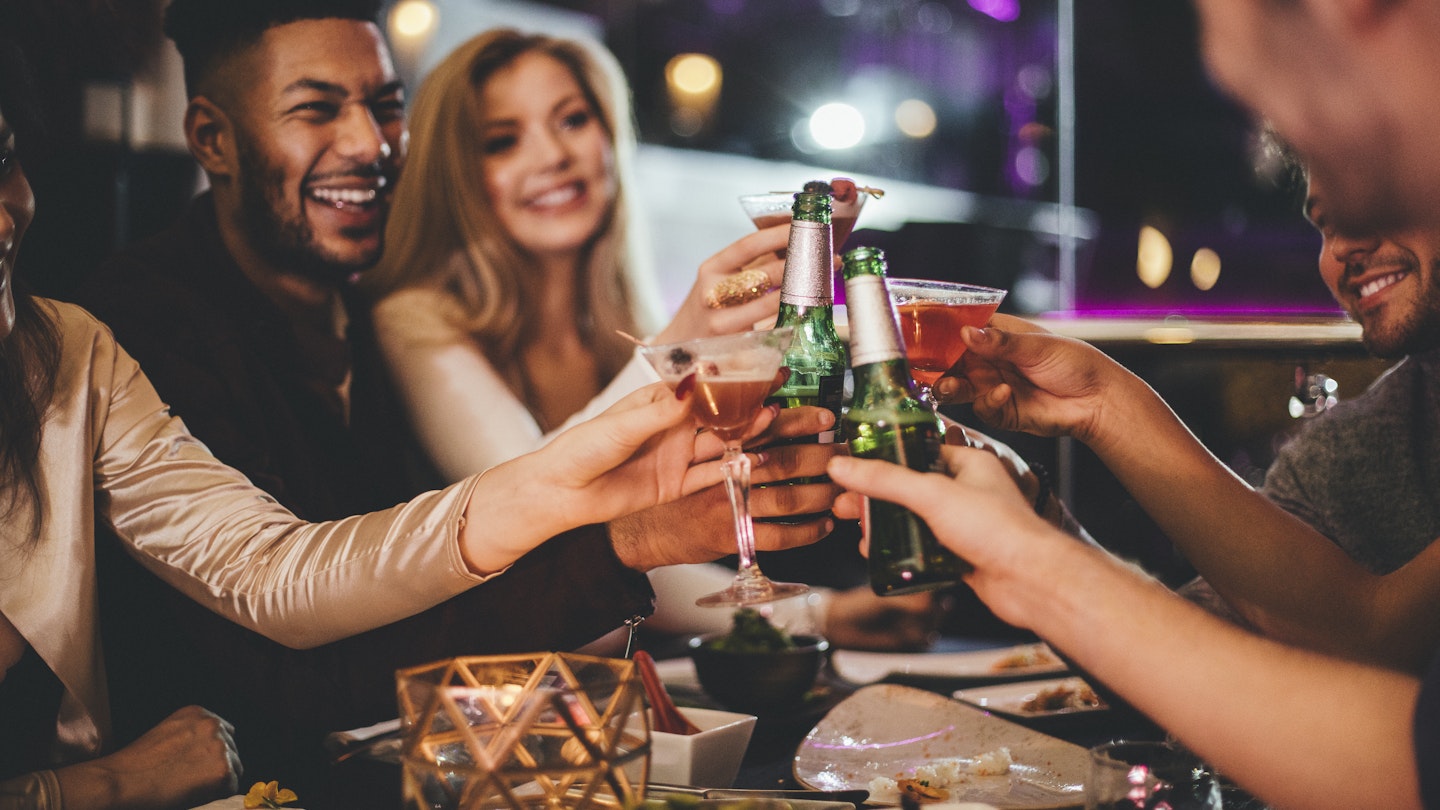
There's a thriving music scene and incredible restaurants just waiting to be discovered in San José, Costa Rica © Getty Images
San José is a busy and confusing city, and many travelers depart before they really get a feel for the place.
After all, Costa Rica is famous for beaches, cloud forests and sloths, not gridlock traffic and concrete towers. Most visitors think of the Costa Rican capital as nothing but a necessary stopover.
But San José has a lot to offer passing tourists, as long as they know where to look. There’s no better place in the country for dining options and cultural venues, and nearly every block boasts historical significance. The weather is near-perfect year-round, and it’s become a global destination for entrepreneurs and medical tourists.
This city rewards a patient approach, but if you only have a couple of days and want to see San José at its best, certain experiences take priority.
1. Explore the museums
The best museums in Costa Rica are all clustered in downtown San José, and it’s easy to walk from one to the other in a single day. Each museum represents a different cross-section of Tico life and you can explore them in roughly historical order.
Start at the Museo de Jade , a massive modernist structure with several floors of exhibits. You’ll find displays of carved green stone, of course, but also authentic tools and multimedia recreations of pre-Columbian village life.
A perfect companion is the Museo de Oro Precolombino , an underground museum beneath the Plaza de la Cultura , where concrete walls are decked with ancient gold totems. Together, these institutions paint a brilliant portrait of Indigenous life before the arrival of the Conquistadors.
For a more contemporary experience, visit the castle-like Museo Nacional , which houses rotating exhibits on art, history and civic progress. The museum is built into a former barracks, which should intrigue architecture enthusiasts, and you can top off your visit with a walk through the indoor butterfly garden. Outside lies the Plaza de la Democracía , which holds regular outdoor concerts.

2. Watch a football match
Major football matches are impossible to escape in Costa Rica, even if you wanted to. Sports bars are jammed with fans. The play-by-play can be heard blaring out from every taxi radio. Every television in every home is tuned to the game. With each hometown goal, the city quakes with excitement.
But nothing beats the live event. Major games are held in the Estadio Nacional , where you can watch a face-off between regional rivals or even Costa Rica’s national team, “La Sele,” versus international visitors. Tickets are often competitive, but you can reserve them online or visit the stadium kiosk in La Sabana . The state-of-the-art stadium has seats for 35,000 spectators and also holds big-name concerts.
3. Catch a live band
San José had a feisty music scene, and Tico bands are always jockeying for local stages. You can find live performances almost every night leading into the weekend, especially at a handful of our favorite venues. El Observatorio draws big crowds to its colorful, high-energy auditorium. Amon Solar looks like a colonial mansion and it has become a favorite destination for blues, jazz and reggae. StarView C.R. feels like a grunge bar from the 1990s and many will find the atmosphere nostalgic, but it’s actually one of the newest venues in town.
There are many other stages hidden among San José’s side streets, and you can track down a DJ any Friday or Saturday. Just follow the crowds – and vibrations.
Planning tip: Cabs are your friend – nights get dark in San José and the rainy season really hits its stride after dark. If you’re out late and have trouble hailing a taxi, bar and restaurant staff are usually happy to help.
4. Sample some gourmet food
Costa Rica is famous for hardy meals, fresh fruit and rich coffee. But the epicurean offerings in San José are more diverse than in all other cantons combined. Here you’ll find the flavors of China and India, Lebanon and Colombia – you could eat out every night for months and still find something novel to try.
But it’s not just the range of cuisines – local restaurateurs have upped their game in recent years, especially in the trendy neighborhood of Barrio Escalante . Here you can browse block after block of cafes, gastropubs and gourmet bistros. This is also a great district for accommodations, making it easy to walk from hotel to dining room to bar in a few blissful minutes.
For an introductory sampler, visit Calle 33 or Jardín de Lolita , two dining halls packed with eclectic eateries. Here you can try ramen, burgers or gelato and sit anywhere in the communal compound. From there, taste any number of cervezas artesanales (craft beers) at low-lit Wilk.cr or the Bavarian-style Costa Rica Beer Factory .
5. Take in the nightlife
The nightlife in San José is loud, boozy and keeps the party going till well past midnight. Downtown’s biggest hot spot is Barrio California, an intersection of several different sports bars and nightclubs that throb with activity all weekend long. This nightlife can take the form of a raging dance party at La Destileria , munchies and a few beers at El Cuartel de la Boca del Monte , or an indie film at Cine Magaly followed by cocktails at Kubrick Gastro Bar next door.
You can also venture out to the college district of San Pedro, where numerous dance clubs flank the campus of the Universidad de Costa Rica. The most famous destination is Calle de la Amargura (Bitterness Street) where several popular college hangouts stand shoulder-to-shoulder.
Planning tip: Mastering the art of zarpe. “Zarpe” means “last drink” or “nightcap” in Tico Spanish, and celebrants will often use the word to taper off the night. But it’s usually a joke – some folks will have several zarpes before the night is done.

6. Shop til you drop
San José is the commercial epicenter of Costa Rica and Ticos travel from all across the country to stroll the malls and buy specialty goods. For travelers staying downtown, Avenida Central is a classic point to begin your journey. This kilometer-long pedestrian walkway is lined with stores and scores of merchants hawking their wares in the street. In the middle of it all is the Mercado Central , an indoor bazaar that has drawn customers into its labyrinth of stalls since 1880.
Detour: For a more decadent experience, take a cab to Avenida Escazú , a pristine multi-use development in the nearby suburbs. Here you’ll find luxury shops and refined restaurants, all among glittering high rises that look like they were built yesterday. This area is remarkably walkable, and you’ll find some nifty local businesses among the usual franchises.
7. Witness wildlife in the city
It may not be within walking distance of the city center but it's worth taking take a cab or bus to the Refugio Animal de Costa Rica , an institution for injured animals on the edge of Escazú. It gives an excellent insight into the Costa Rican mindset when it comes to the importance of the natural world without having to trek into the rainforest.
Private tours are led by knowledgeable guides, and the on-site species represent the nation’s spectacular biodiversity.
Explore related stories

May 9, 2024 • 9 min read
Four New York City-based Lonely Planet staff members share their favorite nearby vacation spots.
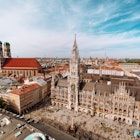
May 8, 2024 • 6 min read
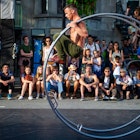
May 7, 2024 • 8 min read
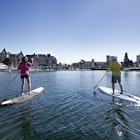
May 8, 2024 • 11 min read
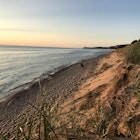
May 9, 2024 • 6 min read
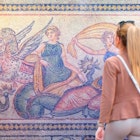
May 9, 2024 • 5 min read
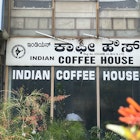
May 9, 2024 • 14 min read

Two Weeks in Costa Rica
Travel and Moving Blog
How to Spend 1 or 2 Days in San Jose, Costa Rica
- Jenn and Matt
- Destinations , Practical Travel
109 Comments
Last Updated: March 15, 2021
San Jose, the capital city of Costa Rica, is filled with rich history and culture. Not only that, but it has a hip urban vibe and an array of restaurants and bars that you won’t find anywhere else in the country. Despite all that this buzzing metropolis has to offer, it is often overlooked by travelers because it can seem hectic and intimidating. Most arriving at the international airport pass in and out as quickly as possible, en route to the country’s beautiful beaches and tropical rainforests. We too used to be overwhelmed by the congested streets and sprawling city blocks. But after visiting more regularly, we now see the city in a new light. In this post, we share some of San Jose’s best attractions, restaurants, and hotels to make your one or two days memorable.
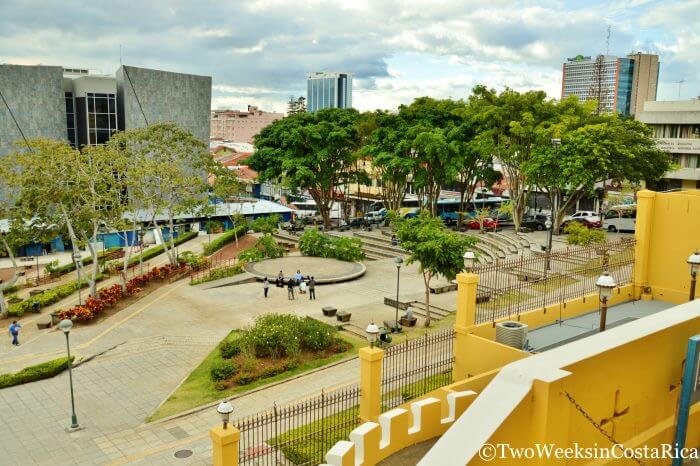
Orientation
San Jose appears to stretch in every direction with its colorful rooftops, scattered high rises, and green patches of parks. But like most cities, there are certain spots that have a concentration of attractions. In San Jose, one of those places is Avenida Central (Central Avenue). This is one of the most accessible areas of the city. Here, it is easy to walk between the plethora of museums, parks, outdoor plazas, shops, and restaurants.
In the barrios (neighborhoods) surrounding Avenida Central, you’ll find a diverse urban culture similar to what you’d find in any city in the world. A mix of business-people, hipsters, young professionals, artists, and students can be seen along the area’s busy sidewalks.
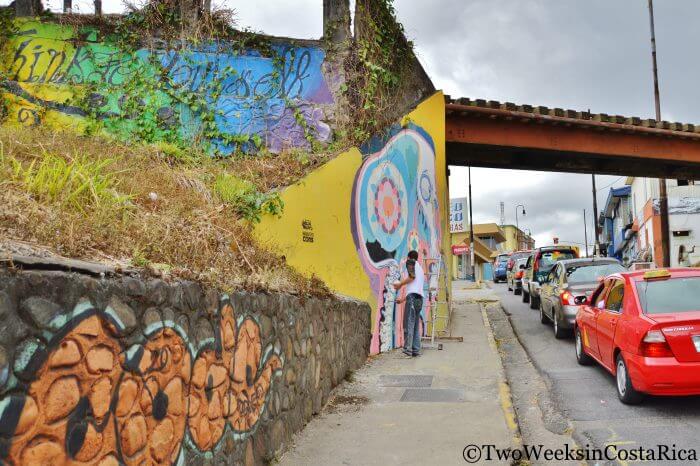
Tip: When exploring downtown San Jose’s vibrant streets, be sure to bring a light jacket or sweater for early mornings and evenings. Because of San Jose’s elevation (about 3,800 feet) and the winds that blow through the valley, temperatures can feel a bit cool for the tropics (65-75˚F/18-24˚C).
Hotels in Downtown San Jose
Finding a hotel within walking distance to Avenida Central will make visiting the city’s attractions a lot more enjoyable. This way, you can leave the car behind and explore on foot without the hassles of traffic and parking. There are many hotels located right on or just a few blocks away from Avenida Central.
Hotel Aranjuez
One good option is Hotel Aranjuez . This hotel was in the ideal location for us on one of our visits to San Jose. It’s slightly outside the center of town, far enough out to be nice and quiet. But it’s still only a 10-15 minute walk to the sights. The hotel is located in a historic building with high ceilings, original wood finishes, and authentic, Costa Rican decor.
In addition to the quiet location, other things we liked were the availability of parking and huge breakfast buffet, which totally lived up to expectations.
Interestingly, Hotel Aranjuez is actually named after the barrio that it is in. This neighborhood once hosted the country’s first electric power plant. This gave San Jose the distinction of being the first city in Latin America, and just the third city in the world, to have electricity.
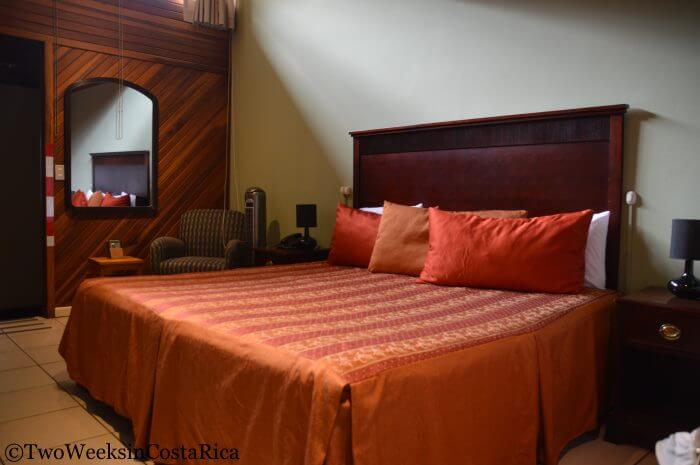
Gran Hotel Costa Rica
Another hotel that might appeal to history enthusiasts is the Gran Hotel Costa Rica . The Gran Hotel is an important building, dating back to the 1930s. Its construction was ordered by the Costa Rican Congress to fill the need for a first class hotel in the city.
The hotel sits right across from the National Theater along the busy Plaza de la Cultura. It has hosted diplomats and celebrities over the years. In 1963, John F. Kennedy stayed here during his visit to Costa Rica.
Recently, the Hilton chain purchased it and underwent a full renovation. During our recent stay, we really enjoyed the modern amenities alongside the historical charm.
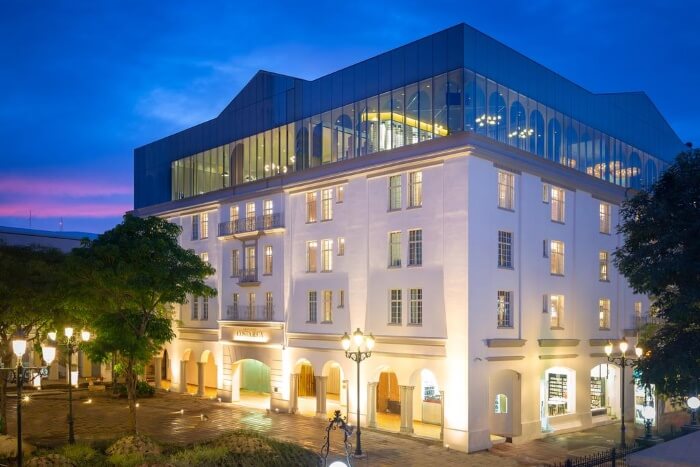
Safety Tip: Like any city in the world, San Jose has rough areas that you’ll want to avoid. In the areas we have visited near downtown San Jose, though, we have felt very safe walking around as there are plenty of people out and about. We don’t venture out after dark too much and recommend grabbing a taxi if you feel at all uneasy. Cabs and Ubers are cheap and plentiful. For more tips, read our post Safety Tips for Your Next Trip to Costa Rica .
Attractions in Downtown San Jose
The main attraction for tourists visiting San Jose are the museums. If you only have a limited amount of time, we recommend the National Museum and Pre-Columbian Gold Museum .
What we like most about the National Museum ($11) is that you learn a little about a broad range of topics related to Costa Rica’s history. San Jose has several museums that go into great detail about very specific topics, but the National Museum gives a good taste of Costa Rica’s overall history.
Displays of pre-Columbian artifacts like stone spheres, carved sculptures, pottery remnants, jewelry made from gold and jade, and even a butterfly garden are part of the experience. For those interested in Costa Rica’s famed abolishment of the military in 1949, this museum is housed in the historic Bellavista Fort. There are exhibits explaining the fort’s significance.
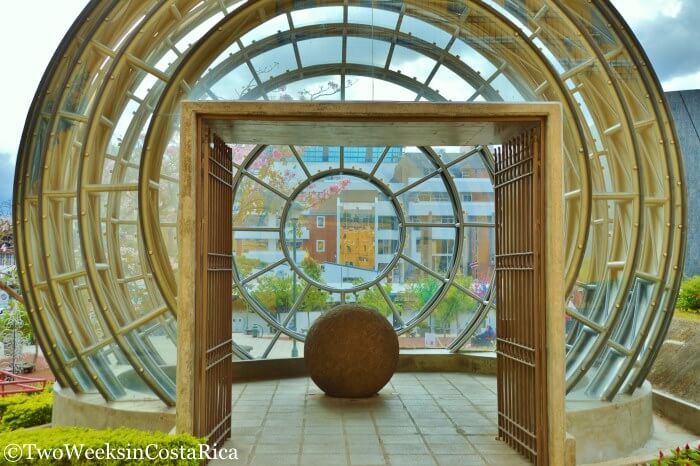
The Pre-Columbian Gold Museum ($14) is a nice supplement to the National Museum and only a short ten minute walk away.
Inside the Gold Museum, you can stroll through several floors of gold artifacts created by indigenous people that date back to AD 0. Like the National Museum, displays and models of historical reenactments are set up in chronological order so it’s easy to learn about how indigenous cultures changed over time.
One thing that we really like about the Gold Museum is the video, which breaks up the exhibits nicely and gives a great overview of the history.
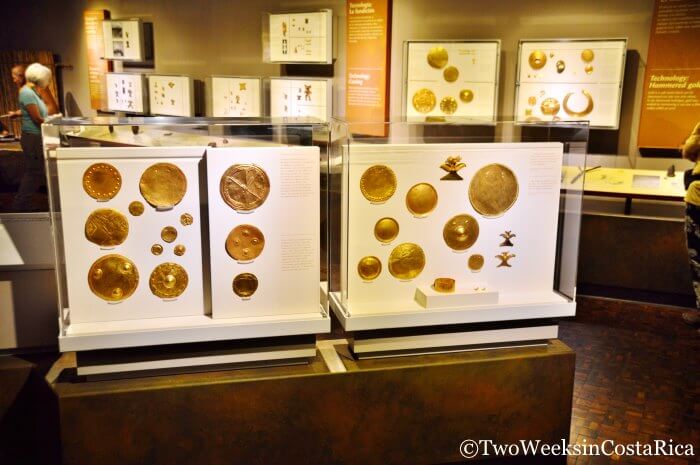
Two other museums nearby are the Jade Museum , which has a massive collection of pre-Columbian jade artifacts, and the Museum of Contemporary Art and Design . Both are within walking distance to the two museums discussed above.
The National Theater
The National Theater ($10) is another historical site that you won’t want to miss. The opulent building was constructed between 1891 and 1897, but the beautifully decorated rooms and stage are still used for performances today.
The architecture and decor of the theater is a mishmash of European influences. It includes marble sculptures as well as wall and ceiling murals from both French and Italian artists.
The Theater does free tours of the building so that you can learn about the history and see all the art work. Tours are done by a group of actors who dress up in period attire from the 1890s. They will take you around to show you some cool secrets and insights about the building that you wouldn’t have otherwise picked up on. One example is the ballroom’s mechanical floor that can be raised or lowered for events.
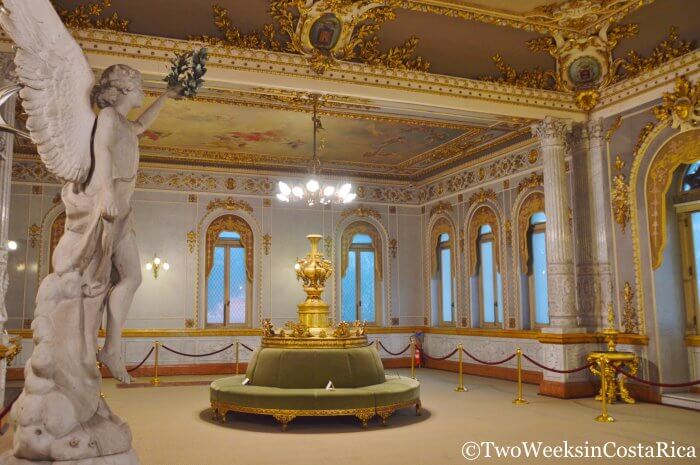
Markets and Shops
Downtown San Jose is also a great place to go shopping, especially for souvenirs.
The National Artisans Market has lots of your more typical souvenirs like T-shirts, coffee, mugs, etc., but there are also some vendors selling handmade items. This market is now in a new, more spacious location on Avenida 6 between Calle 5 and 7.
For a more authentic experience, check out Mercado Central . This sprawling Central Market has hundreds of shops, stalls, and local restaurants spread out along the many corridors. Here, you will brush shoulders with locals who come to do their shopping.
Mercado Central has almost everything you could imagine, from spices and medicinal herbs to flowers to souvenirs and rich Costa Rican coffee. Located in the heart of downtown, taking up a block on Avenida 1 and Avenida Central at Calle 6.
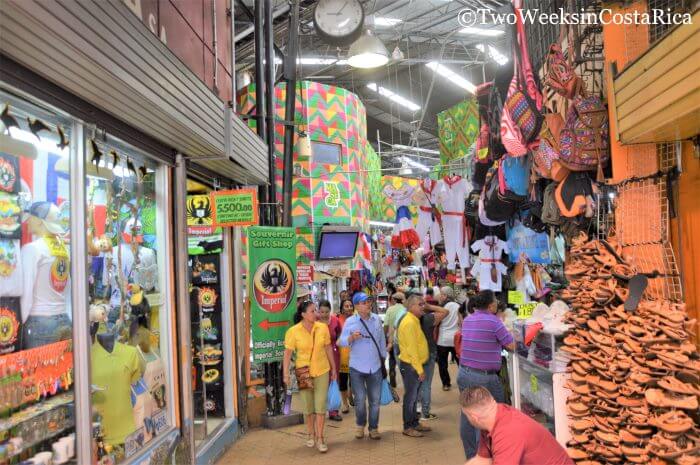
For one-of-a-kind souvenirs, head to Galeria Namu . This shop has an impressive assortment of fair trade handicrafts from different indigenous groups throughout Costa Rica and the rest of Latin America. We saw woven baskets from groups we had visited in Panama, painted masks from Costa Rica’s Boruca, and much more. The store is located four blocks north of the pre-Columbian Gold Museum on Avenida 7.
Restaurants
Something about San Jose that really impresses us are the selection of great restaurants. This brings us back to when we lived in Boston, where we could walk just a few blocks down the street and have our choice of food and drink from around the globe.
Whenever we have a special occasion to celebrate, we head to La Terrasse . This cozy French restaurant is tucked away in a quieter neighborhood (near Hotel Aranjuez) and has served us some of our most memorable meals, ever. The chef, Patricia Richer, is a master at her craft and her husband Gerald is a wonderful host.
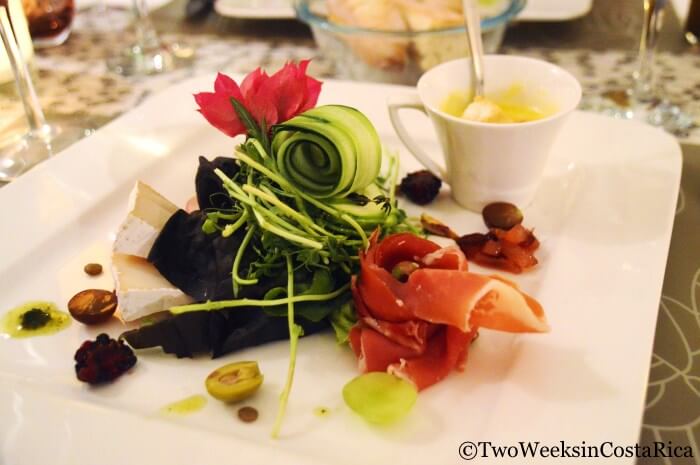
For something more casual, Café de los Deseos , just down the street from La Terrasse, is a wonderful spot. This living-room-style pub had a chill atmosphere and several choices for local craft beer (rare in Costa Rica). Watching the young professionals grab burgers, pizza, and small plates after work made us jealous enough to come back the next night for dinner.
Stiefel Pub is another highly recommended place to find craft beer in San Jose. This is a true pub that feels like a bar. They serve their own beer and have a chalkboard full of choices from other Costa Rican brewers.
For lunch, near the Pre-Columbian Gold Museum and National Theater, Café Rojo is a great spot. This cute restaurant is inside a typical Barrio Amon wooden house down the street from Galeria Namu (on Ave. 7 near Calle 3 and Hostel Pangea). They serve up Vietnamese-inspired food and have strong coffee served French Press-style if you’re in need of a pick-me-up.
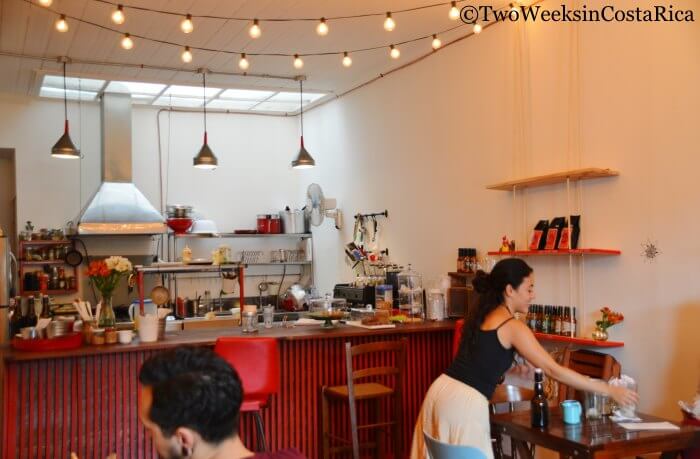
Overall, San Jose has really surprised us over the years. Although intimidating at first, the downtown is a destination in itself and shouldn’t be overlooked. From the modern museums and gourmet restaurants to the parks and outdoor spaces, San Jose offers a glimpse into urban life in Costa Rica. Most Ticos, in fact, live in the San Jose metro area so if you’re looking to explore the local culture, it’s a must. Of course, San Jose isn’t the tropical rainforest or misty cloud forest, which draws all the crowds, but if you have a day or two to explore, it’s definitely worth your time.
Have you visited San Jose? What did you think?
Some of the links in this post are affiliate links. If you book a hotel using one of the links, we receive a small commission at no extra cost to you. Read our Privacy Policy for more information.
Looking for more information to plan your trip to Costa Rica? Check out these posts:
Costa Rica Itineraries: Whether you’re planning a one-week or two-week trip, we’ve got you covered. Check out our One Week Itinerary and Two Week Itinerary to see the highlights of what Costa Rica has to offer.
Packing for Costa Rica: The Essentials – Learn how to pack for Costa Rica’s many microclimates. Also covers rainy season and travel to remote destinations like Drake Bay and Tortuguero.
Money Matters : Wondering where to exchange money? Read this post for information on currency, exchanging money, and tipping.
Thanks guys, you just reinforced my desire to visit San Jose proper. I’ll have to add that to my list.
It’s definitely worth a stop next time you’re flying in or out of SJO, Bill. Be sure to let us know what you think afterwards.
We’re leaving for the Country this week and this has some excellent, extremely helpful advice!
The French restaurant mentioned is marked as permanently closed in Google Maps
Hi Wayne, Glad our website was helpful with your planning!
Thanks for letting us know about La Terrasse. Looks like they are indeed closed now. We’ll update our post.
Please check out Tango Mar, the resort we stayed at. Heaven. On. Earth! http://tangormar.com
I LIKE your article about San Jose. I live in Heredia and love Costa Rica alot. MY wife is Tica. GO luck with new baby pura vida.
Heredia is a great spot, John. Thanks for checking out our site and for the well wishes. Pura vida!
Do you have another recommendation for a CR map? The only one I have been able to find is the Koplin waterproof map but it is sold out until Feb 2016. I will be in CR next week and need to find a good accurate map for our trip as we will be driving ourselves around. Any suggestions?
Hi Lidia, that map ( the Waterproof Travel Map of Costa Rica ) is definitely the best one that we know of. Even though they are temporarily out of stock, it looks like you could purchase it through a third party on Amazon and hopefully get it in time. We have the Adventure Map by National Geographic, which is also popular, but it is not great. Otherwise, we’d recommend getting GPS through the rental car company or a WiFi stick ( Adobe has them) and using the Waze App on your smartphone, that App works really good here. Hope this helps!
Thanks for sharing! We just returned from CR but generally need an overnight in San Jose on our way in or out of Costa Rica so this is great to help maximize our time there!
Thanks for the tip about cafe rojo. We went there today for lunch – we wouldn’t have found it without your info. Lunch was lovely as was the terrace out the front.
That’s great to hear, Sally. Thanks for letting us know!
Good intro article Thankyou. Would love to book the Hotel Aranjuez for 1 night next February (yes I’m one of those “plan way in advance types”) Booking.com is only open to the end of December for them…..sigh….
We are planning to stay in San Jose for one day/night. Our hotel is near the airport. Is it relatively easy to take the public bus to downtown San Jose and what is the typical cost?
Hi Donna, The public bus is extremely cheap and you can expect to spend around $2 or less to get to downtown San Jose. How easy it is depends on where you’re staying. It’s easier if your hotel is somewhere like downtown Alajuela but not so much from other locations less centrally located. The best thing to do is ask your hotel for help when you get there. If it involves bus transfers or otherwise sounds complicated, we would recommend taking a cab for simplicity. Cabs are pretty affordable here and you’ll get there a lot faster.
hello, my name is Oneida Garcia and I will be traveling to San Jose costa rica within the next few week. I’m from Miami, Florida and we will be staying just for 4 days so can you recommend the best places to go, the best restaurants and of course the cheaper the better…lol. also I was told that Costa Rica has two different beaches the pacific volcano one and the clear carbbean, what will be the beaches from the Caribbean?
Hi Oneida, With 4 days, you should pick only one beach town so that you’re not traveling too much. A good option on the Pacific coast is the Jaco area, which is only 1.5 hrs from SJO airport. The main beach in Jaco is gray sand but there are some very nice beaches nearby like Playa Blanca . Many people find the beaches on the Caribbean Coast to be more beautiful. Take a look at Cahuita and Puerto Viejo de Talamanca . Follow the links we just have for detailed info on each town.
If you have children the San Jose Children’s Museum is great. They have an area with huge building blocks. Trains and Planes that kids can run around in. A pretend child size super market and more. We didnt even get to see it all. My son loved it. He is two years old. Admission was only four dollars for adults and children under a certain height are free. Not sure how tall my son is, but he was free.
Thanks for the info, Todd. We have heard great things about the Children’s Museum and what you said only reaffirms this – thanks! Can’t wait until our son is a little older so we can check it out.
Hi guys, great article. Any bars or dance clubs in san jose you recommend Going with my wife and would like to go out for some drinks and dancing. Will be there over the weekend. p.s. we booked Hotel Aranjuez as per your recommendations.
Hi Richard, We’re not the best people to ask this. When we’ve gone to San Jose, we’ve checked out more chill places like Stiefel Pub or we liked Café de los Deseos (described above), which is actually right near Hotel Aranjuez. There are definitely dance clubs and places with more going on though. Maybe ask at the hotel or Michael Miller might have some ideas- he knows a lot about San Jose. Here’s the link for his book and website . Hope you like Hotel Aranjuez!
Try go to Hoxton, near San Pedro or Los Yoses, Barrio La California (east SJ Downtown) is full of bars, if you are into 80s/new wave go to Area City, You can also try El 13 (hipster-gay bar) if you are feeling risky you can try Calle de la Amargura in San Pedro downtown. If you are into electronic music consider visit Vertigo near Paseo Colón, which has the best sound system in Central America.
Planning our first trip to CR in March 2017 two weeks with two – girls 17-18… So much to see – but want to relax some too. Your suggestions have been great. Just overwhelmed at this point. Booked Flights in and out of SJ but now not sure if changing to Liberia a good idea or do both airports… Accommodations, tours.. Your input would be appreciated!! Thanks L
Hi Leah, San Jose airport is more centrally located, but Liberia is closer to some destinations, it really depends on the things you want to do. I would suggest figuring out which destinations you want to visit first and then figuring out the airport. Our Destinations Summary Guide is a good starting place or our Two Week Itinerary . We also offer trip planning help if you want more customized assistance. There’s more info about our services on our Itinerary Help page. Costa Rica has so many choices, we know it can be overwhelming. Good luck with the planning and let us know if you want any help!
Any advice on what to do with luggage if you are just exploring for the day? We are catching a red eye out, but would love to wander around sans suitcases for the day.
Hi Lisa, That is tough if you’re not staying overnight near by, then of course you could ask your hotel to hold your bags for you. Some of the parking lots in downtown are guarded but it is still a risk. Wish we had a better answer!
Hello! I stumbled across your site and have a question about not only public transportation in SJ, but most of the country. The bus routes online seem a bit hard to navigate and I cannot find any maps (they are all tables). I wanted to take a longer, more chill route through central Costa Rica. Any suggestions?
Hi Erin, We don’t know of any site that has the bus routes mapped out. But this site is in an easier format to understand and is accurate. You really have to have your route already planned out to use it so it would work for getting around San Jose but not so much for figuring out where to go in country. You might want to search other blogs for suggested itineraries for travel through Central America to narrow your search. Some places in Costa Rica that are more easily accessible by bus from San Jose are Jaco, Manuel Antonio, Uvita, Montezuma, and Puerto Viejo and Cahuita on the Caribbean Coast.
Oh-oh-I got a 404 Site Not Found error when I tried to click through to the bus schedule. I will be bussing down from Nicaragua then onto Panama, with a few sidetrips thrown in for good measure. Any recommended (or not recommended) bus companies? I am not looking for fancy, I often end up on chicken busses. Sometimes even with someone else’s kid on my lap. Loving your blog btw-lots of great info. 🙂
Hi Leslie, The link ( http://thebusschedule.com/cr/index.php ) worked for us. Maybe they were doing site maintenance?
All of the bus companies in Costa Rica should be fine, we have never had any problems. Usually, one company is assigned to a route so you don’t have much choice anyway, unless you can find another route that works. We know Tracopa runs south to the Panama border and they are reliable and have direct options that don’t stop as much. Tica Bus is the fastest but they connect only capitals and don’t stop often for your side trips.
taxis are great but i recommend uber as i have been ripped a couple of times by cars but uber is all prepaid and easy.
Thank you for Uber recommendation. You are sooo right!! Uber is a life saver!
just get a sim card at airport use uber for a car and then download WAZE to find your way around !!
Just remember to have an unlocked phone or your sim card won’t work. (Don’t ask how I know this. d-oh!)
How do you get your phone unlocked? How much is it? I have AT&T
Hi Kaamil, If you are under contract, your carrier (AT&T) would have to agree to unlock your phone. Most will not. It’s easier to buy a cheap unlocked phone for your trip or just get an international plan from your current carrier.
Hello, I just booked my flight to Costa Rica! I have never been and will be traveling with my two children (11 and 15). Because of our early departure time on the return flight, I am now going to stay in San Jose for 2-3 nights. I hadn’t considered it before but am warming up to the idea especially after reading the information you provided. How is navigating San Jose when you don’t speak Spanish? My boys and I are going to start watching youtube videos to help us with basics between now and our vacation in July, but our Spanish will be very very basic.
Hi Dalila, A lot of people in Costa Rica, including San Jose, speak English so don’t worry, you will be fine. And even if you get a cab driver or someone who doesn’t, they are used to communicating with tourists. Most visitors come with little to no knowledge of Spanish, but it’s great that you want to learn some! The locals always appreciated our bad Spanish when we visited the country as tourists. You Tube will help and print out this guide we wrote of basic Spanish phrases to bring with you. Hope you and your kids enjoy the city!
Thank you so much! That is reassuring. As a Californian, I always feel self-conscious that my Spanish is not better anyway so our trip will help provide more motivation to learn.
This is awesome! I just found out that I will be able to go to CR in 2 days and this is a wealth of information. I am very appreciative!
Hi, Booked a flight from 3/23 to 3/28/2017; seems on weather.com; it shows that rain will be all week, recommend any activities?
Hi Joe, You should read our Weather post. The extended forecast is never right for Costa Rica so don’t worry about that. It’s the middle of the dry season everywhere except the Caribbean slope so most of the country is seeing little to no rain. Our Weather post has data where you can really see what we mean.
Hey guys! Thanks for all the info. My husband and I are planning a trip in July and staying for 3 nights. Are there any excursion our of San Jose? We wanted to do a zip lining and a tropical forest trip. Do you recommend booking ahead of time through a excursion sites or waiting till we get there? We Found air bnb by the university; is it a safe area? Close to downtown? Thank you again for all the info!
Hi Ania, July is the low season so you probably don’t need to arrange tours much in advance unless you want to. When you’re ready to book, we do know of a really good zip line tour not far from San José that takes you into the rainforest. Just respond to this thread if you would like help with the booking. We had a client go out on this tour recently and they loved it. Hope you and your husband have a great trip!
If the Airbnb is in San Pedro, yes, that is a good area and it’s fairly close to downtown.
Thank you for all the info. We would love to get the contact information to that tour, and also prices if available As far as accommodation, We are also considering the hotel you guys recomenfed. Would the tour be able to pick us up from the hotel? We are not planning on renting a car. Thank you Again. Ania
We are traveling now, but can send you the info about the tour when we are back in the office next week. And, yes, they can provide transportation from San Jose.
I would like the same information please. We will be travelling to San Jose in March 2018 and would like to zipline through the rainforest. Your blog has provided a wealth of information and I really appreciate it. Thanks
Hi Helen, We just sent you an email.
Thanks for the concise and informative piece on San Jose. My gf and I are coming down in the fall to stay for 4 or 5 days at Finca Bellavista – a self sustaining tree house community in the south pacific costal region of Costa Rica. We are flying in and out of San Jose and will probably stay a day or two on the front or back end of out trip. It should prove to be a nice contrast with sleeping in the rainforest! Your article is a great starting point to decide how we spend out time in the city. Thanks so much!
You’re welcome, Charles. We have visited Finca Bellavista before and it is a very interesting place. We think you’ll like it. Hope you and your girlfriend have a great trip!
Wondering what the rough price of an uber from airport to downtown would be? Is this a good option ? I’m exploring how to get there by bus but having a hard time figuring It out … Thanks! Kelly
Hi Kelly, We haven’t used Uber ourselves in San Jose, but from what we’ve heard from people who live there, it’s cheaper than a regular taxi. So definitely a good option and much easier than figuring out the bus. It is quite a distance from the airport to downtown and there is usually traffic so be prepared to spend some money. When we have taken a taxi this route before, it was around $30.
Thanks for the great website. My friend and I have three days in San Jose in between two organised tours. We would love to see Quetzal National Park and Hacienda Wildlife Sanctuary. Is it possible to take a public bus to Quetzal, then Hacienda and back to San Jose in his time frame. Would we be better getting a hire car? Thank you.
Hi Sharon, If you wanted to take the public bus, you could probably do one of those places with three days but not both. There is a bus from San Jose to Los Quetzales National Park and you could stay at one of the simple lodges up on the highway (not possible as a day trip without a car). This bus continues on to the Dominical/Hacienda Baru area. If you hired a driver or rented a car, you would have a lot more flexibility and could probably do both places if you wanted to. With only three days, though, you still might be better off just picking one and enjoying your time there since it is a somewhat long drive.
Forget the GPS from the car rentals. There are plenty of free GPS apps you can use to navigate the country and you don’t even have to worry about signal because you can navigate offline.
Which of the apps would you recommend? Thanks so much !
I used google maps, you just have to download the map when you have connection.
Hello, thanks in advance for the advice. We are travelling to CR for a week in mid September. We like to explore, will have a car, and enjoy walking around the towns, etc. Can you recommend different towns/areas in the country and the number of days to stay in each?
Hi Bill, In September, it is the rainy season on the Pacific slope so many towns are receiving quite a bit of rain at this time. The Caribbean side has different weather, though, and is usually very nice this time of year. So maybe check out Cahuita or Puerto Viejo de Talamanca on the Caribbean. Puerto Viejo de Sarapiqui, the Poas Volcano area, or the popular La Fortuna/Arenal Volcano area would pair well with the Caribbean coast in one week. Follow the links for more detailed information.
Thanks for your information. My last question – is it too noisy to stay in Puerto Viejo. We like staying walking distance to the restaurants & bars, but don’t want a noisy place to stay. Thank you!
The downtown is fairly noisy, but there are some places on quieter side streets like Hotel Boutique Indalo . Playa Cocles is the neighborhood right outside downtown Puerto Viejo. It’s a lot quieter but not too far from the restaurant/bars- a 5 min. drive or 10 min. bike ride.
I was just checking out San Jose Hotels for the trip I have planned in the fall. This was posted in a forum on another site that the Gran Hotel in San Jose is closed. The party had stayed there before and checked late April ’17 dates and stated it is closed.
Hi Kirk, Thanks for the heads up. We just looked into this and it appears that the hotel has been bought by the Hilton. They’re doing renovations and are expected to reopen in September. Will be interesting to see how the remodel goes. Hopefully they will preserve all of the historical aspects.
I am planning a 2 night trip to CR. Since we will be flying into San Jose I would think staying in that area makes sense. However, in addition to exploring the city I am very interested in some type of outdoor adventure, ie zip lining, water rafting, waterfalls. Is there anything close by or any easy to access transportation that we can take?
Hi Daisy, Outdoor activities can be easily arranged out of San Jose. A lot of times they include transport to and from your hotel in San Jose. Some of the options are zip lining, whitewater rafting on the Pacuare River or Sarapiqui River, La Paz Waterfall Gardens, and coffee tours. Braulio Carrillo National Park also isn’t too far for hiking.
Hello! I’m happy I stumbled across your blog because we are planning a trip to CR in about two weeks! We are spending a little time in Nicaragua (Granada) at the beginning of our trip, and then we’re flying into SJO. From there, we’re thinking about taking a directo bus to Manual Antonio and enjoying the hiking/beaches there. We will only have 4 full days in CR before we have to move on, and I’ve been reading about La Fortuna and the Arenal Volcano, so I wanted to ask you, with only 4 days, would you recommend going to Arenal Volcano or M/Antonio if you could only pick one place to visit? Thanks!
Both places are great but if I had to pick one, I’d go with Manuel Antonio because of its beautiful beaches. You can still do adventure activities, hiking, and experience the rainforest in MA too. And if you’ll already be spending time inland in Grenada, it would be nice to see the coast. The bus ride to MA from San José is a lot better as well. We have taken the direct bus from San José to La Fortuna and it took a good chunk of the day.
Hi. Great website! Gf and I will be traveling mid September for 10 days arriving SJO at 300pm and departing LIR. Debating if we should stay near the airport or San Jose. Plan is to wake up and head to La Fortuna so the only exploring we’d do would be a walk and dinner. Thanks.
Hi Nyle, We would stay near the airport since you won’t have much time (see our recommendations for hotels near SJO here ). San Jose is a good drive away and will put you in the wrong direction for leaving for La Fortuna the next day. You could stay in downtown Alajuela if you wanted to do some exploring. This is still really close to the airport and is a cute city with some attractions.
You may be able to moderately entertain yourself for a day here and leave with a fond experience. Nearly the entire city is filthy and full of beggars and criminals. Unless you absolutely have to stay in this city due to business it is highly recommended that you skip it. Fair warning, it would be nearly impossible not to notice the drugs, prostitutes, beggars, thiefs, and low lifes. Please stay in the city for a week prior to disagreeing. I have traveled extensively around the globe, so yes, I am pretty confident that I am not just being spoiled or arrogant.
Any recommendations for shuttle companies to get us from airport to Jaco and then a day trip to and from Jaco to Toucan Ranch and a return trip to airport. Would like to use a shared shuttle to keep costs down but will use a private shuttle if not. There are 3 adults coming March 24-31.
Hi Shari, We will send you an email now.
Great site! This will be my second trip and my husband’s first. We will be travelling to San Jose at the end of January and will have to stick fairly close to the city for appointments- therefore only have time for a couple day trips. I’m a photographer and wondering if you have recommendations on can’t miss spots to photograph? Both natural and urban settings beyond the usual big spots? Thanks in advance! I hope to convince my husband to also move there, haha!
Hi Emily, You could check out Braulio Carrillo National Park for some nature images. This park isn’t too popular but has thick, beautiful rainforest and some interesting features like a river that carries volcanic minerals. Be sure to bring a dry bag for your camera because it rains a lot here. Not sure about urban settings. This might be more something you stumble upon when you get there if you want out of the norm. The Central Market is well known but is a cool place to capture the culture and see the locals out and about doing their shopping. Do some Googling to see if there are any festivals or holidays when you will be there as well (fiestas, desfiles, or feriados).
I see that you stayed in Hotel Aranjuez. We are booked there, but upon double checking, I believe our room is actually in the apartment building rather than in one of the 5 houses (not what we wanted, but probably too late to change as they are booked solid during the time we need). Do you have any experience with or opinion on the apartments?
Hi Coco, We have only stayed in the older parts of the hotel. From what we have heard, the newer parts are nice too but don’t have as much historical charm.
Hi Jenn & Matt, I have to say I read your entire blog, it was interesting with informative information and probably the primary reason for reading it was I am also from Boston, and this will be my second trip to CR.
I am actually considering (planning) to move here and would like to keep in touch when I do. Thank you again, and will be in touch.
Kind Regards,
Hi, We are going to San Hose and then heading to Uvita. Will spend 3 nights in San Hose. Can you recommend any good places for breakfast? We are staying downtown, Calle 17, Case Corte. Also do you recommend we take American dollars or Colones? Thanks! Shahina
Hi Shahina, We have never had to deal with breakfast when in San Jose since it is almost always included at hotels. Most of the places we know near where you will be aren’t open until lunch but one good option is Cafe Miel. Check that out and I’m sure you will be able to find some other spots when you get there because you’ll be in the heart of the city.
For currency, colones are better so that you don’t have to worry about getting the correct exchange rate. You can read our Money Matters post for more information.
Hi, I’m traveling alone to San Jose tomorrow for some dental work. Thanks for the suggestions, I’m def gonna check out the museums and the awesome french restaurant u mentioned!
We will be in San Jose for 3 days, 2 nights soon, probably without a car. Any day trip recommendations? We’ve done La Fortuna, Arenal, MA, Jaco already…
Hi Angela, For tours that include transportation, you could do a coffee tour at Cafe Britt or Doka Estate. A lot of people like the catamaran cruise out to Tortuga Island as well. There’s also an adventure park near Braulio Carrillo (super lush rainforest) that has zip lining. We could help you book these tours if there’s still time before your trip, just let us know and we can email you with more information.
Hi, We’re traveling from San Jose to Manuel Antonio. Which bus company/transportation do you recommend?
Hi Jon, If you want to take the public bus, there’s a direct one from San Jose to Manuel Antonio. For shuttles, your options are shared and private. Shared shuttles are cheaper (around $50 pp) but run on a set schedule and stop to let other passengers on and off. Private shuttles are more expensive (around $200 total) but will pick you up whenever you want and provide direct service to your hotel. We can help you book either shuttle, just let know which you’re interested in and we can send more info by email.
I absolutely LOVE your story!! We welcome any advice for the Manuel Antonio area. Thanks!
Hi Jon, Our post Manuel Antonio Trip Planning has detailed travel advice for that area so check that out. Thanks!
Thanks for all your info. Can you help a family from Boston looking for a day activity near San Jose. We arrive at 10:30am and are looking for an activity for the day before we head north the following day. Is it too far to try and do a trip to Jaco? How is Parque NAcional Braulio Carrillo? Gracias!
Hi Peter, We know that it has been a while since you asked this but let us know if you still need help and we will send you an email. Thanks!
Hi , i was looking all over the web for places to stay in San Jose. I was a bit frustrated until i came across your page, it cut straight to the point and now i feel good about the trip. So i will be traveling to San Jose and then to Jaco beach, what would be the ideal travel method to reach Jaco? Any help will be highly appreciated.
Hi Rohit, We’re very glad to hear that our website has been helpful with your planning! To get from San Jose to Jaco, you have a couple of options. You could rent a car (see our discount through Adobe Rent a Car) or take a shuttle. A car is nice to have because it gives you the freedom to stop and go as you please, but one isn’t necessary if you’re staying near the main area of Jaco where many amenities and things to do are within walking distance. For shuttles, you have two options- shared, which are more affordable, run on set schedules, and take longer because they make stops for other passengers, or private shuttles. Private shuttles will pick you up at whatever time you choose, are for only your group, and include some time to stop along the way to see a quick attraction (e.g. Tarcoles River Bridge), get a snack, etc. Shared shuttles are around $45 per adult for this trip and private is around $145 for up to 5 people. If you would like help reserving transportation, just reply to this thread and we can send you an email with more information. Thanks!
I absolutely enjoyed reading your blog! Extremely informative. Our itinerary in August has us staying in Villa Cieba with an overnight in San Jose. What’s your recommendation on transportation from the Airport to our hotel in downtown San Jose? Would you suggest renting a car? Thanks in advance for your insight!
Hi Melissa, Check first to see if your hotel has a shuttle. The ones in Alajuela and San Jose often do. Yes, renting a car is a great option and will give you a lot of flexibility to explore the Manuel Antonio area. Be sure to check out our Rental Car Discount if you do. If you’d rather not drive, shuttles are a good alternative. Here’s a link to our post about taking shuttles in Costa Rica .
Thanks for all the information in your blog. I am going for work to Costa Rica but taking my family with me (husband and 2 kids 6 and 8 years old) so this has been very useful. What would you suggest to do with kids this age in San Jose? I will be working there for two days so I’m making a list of things my husband and kids can do meanwhile. Thanks!
Hi Cora, Here are some ideas for things to do with your kids: Children’s Museum in downtown San Jose, Zoo Ave, Toucan Rescue Ranch, and La Paz Waterfall Gardens (farther away but worth a visit). Hope that helps!
How do I contact you when I arrive in Costa Rica Staying in San Jose and am a single traveler
Hi Alan, We are not a tour operator so I don’t think we can help you.
I love reading your blog/website! We are a family of 4 travelling to Costa Rica from South Africa by the end of February for one month. My husband will be there for work. Our kids are 9 months and 4 years old. We are looking at accommodation in San Jose for two/three nights that will be child friendly. An apartment hotel might be a better option for us but would like to hear your thoughts on staying with kids in the city. It will be a very long travel so we are looking for something comfortable so the kids can adjust a little and enjoy the adventure during the day. Do you have any recommendations?
Hi Charne, We love staying in downtown San Jose with the kids. I’d recommend something centrally located so that it’s easy to walk around. We love the Gran Hotel . It’s super nice but also kid friendly and is right in the main area of downtown. Another more affordable option nearby is Hotel Presidente .
We are thinking of visiting San Jose this weekend. Are the markets and restaurants open? Are tours operating? With covid restrictions, I was wondering what the vibe is? Thank you Jennifer
Hi Jennifer, Yes, restaurants are definitely open in San Jose. They are just supposed to be at 50% occupancy. Tours are operatoring too – see our post on What’s It’s Like to Travel in Costa Rica right now for more details. We’re not sure about markets. It looks like the Central Market is open, but we’re not sure if it has regular hours. Here’s a link to their Facebook page.
Does the Gran Hotel offer a free shuttle from the airport to the hotel? I cant find any info on the hilton website
Hi Dan, No, the Gran Hotel does not have a free airport shuttle. Most hotels in downtown San Jose don’t include a shuttle because they are a little farther from the airport. The airport is actually in the city of Alajuela, not San Jose. Downtown San Jose is about 20 min. to the airport or a little more with traffic. If you’d like help arranging a shuttle, we can book private shuttles. Here’s the link to our page with the transfer from downtown San Jose to the airport.
Loved your information for San Jose. We are comin got Costa Rica for jan, Feb, and March of 2023. Our last 5 days are in San Jose. We had been told to fly in and get out. Very excited to do some exploring.
Hi! We will be visiting Costa Rica, arriving to SJO at 11:30pm, then departing 10 days later at 5am. Can you please recommend the most convenient airport hotel? Also, I’ve read that you can have rental cars delivered and picked up straight from a hotel. Do you know when rantal car companies offer this service? Thank you!
Hi Sarah, yes we have an article with some great suggestions on where to stay near SJO airport ( Best Hotels Near SJO Airport ). For the rental car, we highly recommend Adobe and offer a discount with them through our site ( Rental Car Discount ). They will deliver the car to your hotel for free. Hope this helps!
Thank you so much! This is very helpful. I am also curious about your opinion in the hotly debated question: Guanacaste or Manuel Antonio? We are doing 5 nights in Arenal/Monteverde, and have three nights for the beach. We are traveling to CR in February. I will have two kids (9 and 12), so I imagine we’ll be most focused at that point on beach fun… I so appreciate your help! Your blog has been invaluable in my planning.
Hi Sarah, The main difference is that Guanacaste will be extremely hot and dry in February, while Manuel Antonio will be more lush and green. The beaches in Guanacaste have more calmer covers for swimming. Manuel Antonio has some beaches nearby with calm water but the main beach has waves. There’s not much to do in Guanacaste aside from the beach and water activities, whereas Manuel Antonio has a ton of tour options. It is also amazing for wildlife viewing. Hope that helps!
Are there any places to stay on the way from San Jose airport to the Arenal Volcano area? We fly in midday and aren’t booked in the Arenal area until the next day.
Hi Sara, You could stay near San Ramon, which you pass through on the way to La Fortuna. Here’s a link with more about the town and hotel options.
Submit a Comment Cancel reply
Your email address will not be published. Required fields are marked *
Notify me via e-mail if anyone answers my comment.
This site uses Akismet to reduce spam. Learn how your comment data is processed .
- All Destinations
- National Parks
- The Pacific
- TRANSPORTATION
- Cost of Living
- Costa Rica Education
- Health Care
- Work in Costa Rica
- Residency Overview
- Restaurants
- 15 Day Weather Forecast
- Weather Regions
- Dry Season vs Wet Season
- Holiday & Festivals
- National Flag
- Customs & Etiquette
Real Estate
- Featured Properties
- Local Real Estate
- Before you buy
- Real Estate FAQs
- Find my Property
- Find my Rental
- Tres Leches
- Rice with Chicken
- Cheese Beans Turnover
- Gallo Pinto
- Costa Rican Food
- Before Doing Business in Costa Rica
- Setting up a Corporation
- Demographics
- Economic Indicators
- Jun. 29-Jun. 29 Saints Peter and Paul Day
Travel Blog
- My First Cup of Coffee
- Top Six Extra Things to Pack on Your Next Trip Abroad
- Ten Things to do on the beach in Manuel Antonio
- Eating Alone in Costa Rica
- Nosara Yoga: Switching the Channel
- Riding a bus to Sierpe in Costa Rica
- High speeds, high waves, high in the air over Manuel Antonio
- In-shore fishing off the coast of Manuel Antonio
- Enjoying Puerto Viejo on $28 a day
- How conservation saved Tortuguero
Living in Costa Rica Blog
- Protecting the kinkajous in Manuel Antonio
- Learning Spanish at Rancho Margot
- Backyard Surf Series on Hermosa Beach
- Life in the Monteverde Countryside
- Border Crossing: Nicaragua by Boat
- The Top 5 Reasons I love living in Tamarindo
- A Look Back: Tamarindo, Six Months Later
- Fruit of the Month: Cas
- E-Voting Info for American Expats
- Naturalized Costa Rican Citizenship by Marriage
- Red Eyed Tree Frogs
- White-faced Monkeys
- Scarlet Macaws
- Leatherback Sea Turtles
Itineraries
- 6 Day Best of Activities
- 10 Day Nature Lovers
- 15 Day Best of Destinations
- 12 Day Honeymoon
- 5 Best Waterfalls
- Spectacular Beaches
- Best of Activities
- Best Kept Secrets
- Best of Destinations
- Sky Trek Canopy Tour
- Celeste River Waterfall
- Superman Canopy Tour
- Tortuguero Canal Tour
- Journey to Cocos Island
Medical Tourism
- Dental Care
- Book a Medical Vacation with Us
- Cosmetic Surgery

3 Day San Jose Highlights
Begin or end your vacation with a three-day journey around the Central Valley's highlights, including Poas Volcano, butterfly gardens, museums and coffee estates.
Discover Costa Rica’s effervescent capital and surroundings in just three days. Visit lively markets, explore the city’s vibrant art and culture and enjoy nearby attractions in this action-packed itinerary.
Day 1: The Art & Culture of San Jose
Dive into local culture at San Jose’s bustling market, Central Market. Shop for handmade leather goods, wood handicrafts, and unique souvenirs. Sample tasty Costa Rican fare (we recommend an empanada arreglada – a turnover with all the fixings) before visiting the National Museum for a journey through Costa Rican history and culture. A walk through the museum’s butterfly garden is the perfect prelude to your next stop: the National Arts and Culture Center. Elegant colonial architecture and a large amphitheater complement the center’s art galleries.
Day 2: Delightful Destinations
Begin your morning on the fertile slopes of Poas Volcano at Doka Estate, a working coffee farm for over 70 years. Learn about the history of coffee and how it grows from seed to fruiting plant before tasting several rich varieties – be sure to try the peaberry! Continue north to Poas Volcano National Park, home to Costa Rica’s most visited volcano. You’ll find a steaming crater more than a mile wide holding the world's largest, boiling lagoon. If clouds obscure your view, a quick hike on the Botos Lake Trail leads to a stunning cold-water lake. From Poas, travel east to La Paz Waterfall Gardens, a nature park, wildlife refuge, butterfly garden, and serpentarium all wrapped up in one. Enjoy a gourmet buffet lunch before hiking the park’s luxuriant trails past four immense waterfalls.
Day 3: More City Highlights
Experience the Spirogyra Butterfly Garden, a hidden oasis amid the urban sprawl of San Jose. Walk among 30 species of butterfly as you leisurely stroll the garden’s peaceful trails. Next, head to the Jade Museum, where pre-Columbian carvings and jewelry are displayed; don’t miss a visit to the indigenous village exhibit that puts all the artifacts into context. After touring the museum, stop for a traditional meal at one of the area’s small, family-run restaurants. Finish up your day at the Plaza de la Cultura, which is framed by the National Theater as well as numerous shops for last minute souvenir purchases.
Best Hotel Deals in Costa Rica!
Get a free quote for this itinerary personalized to your interests..
Please provide the following information so we can assist you planning your trip. (*) denotes required information.
Trip Budget
Total funds available for hotels, activities and transportation (airfare not included)
When will you come?
Who are you traveling with, what do you want to see, what do you want to do.
- Contact Info
- Testimonials & Reviews
- Advertise with Us!
Signup for our newsletter
Stay in touch and get the inside scoop.
- Privacy Policy
- Terms & Conditions
© 1996-2024 costarica.com, Inc. All rights reserved.
- About Trudy

Live & Travel Well for a Healing Journey...
San jose, costa rica one or two day itinerary.
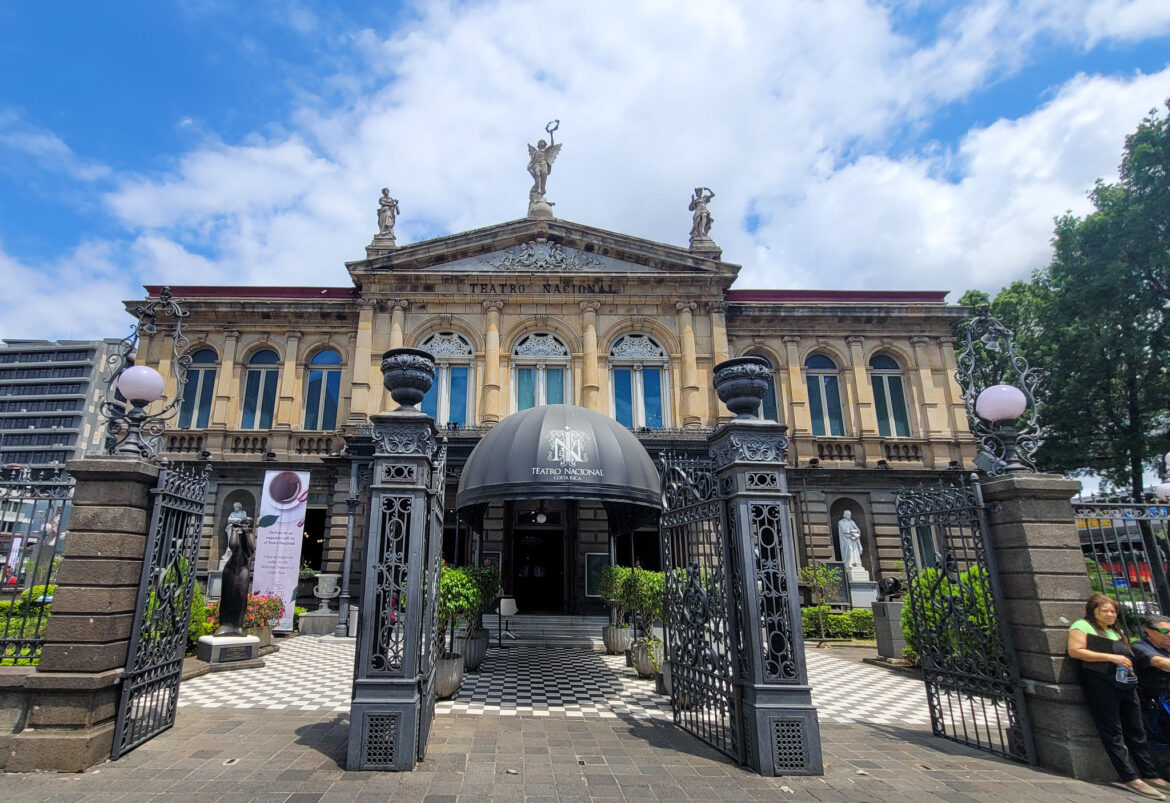
San Jose is the gateway to Costa Rica for many visitors with its international airport. There is so much to do in the capital city and day trips nearby. There are incredible volcanoes, rainforests and places to explore just an hour from town. Recently, I ended my monthlong Central America trip in San Jose. Here is my suggested 1 or 2-Day San Jose Costa Rica itinerary.
San Jose is the largest (almost 1.5 million people) and capital city of Costa Rica in the Central Valley. It’s also one of the safest and least violent cities in Central America. Founded in 1736, it didn’t get its first city government until 1812. The weather is a tropical wet and dry climate. The temperature changes very little all round averaging about 71 to 74 F (21 – 71 C).
One or Two Day San Jose Costa Rica Itinerary

San Jose Walking Tour
You can easily spend a whole day just exploring the town center of San Jose. It offers most of the main attractions close together within walking distance. When I was there, we explored many of the sites mentioned below. San Jose has some lovely European-styled theatres that are wonderful venues for architecture, culture and musical events. There is a 2.5-hour San Jose Free Walking Tour , leaving every morning at 9 am from the Holiday Inn downtown. Here are attractions to explore on a walking tour.
National Theater of Costa Rica Colegio Superior de Señoritas Democracy Plaza Plaza de la Cultura or Central Market National Museum of Costa Rica The National Park Jade Museum China Town
Where to Eat in San Jose
There are numerous restaurants close to the town center. I discovered Pandeli , a delicious place to stop for breakfast or lunch with a Mediterranean menu. There are numerous options for healthy fresh meals or snacks. Our tour group enjoyed a dinner at L’Olivo , a lively Italian Bar and Restaurant with tapas, pastas, salads and wines. If you are looking for a good vegetarian/vegan restaurant Arobol de Seda is a great place to eat. Also, don’t miss the San Jose Central Market for various food options. Soda Tala is popular stop at the market for antojitos “little cravings” or combo plates.
Day Trip from San Jose: Doka Coffee Plantation, Poas Volcano & La Paz Waterfall Gardens

I set up my day tour going to Doka Coffee Plantation, Poas Volcano and La Paz Waterfall Gardens through Viator. I have an important suggestion. While, I loved the 3 main destinations, I was not happy with the time spent picking everyone up. Because I was in the town center, I was one of the first tourists in a shuttle bus picked up at 5:20 am. Then the shuttle continued to pick up other tourist for almost 2 hours. And guess who was last getting off afterwards getting home about 7:30 pm.
This meant that I traveled almost 4 extra hours than the last ones picked up in the morning for the same price. This is unacceptable, so I want to give the forewarning. If this sounds like a problem for you, then check out other tours or even a private tour for this day trip. Now that I got that out of the way, the stops were fantastic and glad I experience them. Overall, I recommend going to these destinations for a day trip, just be aware of other tour options.
Doka Coffee Plantation

We made our first stop at the Doka Coffee Plantation . First, they served us a traditional Costa Rican breakfast with coffee tasting samples. Then, they took us on a guided tour of the coffee plantation, learning about growing, process and producing the coffee beans. This world class coffee here grows in the mineral-rich, fertile soils of Poas Volcano, our next stop on the day trip.

They display beautiful gardens and a shop to buy coffee products. From their delightfully ornate, red oxcart I learned about the Costa Rican tradition. During late 19th to early 20 th century, these wheels with no spokes on ornate oxcarts hauled the coffee across the country. The wheels were an artistic blend of the Aztec disc and the spoked wheel introduced by the Spanish. Artists painted each oxcart in unique designs to represent a family.
Poas Volcano National Park

Our next stop was the Poas Volcano , an active 2,697 meter stratovolcano. It erupted 40 times since 1828, including the most recent time in 2019. In April 2017 the eruption caused evacuations and closing the volcano until September 2018. Currently, Poas Volcano provides limited access to the crater observatory and you must go on organized groups. The summit has 2 crater lakes, Laguna Caliente (“hot lagoon”) and Lake Botos filling an inactive volcano. It is surrounded by a cloud forest.
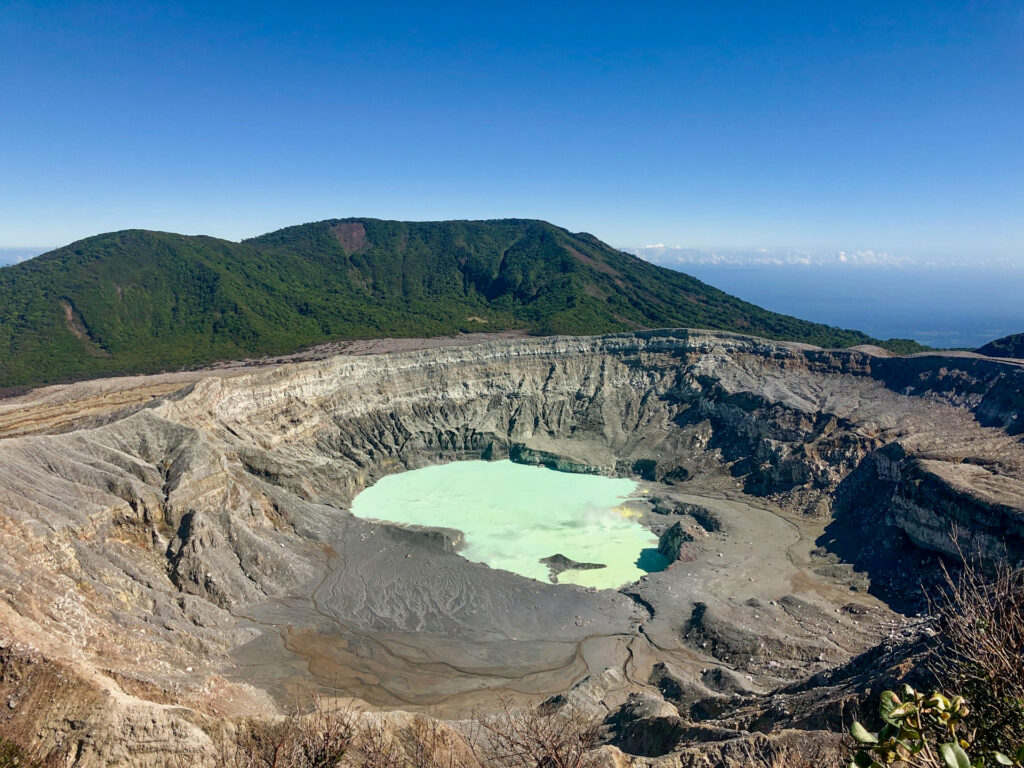
On my tour, we walked about 10 minutes to the observatory and saw nothing. There was a thick fog mixed with steam from the volcano blocking the sight. I literally saw nothing only thick haze. We were allowed only 20 minutes up there before the next group got their try to see the crater. I included a picture from another photographer showing how beautiful it is.
La Paz Waterfall Garden s

Our final stop is the La Paz Waterfall Garden s , a privately owned sanctuary comprising 70 acres with wildlife, rainforest and waterfalls. This is about a 1.5-hour drive from San Jose. This paradise offers 3.5 km of trails showing a diverse refuge for wildlife and goes along the La Paz River, 5 waterfalls and Trout Lake.

The wildlife includes an aviary, butterfly garden, monkeys, frogs, jungle cats and serpentarium. Overall, it’s the largest animal sanctuary in Costa Rica. I got the best views up close (behind glass) of jaguars wrestling and playing, of which I could have watched for hours.
On site is the rustic open air Colibries Restaurant with a buffet of traditional Costa Rican food. The Peace Lodge onsite is a Boutique 5-Star Hotel, blending into the rainforest. This award winning eco lodge was featured on the Travel Channel’s Honeymoon Hotspots International. They awarded it as most romantic place to spend a honeymoon in Costa Rica.
Enjoy San Jose!
San Jose is much more than just a gateway to Costa Rica. The city is one of the safest in Central America and close to some of the most incredible volcanoes, rainforests and coffee plantations in Costa Rica. If your travels bring you to San Jose, please share any tips below in the comments.
Read Next! Amazing La Fortuna – The Heart of Costa Rican Wellness Travel Monteverde, Costa Rica’s Fun Eco Adventures – Zip lining, Hanging Bridges & Hikes Veragua Rainforest Ecotourism & the Best Place to See Frogs in Costa Rica

Trudy Wendelin, L.Ac
Cartagena old town walking tour – the jewel of the caribbean, isle of skye’s portree bay and scenic walks, you may also like, costa rica adventures in 6 days- monteverde, la..., amazing la fortuna – the heart of costa..., monteverde, costa rica’s fun eco adventures – zip-lining,..., costa rica’s amazing jaguar rescue center tours with..., white water rafting & capsizing in costa rica’s..., veragua rainforest ecotourism & the best place to..., leave a comment cancel reply.
Save my name, email, and website in this browser for the next time I comment.
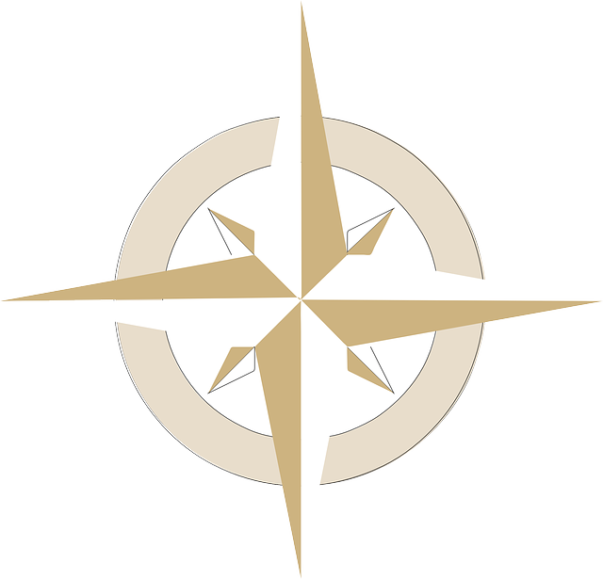

Ultimate Guide: The Best Things to Do in San Jose, Costa Rica!
N o, not just food (though that's a delight too!), but the experiences, the places to visit, the hidden gems that only the locals know about?
Fear not, traveler, for Kevin Erickson is here with the inside scoop.
- The charm of historic Barrio Amón .
- The glint and glamour of the Pre-Columbian Gold Museum .
- Why Café Hopping is an absolute must in Costa Rica.
- Nightlife in San Jose that will keep your feet tapping.
- Day trips from San Jose you can't miss out on.
San Jose: More Than Just a Transit Point
According to the Costa Rica Tourism Board, over 1.2 million tourists land their feet in San Jose each year.
A surprising fact, given that many perceive it merely as a gateway to Costa Rica's ethereal beaches and rainforests.
But guess what? San Jose is an experience, a delightful blend of modern city hustle with a soulful Latin touch.
As Anthony Faiola , a correspondent for the Washington Post, once said,
"San Jose is Costa Rica's heart and soul. It's a city with a vibrant culture, a rich history, and a doorway to the country's stunning landscapes."
Dive Deep into the Golden Hues
Speaking of rich history, did you know that San Jose houses one of the most significant gold museums in Latin America?
The Pre-Columbian Gold Museum , with over 1,600 gold artifacts dating from 500 AD to 1500 AD, tells tales of the city's golden past.
And no, it's not just for history buffs! The sheer brilliance of the craft will leave you in awe.
The Brewed Delights of San Jose
Alright, let's talk about coffee. Costa Rica's coffee is not just famous; it's legendary !
When in San Jose, café hopping is not just recommended, it's a lifestyle. Take a barista course or simply indulge in the rich flavors of the local beans.
Pro tip? Seek out the cafes where locals go, not just the touristy spots.
There, you'll find coffee made with love and an atmosphere brimming with stories.
The Lively Pulse of the Night
The sun might set, but San Jose doesn't sleep.
The nightlife here is a lively amalgamation of Latin beats, contemporary music, and some fantastic local brews.
Dance, sing, or just tap your feet - San Jose after dark is an experience you'll cherish.
More Than Just a Day’s Adventure
San Jose’s charm doesn't end within the city's boundaries. Its strategic central location in Costa Rica makes it a prime hub for various day trips, each offering a unique experience of its own.
Imagine waking up to the idea of visiting an active volcano.
Not far from San Jose is the La Paz Waterfall Gardens . As you walk through cloud forests and past cascading waterfalls, you can't help but be in awe of nature's beauty. Don't forget to drop by their wildlife refuge, home to jaguars, pumas, and myriad birds, offering you a snapshot of Costa Rica's rich biodiversity.
Coffee lovers, San Jose has something special for you too! The Central Valley is the heartland of Costa Rican coffee production. You can take a tour of the coffee plantations, learning about the intricate processes that transform the humble coffee bean into the aromatic brew we all love. The best part? Most tours end with a fresh brew, letting you savor the local flavors right where they're grown.
For those who seek a bit of culture and history, the town of Cartago , a short drive from San Jose, beckons. As the erstwhile capital of Costa Rica, it is rich in colonial architecture and home to the revered Basilica of Our Lady of the Angels, a pilgrimage site for many.
Lastly, for a touch of luxury and some stunning views, head to Escazú . Known as the 'Beverly Hills' of Costa Rica, it offers upscale dining, shopping, and panoramic views of the city below.
In essence, San Jose serves not just as a destination but a gateway. A gateway to myriad experiences, landscapes, and stories that lie just a drive away. So, when in San Jose , venture out and let the surrounding regions narrate their tales.
What's the best time to visit San Jose?
December to April, during the dry season, is often considered the best time. However, the green season, from May to November, has its charm with fewer crowds and lush scenery.
Is San Jose safe for tourists?
Like any major city, San Jose has its safer areas and spots where you should be cautious. Common sense and standard travel safety precautions should always be followed.
How many days should I spend in San Jose?
Two to three days is usually sufficient to explore the city's main attractions. However, with day trips in the picture, you could easily spend a week around San Jose.
Is English widely spoken in San Jose?
Yes, English is widely understood in tourist areas, hotels, and major attractions. However, a few Spanish phrases will be appreciated by locals!
Is the tap water safe to drink?
In San Jose, tap water is generally safe to drink. However, if you have a sensitive stomach, opting for bottled water might be best.
San Jose, Costa Rica, with its urban vibrancy meshed beautifully with rich cultural tapestries, truly stands as a testament to the wonders that Central America offers. It isn't just a transit hub, but a treasure trove of experiences waiting to be discovered.
The city whispers tales of history , dances to the tune of modernity, and flirts with the beauty of nature. Its allure extends beyond its borders, beckoning adventurers to explore further.
When planning your next trip, let San Jose be more than a layover; make it a destination. Dive deep, explore its corners, and let the city's heartbeat synchronize with yours.
For in its streets, parks, and nearby attractions, you'll find a piece of Costa Rica that will etch its way into your heart, compelling you to return.
- Costa Rica Tourism Board
- Washington Post
- Pre-Columbian Gold Museum


COMMENTS
These are the best places for budget-friendly sights & landmarks in San Jose: Teatro Nacional Costa Rica; Metropolitan Church (Catedral Metropolitana) Universidad de Costa Rica; Iglesia de la Merced; Banco Central de Costa Rica; See more budget-friendly sights & landmarks in San Jose on Tripadvisor
23. Visit Manuel Antonio National Park. Some of the bluest water you'll ever see is in Manuel Antonio National Park. This is one day trip from San Jose you don't want to miss - especially if you love the beach! Manuel Antonio National Park is easily one of, if not, the best national park in all of Costa Rica.
Theater: Guided tours by appointment Events: See marquee Tel.: (506) 2221-4952 or (506) 2233-5424. 28. La Casona (The Big House) In the middle of the 19th century, a Colombian Miguel Macaya Artuze settled in Costa Rica and, in 1877, established the Macaya Hardware store, the oldest hardware store in the country.
The first thing we saw was his face warning that he was a fraud. 6. Museo Nacional de Costa - National Museum. Museo Nacional de Costa from Plaza de la Democracia. San Jose is filled with museums showcasing Costa Rican history and culture and the National Museum (Museo Nacional de Costa) is San Jose's premier museum.
Alianza Francesa. San José. The Alliance has French classes, a small library and rotating art exhibits in a Barrio Amón home. There are also cinematic and musical events. The classes…. 1. 2. Discover the best attractions in San José including Teatro Nacional, Museo del Jade, and Museo de Oro Precolombino y Numismática.
1. Teatro Nacional Costa Rica. 3,629. Historic Sites • Theaters. By RednotTan. Excellent guided tour of a lovely 19th century European style theatre in the heart of San Jose. See tours. 2. Cruz de Alajuelita.
8. Enjoy the best views from Pico Blanco. 9. Try the best food in Barrio Escalante. 10. Enjoy outdoor activities near La Fortuna! BONUS: 1-day itinerary exploring the greater San Jose region. Where to stay in San Jose, Costa Rica. Frequently asked questions about San Jose Costa Rica.
The Pre-Colombian Gold Museum | The most likely option, and one of the most popular things to do in San José for tourists. Owned and curated by the national bank, the underground Museo del Oro Precolombino house a vast array of jewllery, figurines, sculpted warriors dating frmo 400 BC to 1550 AD.
12. Galeria Namu. 218. Art Galleries. Galeria Namu is a fair trade art gallery for local and indigenous artists from Costa Rica and surrounding Central America countries. Established in 1998 at this same location, visitors to Costa Rica's capital city of San Jose can find us easily behind the Holiday Inn (across from Parque Morazan).Knowledge ...
San José. While it's tempting to make a beeline for Costa Rica's luscious countryside, take some time to get to know San José, Costa Rica's humming capital city. Wander historic neighborhoods such as Barrio Amón, where historic buildings have been converted into contemporary art galleries, and Barrio Escalante, the city's gastronomic epicenter.
Yes, San José, Costa Rica, has several attractions and places worth visiting. Here are some highlights: National Theatre: A stunning architectural gem, the National Theatre is a must-visit landmark in San José. Take a guided tour or catch a performance to appreciate its beauty and historical significance.
10. Stroll through the Museum of Costa Rican Art…. The Museum of Costa Rican Art is small but mighty, featuring paintings, sculptures, and mixed-media pieces by Costa Rica's most famous artists. There are both indoor and outdoor spaces, with a wide range of works that demonstrate the country's artistic diversity.
Things to Do in San Jose City, Costa Rica. The Experts Recommend: Fine dining at Restaurante Grano de Oro. Try the macadamia crusted sea bass and Grano de Oro pie. Home » Destinations » Things to Do in San Jose City, Costa Rica. San Jose is the heart of Costa Rica and home to roughly half the country's 4.9 million citizens.
Containing over 1,600 artifacts of Pre-Columbian gold from 500 A.D., this museum's impressive collection is well worth a visit. It is located under the Plaza de la Cultura, which is home to two other currency-related museums, the National Coin Museum, which has a collection dating back to 1236, and the "Casa de Moneda" that shows the history of minting in Costa Rica.
Check out the Ram Luna website for more info. 11. Check out the Gold Museum. Deep beneath the "Plaza de la Cultura" in San José, and you'll discover the Pre-Columbian Gold Museum. This museum boasts over 3,500 artifacts, showcasing the craftsmanship from the Pre-Columbian era, dating from 300 BC to 1550 AD.
Ever-evolving, Costa Rica's capital is an exciting place to hit the ground running—or, instead, walking. You can access many historical, cultural, and culinary highlights of San José via walking tours here. See, taste, sip and shop your way around town with these suggestions of 12 things to do in San José.
The following are some of Costa Rica's top historical sites with enigmatic legends to boot. National Theater, San Jose. Open to the public in 1897, The National Theater, or the Teatro Nacional, is Costa Rica's architectural gem located in the heart of the capital city of San Jose. It is situated on the south end of the well-known pedestrian ...
6. Shop til you drop. San José is the commercial epicenter of Costa Rica and Ticos travel from all across the country to stroll the malls and buy specialty goods. For travelers staying downtown, Avenida Central is a classic point to begin your journey.
El Museo del Jade is a beacon of Costa Rica's rich cultural heritage. Beyond its modern façade, which intriguingly resembles a block of raw jade, lies the world's largest collection of pre-Columbian jade artifacts. Visiting this fantastic place in downtown San Jose is a journey through time, color, and craftsmanship.
11. Galeria Namu. 218. Art Galleries. Galeria Namu is a fair trade art gallery for local and indigenous artists from Costa Rica and surrounding Central America countries. Established in 1998 at this same location, visitors to Costa Rica's capital city of San Jose can find us easily behind the Holiday Inn (across from Parque Morazan).Knowledge ...
Stiefel Pub is another highly recommended place to find craft beer in San Jose. This is a true pub that feels like a bar. They serve their own beer and have a chalkboard full of choices from other Costa Rican brewers. For lunch, near the Pre-Columbian Gold Museum and National Theater, Café Rojo is a great spot.
It's easily one of the most historic places to visit in San Jose. The Gold Museum is open Monday through Sunday from 9:15 a.m. to 5 p.m. ... If you're a coffee lover, this plantation is one of the must-see tourist attractions in San Jose, Costa Rica. See Related: Best Places to Travel Alone in the World. 17. El Observatorio. Address: WWMJ+ ...
San Jose Discover Costa Rica's effervescent capital and surroundings in just three days. Visit lively markets, explore the city's vibrant art and culture and enjoy nearby attractions in this action-packed itinerary. Day 1: The Art & Culture of San Jose Dive into local culture at San Jose's bustling market, Central Market. Shop for ...
San Jose has some lovely European-styled theatres that are wonderful venues for architecture, culture and musical events. There is a 2.5-hour San Jose Free Walking Tour, leaving every morning at 9 am from the Holiday Inn downtown. Here are attractions to explore on a walking tour. National Theater of Costa Rica Colegio Superior de Señoritas
Embark on a 2-hour walking tour of Downtown San Jose, uncovering its historic highlights and cultural riches. Explore important sites and immerse yourself in the rich history and vibrant culture of this amazing city.
The charm of historic Barrio Amón.; The glint and glamour of the Pre-Columbian Gold Museum.; Why Café Hopping is an absolute must in Costa Rica. Nightlife in San Jose that will keep your feet ...